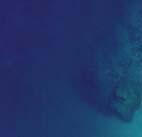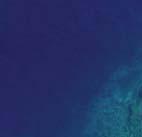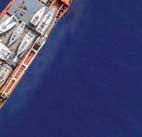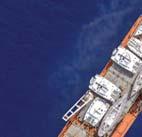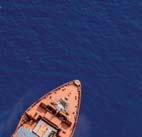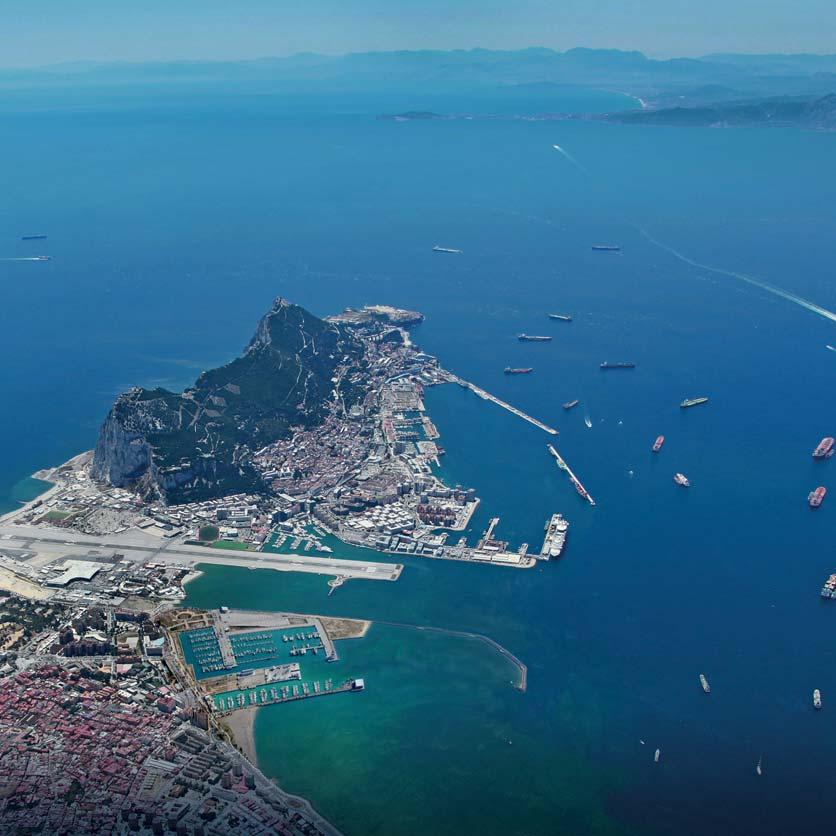














COMMODORE Simon Currin
VICE COMMODORES Daria Blackwell
Phil Heaton
REAR COMMODORES Zdenka Griswold
Fiona Jones
REGIONAL REAR COMMODORES
GREAT BRITAIN Carol Dutton
IRELAND Alex Blackwell
NW EUROPE Hans Hansell
NE USA & ATLANTIC CANADA Janet Garnier & Henry DiPietro
SE USA Greta Gustavson & Gary Naigle
W COAST NORTH AMERICA Liza Copeland
CALIFORNIA, MEXICO & HAWAII Rick Whiting
NE AUSTRALIA John Hembrow
SE AUSTRALIA Scot Wheelhouse
NEW ZEALAND & SW PACIFIC Viki Moore
SOUTH AFRICA John Franklin
ROVING REAR COMMODORES Nicky & Reg Barker, Steve Brown, Guy Chester, Thierry Courvoisier, Andrew Curtain, Bill Heaton & Grace Arnison, Lars & Susanne Hellman, Alistair Hill, Stuart & Anne Letton, Pam MacBrayne & Denis Moonan, Simon Phillips, Sarah & Phil Tadd, Rhys Walters, Sue & Andy Warman
PAST COMMODORES
Editorial 3
Sailing Around the World Alone, Part 2 4
The Middle Way up the Atlantic 20
Dustin Reynolds
Patrick Marshall
Capsize! 33 Anthea Cornell Stock
Sailing Pania ~ Island Hopping...
Lambert
Blauwasserbriefs 52 Susanne Huber-Curphey
Why Japan? 67 Peter and Ginger Niemann
Contrasting Passages 79 Rev Bob Shepton
Book Reviews 89 Heavy Weather Sailing, Well it Seemed Like a Good Idea, First Aid at Sea, Norway, Principles of Yacht Design, Quirky History, Stress-Free Engine Maintenance, Superyacht Captain
Frances Griffiths, Sara Hough, Adrian & Clare Richards
Tom & Vicky Jackson
Yacht Design, The Complete Ocean Skipper, Louise Adventure, Uncommon Courage, Germany and Denmark
The information in this publication is not to be used for navigation. It is largely anecdotal, while the views expressed are those of the individual contributors and are not necessarily shared or endorsed by the OCC or its members. The material in this journal may be inaccurate or out-of-date – you rely upon it at your own risk.
I often wonder what on earth to write in my Editorial, but this time there are several things I’d like to say. The first, of course, is to thank everyone who’s contributed an article to this issue, particularly those who write excellent English despite it not being their first language. In his Commodore’s e-mail for November Simon reports that members dialled in to the recent GC meeting from Ireland, the UK, USA, Canada and Mexico, with apologies recieved from mid-Pacific, rural South Africa and Norway. Are we the most global club for our size in the world?
Thinking of our global reach and responsibilities, an article in a recent Flying Fish mentioned concealing fresh produce when entering one country from another (with which it shares a long land border), despite this being prohibited by local law. Such practices are not endorsed by the OCC, and members are expected to follow the guidance set out by the Club’s Governance Committee at www.oceancruisingclub.org/About-theOCC. This states: ‘OCC Members are cruisers who comply with international, national and local laws and regulations; respect communities, their customs, the environment and other people including other Members; demonstrate honesty, fairness and courtesy; and are responsible and accountable for their actions’.
Closer to home, many members will be aware that past Club Secretary Anthea Cornell Stock died in late September. Her obituary starts on page 215. Separately, on page 33, read her own account of being aboard a capsized catamaran back in 2001. Anthea joined the Flying Fish proof-reading team six years ago and demonstrated an eagle-eye for both typos and grammatical errors, as well as occasionally throwing light on people and events from decades ago. I shall miss her. While it would be impossible to replace Anthea, her loss still leaves a gap in my proof-reading team. Proofs can be sent out and returned either as PDFs, hard-copy or a combination of the two, so it would be good to hear from members outside the UK. E-mail me on flyingfish@oceancruisingclub.org if you’re interested.
There are some stunning photos in this issue and many arrived just as you see them. Others, however, required considerable work. Flying Fish doesn’t ‘do’ sloping horizons, so please try to hold your camera/phone level as you press the button. While horizons can usually be levelled in PhotoShop, it takes time and often involves cropping off part of the photo. I know how difficult it is hold things level if you’re grabbing a quick pic on a violently moving boat, but when all is calm and peaceful please do make that extra effort! Similarly, while fish-eye and other ‘distorting’ lenses can add interest to photos, they’re best avoided for general use. If using one at sea, try to keep the horizon near the centre of the photo. We all know that the earth is round, but not that round!
One last thing ... the DEADLINE for submissions to Flying Fish 2023/1 is Wednesday 1st February. While I can often cut a bit of slack it can’t be guaranteed, so get those submissions to me early if possible. Many thanks!


(New members should either visit thesinglehandedsailor.com/ or read Dustin’s backstory in Flying Fish 2022/1 (online at oceancruisingclub.org/Flying-Fish-Archive) to learn how he came to be in Indonesia with very limited funds and a boat beset by more than the usual number of problems.

Following his return home in December 2021, Dustin was awarded the Barton Cup for his circumnavigation.)
After ten months of boat failures in Indonesia, my most difficult passage in recent memory and with Rudis on the hard, I just wanted a break. I wanted to spend time with my dad and Jamie. I really wanted to spend some time not working on the boat. The GoFundMe page was an immediate success though, so it was time to start getting Rudis ready for the Indian Ocean. I started researching how to get a new engine and rigging and get them installed in Thailand. Dez at Krabi Boat Lagoon was helping me with this, then told me bluntly, “Even if you put $20,000 into this boat it will still be a $10,000 boat. There’s a boat right next to yours that is in great shape and the owner is keen to sell”.
I had never considered changing boats, but Jamie and I decided to take a look at Tiama, a Bristol 35.5. Though only six inches longer than Rudis she was newer, wider, taller, nicer and even had a door for the heads – I was instantly in love. The only problem was that she was too expensive. Dez said the owner might part with her for $35,000, which was much less than he’d paid for her just a year previously. My GoFundMe was doing well, but not that well. Tiama seemed just out of reach but I decided to contact the owner anyway.
I e-mailed Neil, who owned Tiama, telling him that I loved the boat, sharing a link to my crowdfunding page and offering a down payment/payment plan. He responded quickly that he was not interested in offers significantly below the asking price, but he would be at the marina the following day if I wanted to meet. We ate lunch, talking about the boat and about my goal of being the first double amputee to sail around the world alone. Neil told me he was busy and didn’t
have time to maintain and enjoy a cruising boat. The only way he would consider a low offer would be if there were a fast and simple transfer of ownership.
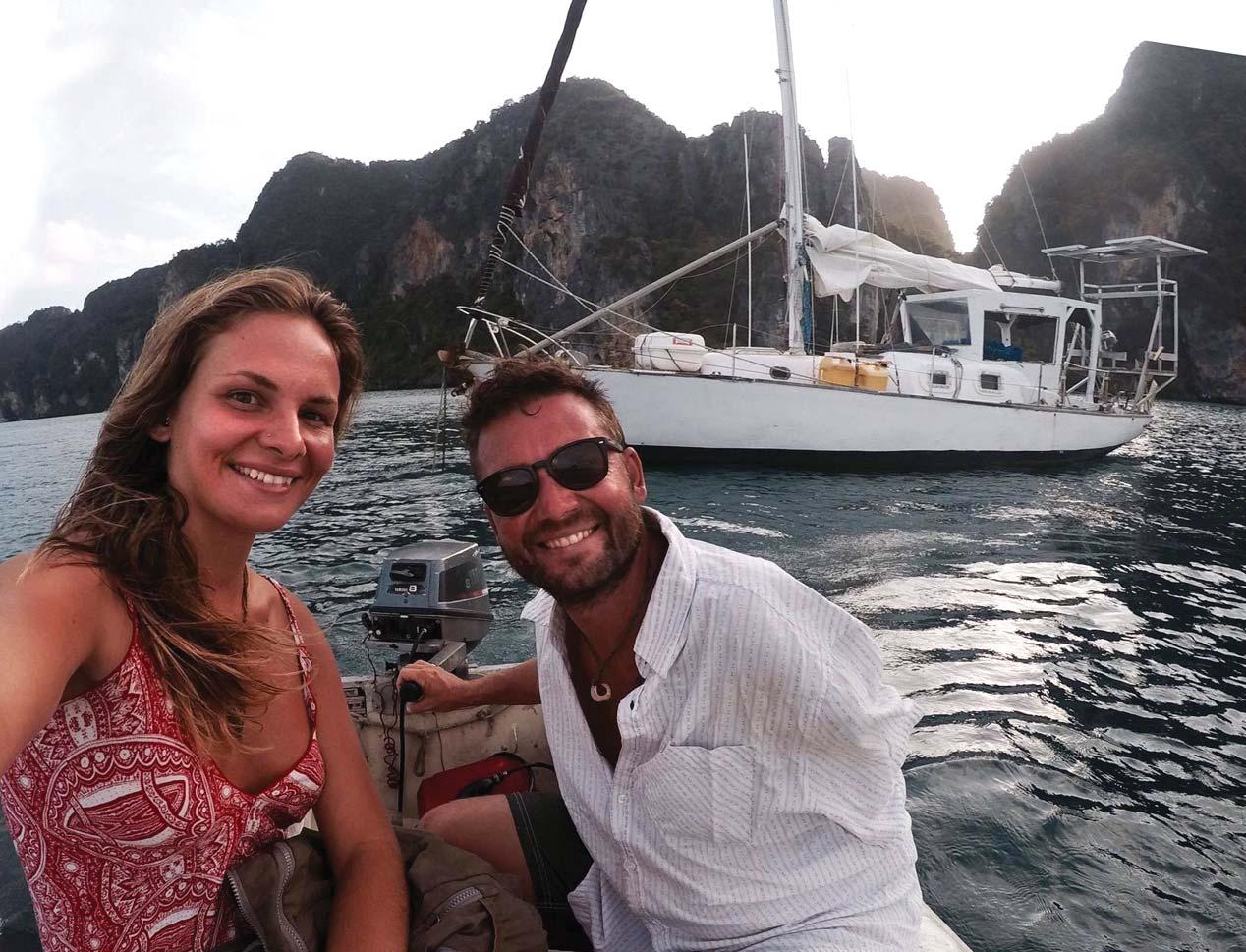
It took a few days to assess how much I could offer in a short time-frame. My crowdfunding had slowed down and was at about $12,000 dollars, but I found someone who wanted to buy Rudis for $5000 dollars. I wrote to Neil saying that I could come up with $20,000 by the end of the following month. I wrote that I didn’t need a sea trial and knew the boat was worth far more, but that was everything I had. Neil wrote back that I seemed sincere and he thought Tiama would be a good boat for me, but he needed to think about it. After a few really long days he wrote back that if I could come up with the $20,000 the boat was mine. I was ecstatic but stressed since I was still short.
Over the next month crowdfunding money continued to come in, but the person who wanted to buy Rudis kept failing to pay me when he said he would. As my deadline was approaching and I was about $5000 short, I reached out to a few friends for a loan and my friend Greg came through. He told me to write up a contract to pay him back and to make sure it did not affect our friendship. I was just able to keep my side of the deal and Neil kept his. While all this was happening Jamie caught dengue fever and had a rough recovery. By the time she got better, and after another trip to the hospital, we were both low on money. We were not ready to say goodbye, but she had to get back to work and I had a new boat that I needed to get ready to cruise, so we said our goodbyes and Jamie flew back to Hawaii.
I took the windlass and watermaker off Rudis and installed them on Tiama. I also wanted to add solar panels, dinghy davits and new batteries. I decided to go back to Hawaii, take a short-term job and do a yacht delivery from Hawaii to California. It was my first time back home in almost three years and nice catching up with friends and family, but strangely I felt a little out of place. I had set off to sail around the world and only made it about one-third of the way. I was homesick before going back to Hawaii, but within two months I’d saved enough money to do all the work I’d planned on doing and was ready to get back to the boat. Just before I flew to O‘ahu for my yacht delivery I got a phone call from the coast guard telling me that the EPIRB on Rudis had been triggered. I called the new owner and asked if everything was okay and he informed me that he
Jamie, Rudis and mehad sunk the boat in shallow water near the Koh Jum fishing village. I was angry and sad he had sunk her – she had been my partner for 2½ years and one-third of my trip around the world. She deserved better.
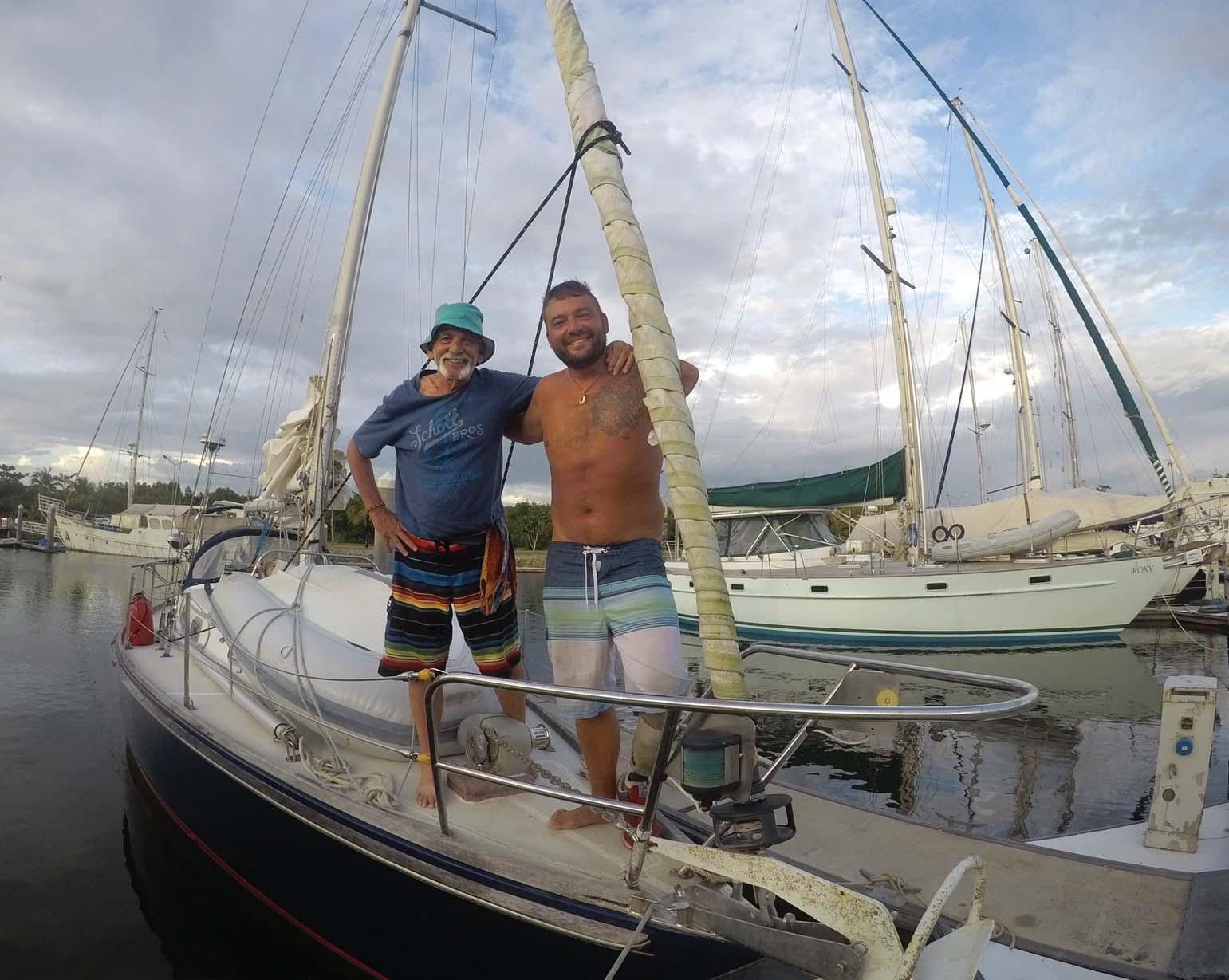
A few days later the guys doing the salvage job called me and said they didn’t know what to do. “Dustin, there are pornographic magazines washing up on all the beaches! The Muslims on the island are really pissed! How many are there?” I told him there were about a thousand – “Sorry, they’re going to be floating up for a long time!”. When I’d bought Rudis I’d asked the previous owner what the best things to trade were. He’d responded quickly with ‘alcohol, cigarettes and porn mags’. I mentioned this to my roommate, so for Christmas that year I received an eBay lot of 1000 porn magazines. The problem was that I wasn’t confident enough to ask people if they wanted to trade for porn and only once I was asked, so by the time I got to Thailand and was moving my personal items from Rudis to Tiama I still had about 995 on board. I asked the new owner if he wanted them and he said ‘sure’, which ultimately led to their fate on the beaches of Koh Jum.
By the time I returned to Tiama the Thai monsoon season was in full effect. It was hot, humid and impossible to weld dinghy davits in the rain. My planned one-week haul-out turned into two really uncomfortable months, though I was able to use the time to go through the boat and learn about everything on board. Eventually the davits were finished and I was able to launch my new boat and start sailing around. Tiama was nice, fast and comfortable. Truly a night-and-day difference from Rudis.
I had one more holiday season in Thailand to spend with my dad before starting my Indian Ocean crossing. We did a roundtrip to Langkawi, Malaysia then sailed back to Krabi for Christmas with his wife and friends. Then I went up to Patong for New Year. New Year in Patong is a special thing – every beach hotel has its own fireworks display and what seems like millions of lanterns lift off the beach. I spent the New Year with my good friend Harry and we started to plan to buddy-boat across the Indian Ocean.

Our first stop was at the Andaman Islands. The Andamans have a very strict and expensive check-in procedure – they’re only about 450 miles from Phuket but are clearly a different country and culture. Seven officials came on board and required a total of 72 pages of paperwork. Despite the expense and time-consuming check-in the Andamans are well worth the 30-day maximum visit. Harry and his crew on Moyo buddy-boated with me, and my friend Fran also came to visit. We spent most of the 30 days on uninhabited islands, spearfishing by day and playing games and drinking at night. It was amazing, but the 30 days passed quickly and soon it was time to go to Sri Lanka.
The passage to Sri Lanka was the first time Tiama and I got into a bit of rough water. It was a mostly easy passage until the wind picked up to 30 knots on the nose. Harry arrived in Galle just before the wind turned, but I spent two days tacking upwind which Tiama did pretty well. Sri Lanka was one of my favourite countries to visit but my least favourite place for having a boat. The check-in process was expensive, the harbour was rough and dirty and corrupt military officials would shake me down for ‘duty’ (bribes) on anything I bought. On the positive side, the wildlife and country were amazing. I rented a scooter for three months and just explored.
An elephant crosses the path in Sri LankaThe most difficult thing about visiting countries with limited time to stay is picking a weather window to leave. Just as the Moyo crew and I were running out of time on our permits, a hurricane was forming off India – it was far north of us but the normally northeast winds turned southwest. It looked as though we would bash for about five days, cross the Intertropical Convergence Zone (ITCZ), then get a downwind run in the southeast trades the rest of the way to the Chagos Islands. Sadly the storm pushed the ITCZ too far south and we had 1000 miles of beating into 15–40 knot winds. I just took whichever tack gave me the best VMG and bashed into the southwest winds. It took me 12 days in Tiama and Harry 14 in Moyo, a catamaran.
Chagos is another special place for cruisers. You can only get a permit for 28 days but there are few places with such a minimal touch from humans. Boobies escort you into the anchorage, where you drop your hook into the crystal-clear lagoon. There were 22 boats there when I arrived and Alan from Kiwi Dream swung by in his dinghy with cold beers. The last time I’d seen Alan had been six months previously in Thailand and I knew the people on 20 of the 22 boats there. A few I’d not seen since the Pacific, two years earlier. It was an amazing reunion of world cruisers. During the 30 days I spent there we had evening sundowners, pot lucks and adventures in large and small groups. With the exception of a few boats we all sailed to Madagascar next and continued the trans-Indian Ocean flotilla.
The passage to Madagascar was a rough and fast broad reach. Tiama and I covered the 1650 miles in ten days, by far my fastest passage to date. There are two ways to round Cap d’Ambre at Madagascar’s northern tip, the trickiest bit of water I have ever had to contend with. You either pass close enough to stay inside the breaking waves formed by the opposing current or go a hundred miles to the north. I chose the one-foot-onshore, one-foot-on-the-boat route. The waves off the cape commonly reach over 15m and I had 35 knot winds and 16m waves forecast on my weather report. I tried to slow Tiama down so we would round it in daylight but the wind and current wouldn’t let me. There was no moon, but Mars and Venus lit the way. Rounding the cape I could hear the waves breaking to starboard and smell smoke from the nearby villages to

With a black lemur and giant tortoise in Madagascar

port. The waves continued to get louder until suddenly it was flat calm.
I motored for about an hour until the breeze picked up and then sailed to the nearest nicelooking anchorage. I quickly launched the dinghy and went for a walk ashore hoping to get some fresh food. It had been over two months since my last grocery store in Sri Lanka and I had eaten pasta and red sauce for the previous three days. The villagers were less than welcoming, which was the first and only time this happened in my entire circumnavigation. Usually people were quite curious and excited to meet the solo sailor who was missing an arm and leg, but here all I got were anxious looks. It took a while to find anyone who spoke English, but when I did he told me there was a horrible human trafficking problem in Madagascar. He said that men used to come promising money and education for female children, but once the villagers got wise to that and realised they never came back, they would just take them in the night. So to the locals a white person on a boat is a possible slaver ... in 2018, a white person on a boat off Africa is a possible slaver!!! He told me not to take photos but to simply introduce myself and, surprisingly, the locals warmed to me. I’ll never forget that these people not only didn’t show me anger based on very understandable prejudice but that they were willing to share their fresh food with me. If only we could all be so graceful in the face of extreme oppression.
Madagascar, Mozambique and South Africa were amazing, terrifying, loving, violent, beautiful, peaceful and my home for a year. I’ve always
On the 10th anniversary of my motorcycle crash we held a party on Bazaruto island off Mozambique

thought books, poems and songs written about Africa must have exaggerated a bit. I was wrong. As a visitor I was grossly uneducated on all the politics, racism and generational strife, so will not weigh in on any of these. What I can say is that every passage was tricky with limited weather windows and horrific consequences if you got it wrong, though weather router Des Cason* makes this all much easier. Despite the tension between the Africans and Afrikaners, both are very welcoming to Englishspeaking visitors. I even gained 10 kilos from African braais (wood or charcoal-fuelled barbecues). This was also the first place people started to recognise me from media bits. Every marina in Africa sponsored my stay, including two months at the Zululand Yacht Club in Richards Bay while I joined a friend’s boat and sailed to Antarctica.
When I returned from Antarctica I was informed that I would be the recipient of the OCC’s Seamanship Award for 2018. I was still not a big part of the yachting community at this time and was surprised by the news. Having started my circumnavigation in the Pacific I always seemed to be the least experienced sailor in the anchorage and was surprised to receive an award from a club that only accepts sailors who have done an ocean passage. The OCC put together a presentation ceremony at Cape Town’s Royal Cape Yacht Club –I just needed to sail about 1000 miles around the Cape of Good Hope to make it to my party. With Des’s weather routing help I made it with a few days to spare. As someone

* See Flying Fish 2019/1, page 15.
A mahi mahi I caught off South Africa
 Leaving Mozambique
Leaving Mozambique
Receiving the 2018 Seamanship Award at the Royal Cape Yacht Club
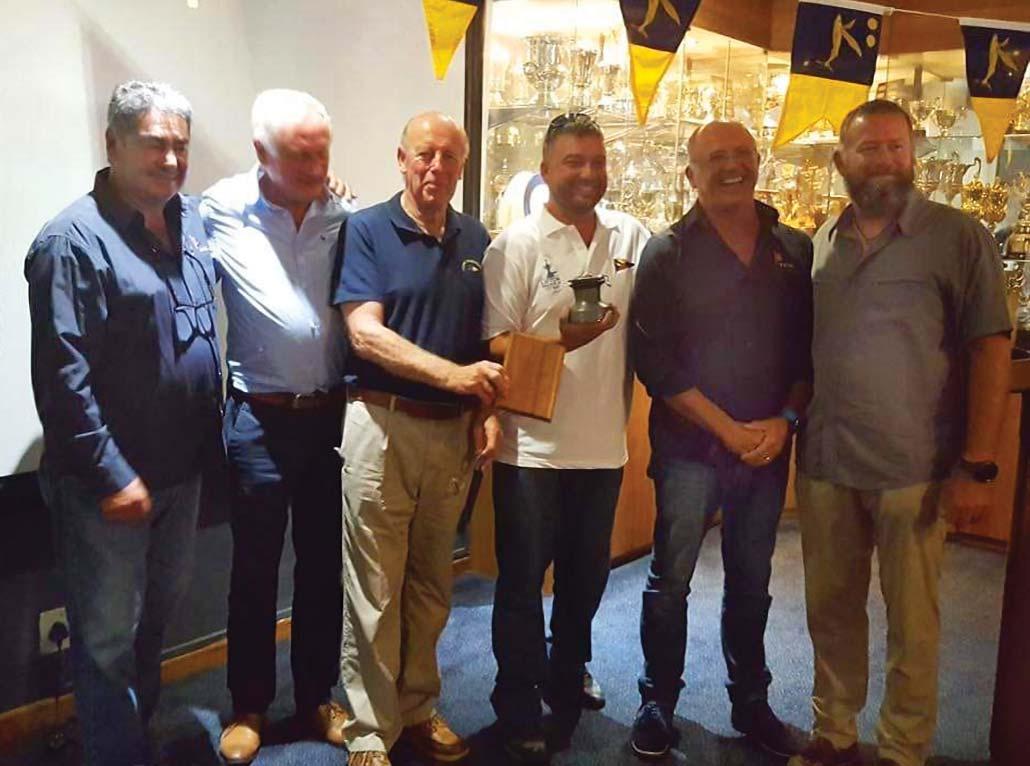
who is uncomfortable with compliments and scared of public speaking, an award ceremony in my honour where I was expected to give a speech was far more intimidating than any ocean passage. It was my first time as the centre of attention in a room full of sailors, something which still intimidates me. The evening went off without a hitch, though, and I made friends I still talk to today.
There were two remote places left in my path home – St Helena and Ascension Island – both of which I was looking forward to, though I was sad to leave South Africa. Just before leaving I read about an indigenous beetle only found in St Helena, but there is a different excitement level about beetles than there is about lemurs, rhinos, elephants, lions, hippos and African braais.
I did the 1700 mile passage to St Helena with full sails wing-and-wing, without reefing once in 11 days. This was the first passage I’d completed without reefing or closing my hatches! For the second time, Alan on Kiwi Dream met me with cold beers as I sailed into the anchorage. I hadn’t seen him since Madagascar, and we shared stories about
 Ascension Island
Ascension Island
our travels since we’d last shared an anchorage seven months earlier. There were eight yachts in the anchorage and I recognised all of them. The check-in process was quick and easy and afterwards I swung by the nearest bar to meet the locals. St Helena and Ascension are the only places I’ve ever visited where I could buy a drink in a bar for a single coin – it was a coin worth GB £2 / US $3, but it felt like the wild west.
The diving in St Helena and Ascension was amazing and the few cruisers there were all up for daily adventures. There were whale sharks and devil rays to swim with and tons of fish and lobsters for dinner. On Ascension there was even a nightly show at sunset when the baby turtles would leave their nests and head for the ocean. It was May 2019 and I’d planned to avoid the majority of the Caribbean hurricane season by staying a few months each in St Helena and Ascension, but ended up staying just a few weeks as my batteries were going bad and the dinghy davits needed repair if they were going to stay on the boat.
Max and Tanya in Alalilia left Ascension for Brazil at the same time as I left for Grenada. Four days into the passage they messaged me on my Garmin inReach from their satellite phone – they had hit a whale and lost their rudder. They were about 150 miles upwind of me, so I altered course to intercept. I asked them to send a position report with each message so I could judge their drift. It took about 36 hours to reach them and of course it was near midnight by the time I saw their masthead light swaying in the Atlantic swell. We had formulated a plan for me to give them my series drogue so they could steer their boat by drag. The tricky part was passing the drogue to a swaying boat without steering at night. The drogue was stored in a dry bag, to which I tied a line to throw to Max. I figured that as soon as I saw that he’d grabbed the line I could toss the bag into the water and he could haul it in. It went off without a hitch on the second attempt. Max and Tanya got it to work and continued to Brazil while I changed course back to Grenada.


Most of the world cruisers with whom I’d shared the Indian Ocean made short stops in the Caribbean before continuing to the Pacific or across to the Mediterranean. However, Fabio and Lisa on Amandala were still around to celebrate my arrival to Grenada and Fabio made a lasagne. It just happened to be 16th June, five years to the day since I’d sailed away from Hawaii. I made a few new friends in the Caribbean but it was a bit different. I was fatigued from five years of sailing alone and constantly meeting new people. Most of the Caribbean boats had come down from Florida or possibly across from the Mediterranean and suddenly I was usually the most experienced cruiser at the yacht clubs instead of the beginner who taught himself to sail from YouTube.
Thankfully I met Thom Darcy on Fathom, another solo sailor who had just completed his circumnavigation. I had heard of him from mutual friends but had never shared an anchorage with him. It was fun swapping world travel stories and hearing from him how it felt to complete a solo circumnavigation. One night, after a few of Thom’s Ti punches (rum, sugar and fresh lime) I lost my prosthetic leg overboard while putting my dinghy on the davits. I grabbed a light and my swim leg to have a look but couldn’t find it, so figured it had sunk and I could just dive for it in the morning. But after an extensive search the next day it was nowhere to be found – it must have floated away. After a few Instagram and online lost-and-found posts it was clear it was gone for good. Thankfully several companies offered to sponsor a new prosthetic – I just needed to fly to San Francisco. I said goodbye to Thom in Antigua. He was leaving for the Azores and I was off to the USVI to catch a flight to San Francisco. It was February 2020 and I was hoping for a two-week trip to get my leg fitted before heading to Panama in May to cross into the Pacific. Covid had other plans.
By the time I got back to Tiama in March the world was shutting down. Andy Tyska from Bristol Marine had contacted me a few months earlier and offered to sponsor a haul-out if I brought Tiama up to Rhode Island – Tiama had been built and launched in Bristol in 1983. I had declined his generous offer since it was a bit out of the way and I was almost home, but in May 2020 Panama was closed along with pretty much everywhere else in the Caribbean and the hurricane season was coming fast. I reached out to Andy and asked if his offer was still good and he said yes. The 1500 mile passage to Rhode Island took me two weeks, mostly because I had to avoid tropical storm Arthur which hit Bermuda. I took a big detour west of the island to avoid the storm and got 40 knots of wind and some rough seas.
Even after two weeks at sea it was not clear if I was supposed to quarantine on arrival in Rhode Island. I dinghied ashore in Newport, and though the streets were almost empty it looked like an Irish bar was open. It turned out that the bar itself was closed but I could sit at a table with plexiglass dividers around it. It was the loneliest I ever felt in my entire trip – after two weeks alone at sea I was finally around people again but in my own little fishbowl. I ate my dinner and went back aboard to have my celebratory Scotch after an ocean passage.
The sail to Bristol next day was pretty cool. It was fun bringing Tiama back to where she had been built after her lap around the world. The Bristol crew were amazing and eager to help. I left to do two yacht deliveries to pay for parts, and by the time I got back Tiama was hauled out with fresh paint on the bottom. In the two months she was there she got her cabin sole refinished, new rigging, new electronics including radar and AIS, bottom paint, brightwork on deck and engine service. She was ready for another lap.

I cruised New England for a while, stopping in Provincetown, Martha’s Vineyard and Long Island before continuing into New York City. It was amazing sailing to all these places I’d only seen on TV and I spent my first night in New York anchored right next to Lady Liberty with a bottle of champagne. It was October 2020 and the city was starting to open up, and I met some friends who were happy to show me around. It
 New York City
Leaving
New York City
Leaving

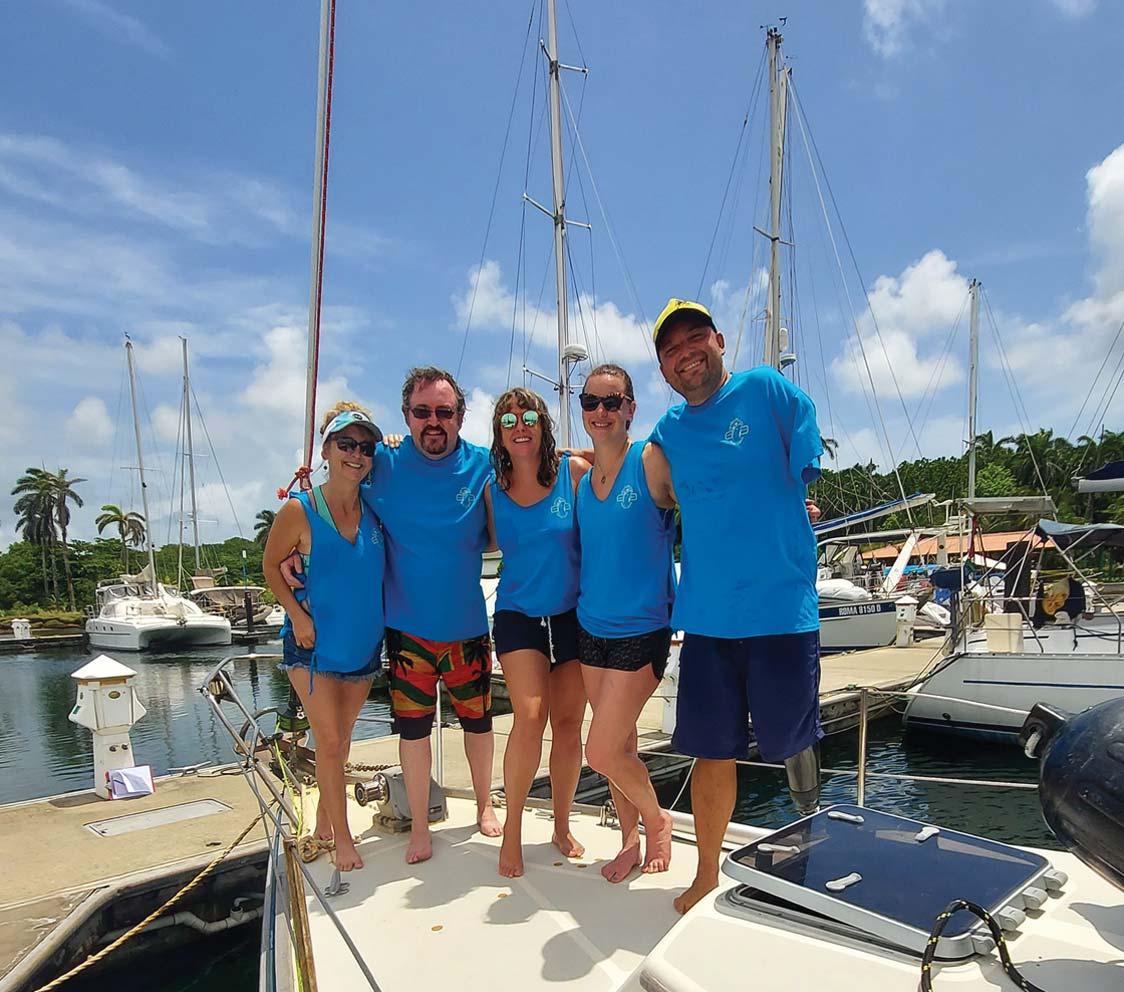
was nice seeing New York without tourists and to walk into all the famous museums without queuing. My six week stay was sponsored by One°15 Brooklyn Marina – I would never have been able to afford it otherwise. But November and the cold weather came fast and it was time to head south.
The weather windows south were short, rough and cold. I stopped briefly in North Carolina en route to the Bahamas to wait out a cold front and for good weather for my arrival, only to discover that the entrances through the reefs in the Abacos look a lot trickier than they are. Inside the reef was my first time sailing in 2m of water on purpose, which took some getting used to. When I dropped anchor off Manjack Cay on Great Abaco, Tim on Tardis dinghied over and gave me two fresh lobsters. We became instant friends and spent every day spearfishing and every night feasting. It is amazing to me that an inhabited area so close to Florida has so much sea life. There was clearer water and more lobsters and sharks in the Bahamas than anywhere else I’d seen.
The Covid restrictions in Cuba and Haiti were really strict so I just sailed by en route to San Andrés and Panama – a huge bummer as I’ve always dreamed of going to Cuba. Bocas del Toro in Panama was my first stop since Newport where there were a lot of cruising boats. Most had been there through the worst parts of the lockdown and had stories to tell. Cruising around Bocas was beautiful with tons of jungle wildlife. It really has
My Panama Canal crew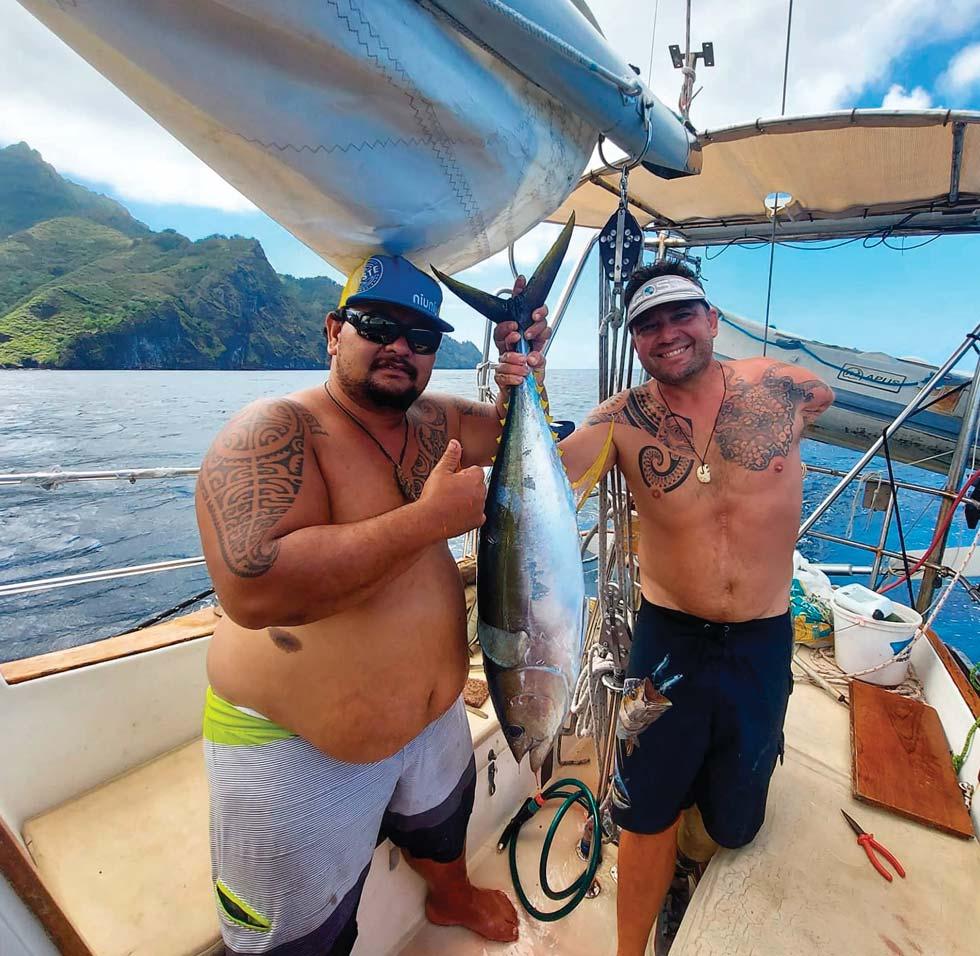
everything for cruisers, including great restaurants and bars, fresh produce delivered right to the boat and secluded anchorages just a short sail away. I could have stayed longer but the canal and the Pacific were so close.

I booked my canal transit for just after my birthday in May and four friends from Hawaii flew out to be my line handlers. It is the only part of my circumnavigation where I needed crew and it was special to spend it with friends. They were all extremely capable boat people and fun to have on board, despite the cramped conditions with five people on a 35ft boat. We laughed, drank, danced and planned my arrival home. As the locks opened and we entered the Pacific Ocean it felt as if I was already there. The idea that I could raise anchor at anytime and sail home was crazy after seven years away. There were just the Galapagos, the Marquesas and 5000 miles of Pacific Ocean to go.
The Galapagos and Marquesas were amazing and reminded me why I wanted to do this in the first place. The wildlife, island communities, salty world cruisers and Pacific Ocean were a breath of fresh air after two years in the Atlantic. I made new friends, enjoyed local food and customs, fished and dived as I waited for the Northern Pacific hurricanes to pass by. Then there was a total lunar eclipse on the night I left the Marquesas for my 1950 mile passage home. I daydreamed of rounding the rough seas of Hawaii’s South Point and sailing home up the calm leeward waters. It was whale season and I imagined being escorted in by breaching humpbacks and spinner dolphins. I was excited I’d soon see all my friends that I hadn’t seen in years.
As I approached the big island I could smell the dirt and plants before I could see it. I could feel the waves bouncing back off the island. I could almost taste the champagne ... and then a low pressure system hit and delivered the worst Leaving


weather I’ve ever seen around Hawaii. The last 61 miles took 24 hours of bashing into 30 knot winds through dense fog. There could have been whales around, but I wouldn’t have seen one unless it had landed on deck. I’d been told this was coming and had considered diverting to Hilo on the northeast coast, but a bunch of friends had flown out to see me finish my trip so I figured I could deal with one day of bad weather.

... as well as a traditional lei
As I approached Kona the fog started to lift and I caught my first glimpse of home. I’d been no more than 10 miles offshore for the previous 22 hours but hadn’t been able to see the island through the fog. I saw friends on a local sailboat taking pictures and drones flying overhead as I entered the marina I had left 7½ years before. Most of my friends that had been on the dock when I left were there when I arrived, but this time I was showered with champagne and covered in leis. I’d hoped I would have something profound to say after my long journey, but all I could think of in my state of exhaustion was, “That was easy!”.
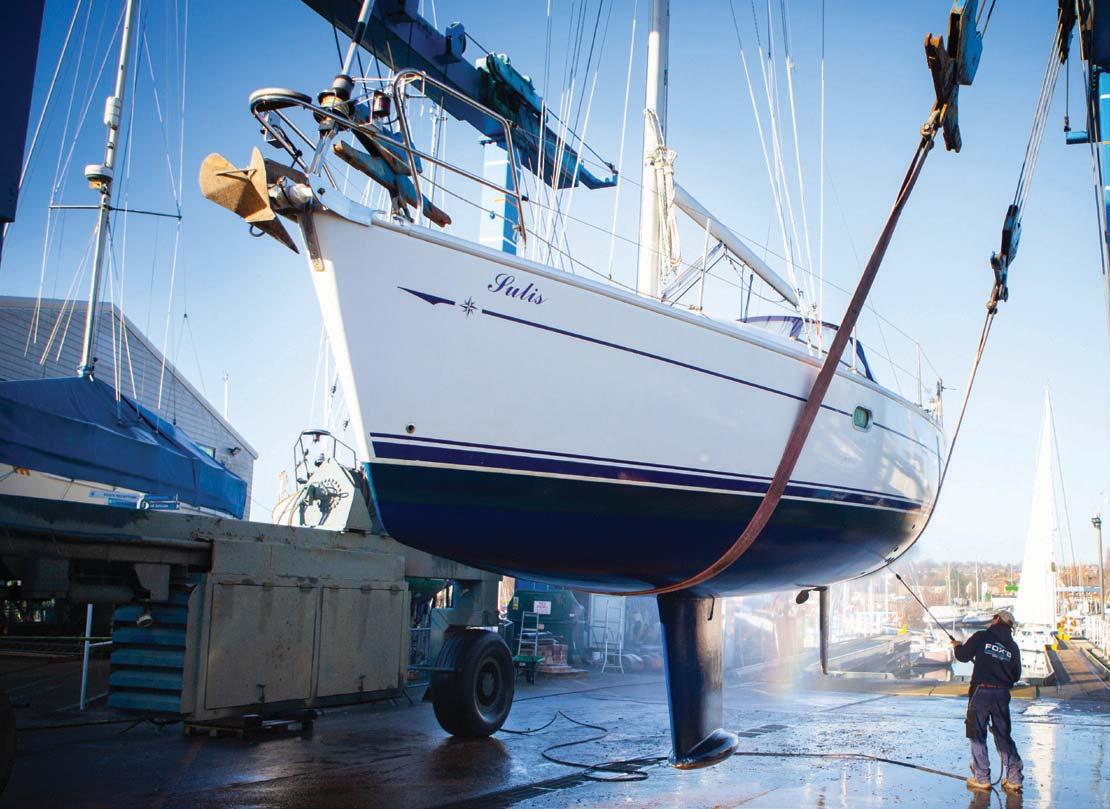

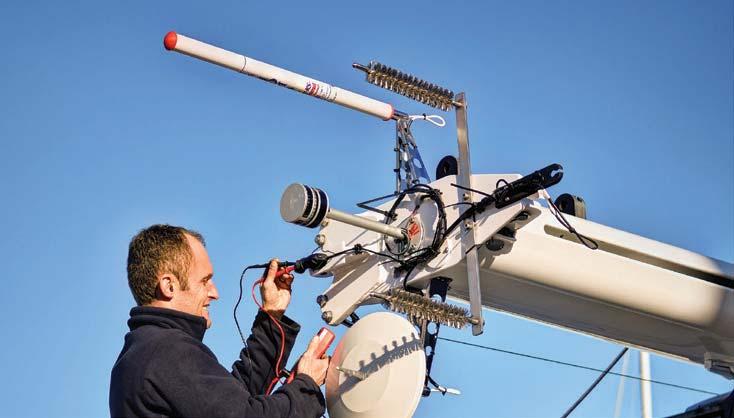
(Egret is a Sweden Yachts 390 which Patrick and Amanda have owned since 2007. Between 2011 and 2015 they circumnavigated via the Panama Canal and the Cape of Good Hope, completing the last 1650 miles of their outward Atlantic crossing steering by drogue after the loss of their rudder (see A Directional Challenge, Flying Fish 2012/2).
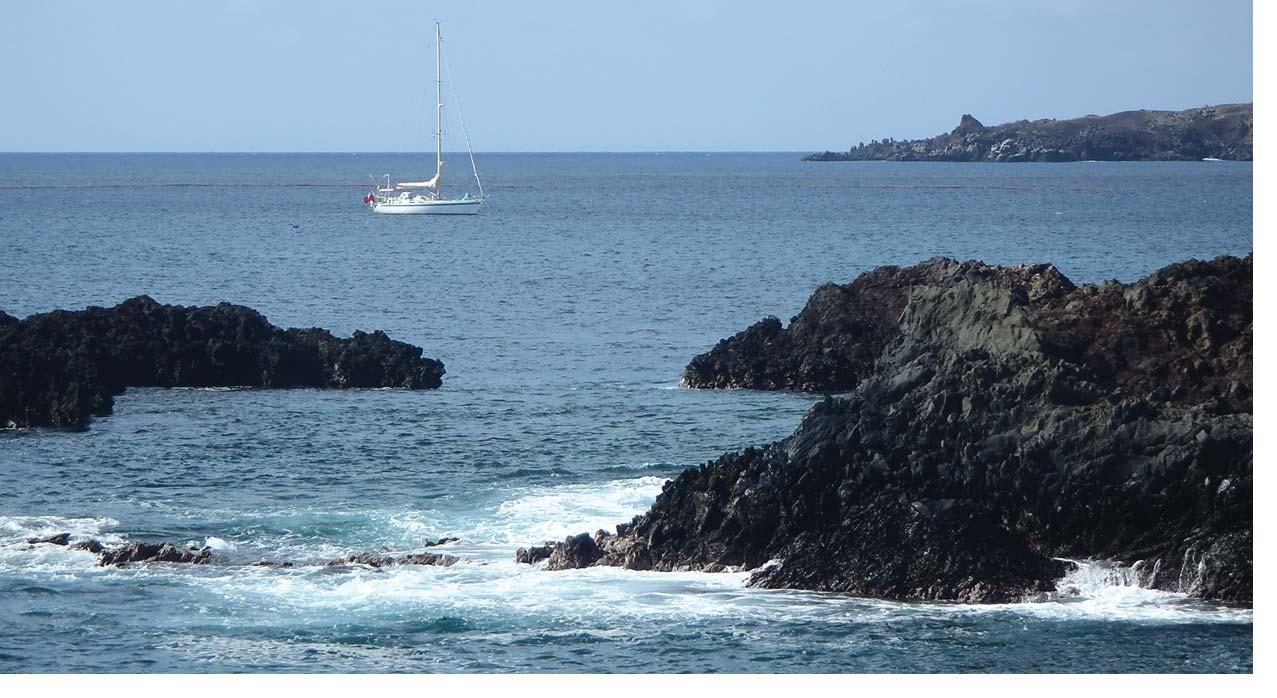
Over the past few years they have cruised the Biscay coast, the Irish Sea, the west coast of Scotland and onwards to Norway. Egret was laid up ashore on the east coast of Sweden in the autumn of 2020 where, due to Sweden’s strict Covid rules concerning travel from non-EU countries, she remained until the summer of 2022 when Patrick and Amanda were finally able to bring her home.
Much of the passage below can be followed on the chartlet on page 106.)
Looking towards Long Beach from where Egret was anchored in Clarence Bay, Amanda and I watched the ocean swell steepening before turning into combers which tumbled onto the yellow sand with a burst of spray. We were about 500m off and could feel a disconcerting amount of surge as the waves came past, but any further out would have been too deep to anchor. At dusk we could just make out, through the binoculars, some adult green turtles hauling themselves up the beach to lay eggs and, if we shone a torch on the water after dark, then as likely as not a baby turtle would paddle towards us, setting out on its hazardous journey to Brazil.
We’d been at Ascension Island about
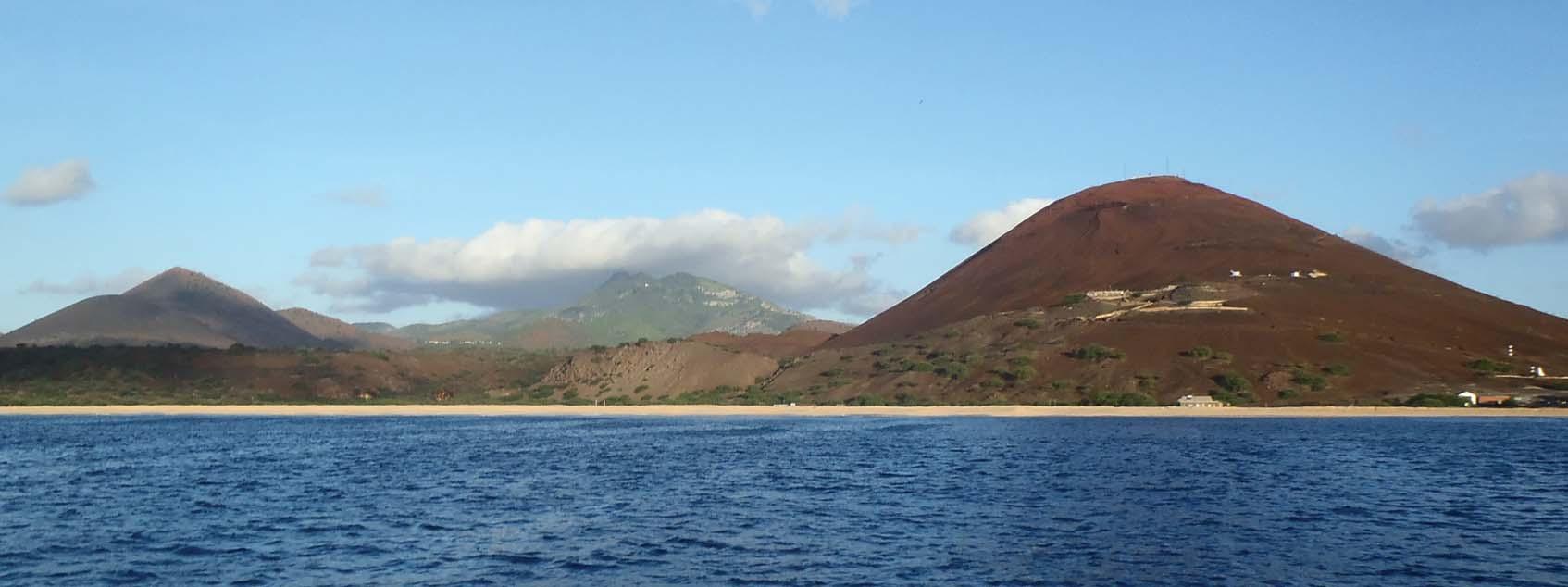
five days, but the heavy northerly swell was making landing by dinghy at Georgetown’s small quay somewhat precarious, not to say wet! We’d managed to see the sights around the town, do our essential maintenance work and provisioning, and book a car for later in the week to explore the hinterland, but the forecast was for the swell to worsen and, after a horrible night with down-drafts throwing the boat first one way then the other, snatching the anchor chain violently, we decided we should move on immediately.
It was late April 2015 and we were aiming to reach England by the end of the summer, the culmination of a four-year circumnavigation. From Cape Town, our plan had always been simply to head for the Azores – if this had been good enough for the Hiscocks aboard Wanderer III in 1955 and Wanderer IV in 1975, it would do for us! We were a bit surprised to learn that hardly any other boats were going our way. Most were heading for the Caribbean, but we felt that a second visit might be something of an anti-climax after all we’d seen on the other side of the world, and we’d still have a west-to-east crossing of the North Atlantic to tackle, seldom a straightforward passage. We had enjoyed stop-overs in Namibia and St Helena, but were ruling out Brazil due to a recent spate of nasty attacks on yachts. Our final call on this leg would be the Cape Verde islands, which would put us in a good position to tackle the northeast trades thereafter.

The first few days were pleasant enough with winds of between 10 and 20 knots on the quarter, allowing us to fly the cruising chute at times. Then on day five we noticed a tall column of cumulus cloud developing to the east, followed by a separate band of dark cloud. We put three reefs in the mainsail and furled the genoa just in time before

a squall engulfed us, though the gusts only reached 27 knots and were fairly short-lived, and we were back under full sail within three hours. Showers passed over regularly from early the following morning and the wind gradually backed to the northeast, easing to around 6 knots. We spent much of the day dodging the severest rain clouds, with reasonable success. We were now well and truly within the doldrums.

We crossed the Equator just before sunset, taking us into the northern hemisphere for the first time in nearly two years. We shared a celebratory tot of rum-and-lime and a slice of cake with King Neptune. Pilot books advise where to cross, depending on the time of year, so as to minimise the width of calms in the Intertropical Convergence Zone. With our usual scepticism we compromised, weighing up this advice against the latest weather information and the effect the offset would have on distance to sail. We initially aimed to cross at 22°W, revising it in the light of later forecasts to 20°W.
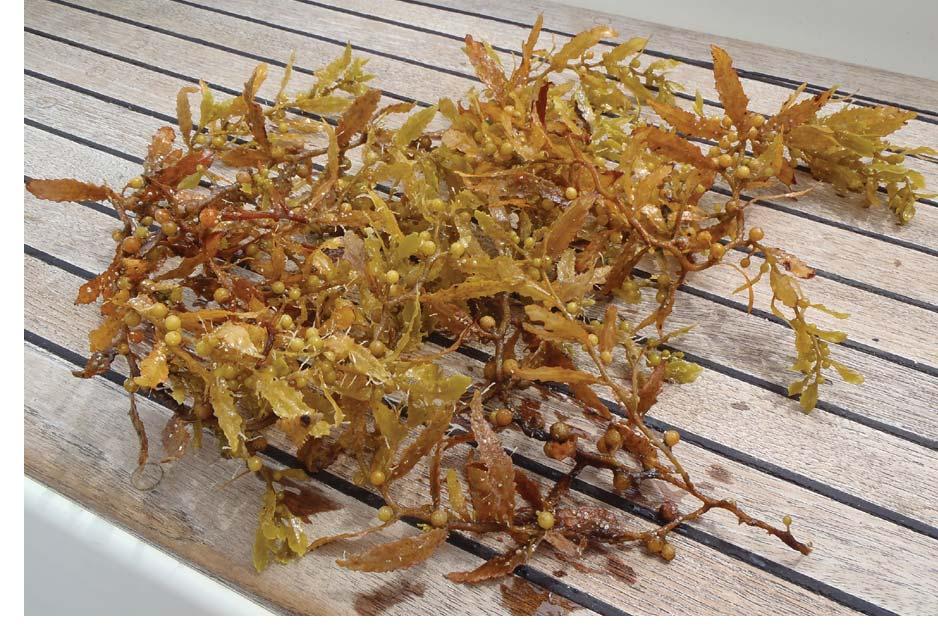
 In the doldrums close to the Equator, hoping to dodge squalls
In the doldrums close to the Equator, hoping to dodge squalls
A few days later we entered an area of cross-currents in excess of 2 knots combined with popply seas. We were passing over a seamount with a summit 2400m below us, rising from 4500m, which I hadn’t expected to have such influence at sea level. The weather over the next three days was a bit of a mixture – at times we enjoyed pleasant sailing in 8 to 12 knots of wind, mainly from the easterly sector, but we also endured long periods motoring across a gently undulating sea with hardly a breath. There were spells of steady rain and we had to remain diligent in case of squalls, but only three had much strength in them, with gusts of up to 30 knots. From time to time at night we saw flashes of lightning in the far distance, but thankfully none came close.
We passed through rafts of curly, yellow-brown sargassum seaweed which caught on the rudder, the blade of the Aries self-steering gear and our fishing line. When the boat started to slow, we cleared the weed by putting the engine into astern for a couple of minutes. We began seeing Portuguese men o’ war wafting past, capsizing in our wake to expose their venomous tentacles. The doldrums proved to be about 400 miles wide and took around four days to cross, half of that under engine.
The new trade winds arrived on day ten, but instead of northeasterlies we had to contend with northerlies. At first the sailing conditions were lovely – in fact it was a pleasant change to be sailing to windward in a gentle breeze after all that time rolling downwind. Over the next week, however, we had stronger spells when we set the staysail instead of the genoa, as well as several periods with scarcely any wind at all. It was getting hazier and, from about 9°N, red Saharan dust was showing up on light coloured surfaces such as the sprayhood. It was also getting chillier, needing a sweater on deck at night and a sheet to sleep under.
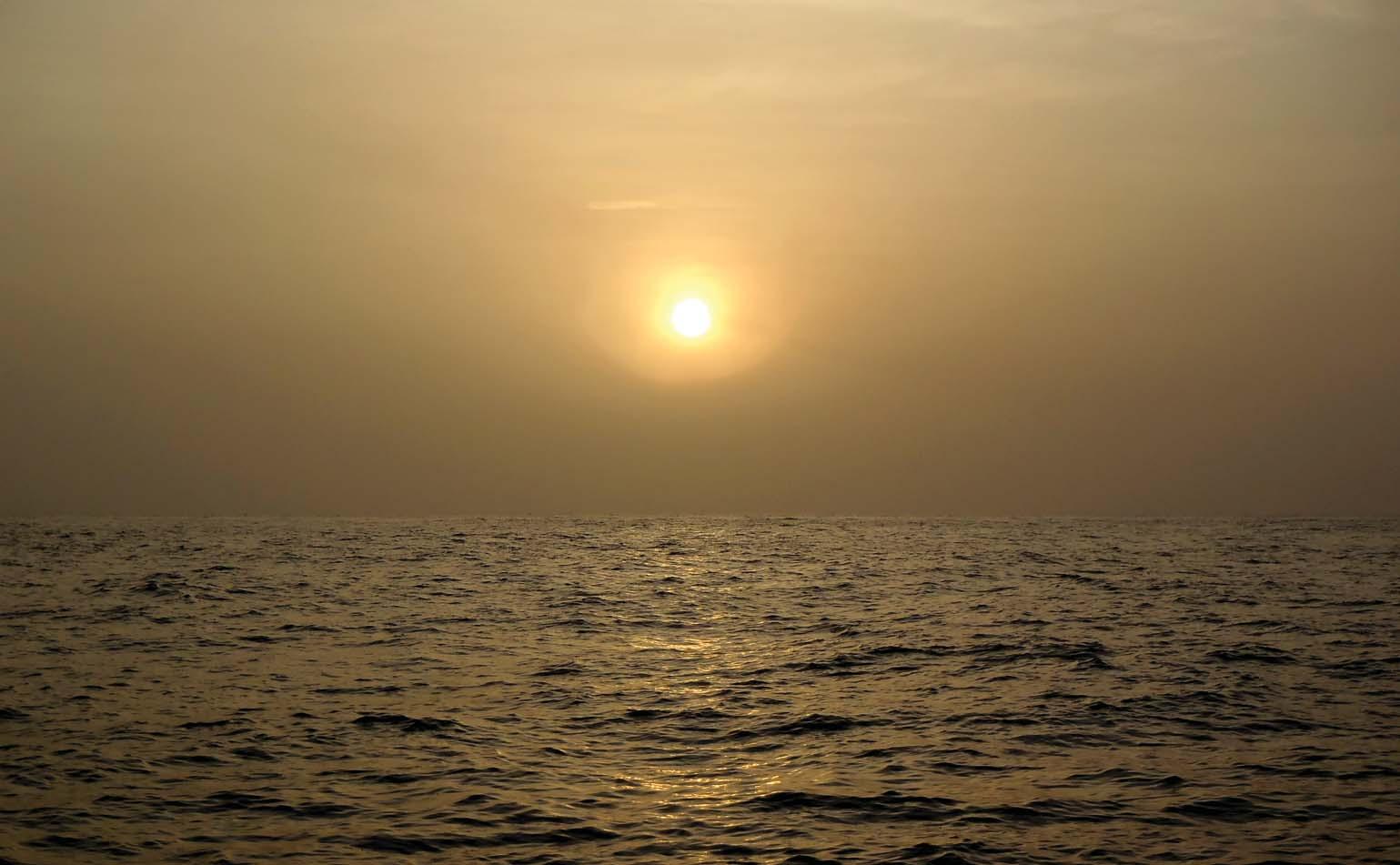
We saw more and more ships, including three big French fishing vessels which kept reappearing over the course of three days. We called one up on the VHF when it set off our AIS alarm – the captain laughed, and assured us there would be no collision. They don’t realise how intimidating their ships look from the deck of a small yacht. Another ship reported that some equipment had collapsed, leaving floating debris –great, that’s all we needed! We certainly didn’t want a repeat of the damaging collision that had removed our rudder during our outward voyage from Cape Verde to St Lucia four years earlier.
We are used to hearing chatter on VHF Channel 16, usually fisherman having no respect for the rules. For two nights running I heard a series of rather sinister, one-sided conversations. A man was giving instructions in heavily accented English for some indecipherable operation, and at one point I heard what sounded like pistol shots, shouting and a scream! Perhaps it was just my tired yet vivid imagination playing tricks, or else a radio play intruding onto the airwaves. We were 400 miles off the coast of Sierra Leone, which one would expect to be safe from piracy, but I turned off the transponder function of our AIS set just in case.
We had originally intended going directly to Mindelo, but were running low on diesel so decided to call first at Porto da Praia on Santiago, 150 miles closer. On the morning of the seventeenth day we had our first sighting of land at only eight miles away. The breeze initially faded but, seeing wind on the water ahead, we hurriedly pulled in three reefs before hitting the acceleration zone of high winds blowing off the hills. After a short encounter with strong gusts and choppy seas we gained the shelter of the harbour at midday, and anchored under the ramparts of the picturesque old city. We had logged 1620 miles.

Hardly had we got the anchor down when a boat appeared from the docks on the east side of the bay and came alongside. George told us that he ‘looked after’ all the cruisers who visited Praia and would give us a lift ashore, where the immigration officer was supposedly waiting for us. Always a bit wary of pushy boat boys, we told him that we weren’t quite ready and would come ashore in our own dinghy. Friends had advised anchoring in the northwest corner of the bay, beaching our dinghy between two old concrete jetties, where fishing boats were hauled out for
The waterfront at Praia, Santiago. We landed our dinghy between the two piers to visit the maritime police in their blue building amongst the trees
repair. As we approached two lads ran down, waded out and cheerfully pulled our dinghy above the tideline almost before we could get out. They looked surprised and happy with the few escudos we gave them in return. They indicated that they would look after our boat and pointed out the office of the maritime police on the other side of the fence.
The officer cleared our yacht into the country with the minimum of questions and paperwork, pleased that we were revisiting after seeing the Cape Verdean stamps already in our passports. He advised us that it might be unsafe to walk to the immigration office in the port so we should take a taxi. George was looking out for us, though a bit put out that we had landed our dinghy away from his patch, but he earned himself a tip by leading us to the immigration office and afterwards hailing another taxi to take us into the town.
The walled city of Praia, the capital of Cape Verde, is located dramatically on high ground above cliffs at the head of the bay. Factories nestle in the valleys on either side and concrete tenement blocks, painted in white, blues and yellows, rise in tiers one behind the other on the hillsides. The seaward edge of the city is dominated by an old fort which, by the rousing call of a bugle at regular times each day, we presumed to be still in use. The attractive 18th and 19th century buildings were mostly in good order and even the bland modern façades were painted either in cheerful colours or with artistic murals. The guide book had been rather off-putting, so we reckoned there must have been big improvements in recent years. There was an air of prosperity, the busy streets were noticeably clean and litter free and the inhabitants well dressed. We felt welcome in the centre and perfectly safe walking between it and the boatyard.*
The harbour was calm in the prevailing northeasterly wind and one would expect the breakwater to provide good protection except from the southern quadrant. A few other yachts were anchored near the docks, all French and apparently semi-permanent. We took our dinghy there to buy diesel from the service station, where George beckoned
* Sadly Praia has gone downhill since Patrick and Amanda’s visit in 2015. While the city is still safe and well kept, the anchorage can no longer be recommended. In the past three years a number of yachts have been boarded and ransacked at night while their crews slept, culminating in a case when the crew woke up, only to be attacked by the knife-wielding intruders. See page 411 of the current (7th) edition of Atlantic Islands for more details.
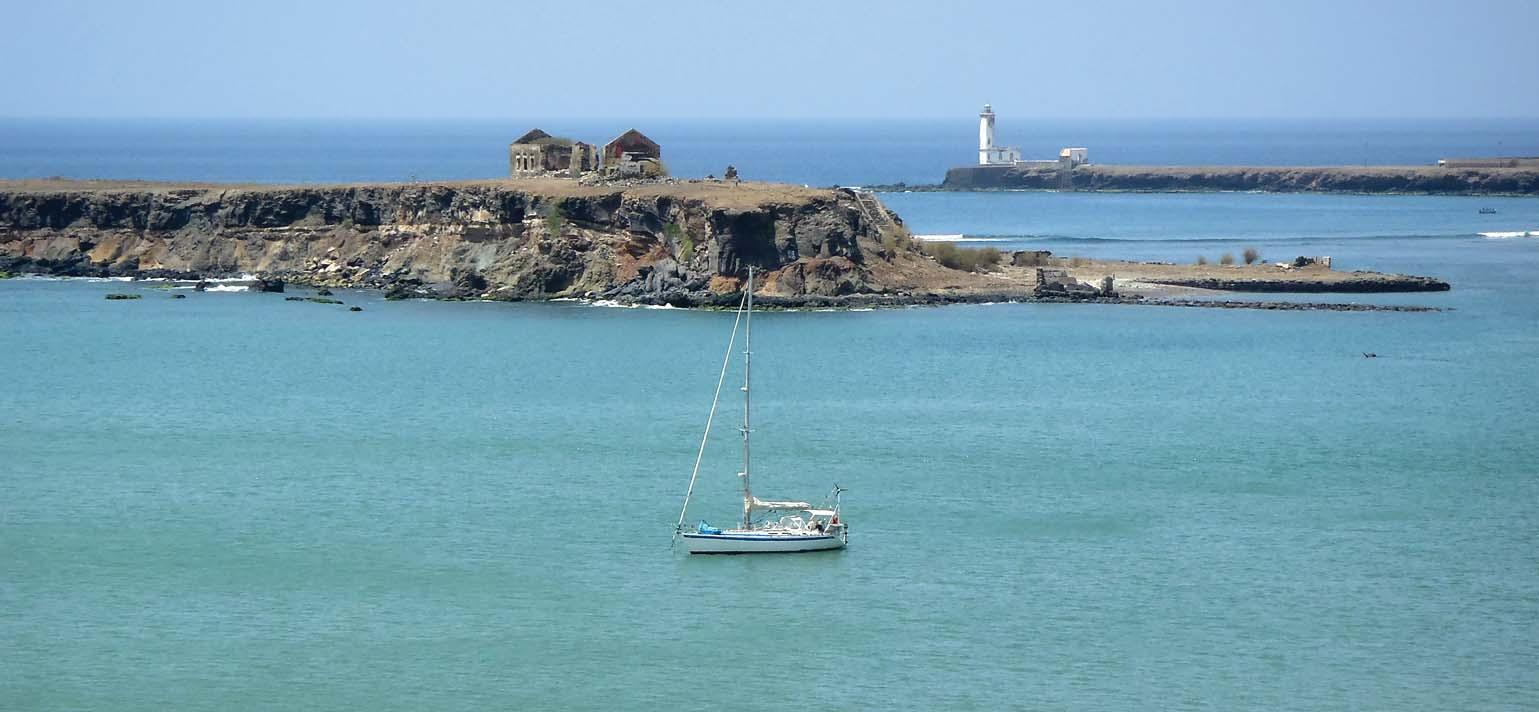
us to tie up against a derelict fishing boat and insisted on helping with the cans. He also guided us in buying fruit and vegetables from the street market. To be fair, he did work quite hard and was useful in that he spoke reasonable English.
Sadly we only had time to stay two days before setting off after lunch for Mindelo. Once through the race off the headland we sailed through the night, with the sheets just eased, up the east coast of the island. That morning, punching into steep head seas whilst reflecting on our wonderful cruising adventures, the following lines sprang to mind (with apologies to John Masefield and Cargoes):
Graceful British sailing yacht coming from Ascension, Butting through the Tropics under gloomy grey skies, With a cargo of memories, Souvenirs, friendships, Experience, and learning from the words of the wise.
During the afternoon the wind and waves increased further and it continued blustery and rough into the next night, with seas breaking over the deck. From around dawn, as we fell under the lee of São Vicente, conditions eased rapidly. We first sighted the saw-toothed outline of mountains through the dust-laden atmosphere when 8 miles off, and continued across a flat sea under the high volcanic cliffs, soaking up the morning sun. We headed into the bay of Porto Grande and anchored off Mindelo – quite a moment for us, having just crossed the outward track of our voyage. We celebrated our 3½ year, 34,700 mile circumnavigation with an excellent bottle of South African Villiera Tradition Brut Rosé from Egret’s cellar.
Celebrating our circumnavigation in Mindelo

Mindelo seemed more colourful, less run down and cleaner than we remembered. There were fewer derelict ships, and the remains of one of the last was in the throes of being dismantled by a team of divers. The water was surprisingly clear and from time to time a turtle would pop its head up for a breath of air. The harbour frontage looked particularly attractive, with brightly painted buildings behind the fishing boats pulled up on the beach. It could be that our senses had changed after travelling around the world, but we felt encouraged that this African country seemed to be achieving such improvements to its standard of living.
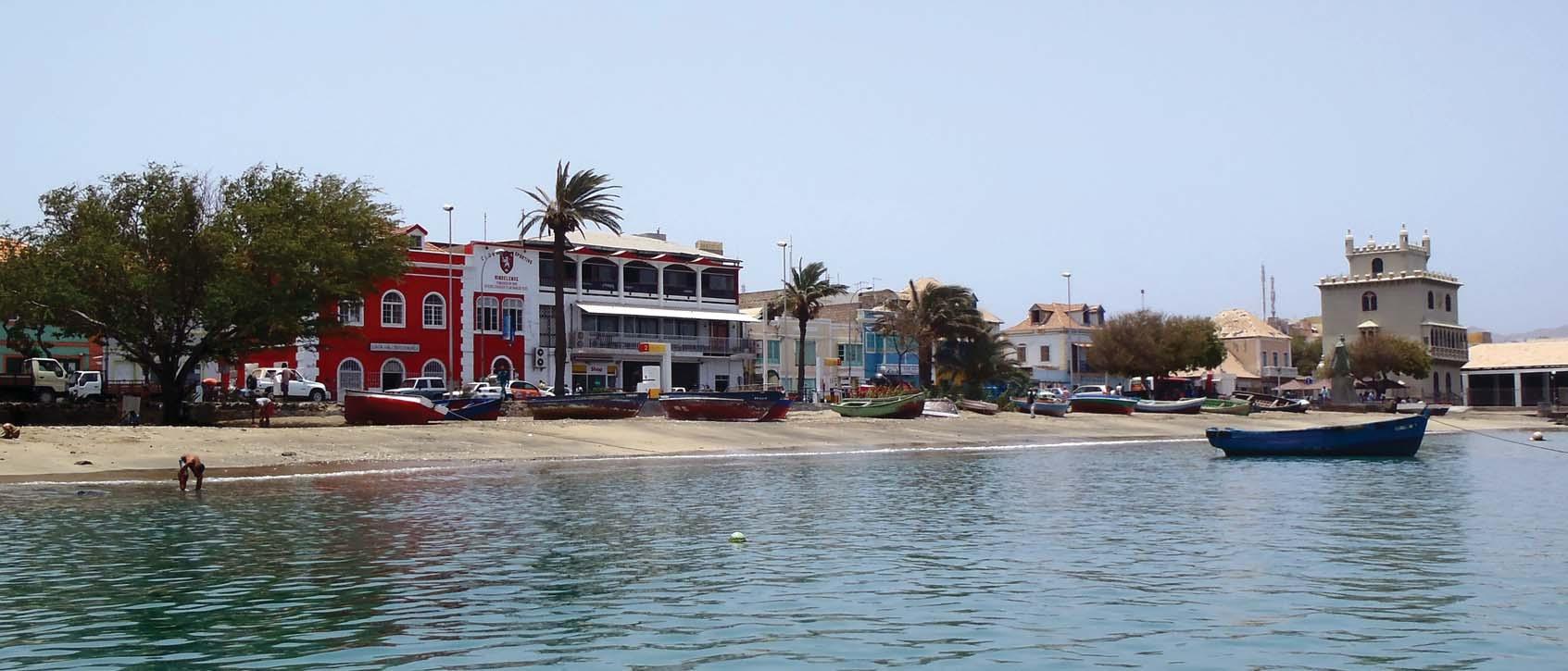
There were only two other boats at anchor and – out of season in mid May – the marina was less than one tenth full, very different from the final few months of each year when the harbour is usually packed with yachts preparing to cross the Atlantic. The wind howled out of the valleys and got stronger day by day so, fed up with being wrenched about by the gusts, we moved to the marina. We still surged and rolled, but at least it felt safer and we could get ashore and carry out our jobs more easily. The Welsh yacht Sula arrived towards the end of our stay and it was a pleasure to spend a convivial evening with Pippa and Dee, last having met up in Simon’s Town, South Africa.
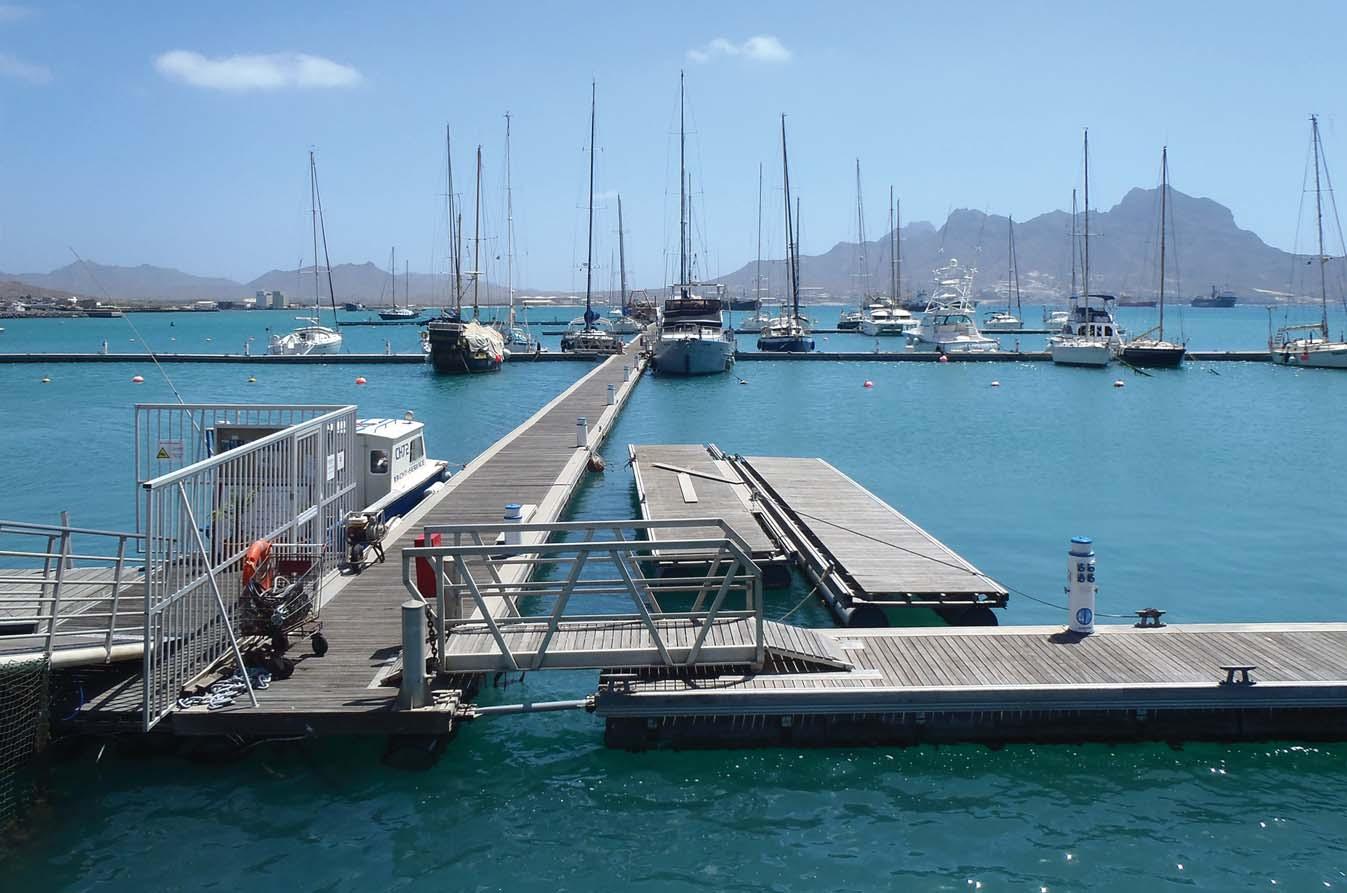
The marina was largely empty
We were eager to leave for the Azores but the excessive winds, with too much north in them, kept us waiting. Our plan for the 1400 mile upwind leg was to start conservatively with the sails snugged down, accepting that we might be set slightly west of the rhumb line – weather-routing charts showed the trade winds having more east in them at higher latitudes, which would lift our course later on. Eventually we would run into the horse latitudes, where anything might happen but with a good chance of favourable westerly winds.
At last the forecast began to improve. We paid our dues to the maritime police and cleared immigration before the weekend, spent Saturday morning buying fruit, vegetables and beef at the market, delicious bread from the bakery, provisions at the much-improved supermarkets and finally we topped up with diesel. On Sunday we moved back out to the anchorage and prepared for sea.
We winched up the anchor at dawn, hoisted the mainsail with three reefs, set the staysail and headed down harbour. We had to hold back for some shipping movements, including dodging the same French fishing boat that had caused us anxious moments on our way up to the islands. The next challenge was to escape the winds that accelerate through the seven-mile-wide channel between São Vicente and Santo Antão. We were soon enduring a bucking-bronco ride, motor-sailing against 20 to 30 knots of wind, a 1 knot current and a very steep chop. By midday, after three long tacks, we were finally clear of the islands’ influence and sailing in easier winds and seas. We shook out a reef and settled down for the long beat up the North Atlantic.
Egret made her way relentlessly, steered effortlessly by Papa Duggan*, her Aries self-steering gear. The plus points of sailing upwind rather than down are the steadier course, the higher output of the Airbreeze generator (which avoided needing to stream the towed generator), and an end to the annoying clonking from side to side of stuff in the lockers and drawers. Jealousy would overcome me sometimes and I would take over the wheel from Papa Duggan for a couple of hours – is there anything more satisfying than working a well-found yacht to windward in a stiff breeze?
It was three days before we were clear of the Saharan dust cloud – a relief to be able to breathe pure air, scan the distant horizon and see the moon and stars twinkling brightly in the night sky. With the crossing of 23°N on day five we sailed out of the tropics for the final time. The weather over the following week was mixed, with some gloriously clear, sunny days, others with the typical puffy white clouds of the trade winds and just a couple with rain. The wind strength was generally between 10 and 20 knots, with only one occasion when it reached 25 as we passed through a front. Even the direction of the trade winds behaved, shifting slightly from time to time but trending from 040° when we set out to 075° at about latitude 30°N.
We knew that Sula would be following in our wake, but most yachts departing Mindelo were heading to the Mediterranean via the Canaries, carrying extra fuel in anticipation of hours of painful upwind motoring. We were in SSB radio contact with several yachts that had left South Africa ahead of us, bound for Europe via the Caribbean. With the hurricane season approaching they too had set off for
the Azores, some encountering severe gales. Olaf, with his wife and three children aboard the Swedish yacht Miss My, had met gusts of over 50 knots in a terrible thunderstorm. They later spotted a dismasted, abandoned yacht. Jan, on the German yacht Voyager, told us that they had sustained damage and were returning to Martinique. After reaching land, we learnt that a catamaran had capsized in the same area with tragic consequences.
Six days out, we sighted a large sperm whale running parallel to us on our port side, blowing regularly. Then over to starboard we saw another adult with a youngster which kept leaping clear of the water like an exuberant child. We were relieved that they didn’t get any closer, and slowly left them astern. Several pods of dolphins came past, including one of around two hundred strung out in a long line. We were seeing more and more Portuguese men o’ war as we headed north, but they tended to be smaller than the ones we’d seen earlier. Towards the end of the leg we were surprised to see a juvenile loggerhead turtle swimming past.
We had been monitoring a deep depression which was racing across the Atlantic with the centre forecast to pass just north of the Azores. On day ten, a change in the weather brought rain and fluky winds, eventually settling from the north. We made the best of it by remaining on starboard tack, heading northwest to pass behind the depression and so avoid the strongest winds. It was much chillier now, needing sweaters and oilskins on deck and a sleeping bag on our bunk. Next day the wind backed to the northwest so at last we could tack, something of a relief after so long heeling the other way. The breeze promptly died to less than 6 knots so we turned the engine on, but annoyingly it had developed a bad oil leak from behind the water pump. I rigged up a plastic cup to collect the drips, but had to stop the engine every three or four hours and return the contents to the sump, a tiresome, messy job. The wind gradually boxed the compass, eventually filling in at about 15 knots from the southwest, and after 30 hours of continuous motoring we were able to shut down the engine and enjoy the wonderful feeling of sailing with the wind abaft the beam.

We were expecting a front associated with the depression to pass over and, sure enough, the wind increased during the early hours of day fourteen, briefly up to 27 knots, accompanied by rain and a veer to the west. A lovely sunny day with a gentle breeze followed, but in the evening the wind died completely. We resorted to the engine and motored on through the night across an ever flattening sea. In the grey, pre-dawn light the islands of Faial and Pico appeared, like a pair of cymbals face down on a silk cloth. The excitement was building – we still experience the same frisson as we approach a new island after a long passage, even after visiting ninety of them! We berthed alongside the reception dock in Horta amidst an exuberant throng of yachts from myriad nations. It was June 2015 and we were back in Europe, just 1500 miles from home.
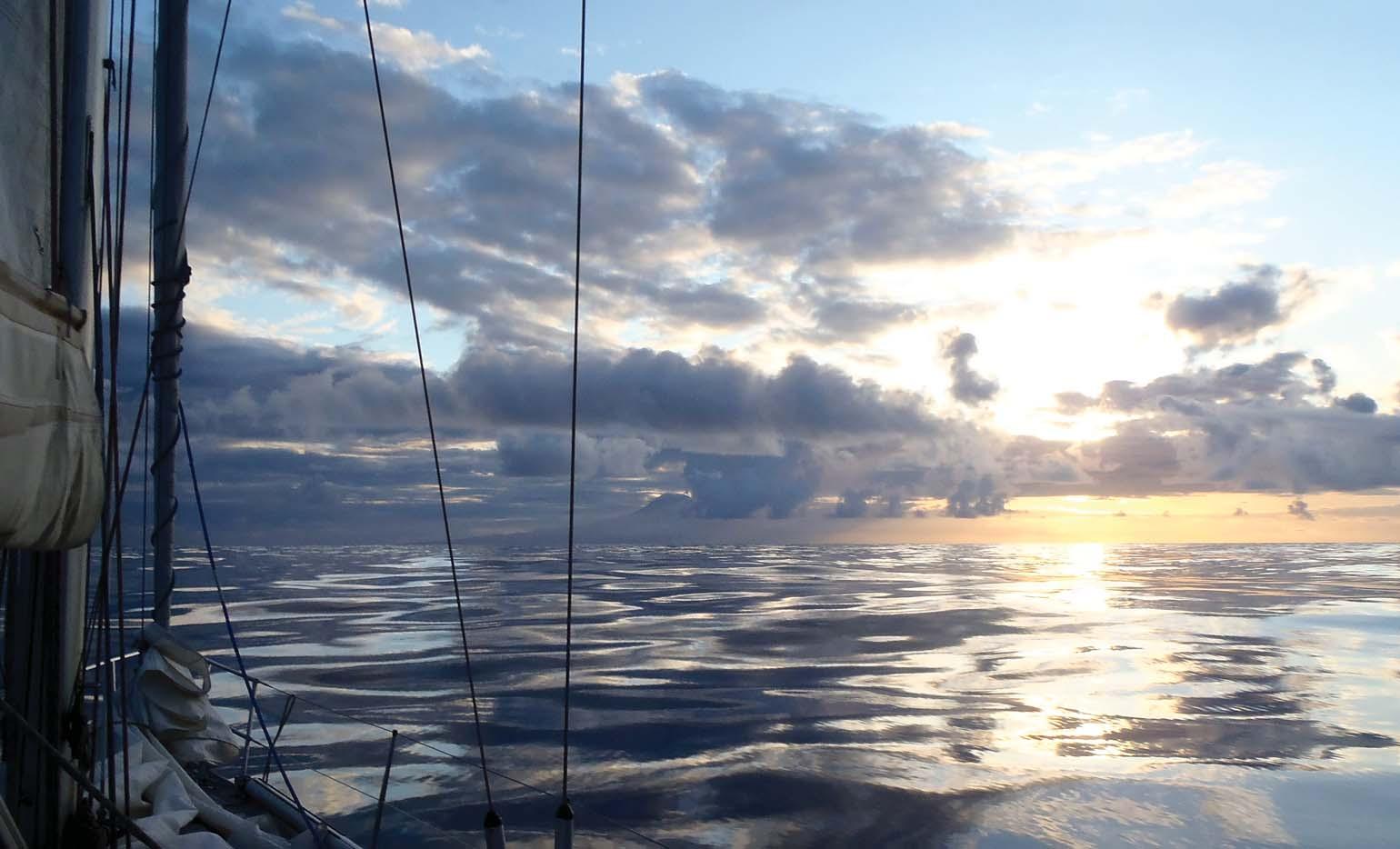
Egret second from the wall in Horta, flying her OCC burgee
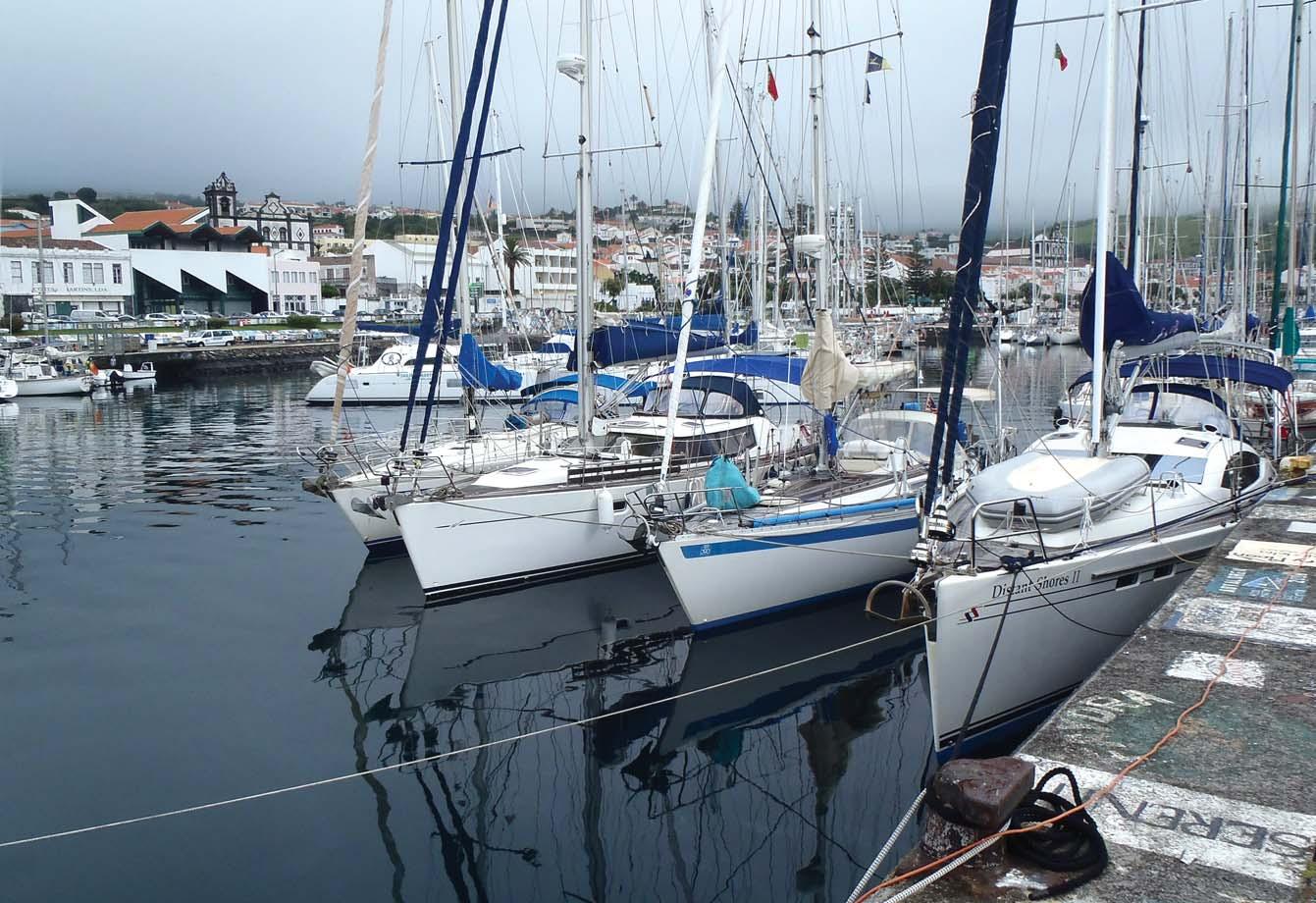 Faial and Pico just visible in the dawn calm
Faial and Pico just visible in the dawn calm
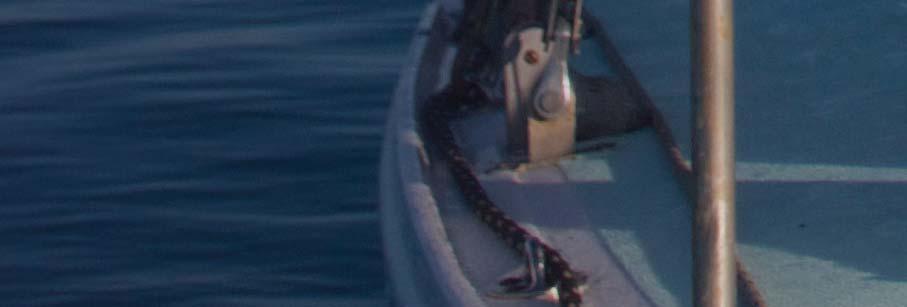

“Join us today, we need all hands on deck if we are to have a living, thriving ocean for future generations to enjoy.”



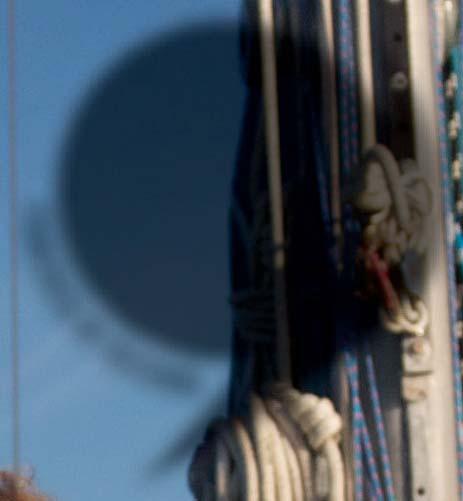


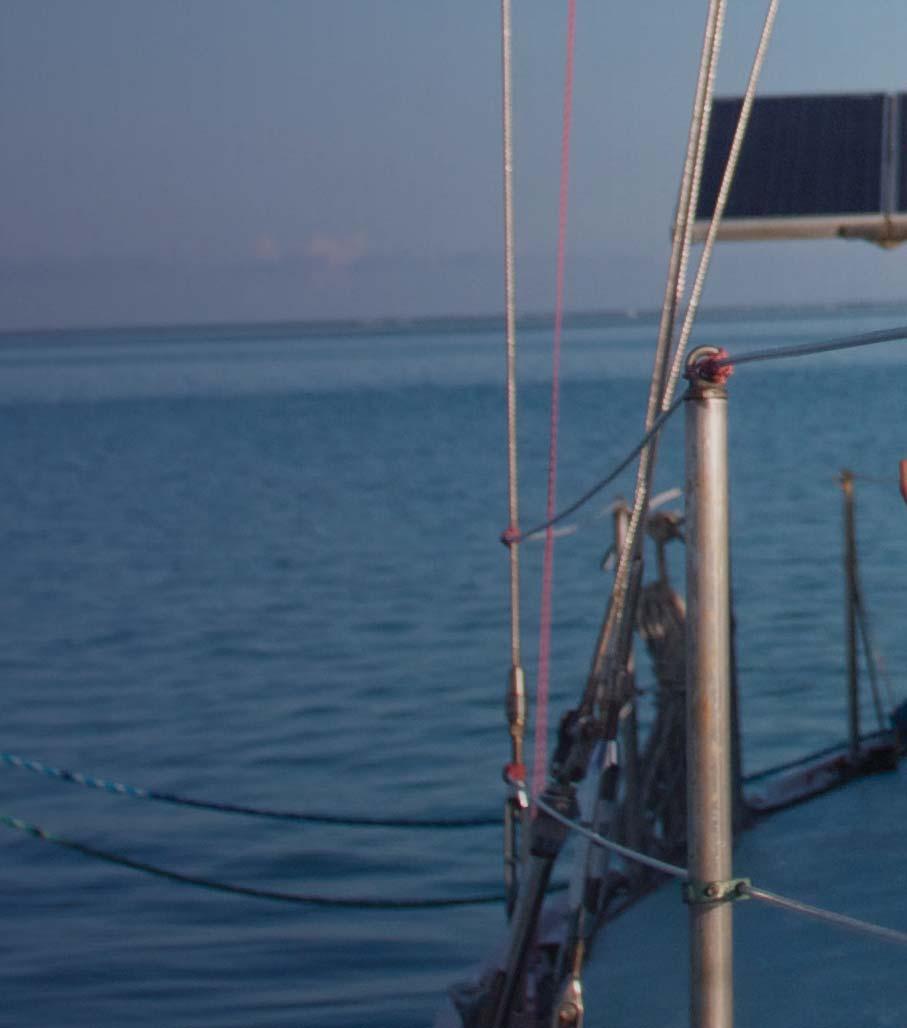
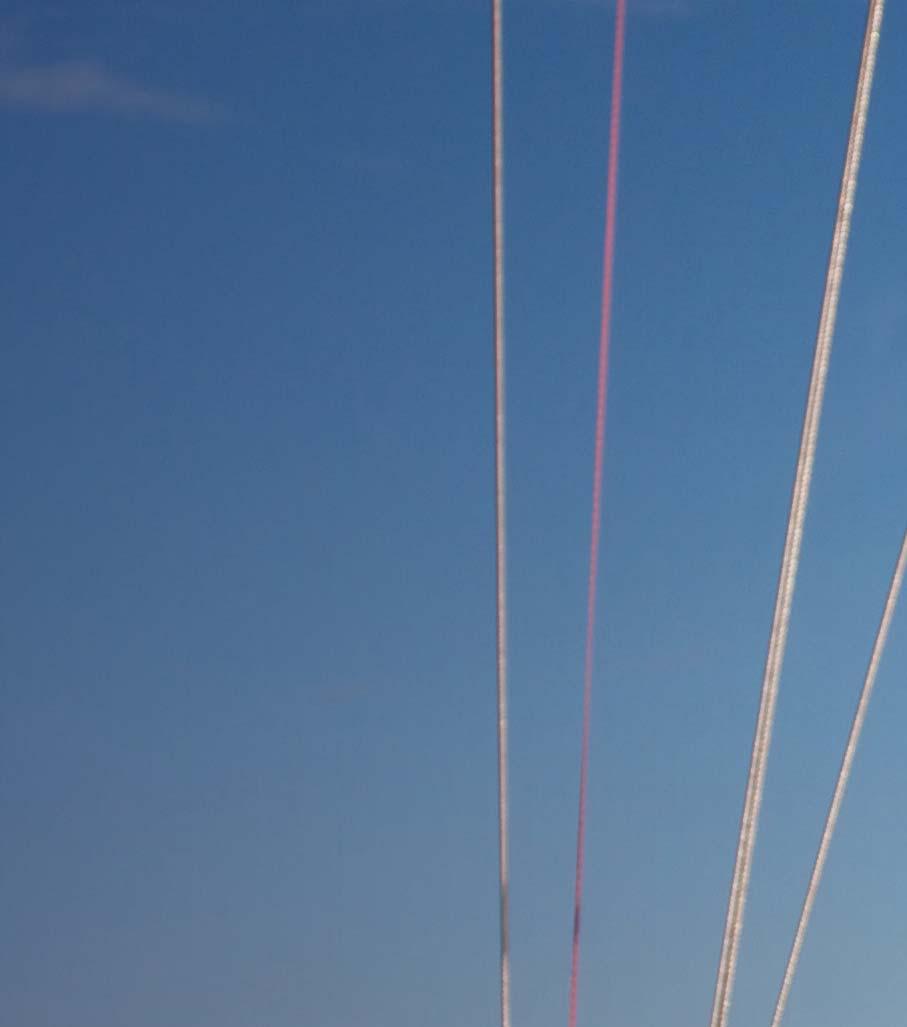

- Liz Clark, sailor, surfer, and environmentalist

(Following the sad death in September of past OCC Club Secretary Anthea Cornell Stock – see page 215 – her account of probably her most dramatic sailing experience came to light. Although originally sent to a friend, permission has been given to reproduce it here.)
In June 2001 the OCC held a rally in the Azores, ending in Horta. I had to get the summer mailing out before leaving home, so didn’t have time to sail down and consequently joined the ‘air contingent’. The rally was a great success – well-attended and much-enjoyed, with boats converging from several directions. The Azores, and the Azoreans, remain delightfully unspoilt.
Not having to be home to a deadline, I was pleased to be invited to sail back on a member’s 46ft boat. Or, to be more accurate, I was beguiled by the idea of a sail back, though not so keen on doing it in a catamaran, which this was. I’ve never liked multihulls and never cruised in one. However, both boat and owner Mike – and the other five crew members – were colourful and enticing, so with just a twinge of concern I ditched my return air ticket and went aboard Dazzler. I was pleased to see that she had an escape hatch in each hull, and even more pleased that one was in my cabin in the port hull.
On Tuesday morning, 36 hours into the passage, the weather was light and we’d eaten a large and excellent brunch on the huge open bridge deck (I called it the ballroom). There were two people on watch, full main, spinnaker and small staysail were set and I was in my cabin writing. We seemed to be scorching along. I went into the chart room where the boat speed screen read 17 knots. Plenty fast enough, I thought, though maybe not for a catamaran – what do I know? I commented on it out loud and the owner, resting on the chart room bunk, eyes closed, snuggled into his pillow: “That’ll move us along nicely”.
Our hull lifted. Should it do that? It settled, then lifted again, throwing the owner out of his windward bunk and across the chartroom. I wedged myself, then became like a hamster in its wheel as the hull reared up and the whole yacht, like a giant panjandrum*, its not-quite-rigid frame creaking with the abnormal stresses, went oh so slowly, it seemed, into a half-pitchpole, half-roll, objects falling and clattering all around.
The helmsman had been steering on the windward wheel, on our hull, and as we got to the point of no return I was looking out of our hatch. I heard a voice say “Oh Mike – I’m so sorry”, and saw a figure, mercifully not attached to a lifeline, go into free fall and post itself feet first (luck rather than judgement, I think) through the hatch – at that point under water – of the other hull. The roll completed itself. The silence was eerie. A small, rhythmic lifting of the boat on the light swell. Then Mike’s voice, with perfect timing: “Oh, bugger!”
Mike and I were the only two in our hull. The other three who’d been off watch were in the starboard hull, along with the ex-helm. Peter, the other watchkeeper had, it turned out, been thrown clear of the boat, but easily swam back. Having checked that
all was well in the other hull he then joined us via our emergency hatch. Whatever else had been submerged or lost, the EPIRB was right in front of me. We set it off – or rather, we hoped we’d set it off. Its light was certainly flashing but you never know!
Unlike ours, the forecabin of the other hull had a watertight bulkhead when its door was shut (which it was) so that hull was floating higher in the water than ours. The four in there were moving around quite easily and able to recover one or two of their possessions. We were about waist deep in water, so set about finding a place each to lie as comfortably as possible out of the water and wait. Mike was on what would normally have been the underside of a shelf while Peter and I lay each side of the engine on what had been the underside of the cabin sole. It was oily, quite cramped (particularly for Peter, who was over 6 feet tall), and acid was dripping from the battery.
We talked about anything and everything – our homes, working careers, early life, family and friends, sailing experiences. A previous capsize (yes, it had happened to Mike and Peter before) and rescue. On that occasion they’d had to take to the liferaft as the yacht was sinking. We hoped that Dazzler, which was of polystyrene sandwich construction, would be unsinkable. Breakable though, if we were rammed by something large. We weren’t keeping a lookout and wouldn’t have been able to take avoiding action even if we’d seen something approaching on a collision course, while the VHF, fixed to the chart room bulkhead, was submerged well below the waterline. It was afternoon, there was quite a bit of ambient light and, I hoped, of air – I still haven’t worked out how long we’d have taken to use up the oxygen in our air pocket. The swell lifted us every few seconds, compressing the air in our ears and making the mast, mounted on giant ball bearings for feathering but now under tension, clank monotonously.
The water was at arm’s length below us. Various familiar objects floated into view –a sandal, my blister pack of blood pressure medication, my handbag (too far below to rescue) and the liferaft in its heavy PVC zip bag. We decided we’d better try to attach it to some part of the boat even though it was unlikely to go anywhere. I spent some time – I don’t know how long – biting through a tangle of light line (we had no knife between us) to separate off a usable length. I decided later that the liferaft was not just useless but positively dangerous. It was too big to push out through the escape hatch and too buoyant to drag down under water and out through the main hatch, and if it had inflated in the confined space we were in it would probably have trapped us.
Happily the EPIRB had done its job and a reconnaissance aircraft made a first pass at dusk, flying low. It made three or four passes in all, by which time several of us were on the upturned bridge deck, waving. We heard afterwards that they’d been calling us on VHF, but of course we weren’t receiving. Later we learned that two or three OCC yachts in the area had heard the plane calling us and ‘nearly been blasted out of the water by the strength of the signal’.
Our rescue ship was a 10,000 ton Blue Star Line freighter which happened to be in the area waiting for instructions. It was now dark. We stood on the rough bridge deck (normally the underside) and watched as she manoeuvred into position to windward of us, her raked bow towering over us and searchlights shining on us. She put rope ladders and nets over the side and fired rope-ends to us to tie round ourselves. We all made it aboard one way or another, but with few possessions apart from what we stood up in. I was wearing shorts and had bare feet. Also, though I had a life jacket on I had no lifeline, so had had to kneel on the rough bridge deck to hang on to the permanently-
rigged line while the yacht surged in the swell and we awaited transfer to the ship. When I finally got aboard my knees and insteps were heavily grazed and bleeding from the rough bridge deck – but these were minor injuries, all things considered.
The crew fed us and found us a cabin each (en suite!) and we were allowed to use the officers’ laundry/drying room, so by the time we reached Terceira – back in the Azores! – we were at least reasonably clean and well-rested. We were taken ashore in a local pilot boat complete with local TV interviewer and cameraman, who made much of my grazes! Two of us were taken straight to out-patients at the local hospital, and a hotel was organised for us all. The Portuguese were very kind and efficient, though we weren’t exactly the best-dressed and groomed hotel guests!
It took us a couple of days to organise emergency money and book flights home but Dazzler, the capsized yacht, is still drifting somewhere in the Atlantic, in one or several pieces.
The chart will tell what the North Atlantic looks like. But what the chart will not tell you is the strength and fury of that ocean, its moods, its violence, its gentle balm, its treachery: what man can do with it, and what it can do with men.


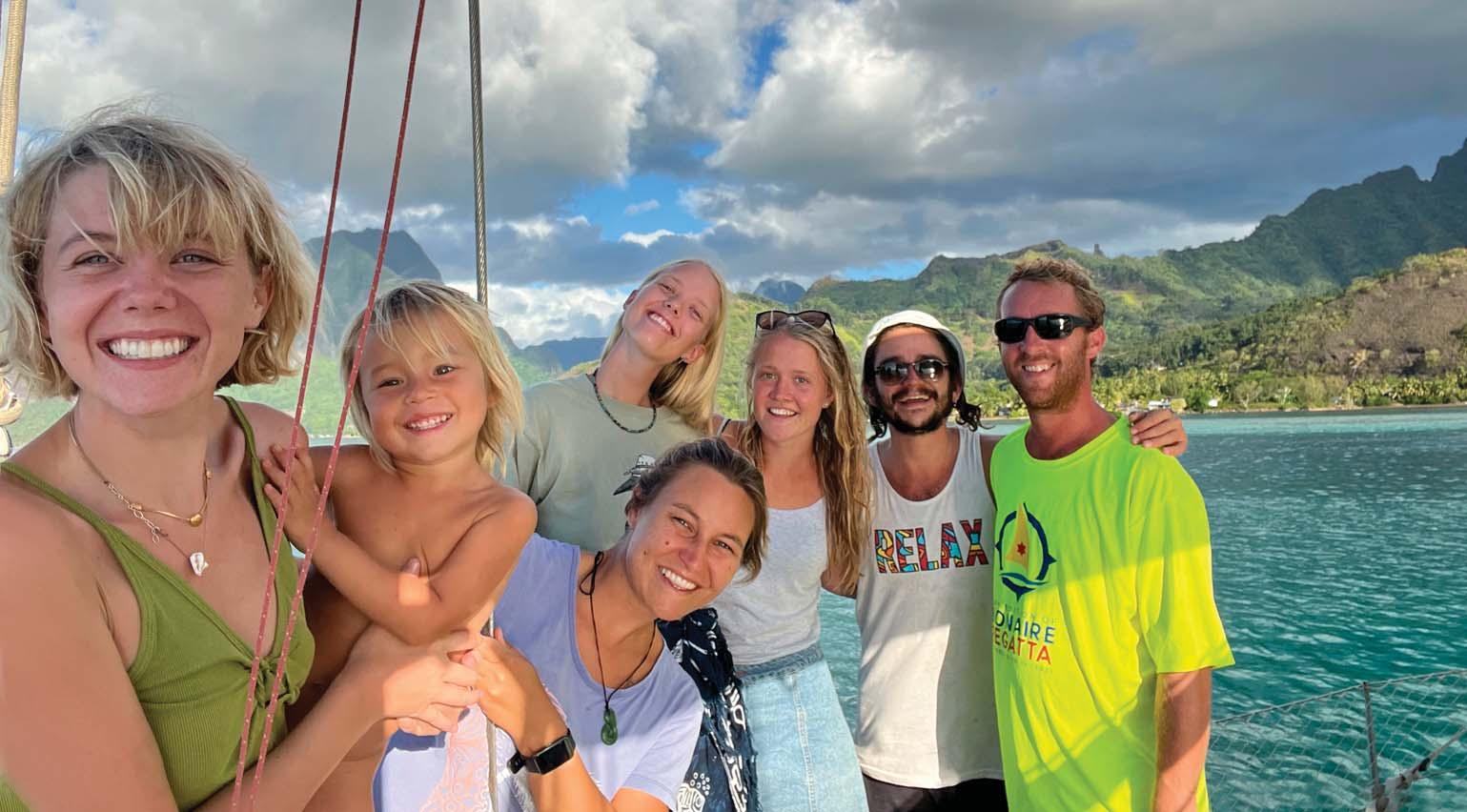
As is often the case with a grand expedition, the original idea is sparked by something that captures our attention and takes root deep within our imagination. Hours of contemplation and dreaming create plans seemingly beyond our fingertips until we take a single step in the right direction. That was certainly the case for me. The longest passages I had sailed were a couple of weeks exploring the Outer Hebrides and the Norwegian fjords. I had never stepped aboard a boat outside of Europe or crossed an ocean. During Covid lockdown, however, I read an inspiring book by Liz Clarke entitled Swell*. A young lady with a flair for travelling, she acquired a boat and set sail around the world. Passing down the American coastline and across the Pacific Ocean, she made it to Tahiti. Her description of her experiences made me eager to find a way to reach the same destinations.
As a 20-year-old, just beginning my third year of training to become a doctor, I have ambitions of being an expedition medic, travelling to all corners of the world and having wild adventures. Due to a placement beginning in autumn 2022 my holidays were about to become very limited so I wanted to make the most of my final long summer and do a worthwhile sailing trip. My dreams came true when I found a boat sailing from French Polynesia to Fiji over the summer which needed crew. With help from the OCC’s Youth Sponsorship Programme I booked my flights.
Pania is an Omega 56 – a GRP cutter-rigged sloop with a dagger keel, based on a Baltic 54 hull – and we were an international crew. Her owners are Jelle and Skye, a Danish/ New Zealand couple with their 3-year-old son Abel, and the rest of the crew consisted
* Illustrated edition published by Patagonia in 2018 and available in both hard cover and for Kindle. ISBN 978-1-9383-4054-3
Pania’s crew in Mo’orea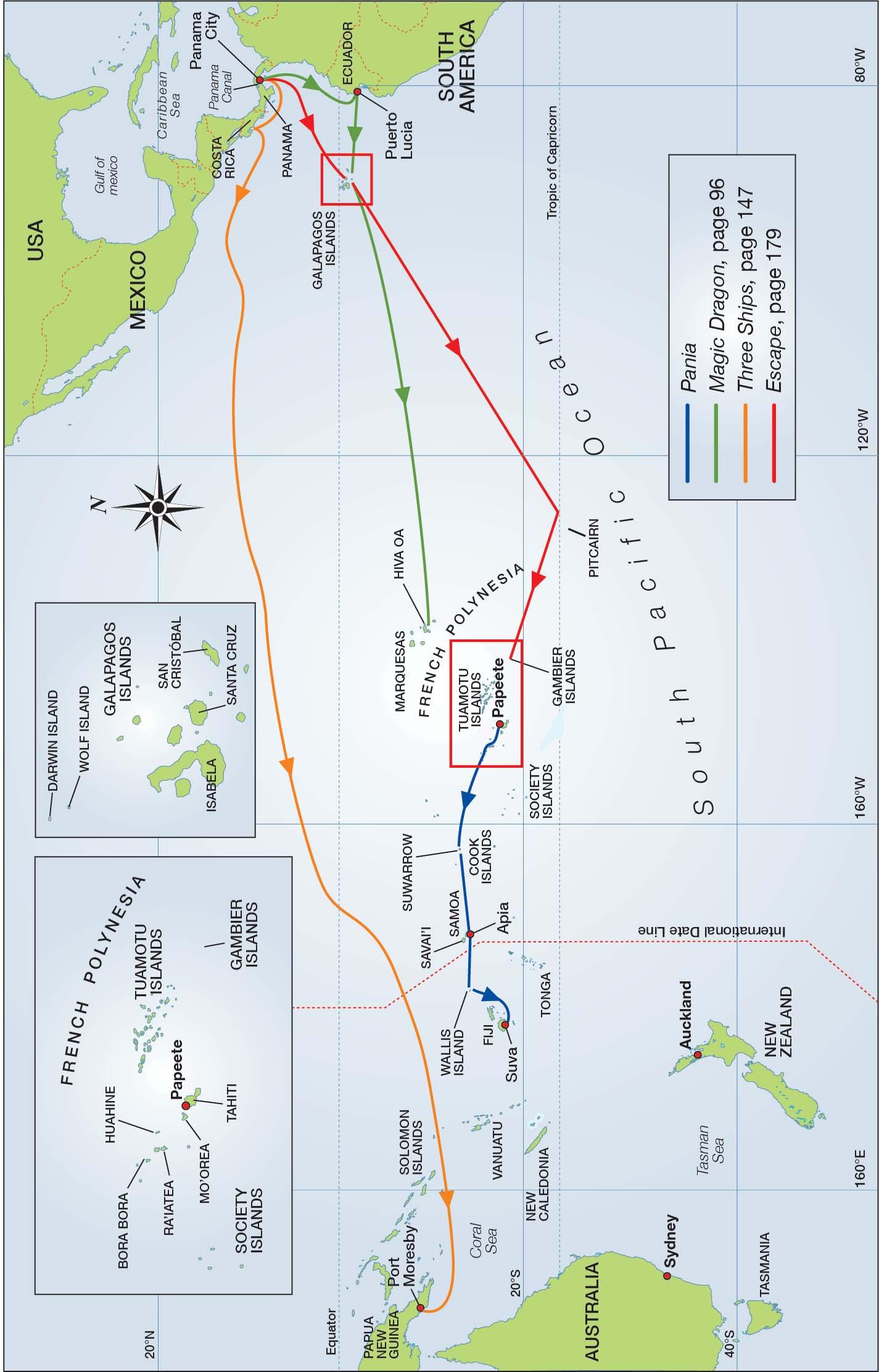
of Claire (from the USA), Alberto (from Spain), Lina (from Denmark) and me (from England). This rich cultural variety created a vibrant, dynamic atmosphere in the boat – new flavours were expressed in the cuisine, typical traditions brought to the table and stories from people’s backgrounds shared as we melded into a new family onboard.
During the first couple of weeks we sailed round the islands of French Polynesia, starting in Tahiti where we stocked up on food supplies and bottled gas to last us for the next month. Arriving in time for ‘Tahiti National Day’ we became immersed in the festive cultural traditions, watching traditional dances which showed off the graceful but powerful nature of the dancers. Competitions were held in which local men ran races while balancing bananas on bamboo poles, straining their lean bodies round an assault course while an old man cheerfully led the way on his bright yellow motorbike, tooting honks of encouragement and hyping up the crowd.

Sailing was delayed by a couple of days when the meteorological service issued warnings of strong winds and swell, and we found out later that extensive damage occurred throughout French Polynesia due to coastal flooding. Global warming and rising sea levels are evidently having a large impact on these islands and it was eye-opening to see the damage first hand. When the swell had died down we made the short passage across to Mo’orea. I sat on the bowsprit with my eyes peeled, keeping a lookout
 Pania in Papeete, Tahiti
Cook’s Bay, Mo’orea
Pania in Papeete, Tahiti
Cook’s Bay, Mo’orea
for bommies* and whales. Despite there being recent sightings of large numbers of humpback whales passing through the warm waters of Polynesia for mating season, the only wild creatures visible were the rest of the crew.

Mo’orea is very rugged with jagged volcanic mountains. We anchored in Cook’s Bay and explored the heart of the island, climbing narrow paths winding up the steep slopes and leading to stunning viewpoints. Bamboo forests, pineapple fields and trees bursting with exotic fruit of all kinds lay before us. The translucent, turquoise bays beyond were sheltered by the reefs, shielding the island from the surrounding deep blue Pacific Ocean.
After a couple of days we made the overnight crossing to Huahine, just over 100 miles away. Far more remote, the island has managed to retain the alluring authenticity of early Polynesia and is an immense tropical jungle, with vanilla plantations, coconut trees and watermelon fields. The vibe was chilled and family-oriented. During our time there the swell was strong and the waves fairly epic. In Swell Liz Clarke describes surfing in this part of the world, and I’d been longing to do the same. I swam out to meet the local experts and an older Polynesian man took me under his wing. He lent me his board and gave me small shoves every time a large enough wave came along. I had a smile of glee as I caught my first one, but the sight of the sharp coral reef passing barely beneath the board made me nervous and I came crashing down, scraping my skin. He patiently tutored me for a couple of hours on the ways of the water, and gave me advice on the most effective way to catch the lip of a wave and plunge down its face in an attempt to catch a barrel ride. I gradually improved. Drinking a beer, we leant against his truck watching the sunset. He reminded me of Big Z from the film Surf’s Up as he casually revealed a lifetime of surfing experience, reminiscing about international events in which he’d competed when he was younger. When we sailed
* A bombora – often abbreviated to bommie – is an Australian term for an outcrop of coral reef higher than the surrounding reef platform which may be partially exposed at low tide, and also for an area of large sea waves breaking over a shoal some distance offshore. Thank you, Wikipedia!
on towards a new anchorage he lent me the board for the next week to practise. In the end I spent more time surfing by holding a line trailing from the dinghy rather than on the waves, but very enjoyable nonetheless!
In Ra’iatea we were able to hitch lifts to the key historic sites such as the Marae Taputapuatea*. Once considered the central temple and religious centre of Eastern Polynesia, it holds significant testimony to traditional Polynesian culture. We anchored in the Te Ava Mo’a channel (the sacred channel) located in front of the marae. It is said to be the home of Tumura’ifenua, the mythical giant octopus that supposedly spreads its tentacles to all of the archipelagos of the Polynesian triangle.
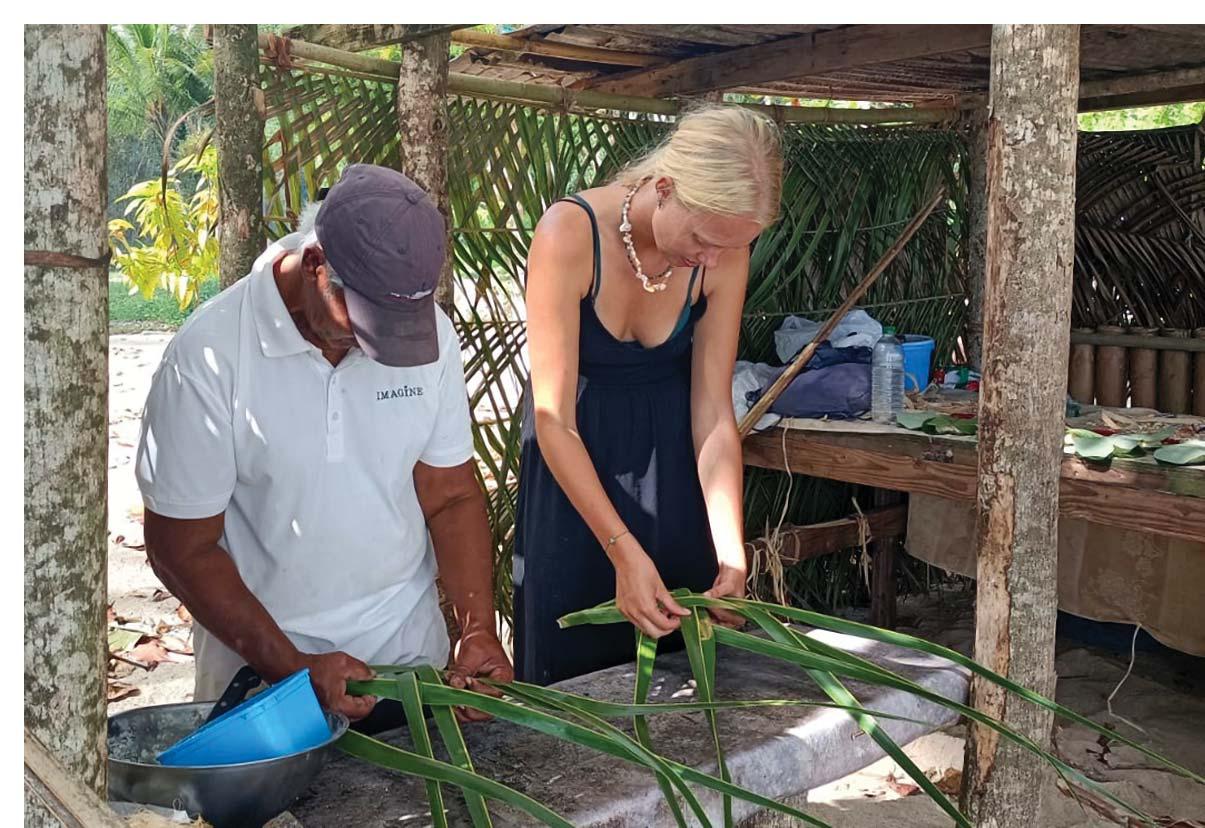
When we visited smaller islands only accessible by boat we used a stern-line tied to palm trees in conjunction with a bow anchor. We hung up hammocks, built fires on the beach and collected crabs for dinner. Occasionally we would meet interesting local people living remotely. One old man owned a shack on the beach. Paddling up to Pania in his kayak one morning we were invited for breakfast, and the following day we found him busily building a fire. He set the men to work cutting open coconuts and

A morning of traditional craft
grating them ready to make coconut bread. Meanwhile we women were led to his shack, where he had a wide assortment of beads and shells. As a professional costume and jewellery maker, his nimble hands were used to stringing together delicate combinations and creating elaborate pieces of artwork. We worked by his side all morning attempting to replicate his designs, while he kept reinforcing the idea that mana (energy) ran through us all.
* A marae, malaʻ e, me ʻ ae or malae is a communal or sacred place that serves religious and social purposes in Polynesian societies.
Our final destination in French Polynesia was Bora Bora. Making our way through the outer reef into the shelter of the lagoon was challenging due to the rapid current that flows out through the narrow channel. You have to enter the lagoon only through passages indicated by triangular navigation marks and, as is typical in this region, the water depth changes
almost instantaneously. We passed a boat that had become trapped on the reef and been abandoned by its crew, but fortunately we made it through safely and the panoramic views beyond made it well worth the struggle. During our stay we descended into the translucent depths with our SCUBA tanks, gaping in awe at the magnificent manta rays and turtles that circled us or squirming nervously as sharks approached within close proximity.
After a month of island-hopping we began the ocean crossing from Bora Bora to Samoa. Raising the mainsail and unfurling the genoa we raced across the still lagoon water, through the pass and onto the open ocean, anticipating an exciting passage. Day by day the crew started working more effectively as a team and became slicker at their tasks – sheeting in the sails more quickly, helming more precisely and keeping a sharp lookout for other boats or unfavourable weather systems

 Anchored at Raiatea with a line ashore
The crew in Bora Bora
Anchored at Raiatea with a line ashore
The crew in Bora Bora
on the radar. For the first four days we averaged 5 ∙ 5 knots on a run with the genoa fully out, occasionally aided by the engine and mainsail. The halyards were cleated off at the mast and, unlike in some boats, the lines did not lead back to the cockpit. I enjoyed scrambling along the leeward side of the boat to the mast, dangling my full weight on the halyard to haul up the sail and then finishing it off on the winch. Clipping onto a shroud in the middle of the night, I could watch the bow plunging through the waves in the moonlight with a blanket of stars illuminating the water. I was always amazed to look up into the starry night, then down into the depths of the ocean, and realise that I was just a speck in this vast universe.
On passage everyone found their routines. Each day began with a high pitched, enthusiastic cry, “Hey Dude, do you want to help me build a hydroelectric engine?”. Having grown up mainly on board, Abel knew the boat inside out and was always trying to break into the tool box, undoing and fixing screws, or stringing together phrases he had picked up from previous incidents. “Papa, the macerator broke. We must do some serious engineering to repair the electrical cabling!”.

The rest of the day would flow into one, with people alternating between reading, being on the helm, giving a massage or doing a craft project such as crocheting, wood carving, painting etc. Bucket showers took place on the transom. A couple of times when there was no wind we furled the genoa and I jumped off the bow and swam to the stern, but that quickly stopped when I saw the size of the shark bite out of a fish on the end of the line. I didn’t fancy being caught in the jaws of that beast! The daily Rummikub* competition was played with a repercussion in the mix – washing up duty for a week, bilge-scrubbing, fridge maintenance, and so on. At the end of the day we would all sit on the bow, hot chocolate in hand, watching the sun go down. I particularly enjoyed perching on the bowsprit playing the guitar. Night watches were exquisitely quiet. Not a sound could be heard other than the gentle clanking of the
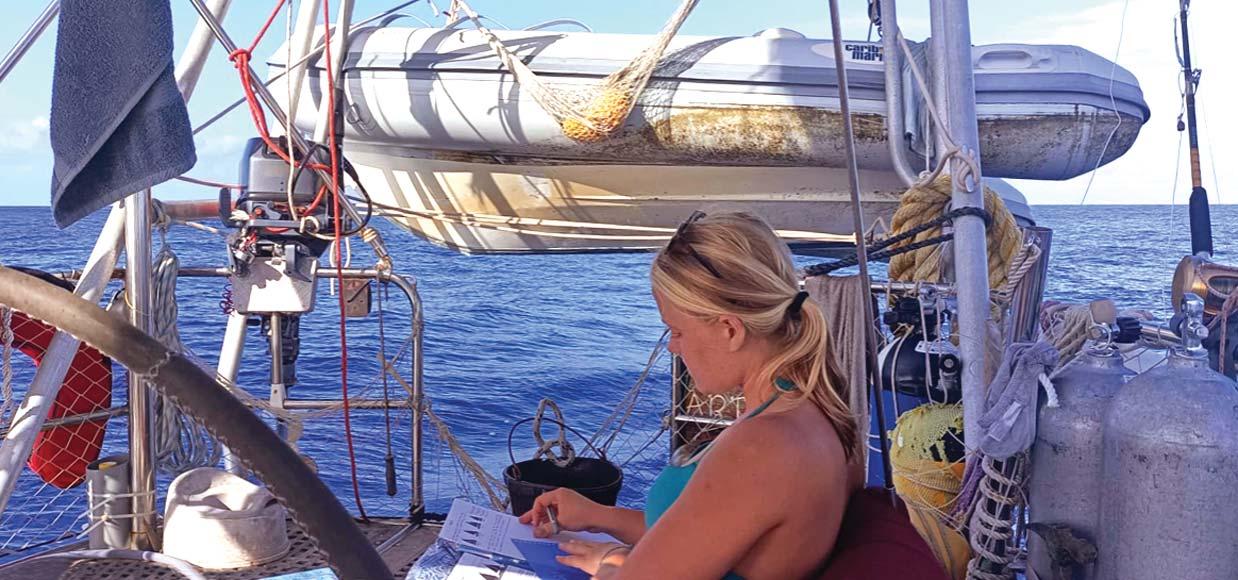
after a while heard a loud sound. Pania has a spade rudder and, on checking the boat, the owner found that the welds on the stainless top bearing of the rudder stock had failed. This allowed excess movement and caused the cable steering to fail by coming off the quadrant and getting caught and kinked in the blocks.
He immediately hove to to limit the rudder’s movement and called an emergency meeting of the crew. He explained that we were in danger of sinking if the hull became damaged, and though he would attempt to strap the rudder down using cable ties, in the meantime we needed to start working on Plan B – taking to the liferaft. The straps and cable ties were insufficient to keep the rudder in place securely against the force of the waves while they remained so large, so we decided it was safest to drift until they subsided.
Sorting through the medical kits in preparation for taking to the liferaft

Watching the large swells approaching
boat and the occasional “you still awake?” from one’s watch partner. I relished the idea of being the only person awake for miles around!
For the first few days the conditions were calm. A couple of squalls passed over but we mainly had fair weather conditions. On the fifth day, however, the wind progressively picked up until it was howling at 35 knots –in Polynesia a maramu or strong southeast wind. The waves reached 6m and the boat was under a lot of strain. During the night I kept getting tossed out of my bunk and desperately clawed at anything I could cling onto to keep myself from falling head first onto the cabin floor. We reefed the main and rolled in the genoa, but
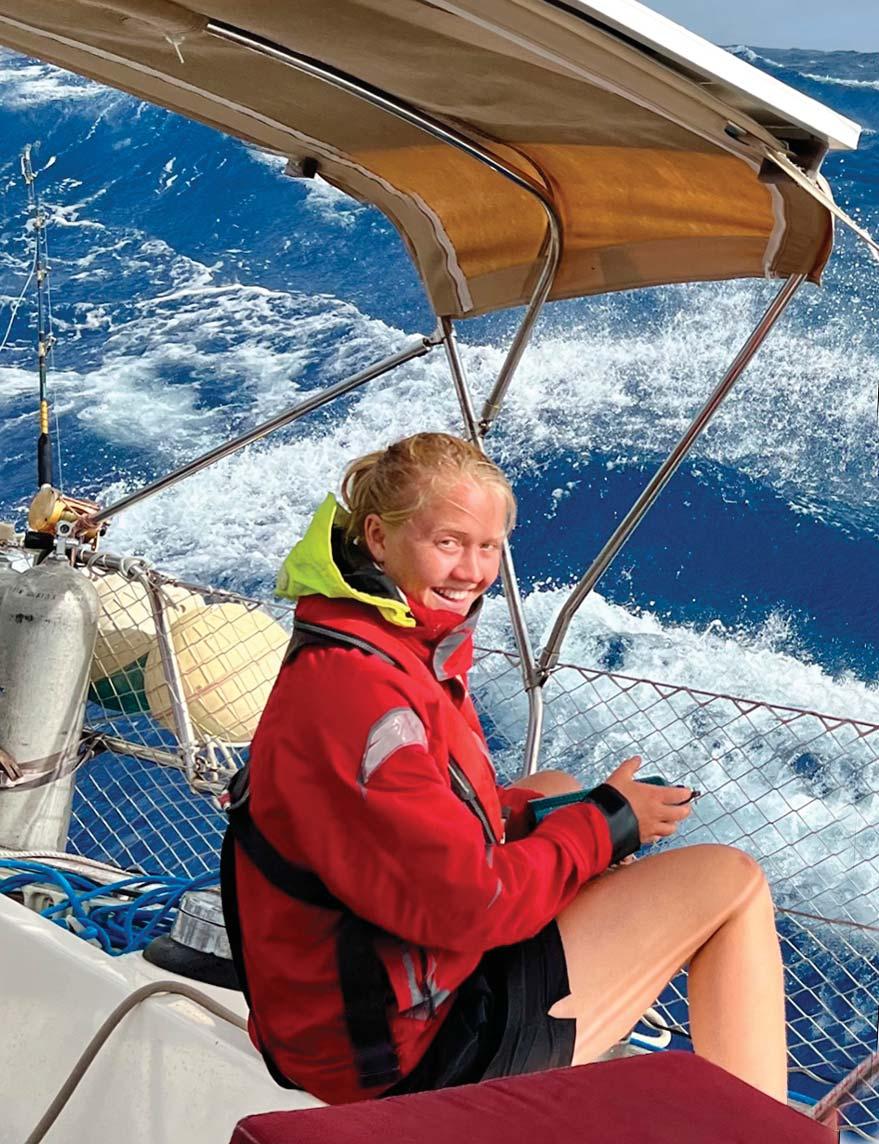
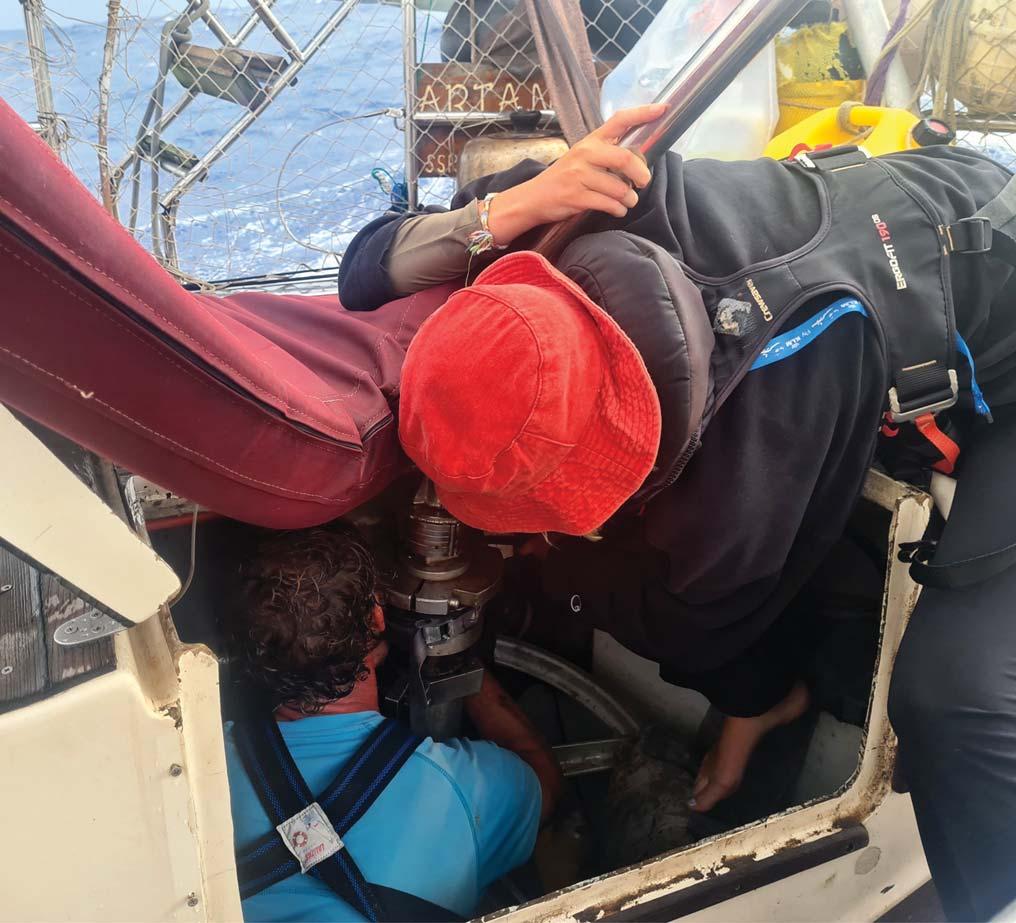
For the next few hours we worked together to think through the Life of Pi scenario, packing important documents, food supplies and warm clothing into dry bags. Abel came up to me lugging a large box of Lego and, with a solemn face, declared, “Abi, I’ve packed the Lego up, ready for the lifeboat!”. If we’d had to abandon the boat those Lego pieces might have been the best thing we’d packed, at least for keeping our minds occupied! As the resident medical student I was responsible for going through our medical supplies – it’s not often you have to imagine yourself bobbing on the ocean 500 miles from the nearest land, and I had to make quick decisions about what would be vital when exposed to the elements.
We remained hove-to for the next 36 hours riding out the heavy weather, drifting in a westerly direction towards the Cook Islands. A Pan-Pan was broadcast and we were tracked by the New Zealand and American coastguards, but after the winds died back down to 15 knots we were able to sail the last few miles to Suwarrow using the emergency tiller. We sailed in through the pass in the early morning and I peered out of my porthole
 Safely anchored at Suwarrow
Safely anchored at Suwarrow

to see a golden beach fringed by palm trees. We spent a couple of days of bliss anchored in the shelter of the island but, due to Covid restrictions, were not allowed ashore. I spent the majority of my time at the top of the mast, sitting in a dream-like state looking out over the island. An Australian couple we had met previously tied up alongside hoping to aid us with the welding using their generator, as a fuse in our inverter had blown earlier in the trip. We had a celebratory meal to commemorate reaching land safely, popping open the champagne and creating as much of a banquet as a bunch of tins can achieve. Accompanied by a bottle of rum we chatted away well into the night, hearing tale after tale of the Australians’ exciting adventures. A very merry evening!
It took us five days to sail from Suwarrow to Apia Marina, Samoa, crossing the International Date Line en route. We’d been longing to reach Samoa and be able to have our feet on solid ground again. Customs came out to meet us and escorted us to their pontoon, and after a thorough search of the entire boat we were granted permission to stay. We spent the following days visiting the To Sua Ocean Trench, cave pools, large waterfalls and the giant clams. Our tour guide was an energetic Samoan taxi driver who chattered and chuckled the whole time. With the wind racing through the
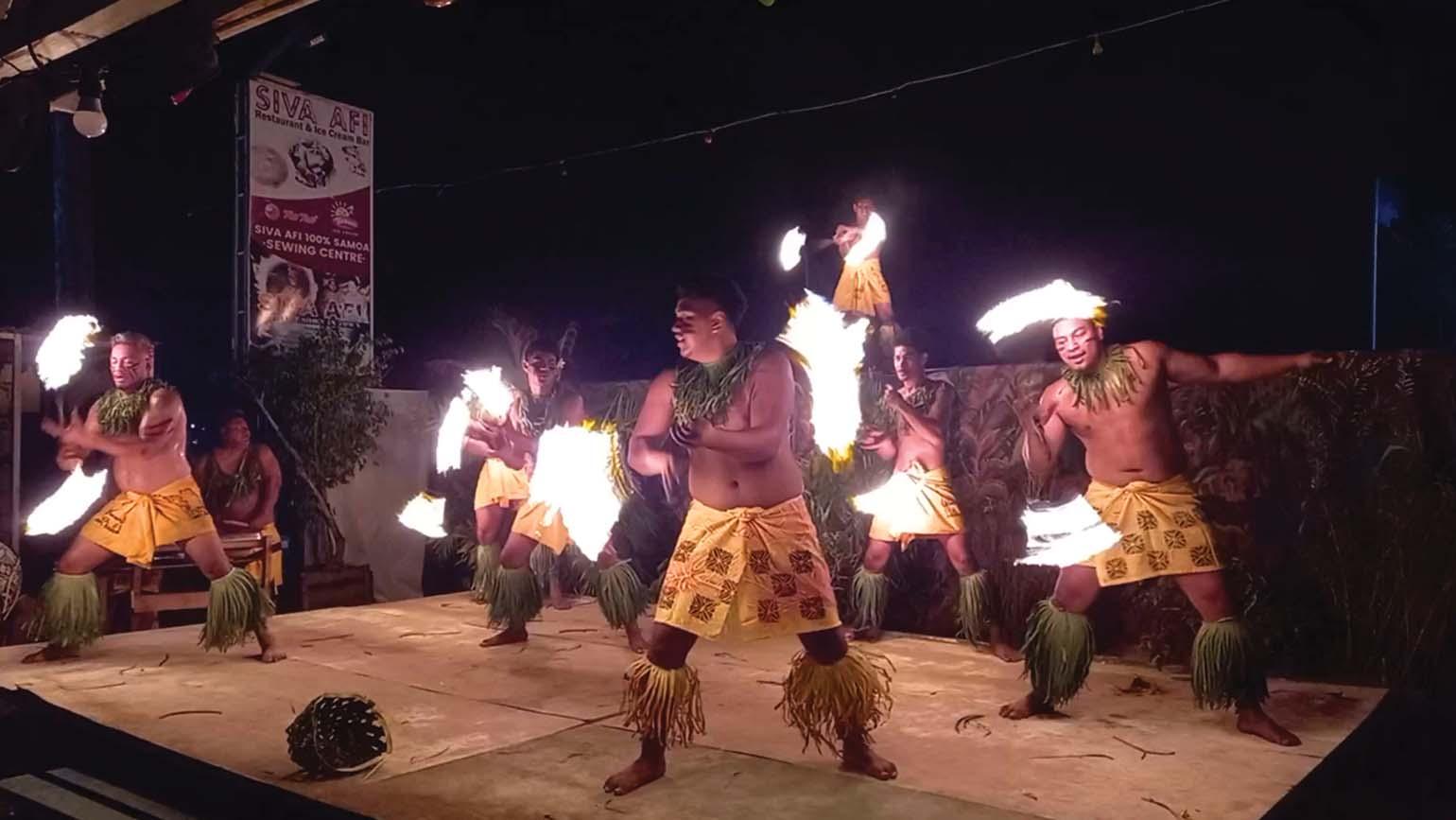 The spectacular fire dance at Samoa
The spectacular fire dance at Samoa
To Sua Ocean Trench, Samoa, 30m deep and only accessible via a long ladder

open windows and the music turned up high, she flew along the island roads joyfully chanting, “I drive, you party. I drive, you party!”, hands barely on the steering wheel. Partying and dancing must feature prominently in Samoan culture as on another evening we watched a most spectacular fire dance, standing transfixed as the fire sticks were spun increasingly rapidly and the music became more intense and passionate. Were these magical dancers even human?
Waking at 4am one morning we were able to visit the Old Apia Market. I enjoyed chatting with the local fishermen and hearing about their lives and we bought freshly-caught crayfish and crabs. A delicious barbecue took shape as we watched the sunset. We also visited the Robert Louis Stevenson Museum. Having fallen into disrepair the building, once his home, has now been renovated and houses paintings, furniture and memorabilia from his time. We were given a tour by a young Samoan lady and heard tales of his travels across the Pacific and his final years on the island. We were impressed to realise that, over 100 years earlier, the writer had done
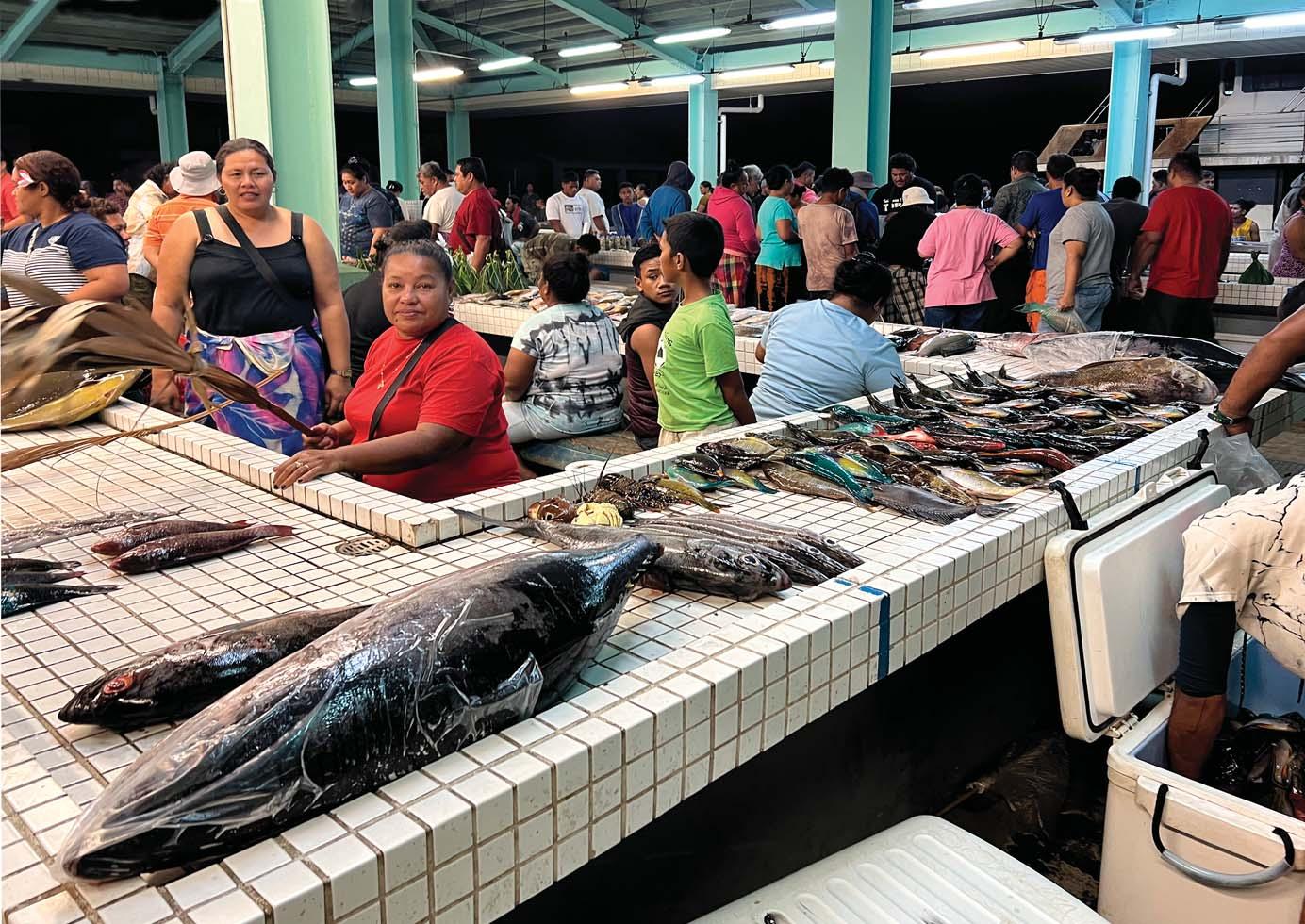 Samoa fish market
Samoa fish market
exactly the same passage as we had, but lacking our navigation systems, radar and ability to contact the coastguard if anything went wrong. The bookshelves in his study contain copies of his most famous books in both English and Samoan, translated to make his works accessible to local people. The Samoans fondly nicknamed him ‘Tusitala’, or Teller of Tales.

On the evening of the fifth day we untied our lines and set off on a broad reach for the hazy horizon. We rolled out the genoa and fully raised the main after passing north of Savai‘i. Over the next couple of days the winds were light and we made barely 3∙5 knots over the ground. We replaced the genoa with the gennaker (a cross between a genoa and a spinnaker) and alternated sailing dead downwind with sailing on a broad reach. The
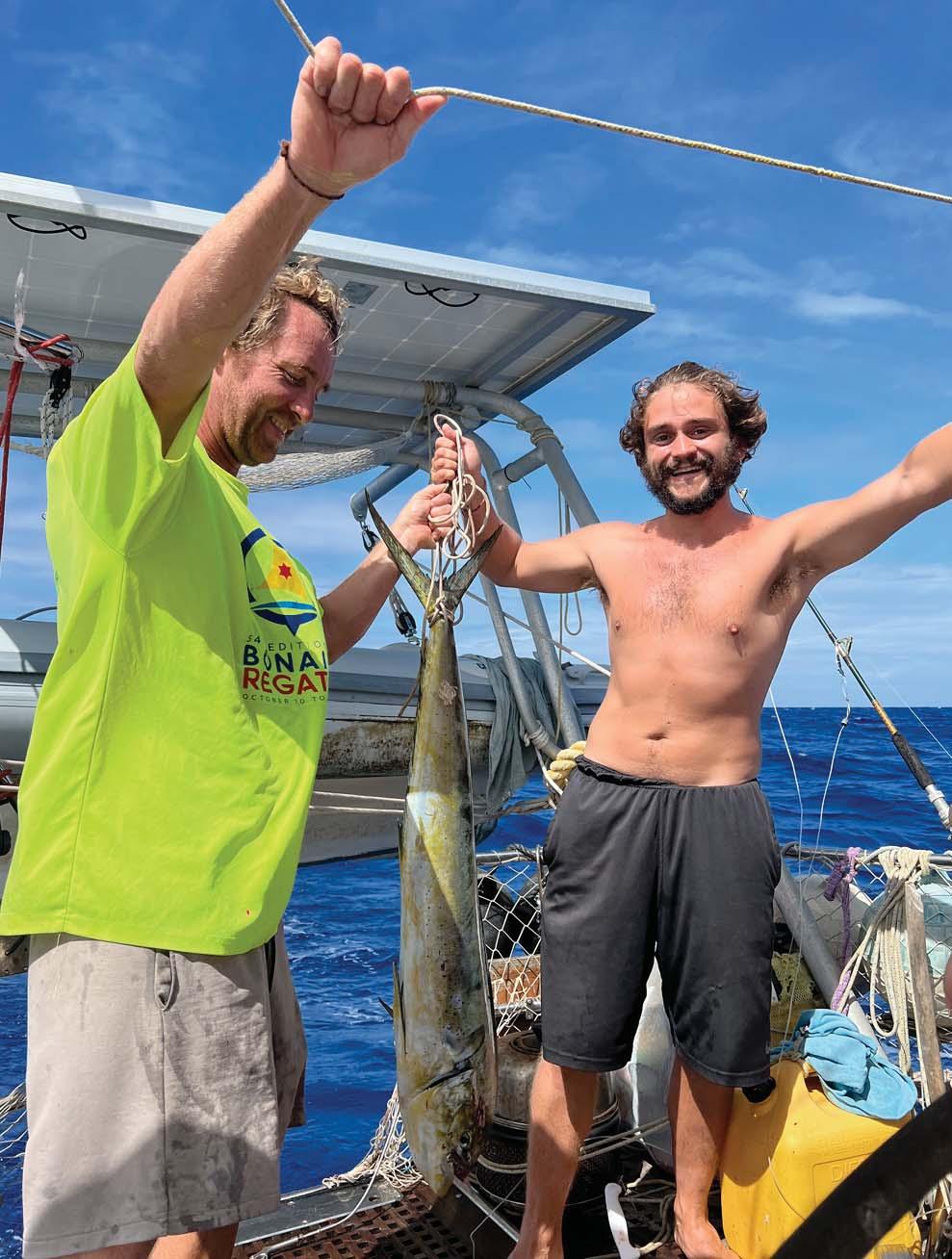 The Robert Louis Stevenson Museum, Samoa
Jelle and Alberto with a mahi mahi
The Robert Louis Stevenson Museum, Samoa
Jelle and Alberto with a mahi mahi
owner set a course via Wallis Island, a small atoll north of the direct course to Fiji, to optimise the time sailing on a broad reach. We had much better luck with our fishing lines and caught a couple of tuna that we gutted and cut into steaks. Then, on the last day, we caught a mahi mahi. It was more than a metre long and a glorious combination of vibrant colours. Our bellies were fit to burst that night!
After two months aboard Pania we reached our last stop – Fiji. We sailed upwind for the final few miles and I took the helm, enjoying feeling the power of the boat as we cut through the water. Small atolls started building on the horizon as we approached Fiji. We reached Vuda Marina in the evening and were welcomed by a whole cluster of marina staff who gathered together and sang the boat home. We had reached our final destination!
French Polynesia: hello – la orana; welcome – maeva; thank you – maururu
Samoa: hello – talofa; good morning


– manuia le taeao
Fiji: hello – bula bula; thank you –vinaka
This summer I have truly lived life to the full – thank you to the OCC for helping me to fund this trip. Not only has this experience given me a better insight into the life of a sailor, but I have developed a greater passion for being on the water, formed memories of some of the most beautiful, remote destinations in the world and built friendships that will last a lifetime.
Pals for life!
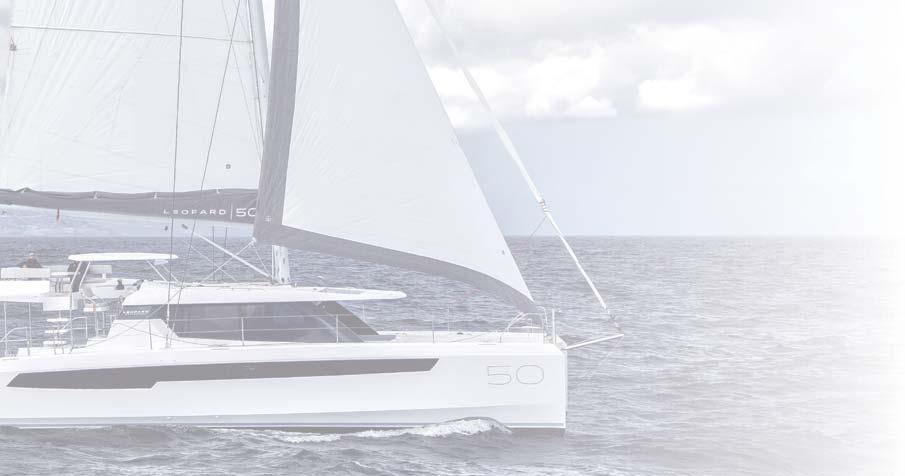
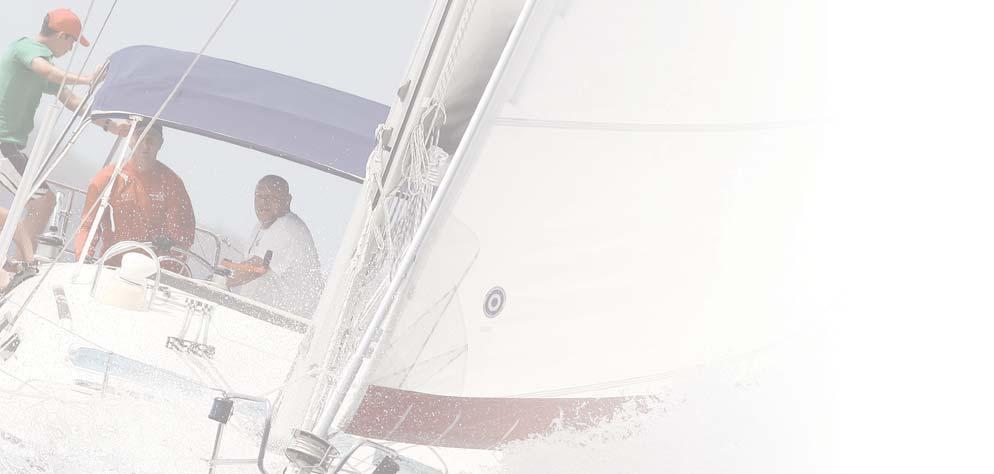
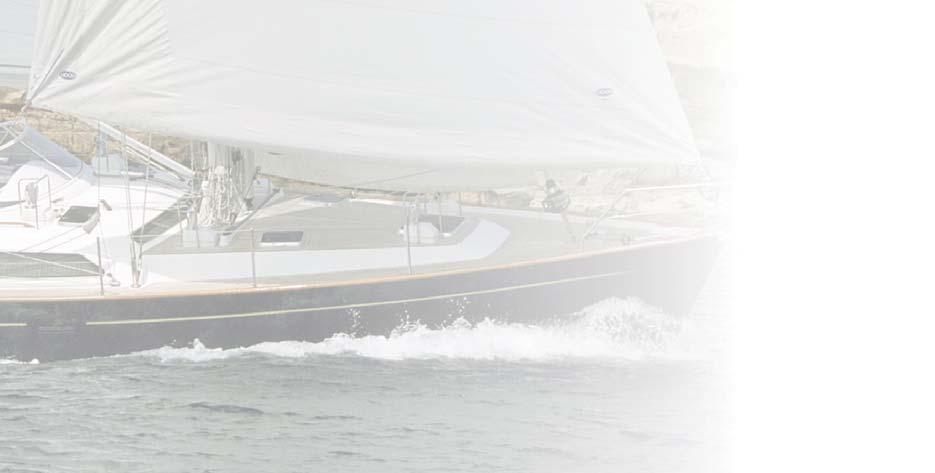
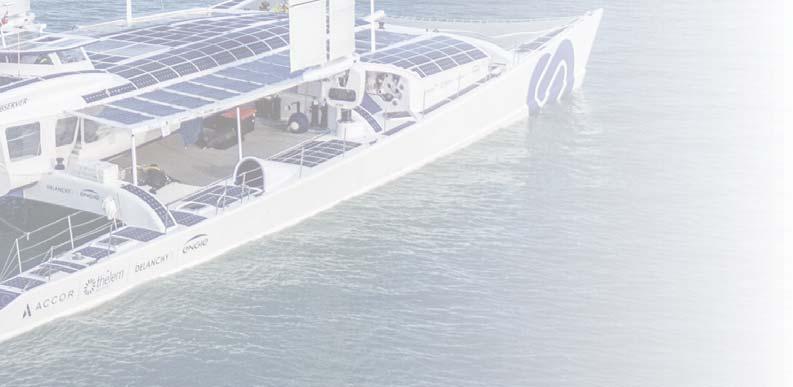


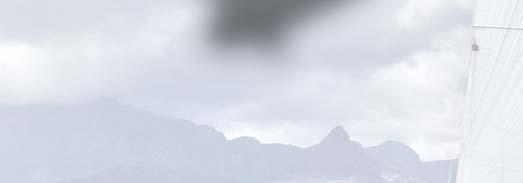
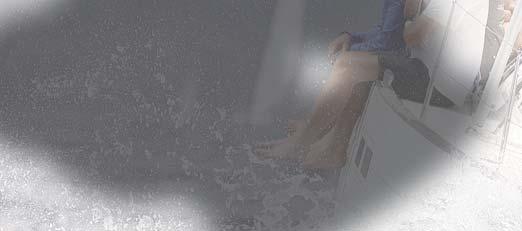



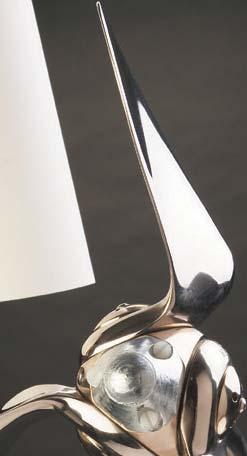



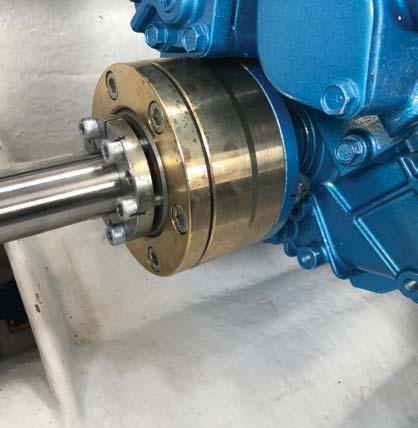



(This is not the first time that Honorary Member Susanne Huber-Curphey has appeared in the pages of Flying Fish – see the Awards write-ups in Flying Fishes 2018/1 and 2020/1, as well as John Franklin’s In the Wake of Bernard Moitessier in the latter issue. It’s the first time that we’ve heard directly from Susanne, however, so she was invited to begin with a short sailing autobiography.
All photos copyright Susanne Huber-Curphey except where indicated.)
I was born in Ingolstadt, Germany and trained as an architect. I first enjoyed solo sailing on the Bavarian lakes, but salt water lured when I singlehanded the Donau (Danube) from my home town to the Black Sea. My first solo circumnavigation, between 1989 and 1998 with 401 days at sea, was westbound on the trade wind route in Glory, a 30ft Seadog built in 1972. My second, this time eastbound via Alaska, took from 2000 until 2012 including 730 days at sea aboard So Long, a 1964-built Rhodes 41. Both yachts were GRP.
In Patagonia I discovered the benefits of strong metal boats. Years later I decided on a 39ft aluminium cutter with over-sized hull and rigging and a full keel. It took me nearly three years to transform the bare hull into a seaworthy home. I called her Nehaj, which
Nehaj’s tracks from 2015 until 2022 with her most recent passage in red

translates as ‘Feel safe, do not be afraid’. Our maiden voyage took us over the top of Iceland to New Zealand and a loop through the South Pacific Islands, and Nehaj and I became a good team. In 2017 we sailed from Tasmania to the Aleutian Islands and through the Northwest Passage*. This was a challenge, but we made it unharmed and spent the winter in Lunenburg, Nova Scotia.
In 2018–19 I took part in the casual French sailing event La Longue Route, a nonstop solo voyage around the world. After starting in Maine, USA in June we passed Cape Horn six months later. There I decided to carry on towards the Pacific, just like Bernard Moitessier 50 years earlier, and reached Tasmania for a second time without any breakages. It was a long passage in harmony with nature and my good boat. I could have quit at any time, as there were no expectations or pressure from anyone, and maybe this was the secret of those eight happy months at sea.
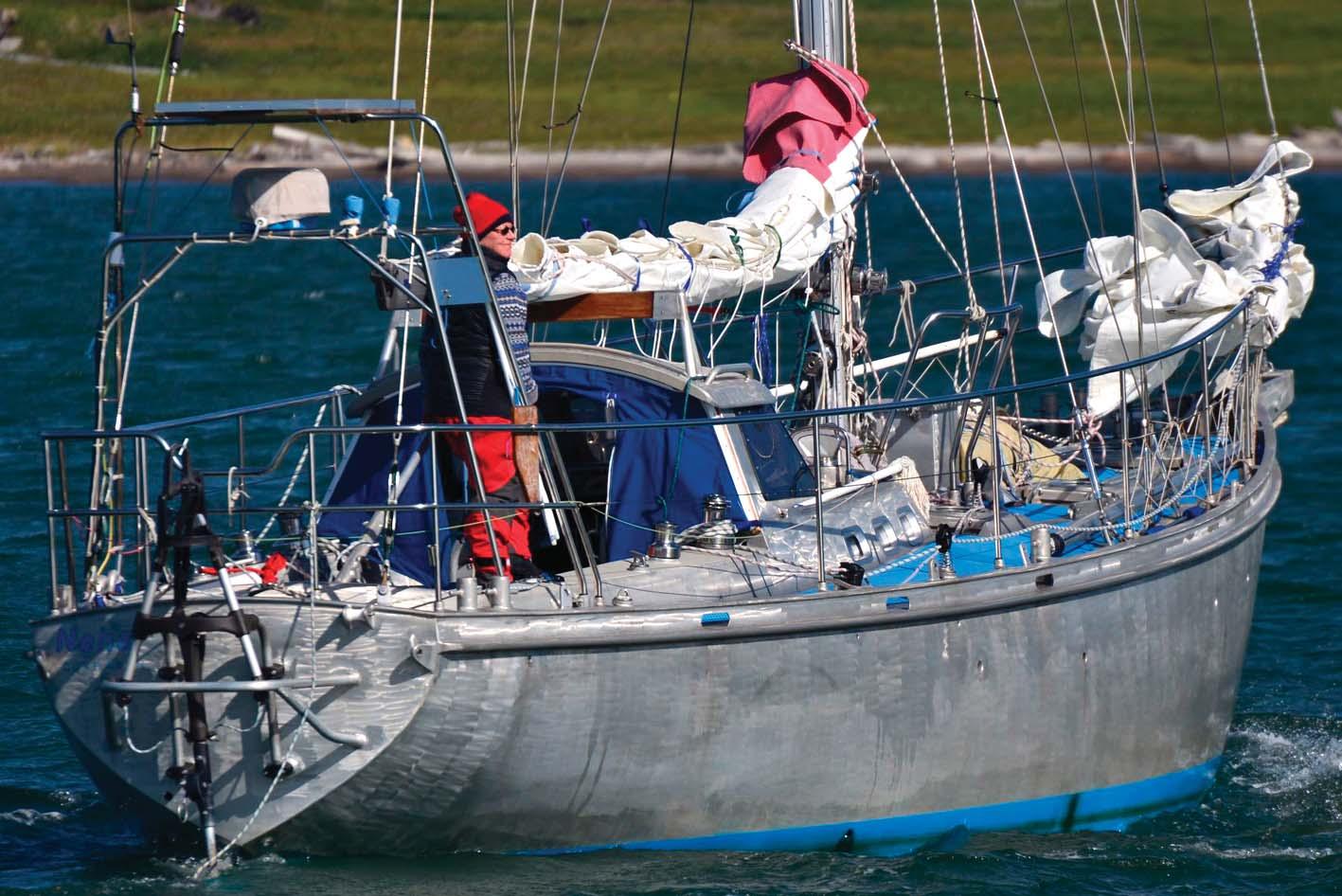
The following year we sailed up the Tasman Sea and set course west. In Reunion Island a terrible stranding in 5m surf nearly cost the lives of Nehaj and me. Only her strong hull
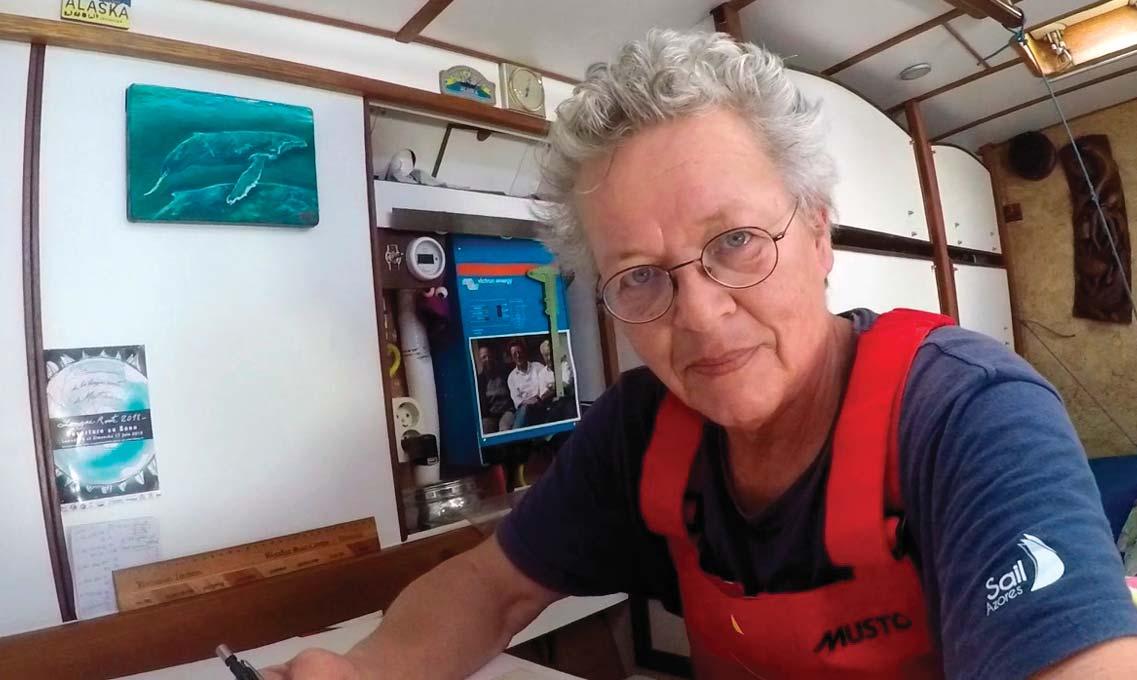 Nehaj at Herschel Island in the Northwest Passage, 2017
Susanne at the chart table
* This was the voyage for which Susanne received the 2017 Barton Cup.
Nehaj at Herschel Island in the Northwest Passage, 2017
Susanne at the chart table
* This was the voyage for which Susanne received the 2017 Barton Cup.
construction saved us. The only place for the extensive rebuild was Koopmans Kasko’s, the boatyard in the Netherlands where Nehaj had been built, and with the badly-damaged hull it was a strenuous 12,000 miles around South Africa and up the Atlantic. Koopmans Kasko’s replaced nine ribs and 5m2 of alloy skin below the waterline in record time, giving her a second life. In 2021 I sailed from Germany to the Azores, then decided to spend the winter in the south, the voyage described below. So far Nehaj has clocked up 116,337 miles and 893 days at sea, between 74°N and 56°S. My own lifetime sailing comes to 279,000 miles with 2151 days at sea.
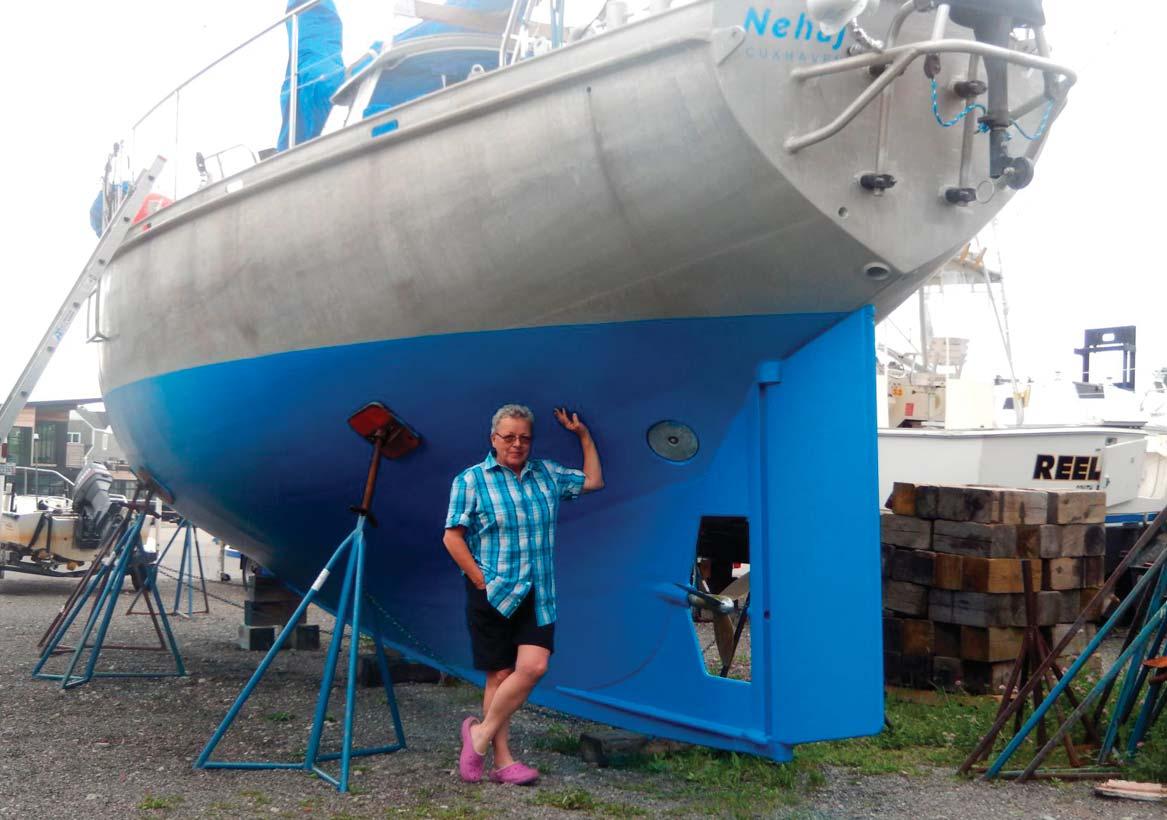
In my opinion the last real freedom is only found on the vastness of our oceans. Today we have been eight weeks at sea, enough time to find unity with oneself and
 Nehaj ashore in Portland, Maine, 2018
The deck layout looking aft
Nehaj ashore in Portland, Maine, 2018
The deck layout looking aft
with nature. This is not my longest sea passage, but it’s long enough to feel this positive solitude without loneliness and the intensive harmony of person, boat and ocean. It is one of the reasons for my fascination with long passages. Due to the prevailing winds our course is following the shape of a huge fish hook, including rounding Tristan da Cunha. You might doubt the sense of this route where the path and not the landfall is the real purpose. The closer I get to any destination, the more I toy with the idea of just carrying on. Of course, besides such inner harmony it needs good preparation, the relevant equipment and spares as well as basic technical knowledge. Financially the simple life on board is a realistic option for most ‘wanna-be’ cruisers. Whatever the dreams are, most important is a good boat, built basic and strong, that can handle all climatic zones. Each time I arrive somewhere I’m amazed that the to-do list is virtually zero and no big repairs are needed.
Inner strength is more important than physical capability, though a robust constitution is important for this total freedom at sea. In many years of sailing I have never needed the first aid kit or Dr Jim’s* emergency booklet in anger, nor antibiotics or heavy painkillers, though this time I am trying not to forget a daily vitamin/mineral/trace elements tablet.
* First Aid and Wilderness Medicine by Drs Jim Duff and Ross Anderson. 3rd edition published by Cicerone Press in 2017. ISBN 978-1-8528-4913-9
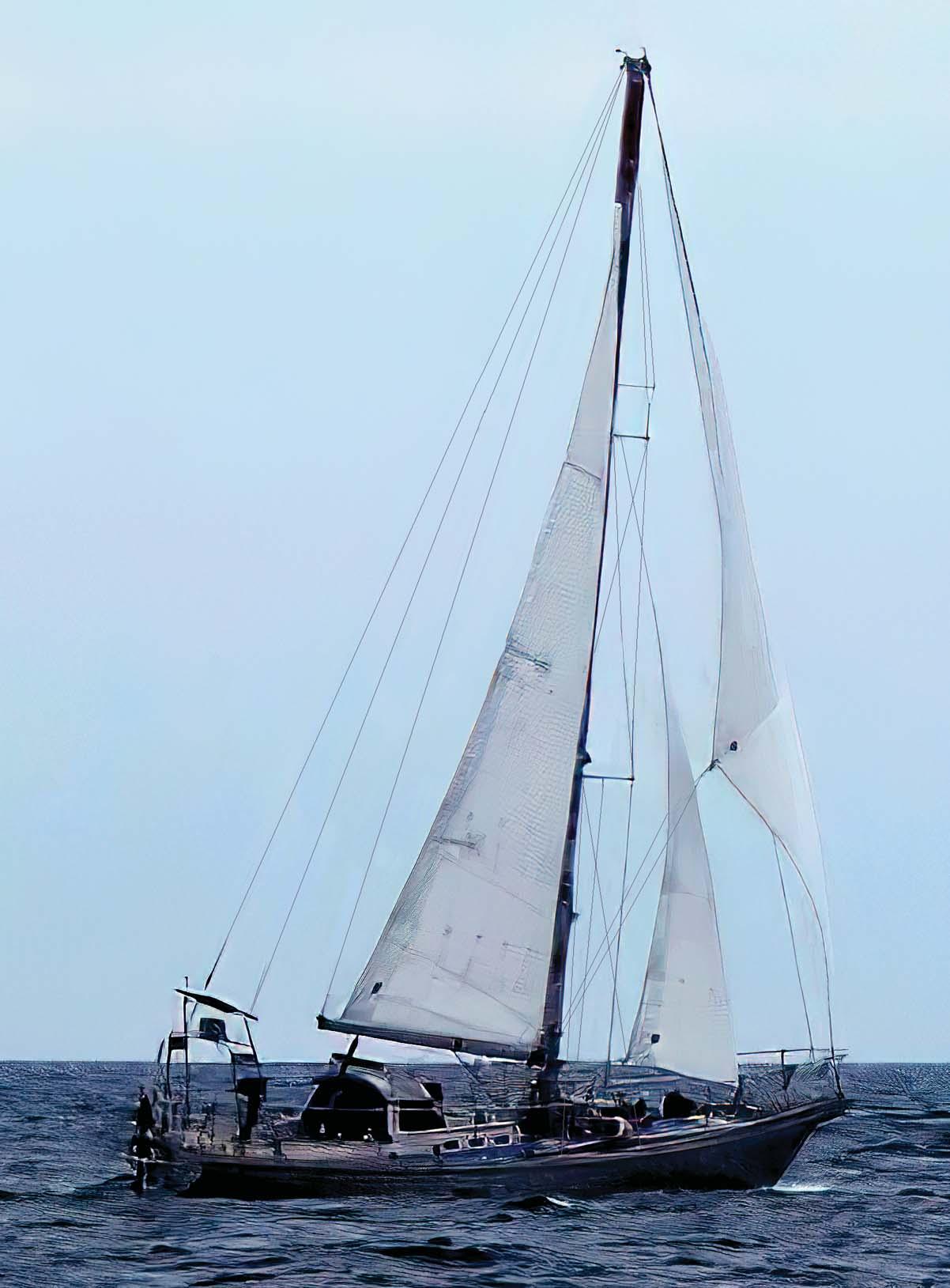


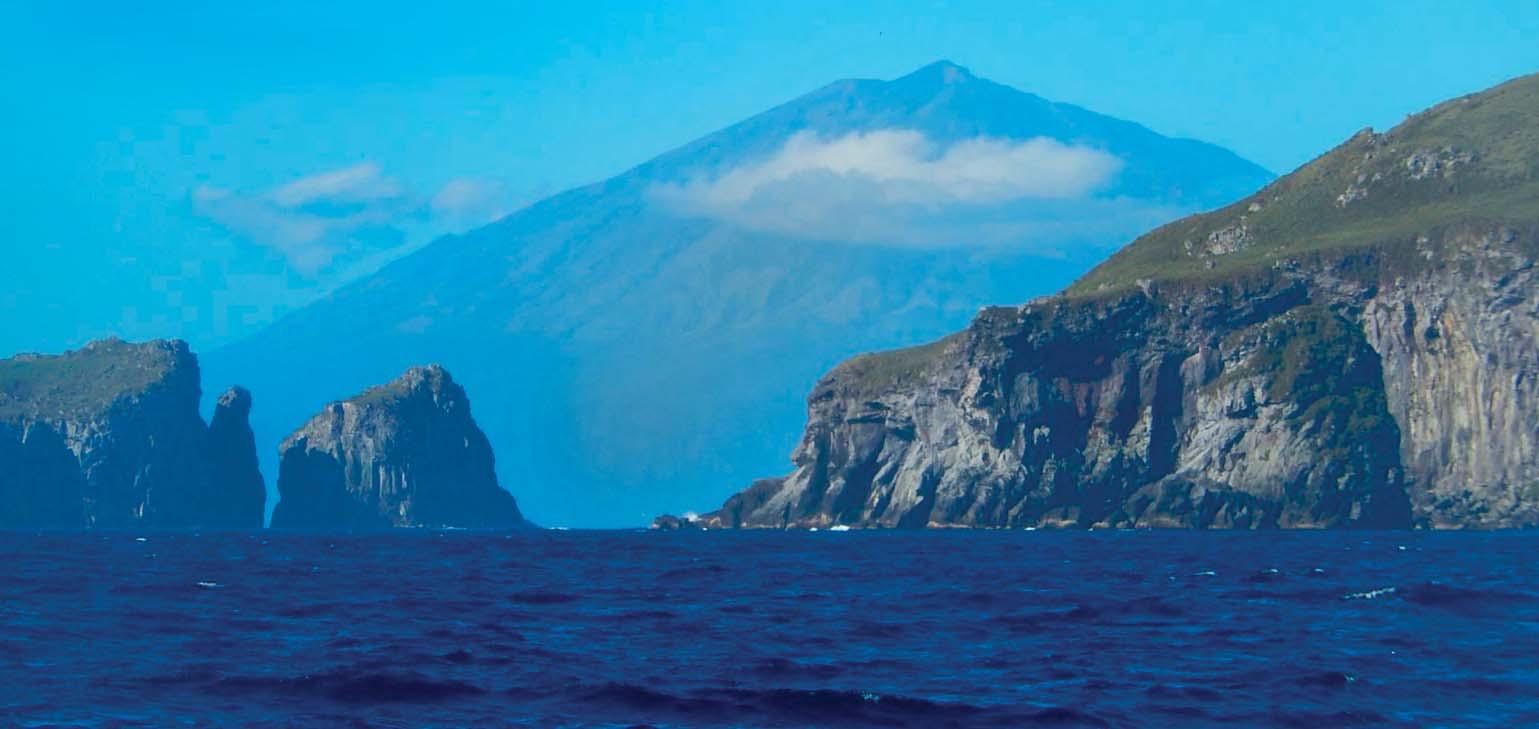
... and Nightingale Island, the southernmost
Yesterday the sun was at the zenith once again. 28 days ago it was right above as well, at 32°W – 1433 miles away as the seabird flies, but with the detour to Tristan da Cunha we’ve sailed 3358 miles, well over double the distance. At times I need to think hard if the sun is actually in the north or the south. In the Azores the sun was naturally circling its daily path across the sky to the south, in Tristan it was obviously to the north, and now it is south again. If I stay long enough in St Helena the sun will cross the Equator as northern spring approaches and be in the north again. On the return passage to Europe we will overtake the sun’s declination once again. It is an amusing tropical game.
This is my fifth South Atlantic round trip, but this time the usually stationary high pressure system is drifting all over, chasing us with calms. In theory it’s downwind sailing all around the left-hand rotating high, but for eight days we had flat water all around with the sails flapping helplessly in the ever-present swells. I lowered them and waited for the wind to come back eventually. Once this took 18 hours, and on another day we managed just seven miles with great effort, but despite this I’m in good spirits. Any sensible sailor would turn the engine on, but I tend to arrive after long sea passages with full diesel tanks. Speed is not a priority, but I do want Nehaj to perform her best, which means lots of sail changes as I choose not to have furling headsails. For the first time in years I’ve been airing out the old asymmetrical spinnaker again, rewarding us with two days of flying a magic carpet.

The recent new moon created a total solar eclipse in the South Atlantic. On this day I was rounding the stunning islands of Tristan da Cunha in exceptionally clear weather, but although I kept an intensive lookout I didn’t see the eclipse on that already very special day. I didn’t stop in the Tristan islands because the only anchorage was exposed to the northerly blowing at the time, plus I didn’t know what the Covid procedure was. Later, in St Helena, I had to stay aboard in quarantine for five days after taking a Covid test.
I’m often asked about provisioning. When at sea for a long time you should not expect gourmet food – at least not aboard Nehaj! Yesterday I made apple pudding from the remaining limp-looking fruit and with the last ‘fresh’ yoghurt it was delicious. (This had kept very well for months without refrigeration.) The veggie-box is down to onions, potatoes and pumpkin, while the supply of dried fruit and vegetables is virtually unlimited. The self-preserved butter has kept well, the hard cheeses are still good and the supply of basics like rice, pasta, beans, lentils and mashed potatoes seem infinite. Dry foods like milk, flour, eggs, muesli, oats, nuts, raisins, biscuits and chocolate are plentiful in all varieties. Pesto and curry in jars bring a nice change, as do herbs and spices, and I can still sprout seeds for a lettuce replacement. As always there’s way too much tinned food. Due to careful shopping and stowing there’s very little waste, with most of the food neatly packed into containers or double zip-lock bags.
My supplies of food, water and diesel are the usual criteria and provisions for a year are no problem. 500 litres is enough drinking water for over five months at 3 litres daily, plus there is rain every now and then. I also have a hand-operated emergency water maker. Without heating the boat I always carry too much diesel. If my amateur radio communication became faulty there might be a few questions but no broken hearts.
There are many remote places on all continents, but being totally on one’s own in such endless remoteness can only be found on the ocean. Where else can you say that there’s nobody else for a thousand miles? Coastal cruising can be compared to travelling in a camper van, while the freedom I mean can only be found on expeditions to extreme summits or extreme locations. But who could survive for many months in the Himalayas, the Alaskan wilderness or in extreme latitudes without huge logistics or a support team? On a good sailing vessel solid ground is never further than a few miles away, at the bottom of the sea. The deeper the ocean is the safer it is, and the more I feel this precious freedom.
This freedom has a price, however. You have to accept that far from land there is no ambulance or hospital emergency unit, no police if pirates threaten, no fire rescue and no internet. It sounds scary, but a singlehander’s biggest danger is that one wrong step, all the time and in any weather. If you fall overboard you are dead. Full stop. There is some hope if sailing with crew, but a little bunch of dried flowers ought to be on board just in case. This was a subject we discussed in October 2021 over a meal aboard Nehaj at Santa Maria in the Azores, where I’d met Anders Erikson of Malala and Peter Smith of KiwiRoa, both very experienced long-distance sailors. Should one tow a rope to have a minor chance of survival? Should you fabricate some mechanism to disengage the selfsteering? Or should this rather doubtful last chance not be there at all? Is the reality of death falsely weakened by such devices? I believe that such precautions make the solo sailor a touch less attentive, as deep inside he or she hopes to be saved by that artificial umbilical cord towed behind the boat. Three solo sailors, three opinions.
There are mountains of papers filled out by yachts at harbour offices all over the world. My little heap is probably packed into boxes and collecting dust in the archives. When leaving a port
you name your destination and receive a sheet of paper nicely decorated with stamps and signatures, but nobody checks if the yacht ever arrives. Quite a few times I’ve changed my
Looking aft, with Miss Aries in charge

destination on passage. This has no relevance in the next port and is not forbidden – you just arrive there and fill out a new form. At times I’ve had to think what my last port actually was. Virtually all officials are now online, but there’s no worldwide network for private voyages at sea. Neither those local port controls nor Interpol has a real interest in our whereabouts at sea and there really is no need for it, as our colourful flock of world cruisers includes virtually no black sheep. Such global freedom cannot be found anywhere else, not on land and not in the air, but in my opinion this freedom on the oceans is also a big personal responsibility. I feel like a barely-tolerated guest of mother nature and will leave nothing harmful in my wake. I gave up fishing many years ago when the bloody slaughter of a fantastic deep-water fish made me increasingly nauseous. It is shocking to watch the bright gold and turquoise of a dorado fade away, knowing that its partner for life will be left alone.
I have no idea why those orcas off the coasts of Spain and Portugal are attacking yachts, but maybe there’s too much motoring and too much fishing? I really ought to warm up my patient diesel engine more often, but in the wide Blue it seems like a sin. Hardly any sailor admits their true engine hours, as way too often it’s run to charge batteries and all kinds of fancy installations. My 120 Watt solar panel is sufficient and in these 7000 miles there have been just four engine hours. This great freedom is just to cast off and get out into the wide Blue, no matter if it’s a straight course or back in a big loop. Not long now before landfall in St Helena.
We arrived in St Helena on 16th December 2021 and left three days ago. Bright sunshine and puffy clouds with deep blue sea can virtually be taken for granted here, as the trade winds in the South Atlantic are the most reliable on the globe. Even more stunning is the fact that destructive hurricanes are unknown – no other tropical ocean is favoured so generously by the weather gods.
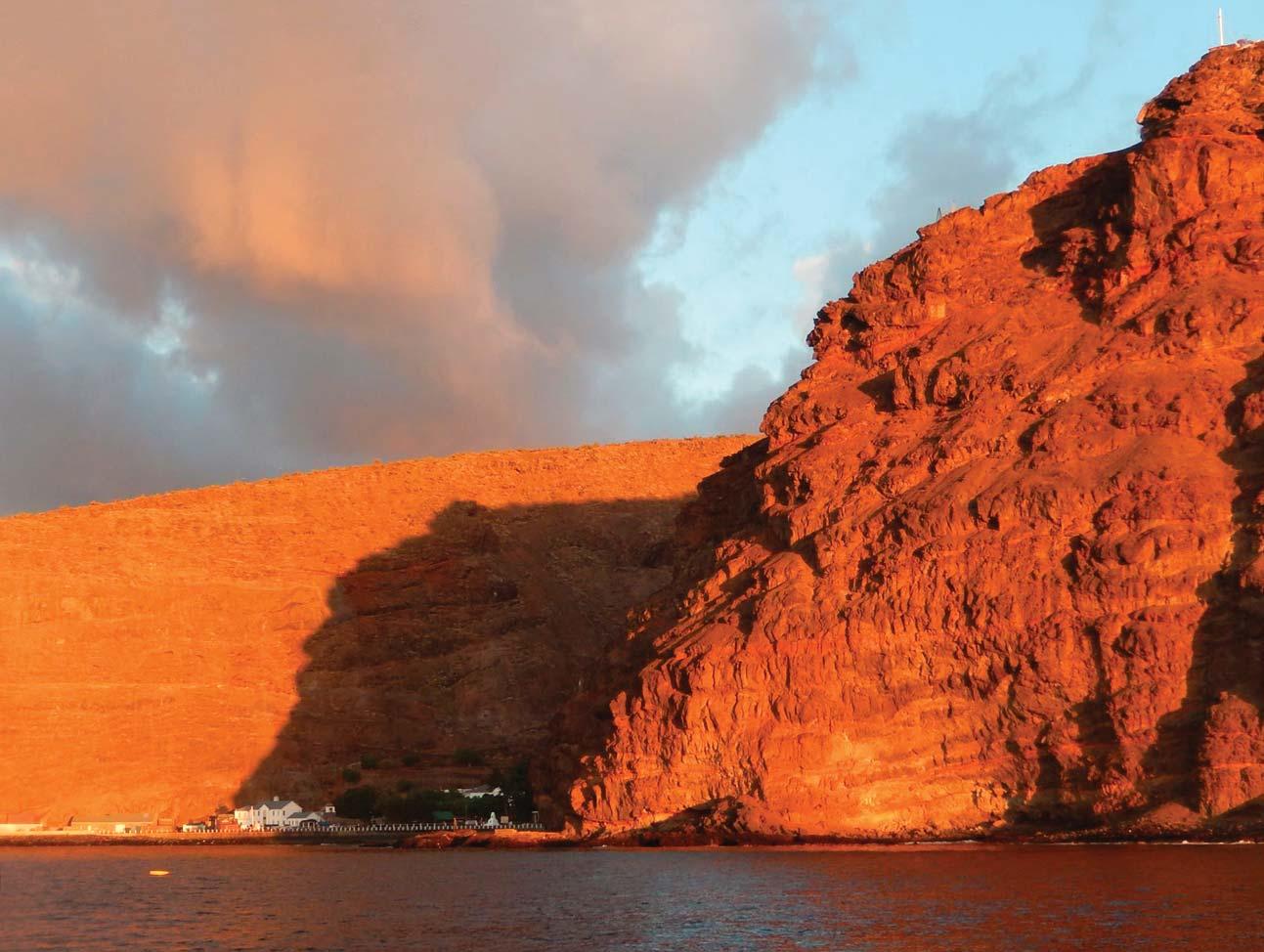
We are sailing northwest towards the Equator some thousand miles ahead. Nehaj is flying in steady southeasterly winds under full mainsail with a poled genoa, or even double-poled foresails, though she’s tumbling a bit in the following swell. I intend passing within sight of Ascension Island but without stopping. These are easy miles which I certainly value, especially knowing that we will be sailing hard on the wind for 2000 miles during the second part of this passage. Under such ideal conditions I might meet King Neptune for the thirteenth time at the zero-line within the week. On the Atlantic chart our present course is just a few millimetres away from the previous three lines up towards the Equator and on to the Azores. I can hardly believe that one of them was just two years ago, when the severely injured Nehaj was fighting all the way to the Netherlands with her damaged hull.
On departure once again I felt this strange tingling. It’s a bit like dreaming in the reality of daylight and feeling butterflies in the tummy. Sneaking away unnoticed is not possible from this extremely welcoming island. After many goodbye hugs I nearly forgot to check

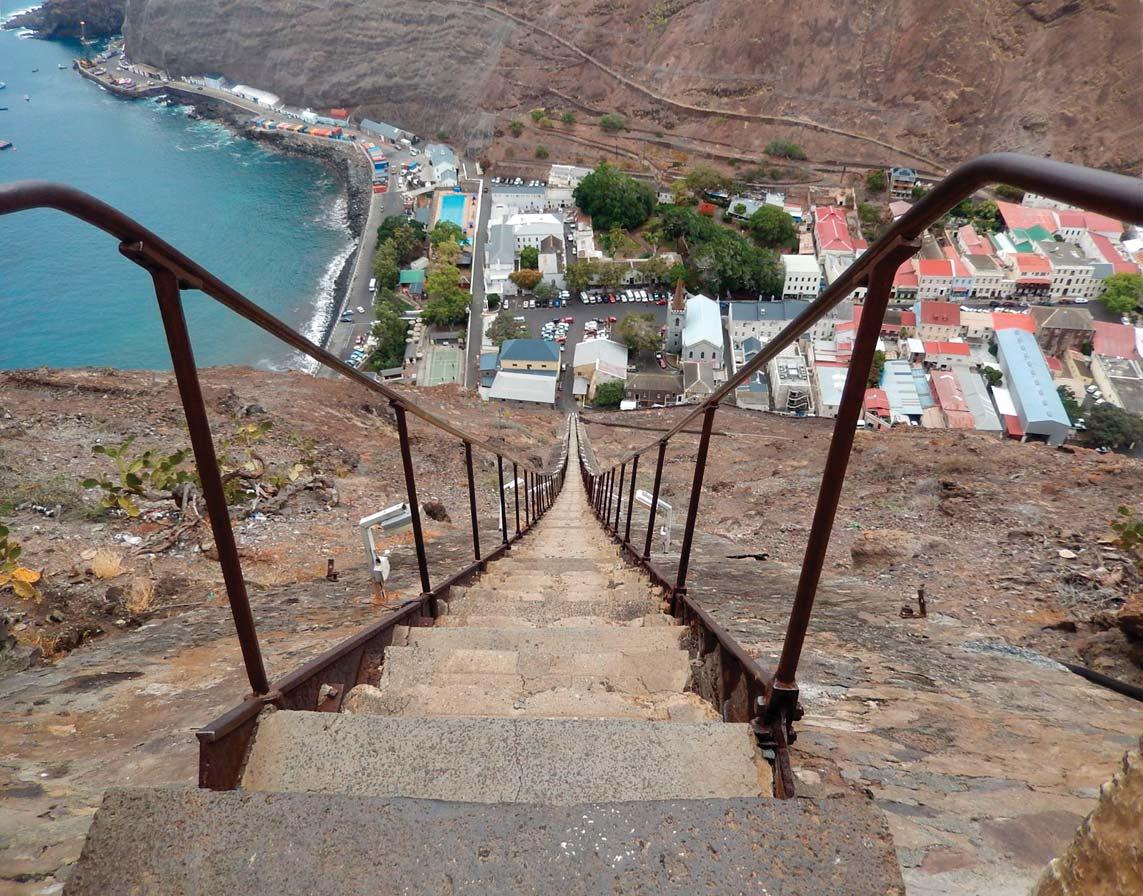

out with customs and to get that important ‘Clearance for the next Port’ paper. Steve, the very charming Port Captain, had already joked that he would not give me permission to leave, then Roy gave me a touching final waving off after kindly opening the heavy shackles of my mooring ropes. When deep water welcomed us back I once again asked Neptune to grant us a safe passage. Naturally it was done with a drop of the delicious ‘Spirit Of The Saints’, distilled from locally grown coffee. But no worries, the cute bottle contained just 200ml.
After three months in St Helena I had virtually forgotten that we were still living in a pandemic. On this remote island no face masks were required and there were no restrictions on daily life, though quarantine was handled strictly on arrival. Once a month the plane arrives*, as does the supply ship from Cape Town, but yachties are about the only foreign visitors. Arriving sailors were checked in with a quick test each Thursday, when figures in blue came out to the mooring buoys. Twice there were positive results due to the short distance from Namibia, so those crews had to stay on board flying the yellow quarantine flag for a further ten days.
Many pages could be filled describing this unique and remote island. Especially during Covid times, the fabulous caring of the ‘Saints’ feels heart-warming when visiting sailors are still not welcome in many countries. It’s only 520 years since St Helena was discovered by
* In March 2022 fortnightly flights from Johannesburg and St Helena were resumed, with a monthly service to/from Ascension Island.
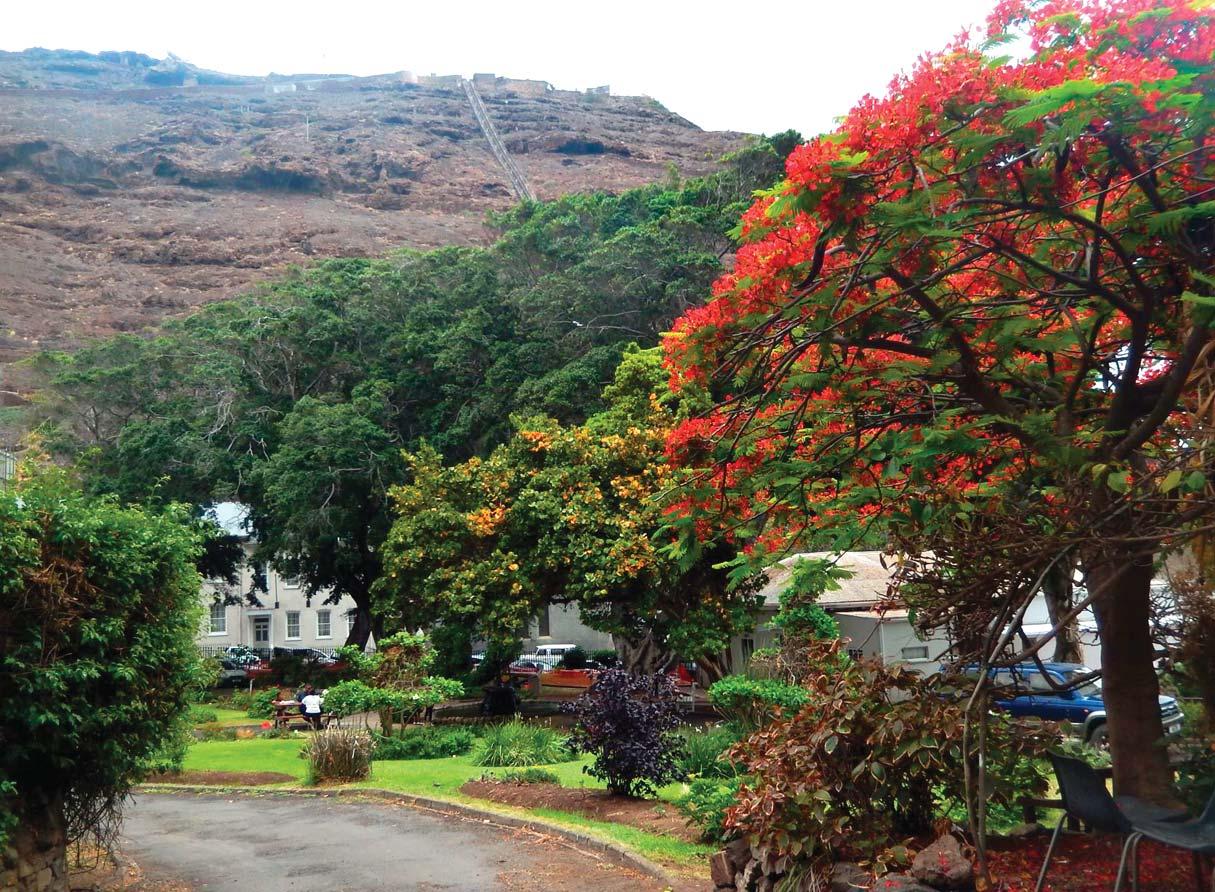 The botanical garden at Ann’s Place
The botanical garden at Ann’s Place
the Portuguese, who found a safe anchorage and lush green valleys but no humans. For the next few centuries the island was fought over by various nations. It was the ideal place to supply ships with fresh water, vegetables and the farm animals that had been left to wander about long before the settlement in Cape Town was established. At different times the Dutch and the English East India Company took over the island, and to this day the many forts remind us of its lively history. Napoleon was sent to St Helena for his final exile and generations of prisoners or slaves were dumped there, though after the Suez Canal created a short-cut between the Far East and Europe things got a lot quieter. An early yachtsman to visit was Joshua Slocum, the first man to sail solo around the world, who called in at St Helena in April 1898 on his way back to Boston, Mass.


In Jamestown today you notice the warm character of the citizens, who call themselves ‘Saints’. In many shades of skin colour they live together in true harmony. It’s mandatory to look each other in the eyes and greet others warmly and often with a hug. Tours of the stunningly green and lush interior proved this island to be ‘set like an emerald on the base of a coastline in bronze’, as a local friend put it. Unlike me, Jonathan the famous tortoise, at 190 years the oldest known living land animal on earth, seemed not to have aged one day in 24 years.
 Joshua Slocum visited in 1898
Jonathan, the famous giant tortoise
The lush interior
Joshua Slocum visited in 1898
Jonathan, the famous giant tortoise
The lush interior
Swimming with the whale sharks was a sensational experience. These giants of up to 18m long visit St Helena in February each year. One of the places where they circle for hours between the dark deep and the surface, feeding


on plankton in the nutritious uplifting water, is off the east coast where a steep volcanic needle in deep water forms a tiny reef with 10m depths. They are not aggressive and don’t seem to be bothered by the occasional swimmers.
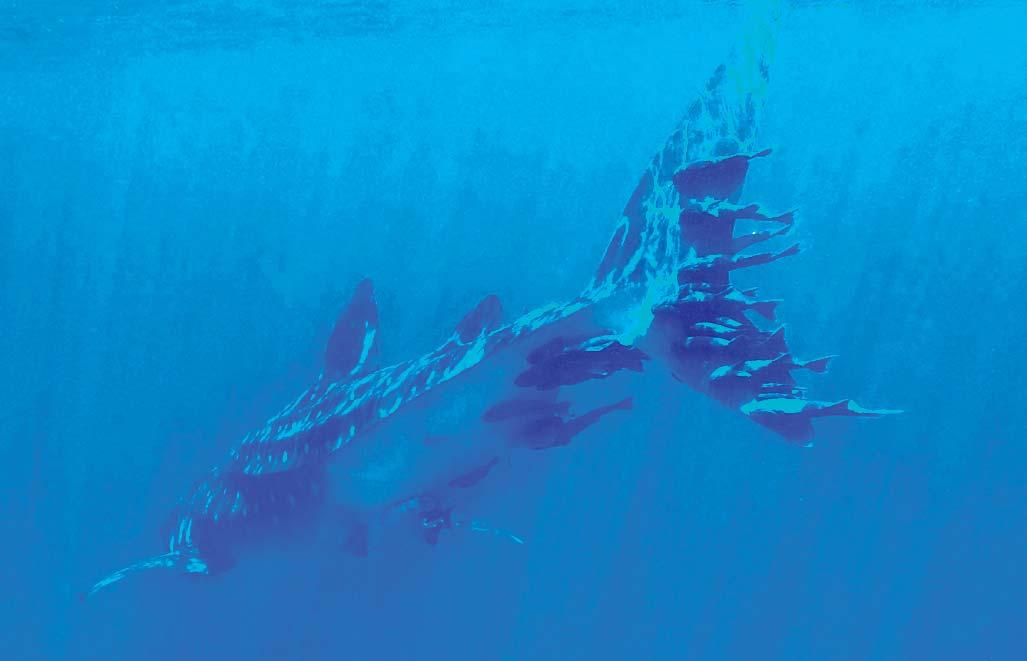
Jonny drives one of the small ferry boats that offer yachties lifts to the shore and back, and occasionally he offers tours along the shores of this enchanted isle. On one occasion some school kids were to be taken out to admire these biggest fish in the world. Jonny invited me to join him for this ‘whale shark tour’ and in no time I was promoted to keeping an eye on the children while snorkelling. They took turns in small groups, while I was allowed to stay in the water and I had a full two hours with the sharks. At times the gentle giants were slowly passing by at my side or just below and I could easily have touched their huge vertical tail fins. It was a unique experience in the warm and crystal-clear water. Some side actors were yellow fin tuna, big manta rays and a turtle. On the way back I had to insist quite firmly that Jonny accepted a small tip.
Keeping
Each time I took a ride ashore I filled two small cans with drinking water as there is virtually no rain on the lee side of the island. Many ‘Saints’ don’t like drinking the tap water, but for me the tap on the pier was a blessing. When I mentioned it once, someone replied that this must be about the only thing on the island that’s free. It’s true that prices of food and everything else that’s imported are quite high due to the long delivery distance, while most wages are relatively low.
I felt that I was not spending enough St Helena pounds to contribute sufficiently to the community. I could hardly pay for the two great island tours with friends, my third tour was free and a consultation at the island’s dentist hit my wallet with just £3.60 (about £2.20 UK). Locally-produced wine is half the price of any import and the fee for lying in total safety between two of the very strong mooring buoys was moderate, but made me feel very relaxed whenever leaving Nehaj.
Those 20 moorings were never fully occupied during my time there and all the yachts I met had arrived via South Africa. Many of them were about to finish a circumnavigation under harsh Covid conditions with unusually long passages to reach a country which allowed entry. On the morning of 24th February I shared the ferry with the crews of Russian and Ukrainian yachts. It was a weird situation and the atmosphere was thick enough to be sliced in pieces. Finally, singlehander Igor remarked that these are ‘good Russians’ and we all had a laugh. In this magical place the peaceful island attitude won.
Last Friday, 29th April 2022, Nehaj arrived well in Horta, Faial. I know the Azores quite well as this is my tenth visit to those lovely green islands. This was my fourth time arriving from the south, with twice from the north and four from the Caribbean. My tracks on the North Atlantic chart of recent years have been star-shaped, centred out here in mid-Atlantic, halfway between Europe and North America.

Due to strange weather conditions during the last third of the passage I made very little progress for eleven days, but luckily a fresh southerly up to gale force gave us a great run for the last five days. This surprising force 8 puff lasted for just twelve hours, but I got the Jordan Series Drogue ready just in case. Approaching the island it was very hazy, and though I found mobile reception at a distance of 12 miles I didn’t spot land until I was 4 miles off. It felt quite strange arriving in the cyber world long before I did in reality.
Landfalls in the Azores feel a bit like coming home to me. A good friend took my lines and, with the Covid situation having eased off, there were tight hugs. The gentlemen in the marina office welcomed me with smiles and remembered me well. In addition I have a good dozen friends on Faial and I met cruisers from Italy and Australia again. The harbour was surprisingly full, mostly with megayachts, racers, monster catamarans and delivery crews on their early routes towards the season in Europe, buzzing with filling diesel tanks and repairing sails and equipment, while bringing tons of laundry and trash ashore. Even so, Nehaj was given a lovely berth.
My updated painting on Horta breakwater
Today the town is celebrating May Day, with performances of traditional dance and live folk music as well as delicious grilled sardines, free for everyone. I have no doubt that the next weeks will be really good. Nehaj will enjoy some TLC, while once again there are no repairs to be made after this passage. As I shy away from motoring on the high seas during calms the passage took many extra days, but that really doesn’t matter to me.
Despite the fact that this voyage to St Helena and back via Tristan da Cunha didn’t have the ‘lucky star’ of favourable winds in the latitudes of the Variables, I would certainly recommend such a hop into southern summer. In particular, from Christmas until the Whale Shark Festival are a special time to enjoy with the Saints. For now, all the best from the Azores!


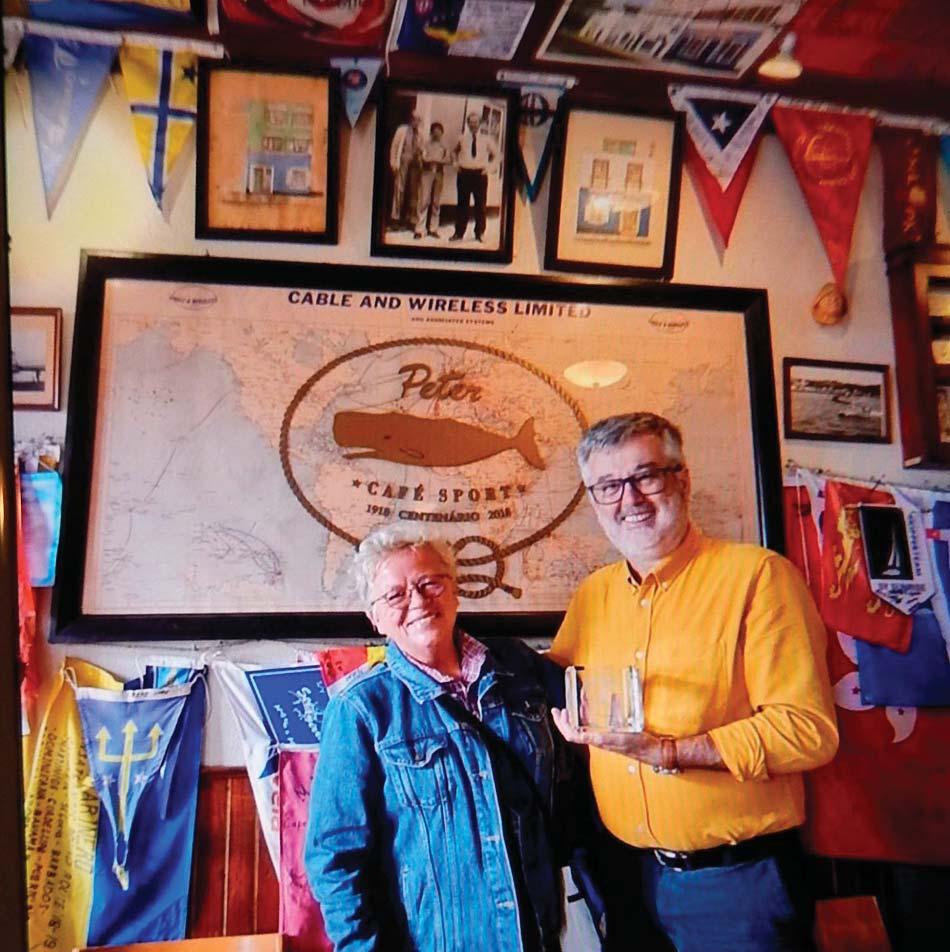
 With fellow Honorary Member José Azevedo, owner of the Café Sport
Fellow singlehanders
Bernard Moitessier and Sir Robin Knox-Johnston
The Scrimshaw Museum above the Café Sport
With fellow Honorary Member José Azevedo, owner of the Café Sport
Fellow singlehanders
Bernard Moitessier and Sir Robin Knox-Johnston
The Scrimshaw Museum above the Café Sport
Superfast internet onboard via WiFi, 4G and satellite
WiFi, 4G & satellite for a complete solution

• Iridium 9555/9575 handheld & 9522/LT-3100 fixed phones

• Inmarsat Fleet One and FleetBroadBand FB150/FB250







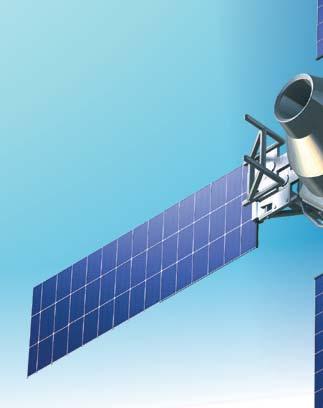
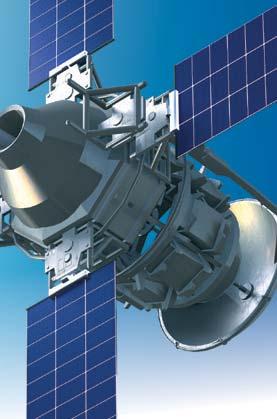



• NEW! Iridium Certus 100/200/700 terminals


• WiFi boosters and 4G modems
• Airtime and spares for all satellite phones/systems

• Excellent after sales service
• Global delivery and technical support





• Who else will you call mid-ocean?
• Email compression services
• Blogging and position tracking
• Weather services - use your favourite weather app!






• Firewalls to control unwanted data usage and spend
(Don’t forget to ask for your OCC discount!)
(Peter and Ginger began their liveaboard cruising life in 2004 when they bought a 47ft sloop, Marcy, and departed on a four-year westabout circumnavigation returning home via Hawaii and Alaska. Twelve years later they set off again, this time in Irene, a 50ft ketch with standing headroom for Peter, on what turned out to be a five-year eastabout circumnavigation via the Northwest Passage, the Suez Canal, Japan and Alaska, for which they received the 2021 Vasey Vase.)

Like many cruisers hailing from ports on the west coast of North America, Japan as a natural leg of a Pacific voyage has always been on our minds. The beauty of the culture and country aside, as a stepping stone for completing a North Pacific loop it is undeniably convenient. For one thing, because of prevailing winds and currents, a circuit of the Pacific Ocean would logically include Japan on the return back to North America. But many of the people we knew who had sailed to Japan had stopped only briefly, viewing it as a place to reprovision for the jump home across the North Pacific, rather than as a cruising destination in itself. We had the impression that sailing in Japan was daunting – plagued by typhoons, currents, fog, fishing gear, forbidden ports and impossible regulations. We had understood that it was perhaps a country better visited by air and land than explored by boat.
 Peter and Ginger
Irene in the Georgia Strait in 2016
Peter and Ginger
Irene in the Georgia Strait in 2016

Secured below Hirado Castle on the western tip of Japan’s Kyushu island

From March until May 2021 we had the opportunity to sail for three months in Japan, from Okinawa in the south up the west coast of the island chain to Hokkaido in the north, and discovered that many of our preconceptions were false. The sailing was good, with predictable winds and many enchanting harbours – and shelter was never far away in case of a blow or typhoon. Also, recent changes in rules and technology have helped with Japan’s unique challenges. Rather than being daunted during our cruise, we were charmed and can recommend Japan as a cruising destination in itself rather than merely a place to provision or to park the boat and travel inland.
We weren’t certain what to expect as we navigated complicated arrival hurdles before departure but, as with any new country, once we settled into a routine it became familiar. A typical cruising day for us would probably involve departing at an appropriate time for tidal current considerations, just as we do in our home waters. Riding a fair current to the next stop makes sense and, if the day includes a transit through a pass, that timing can be non-negotiable. Arriving in the dark at an unfamiliar port has so many dangers that we try to avoid it, but leaving in the dark is a different story, since one has already had a chance to see the layout of the port and spot unlit dangers such as shallow spots, buoys and snags in daylight. Accordingly, we tend to depart early to arrive before sunset, even if that means leaving before dawn.
On a typical day we will be heading to a waypoint provided by a friendly Japanese sailor and leading to the next port. We head directly offshore as we depart to make sure we don’t encounter any nets set inshore before turning onto the course for our destination. Our friendly sailor will have warned us about those nets with a dramatic admonition to keep well clear, yet he
Japanese buoys – this is at Okinawa –are accurately placed and well maintained
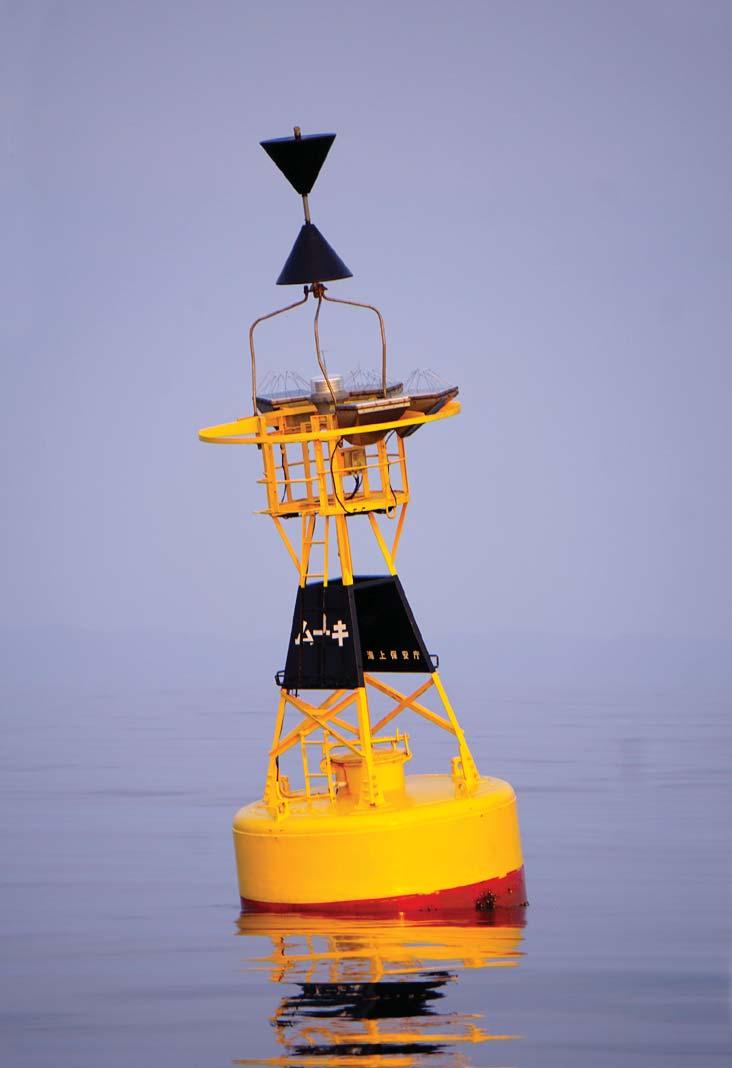
himself will sail quite close to the shore. We will have good winds on our typical day, maybe a beam reach in 10 to 15 knots with reasonable waves. Irene, like most boats, loves these conditions – and so do we. We fly onward, enjoying lunch and maybe dinner on passage. The VHF radio will be quiet, unless we are hailed by Coast Guard or Customs stations. Local sailors don’t anchor and seldom use the radio. We sail with our AIS transmitting and thus attract attention from the authorities, shore station or vessel. No matter – the conversations are polite and charming and always end with a warning to ‘be safe!’ and avoid surf, current, fishing nets or weather.
The miles roll by and we approach our destination port, hopefully in full daylight. Only once did we arrive in the dark – it worked out well but who needs that kind of stress? As we approach, we are all business. Japanese ports are guarded by breakwaters, often multiple breakwaters, to be secure in typhoons, and as a result the entrance can be tricky, with doglegs and beacons. We weave our way in and enter a basin bordered by concrete walls. There is usually a fish co-op building and perhaps an ice tower, as well as fishing boats tied up to the wall. We would never tie up in front of a co-op or ice tower as these are the busiest spots, especially if the fleet is actively fishing. We make our way to the waypoint and tie up carefully. As always, we ask the first person we see, ‘are we okay here? Daijoubu?’. These waypoints are valuable – once we tied up just a few feet from a waypoint we had been given earlier. We were directed to move the few feet back to be exactly, precisely, on the waypoint.
This speaks to a reality in Japan. If a boat, especially a foreign boat, shows up in an unusual place it can upset people, yet if you’re in a spot previously occupied by a sailing boat it’s always okay. We’ve found that it’s important to respond to instructions – if you are asked to move, do it! The thought of unresponsive foreigners in the harbour can be extremely disturbing in a Japanese village. Anyway, we tie up, and since we are in a fishing harbour no doubt it will be to a concrete wall with bollards. There may be some surge, or waves from swell, tide or traffic, so spring lines and fenders are essential. We found our massive Yokohama-style fenders floating at sea and on the beach, and carried them on deck until we left the country. It had been suggested that we should
 Collecting fenders off the beach
Collecting fenders off the beach
carry a ladder in order to reach the top of quay walls, but Irene’s pin-rail at the main shrouds provided a perfect step and we could get on and off easily even at the lowest tides.
The scene will be tranquil and attractive, with drying nets and colourful flags. We may take a walk away from the quay, admiring traditional houses and beautiful gardens and perhaps a Shinto shrine or two. Back at the boat we may find that we are joined by a Japanese sailor who has tied up next to us, or even rafted to us. Drinks and discussions will occur, and the plan for the next few days become clear. We will learn about the local onsen (bath) or delicacies available at a nearby restaurant. Perhaps a pleasant day or two will pass before we move on, or maybe we’ll depart early the next morning – cruising at its best! Mixed in among the fishing ports, which are free of charge, it will be possible to visit a marina in a larger city, in which case we will pay a fee similar to marinas everywhere. There are also some free (or very inexpensive) pontoons available in smaller tourist towns.

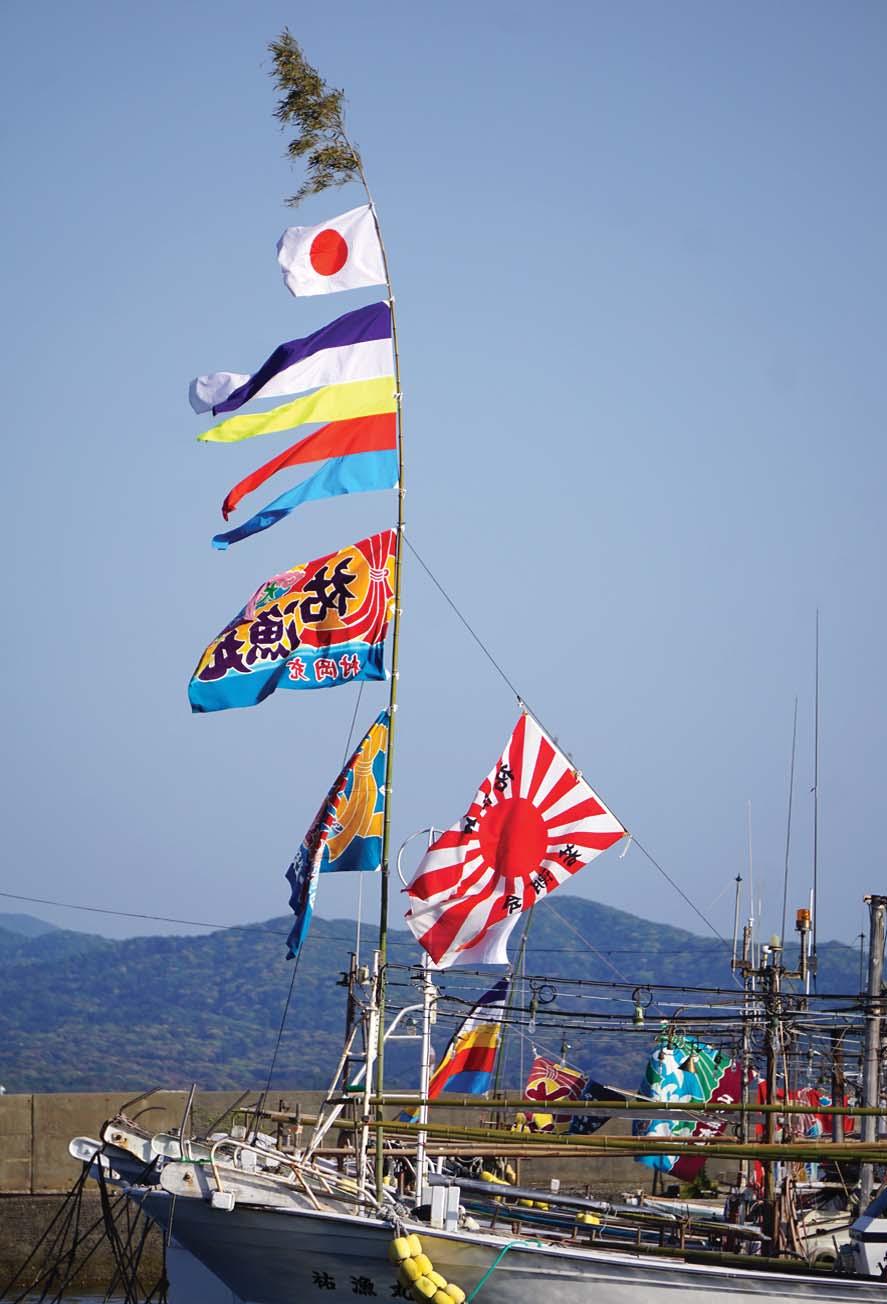
The classification of ports as ‘closed’ or ‘open’ dates from the 17th century when Japan entered an isolationist period as a reaction to problems encountered with unregulated trade and interaction with Western nations. Foreign ships were only allowed to visit certain ‘open’ ports, a distinction which remains to this day. A visiting foreign yacht is normally only allowed to enter an ‘open’ port,
Ginger admiring a torii gate, typically found at the entrance of a Shinto shrine flags on fishing boatswhich tends to be a larger commercial port – fine as a base for inland travel, perhaps but not as scenic, enjoyable or representative of the diversity of coastal Japan as the smaller ‘closed’ ports. Japan has hundreds of such ports and they are often adjacent to charming and scenic villages.

Luckily, in recent years the Japanese government has streamlined the process (it’s always a process!) which allows foreign vessels to visit small, charming ports rather than be restricted to a few larger, industrial ‘open’ ports. This is done by obtaining a ‘Closed Port Permit’ on entry, which gives permission to visit all ‘closed’ ports. Amazingly, this permit has no expiration date, so as of this writing we never need apply again should we return to Japan aboard Irene. With several e-mail exchanges before arrival in Japan and a bit of back-and-forth due to Covid, we were granted a Closed Port Permit and allowed free entry throughout Japan. In our three months of cruising we were never charged a single yen to tie up, even for several nights, in one of these small harbours. We only paid fees at the occasional marina (two in Okinawa and one in Fukuoka) that we visited when we needed to empty garbage and top off our water tanks.
Another document that facilitates cruising is the Naikosen , which documents temporary import of the vessel to Japan. Once imported, the vessel is considered domestic rather than foreign for all customs issues, which allows travel from port to port without going through customs inspections each time. A very useful form indeed!
We had read and heard that ‘knowing some Japanese’ was essential – ha! It’s impossible for most of us to pick up any new language while cruising, much less such a complex one. But smartphones can now read Japanese characters and this convenience is amazing! Being able to scan and identify an item in the supermarket or translate
Vending machines sell so many things...
a road sign can make all the difference. We did have some hilarious translations and we found the nuance of Japanese isn’t always handled well by translation programs, but simple concepts are easy to understand and communicate.
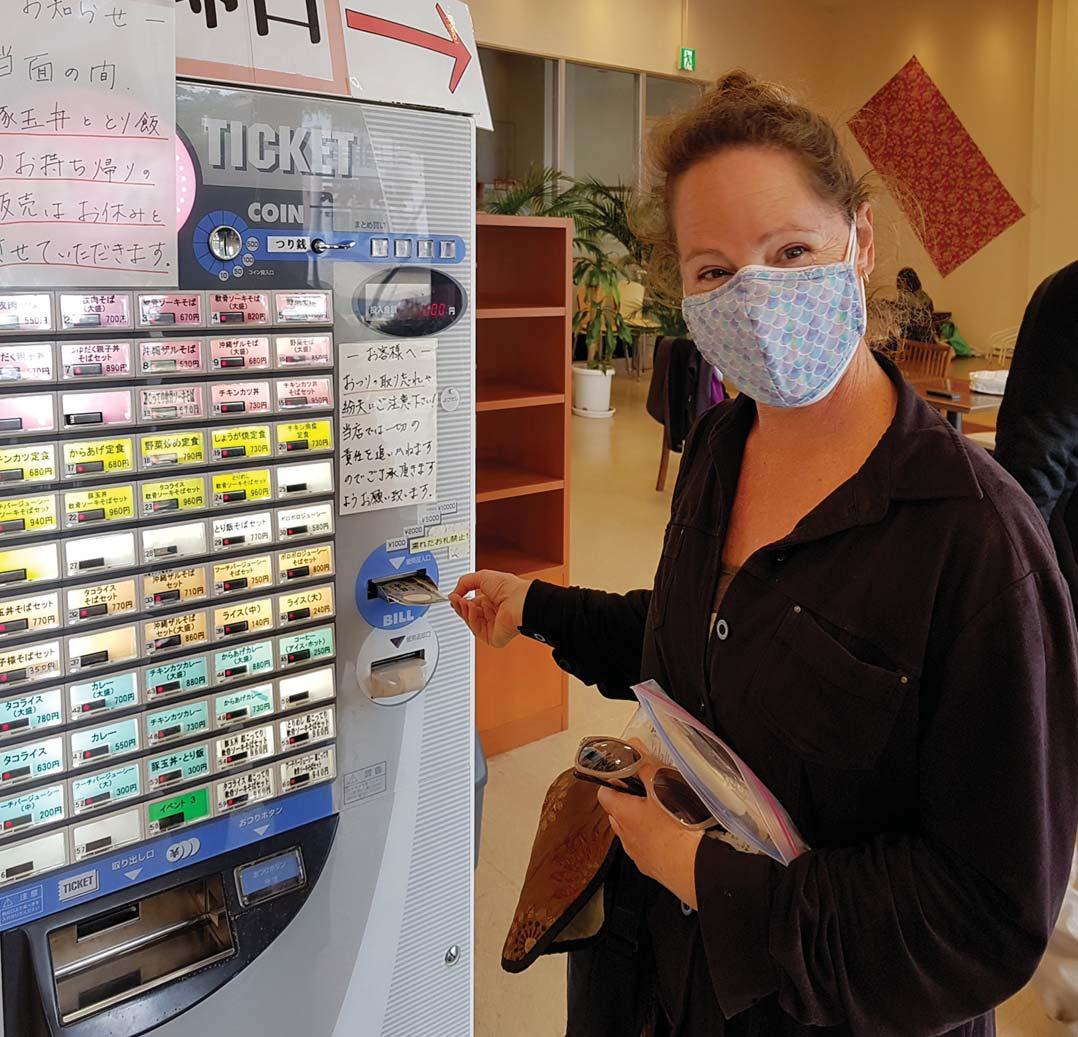
Many government offices now have an English speaker and in other places many young people speak some English. Necessary telephone calls with officials were completed by asking the receptionist for someone who speaks English. Quite often a shy Japanese person will answer ‘no’ when asked directly if they speak English and if that happened we might jokingly say, ‘no problem, I speak Japanese
ichi, ni, san, shi, go...’. Counting on one’s fingers like a pre-schooler gets a giggle and it usually turns out that the person has understated their skill in English. Enough is understood to solve whatever issue is in question.
Helpful, friendly fellow cruiser Toshi-san

A small but enthusiastic and very helpful group of Japanese yachtsmen have made the appearance of a sailing boat in small ports – the very places we wanted to visit – a normal thing. They share information and waypoints generously, and waypoints are key to successful cruising in Japan ... literally like having the key to a port. One of the many pleasures of cruising in the country is greeting and chatting with fellow sailors. Expect to get excellent advice on exploring any section of coast, dining suggestions and warnings about any dangers. Also, many ports have an established resident yachtsman
‘ambassador’ who assists in multiple ways – assistance with officials, provisioning advice, routeing advice and so on. These people are found by word of mouth and are very helpful. For example, we had a sail shipped to a cruising ambassador in Hokkaido, where it was conveniently waiting when we arrived.
Onsen or public baths, which are wonderful places to relax and warm up after a chilly day of sailing. Many have a ‘family room’ that can be rented for a private bath, which we preferred, not only because of Covid concerns but also because we didn’t want to accidentally break any rules of etiquette and upset anyone. For example, we have some discrete sailors’ tattoos – strictly forbidden in a conservative onsen.
Laundromats are efficient, spotlessly clean and there are usually several to choose from in a town. Japan sported the best machines we’ve encountered anywhere in the world – many newer machines wash, dry and include soap – just load the clothes in, pay and come back in an hour for clean, dry clothes. Some of the laundromats were attended, usually by charming mature ladies, and in the case of unattended ones our smartphones were able to translate instructions.
Japan’s culture is world renowned. We found all of our expectations to be met and often surpassed in hospitality, visual delights and art of all types – culinary, industrial, architectural, horticultural, design and public art. We were especially enamoured of the culture of hospitality. We encountered many people – officials, shopkeepers, fishermen and bystanders – all willing to try to resolve any sort of problem and many offering friendship. Unlike the situation in some parts of the world, government officials in particular seem to want to help find a solution, even if a situation seems unsolvable. We found the Japanese people in general genuinely seem to want to make a visitor’s experience positive.
Translating Japanese laundromat instructions by smartphone
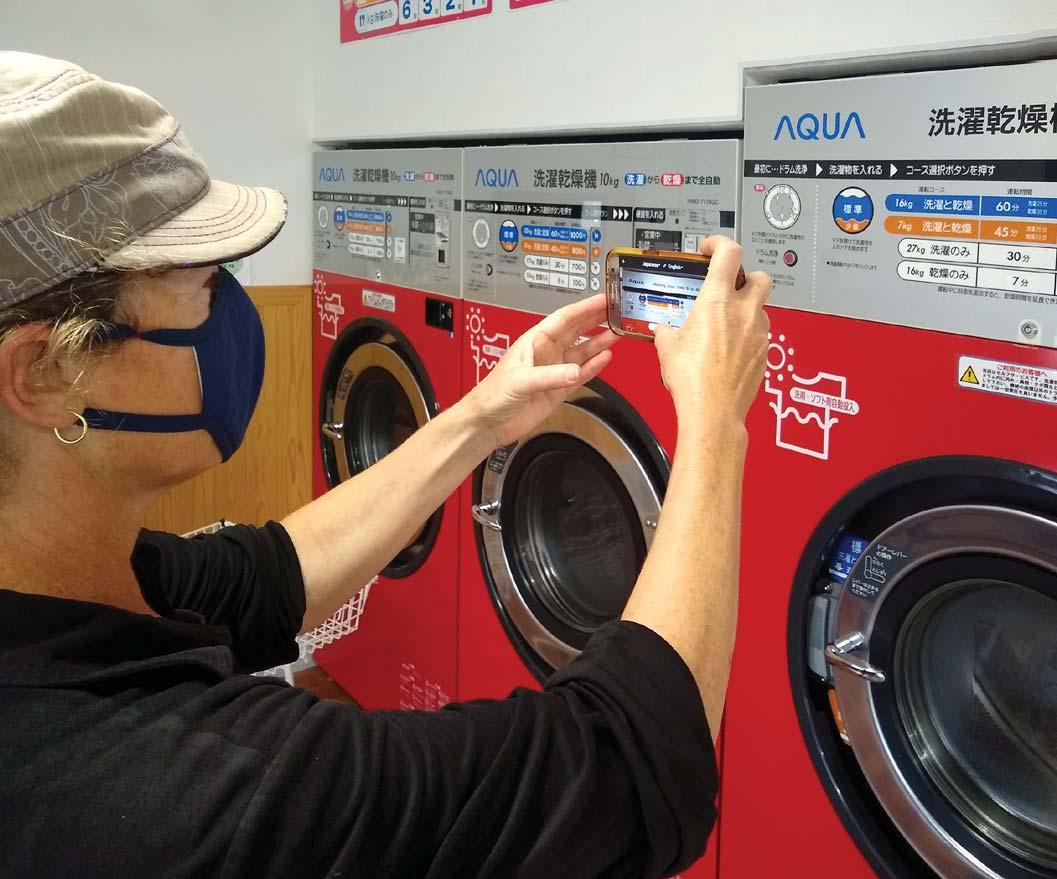
What was unusual for a cruiser? Not anchoring. It’s not strictly forbidden, except in a port or near any aquaculture – it’s just not done. If you want to anchor it would be best done where no one will see you, as otherwise it may be assumed that you either need help or are up to no good.

Beautiful regional manhole covers are seen throughout Japan
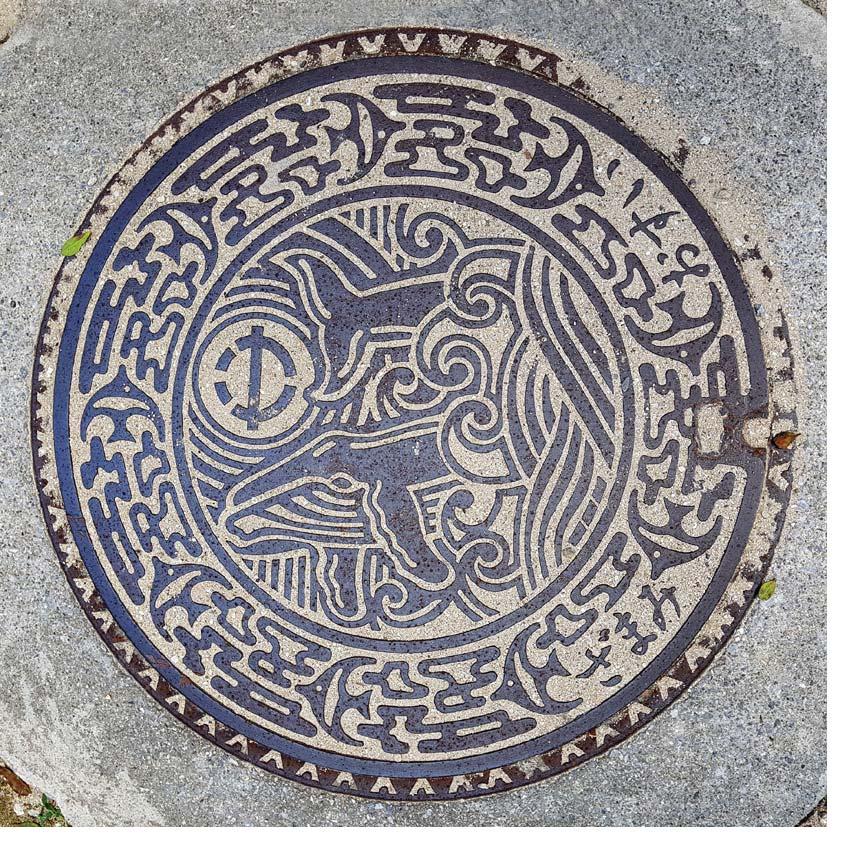
We had expected to encounter officialdom – everything we had read had mentioned it – and when we arrived at our first port in Japan we were greeted by carloads of uniformed officials – Customs, Immigration, Health, and Coast Guard. They co-ordinated with one another quite well, with one team waiting while another finished their business, but even so at one point there were a dozen officers aboard Irene, carefully taking sample swabs from every imaginable surface.
The famous statue of Marilyn the dog on Zamami island, Okinawa – her devoted companion Shiro is to be found on nearby Aka island
 Ginger enjoys a private onsen (bath)
Ginger enjoys a private onsen (bath)
We had not expected continued oversight from the Coast Guard and Immigration as we cruised onward. Even with our temporary import document and Closed Port Permit, as we arrived at many of our nightly spots one or more Coast Guard officers would arrive to fill out forms – last port, next port – and sometimes even request an inspection down below. At first we were disconcerted, but we came to understand the expectations and even enjoy the interactions. The officers were always young, polite, earnest and friendly. For many of them, ours was the first foreign yacht they had seen in their official capacity.
Japanese waters were not the most difficult we have encountered over the years by any means, though the southern islands have plenty of coral, with all its implications for careful pilotage. Japan is very well surveyed and charted, the ports are well buoyed and
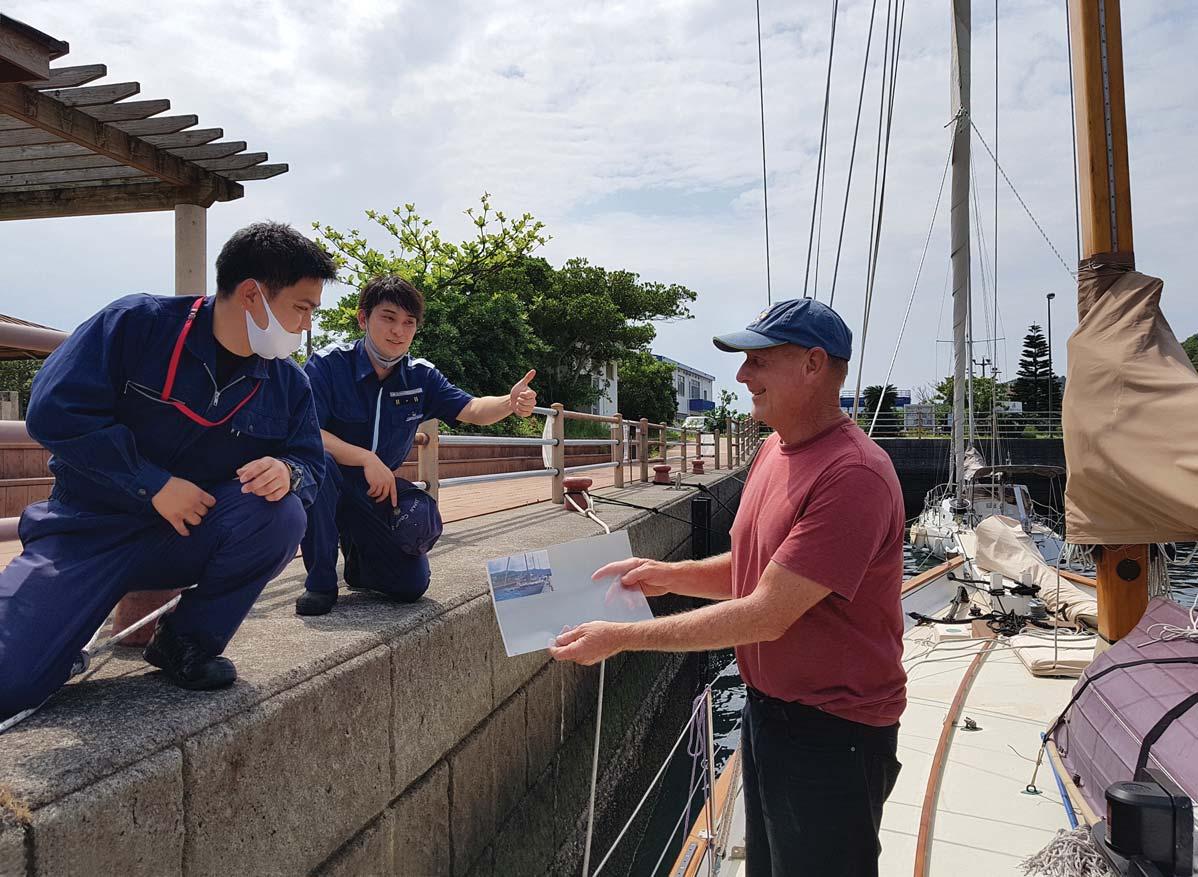
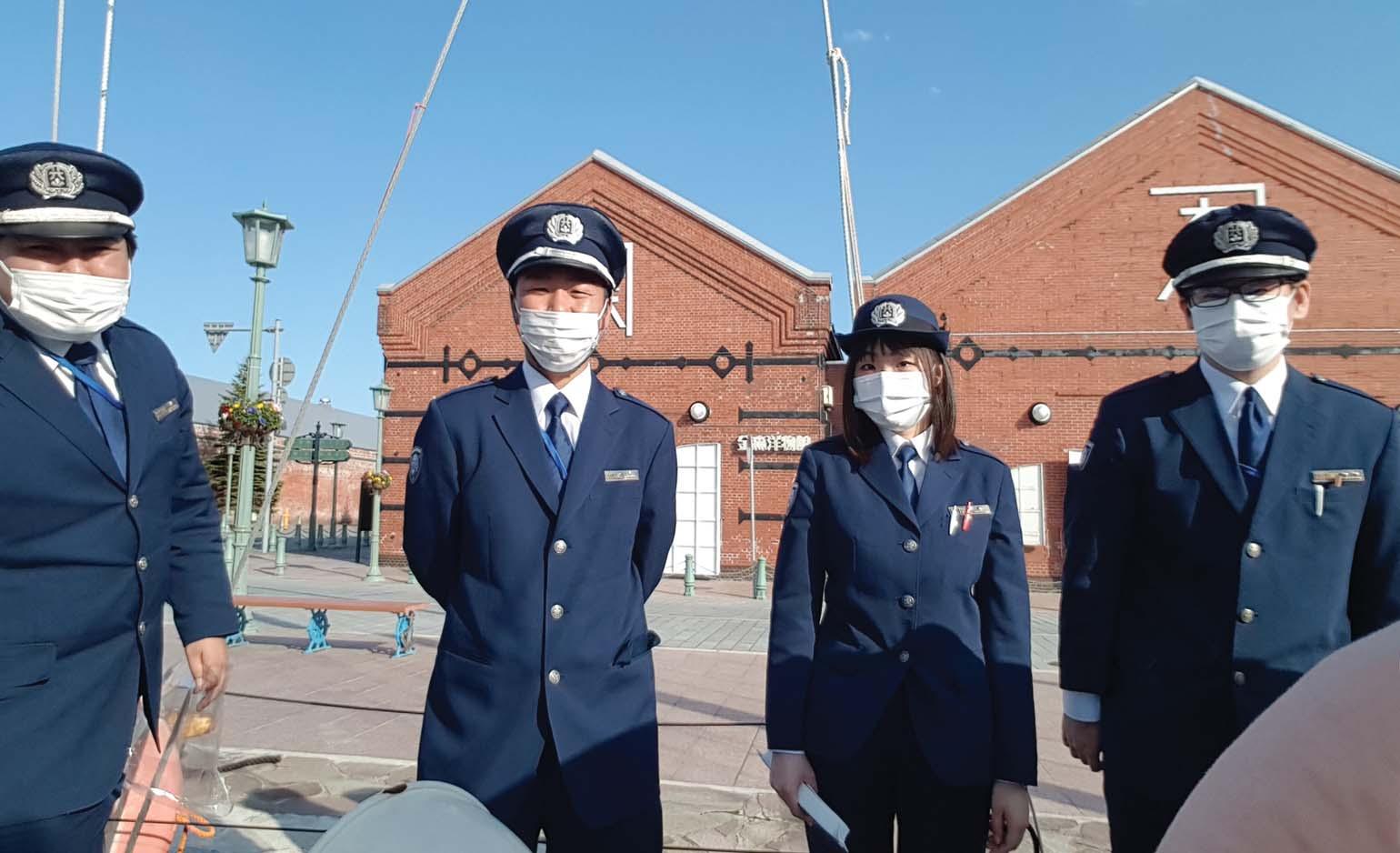 Peter chatting with Coast Guards in the Amami islands...
... and Customs officials in Hakodate
Peter chatting with Coast Guards in the Amami islands...
... and Customs officials in Hakodate
lit and there are few offlying dangers. Our Navionics and C-Map charts were very good offshore, but many of the small ports were not charted in any detail. There is detailed Japanese charting available for all ports, online or in regional (S-Guide) booklets. The latter are now out of print, but we were loaned a copy by sailors we met along the way. The Japan Hydrographic Association has an Apple-only app that is reasonably priced and updated regularly, including fishing net permit locations, depths in harbours and Notices to Mariners. The only catch is that it’s in Japanese – of course. The handy translate feature on the smartphone helps decode details.
The northern islands have seaweed, current, fog and small freighter and fishing boat traffic, but no more difficult than those same challenges sailors experience in the Pacific Northwest. The shipping traffic we encountered behaved in courteous and predictable ways though, interestingly, VHF radio is not normally used in passing situations.

To sum up, cruising under sail in Japan is enjoyable, predictable, social and rewarding. Having visited once we now know that Japan is very worthy of repeat visits and detailed exploration rather than being just a stepping stone home. Currently there are no published cruising guides for Japan. We used a number of online resources in addition to helpful information acquired along the way. We will continue to compile and update those resources on our blog at www.oceanswell.blogspot.com.




(Does the Rev Bob Shepton need any introduction? Probably not! His first article during my tenure as editor appeared in Flying Fish 1991/1 and more than 20 have followed since then, including Cape Horn the Hard Way in Flying Fish 2022/1. Bob has won the Barton Cup, tackled the Northwest Passage (twice), written several books and, at the 2022 AGM, he was elected to Honorary Membership. So where do you go from there? Both north and south, it seems!
This article was published in Sailing Today magazine, March 2022. Much of Bob’s first cruise can be followed on the chartlets on pages 134 and 136 of Flying Fish 2022/1.)
Covid was not our problem in the summer of 2021 – no wind was. Initially, the plan was to introduce Steve, my new co-owner of Dodo’s Delight, to ocean sailing. At first we were aiming for the Faroes, an open sea crossing of some three days north from Stornoway on the island of Lewis. But then the Faroes flashed from Green to Red for visiting, so that was out. Well let’s try for Shetland, we thought, or failing that Orkney at least. But there was still no wind.
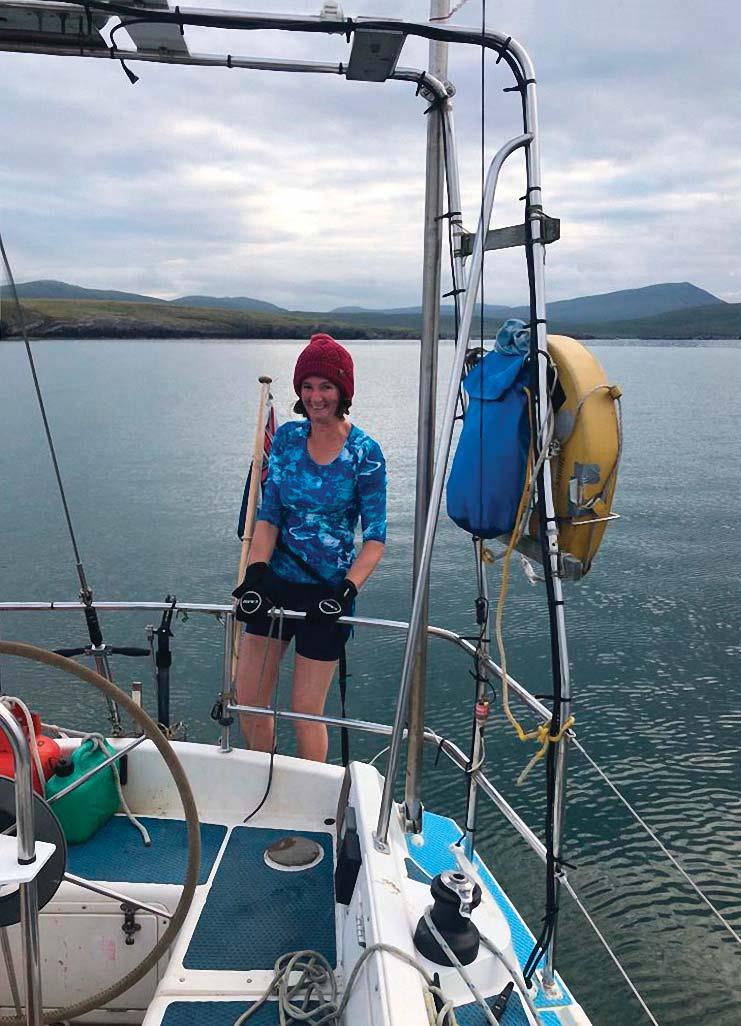
We started from Appin, on Loch Linnhe on the west coast of Scotland, under engine of course. Down Loch Linnhe, up the Sound of Mull and into Loch Drumbuie, south of Oronsay and close to Tobermory, for the night. A favourite hurricane hole of an anchorage, Loch Drumbuie has one disadvantage – the surrounding hills cut out all communications. But we did not need a forecast next morning to tell us it was going to be fine and windless in this incredible summer we were having in Scotland.
So, we motored again, past the west side of Canna for a change and into the Minch. It was still calm and sunny, and we kept a relaxed watch system amongst the three of us – Rachel, one of my daughters, had also joined us for the trip. All was well if not exactly exciting as we proceeded on autopilot until we had to slow the engine to make some adjustment and, for some unknown reason, the autopilot refused to work from then on. We had to hand steer, continuing to do so until finally putting into a bay on the south side of the approach into Stornoway at about 0230. I had not been into Stornoway for many years and discovered next morning that they now have pontoons in there and you no longer moor against the quayside as you used to. But the Stornoway seal still seems active, though maybe it is the pup of the original, plus partner!
Some strong wind sailing.
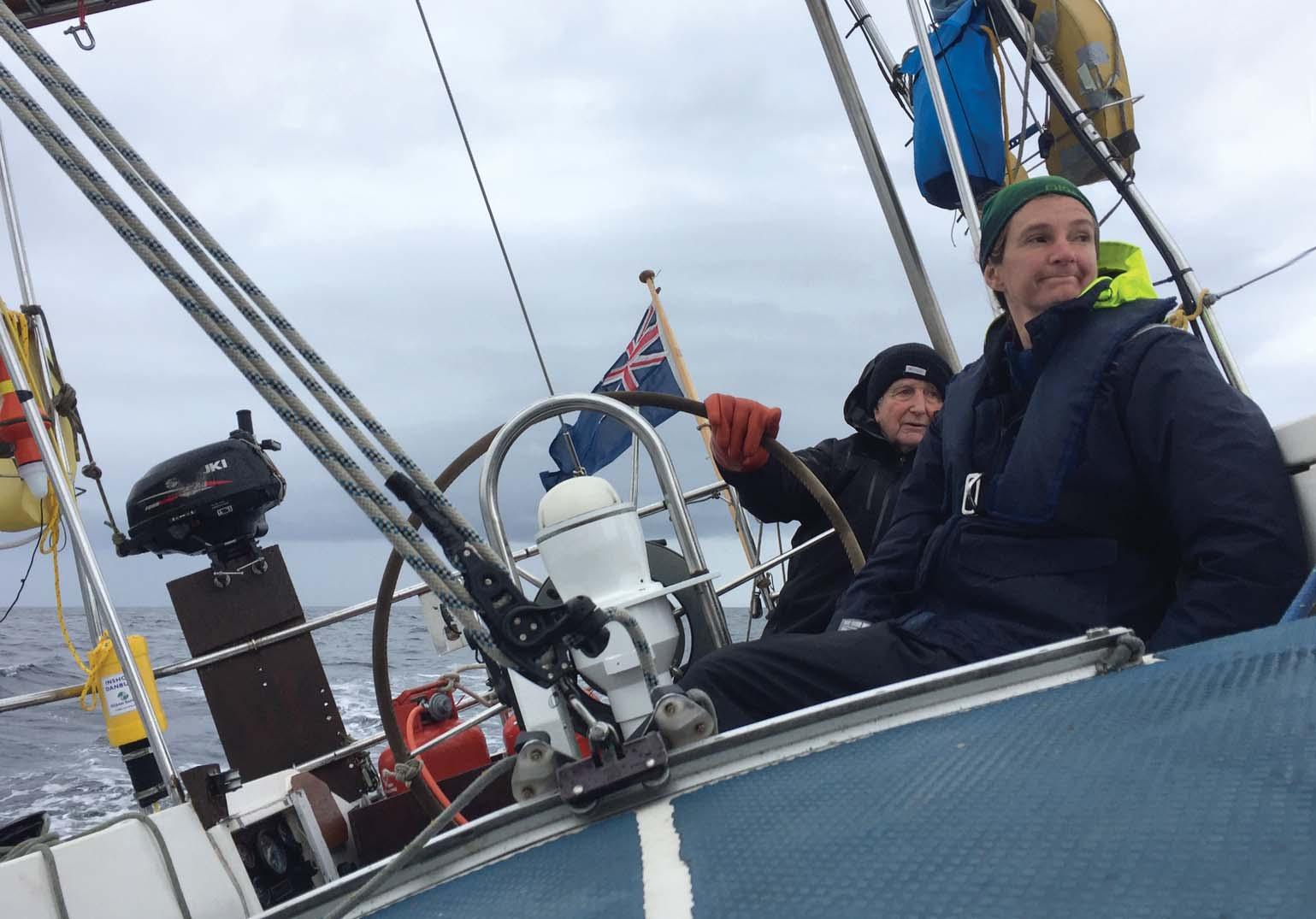
We filled with fuel after all that motoring, but were not pleased to be charged for a whole day’s stay when we had only been there a few hours. The wind – what wind there was – had been continually from the north and now it increased considerably. Hard on the strong wind, we were still not going to make it round Cape Wrath so cut our losses and, in the dead of night, made our way down the long Loch Laxford. On Dodo’s Delight the chartplotter is at the chart table, which is fine for ocean sailing but not for stealing down Scottish lochs in total darkness. But Steve had Navionics on a tablet, so we were okay until we were brought up short, hitting a line of unlit mussel floats attached together. We managed to circumvent these and found a well-protected bay at the far end. As conditions continued frisky even in the anchorage, we stayed there an extra day to let the front pass through.

An intriguing inlet which gave some protection after Cape Wrath.Photo Rachel Shepton Photo Steve Spalding
Despite this, and the care we took to get the tides right, Cape Wrath lived up to its name and was decidedly lively. We were anxious about the rock a little way off the point, which we eventually spotted due to all the spray flying over it. From there we cut in towards the shore as it looked calmer and gradually the sea eased somewhat. We put into one of the bays further along this north shore of Scotland and found a rather strange cleft which gave some shelter, though it was still subject to swell.
It was now decision time due to that bane of proper sailing, time constraints. Steve and Rachel both had only just over two weeks for the trip – were we going to have time to go to Shetland and back? We came to the conclusion that if we went to Shetland we would only have a day there. We would have more time if we went to Orkney, so we opted for that instead.
The Old Man of Hoy from the sea

It turned out to be an inspired decision. Not only did we get a close-up view of that mecca for all climbers, the Old Man of Hoy, as we sailed past, but in Stromness we met up with the 23m superyacht Louise. Owner Grant Gordon is something to do with Grant’s whisky, and Gordon’s gin may be in there somewhere too. That evening we
 The 23m Louise in Stromness harbour
The 23m Louise in Stromness harbour
were liberally entertained on board – the drinks were perfect! I also had an opportunity to visit the John Rae Society here and to view the house, Clestrain, which they are restoring and where he grew up before going off to the arctic and becoming the best arctic explorer of what might be termed the Franklin Disaster era. It was he who discovered the final missing link in the Northwest Passage. We also explored Scapa Flow, with its historical connections. Steve and Rachel snorkelled over one of the wrecks from World War Two, though they admitted they couldn’t see anything!
All too soon it was time to head back. Of course, the constant north breeze now went into the south. Cape Wrath was as lively as ever though as we motor-sailed past with some main up as a steadying sail. We then altered course southwards and made our way home via the Kyle of Lochalsh and the bridge ‘over the sea to Skye’. I got Steve to take us down the Sound of Sleat, but it was all very benign – none of the huge standing waves at the southern end that I had encountered on a previous occasion. So we continued south, mainly on engine, round Ardnamurchan Point, down the Sound of Mull, putting into Lochaline for a night’s sleep before continuing to our mooring in Dallens Bay, Appin. A thoroughly enjoyable cruise in a sea-kindly boat, whatever the conditions.
The next trip was a complete contrast. A friend wanted to take his 38ft Westerly Typhoon to Tenerife so he could live on her there for the winter. It all started fine, though I was slightly surprised to anchor in the Garvellachs the first night, south facing with a southerly breeze, but the swell was slight. Next day we made our way south to Ireland, until we ran out of breeze altogether and put into Aran Island to wait. I became conscious of a slight lack of information at this stage. The skipper and Leonie, the other crew member, would go ashore in the dinghy leaving me wondering what was happening next and when. But then the skipper had nearly always sailed on his own before and maybe I was slow on the uptake. We continued south down the west coast of Ireland without incident, sailing through the Blaskett Islands – I was unaware at that point of their huge historical interest – and on to Dingle.
Here there was a pleasant surprise – we tied up in front of the aluminium yacht Northabout, which I’d last seen on the west coast of Greenland en route to the Northwest and Northeast Passages. We had later rendezvoused with them at sea, at 75°30N, for a

handover of Polly’s camera which she had left on board on a visit in Nuuk. I suppose if you were the first Scots girl to climb Everest you can do that sort of thing! Northabout was under new ownership but, lo and behold, I also met Jarlath ashore in Dingle. He had built her and sailed, with Paddy Barry and their all-Irish crew, on their arctic circumnavigation, and had come to assist the new owner. Wonderful!
We elected to go to a bay to the west for the night to be ready for an early start next morning, but this was a mistake as it was open to the east and, even though we moved once, the swell was uncomfortable. Next day we set off in a strong east wind. The skipper put two reefs in the main and asked, “How is that, do you think?”. Not being used to the boat in stronger winds I paused before replying, “I think it might be better with another reef”. Fortunately, it was. So we sailed on south past the intriguing beehive shelters on Skellig Michael.
“The monks must have been mad”, was the skipper’s comment! And so to the outskirts of the Bay of Biscay. For three days we made progress without incident, The famous Northabout astern of us at Dingle

 The 38ft Westerly Typhoon ready to go
The 38ft Westerly Typhoon ready to go
but then the wind went south and we were close-hauled for three days. I passed on a nugget of wisdom I had been given years ago, ‘on ocean passages to windward, close reach on the making tack’, but we continued hard on the wind, close-hauled, towards the mark. Bouncy and uncomfortable. When the wind eventually relented we did motor for a few hours to sweep by the Tower of Hercules and into A Coruña, a gentler motion at last. To my surprise we did not check in immediately but first went across to Ares. But we did not leave the boat except to swim around it and lunch, sitting in the cockpit in the sun, was very pleasant after all that hard work. When we did check in there was absolutely no trouble re Covid. They seemed almost in denial about it.
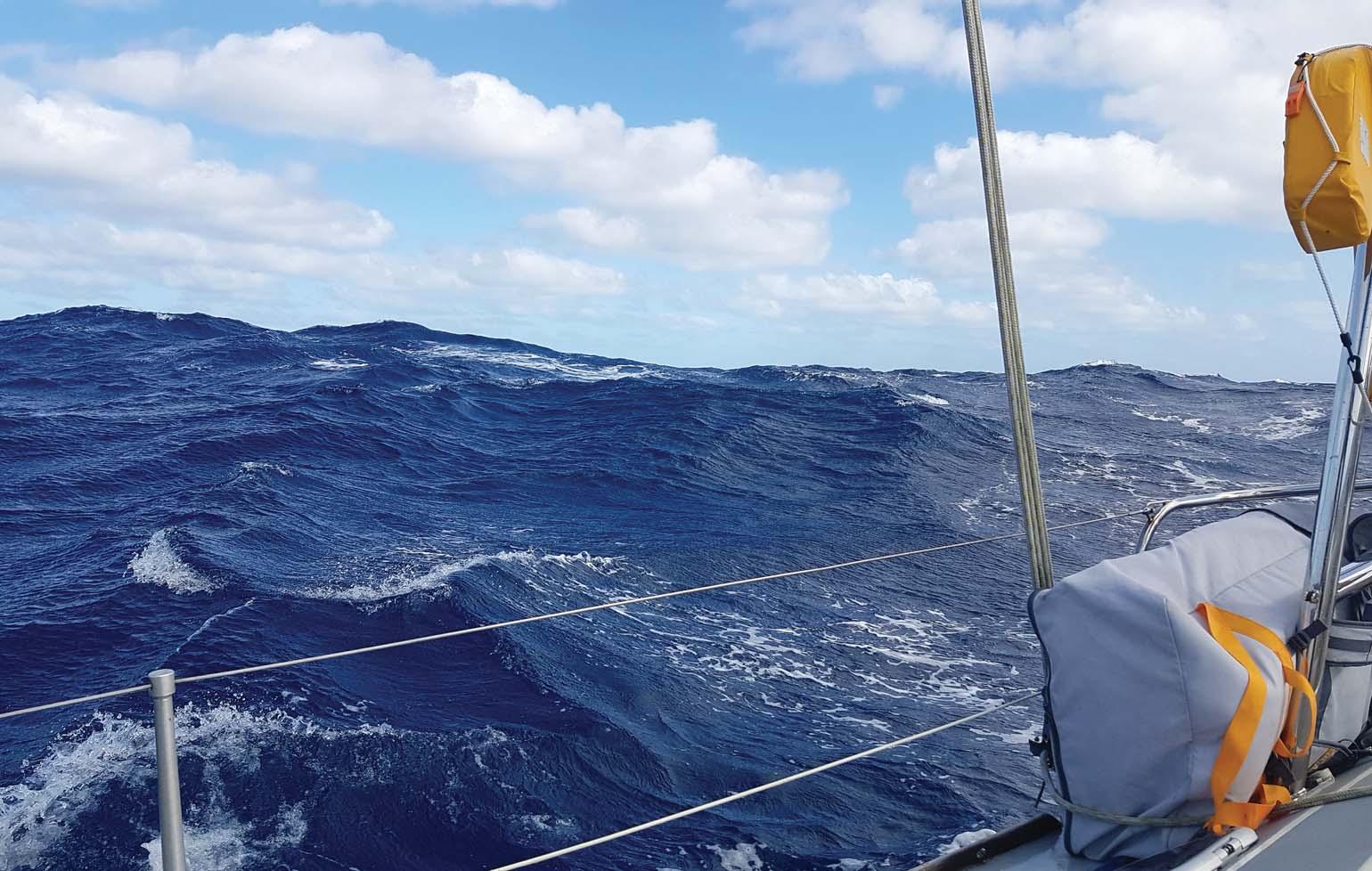
We enjoyed our time in northern Spain, including the anchorage off Muxia where they were having some sort of festival which included local bagpipes! Then again round the corner of Cape Finisterre to the rías – Porto do Son on the Ría de Muros y Noya and the Isla Ons at the mouth of the Ría de Pontevedra and the Islas Cies off the Ría de Vigo. There we anchored off the Praia de Barra, well-protected from the north wind, only to discover that it was ‘a popular nudist beach’ which was a bit of a shock! Finally we reached Baiona.
The yacht club there was welcoming but we were bemused not to be able to have a drink or a meal in the clubhouse, for whatever reason. So, we ate elsewhere and inspected the small and rather ungainly replica of the Pinta – Baiona was Columbus’s first port of call
 Passing the Tower of Hercules on the approach to A Coruña
Seas building in Biscay
Passing the Tower of Hercules on the approach to A Coruña
Seas building in Biscay
Enjoying lunch in the sun at Ares, a pleasant contrast to Biscay

in mainland Europe on his return in 1493 from ‘discovering’ America. I also had the privilege of meeting Alberto Lagos who, with his father Alfredo, has done so much over the years to look after members visiting the area.
When author Philip Marsden started sailing, he was advised, ‘Choose your weather: the patient sailor always has fair winds’. Our skipper may have had many virtues but patience was not among them! We put out into strong winds and two reefs soon became three. “Why are we here?” “It said only up to 22 knots” – he must have forgotten that it’s always wise to add 5 to 10 knots to GRIB file forecasts. It continued to increase. We tried heaving-to but discovered we couldn’t. We were reefed down to the fullest extent, but still had too much sail without rigging trysail and other storm sails, which we had not made ready before leaving. In the end we managed to run before with a well-rolled genoa.
 Baiona from the castle battlements
Baiona from the castle battlements
The problem was that the Westerly Typhoon is a Performance Cruiser ... comparatively light displacement, nippy and fast. By the same token, in strong winds and big seas she is skittish, frisky and bouncy. ‘One hand for the ship and one hand for yourself’ – no chance, two hands and two feet if possible to remain upright in the violent motion! At one stage we were doing 8 knots running before under bare poles, and had two difficult days before the weather finally began to relent. The boat had its revenge on me for being so rude about it, however – a violent lurch when I was reaching for a line and I was thrown across the cockpit and bruised my back badly, which further reduced my ability to winch and help. Getting old?
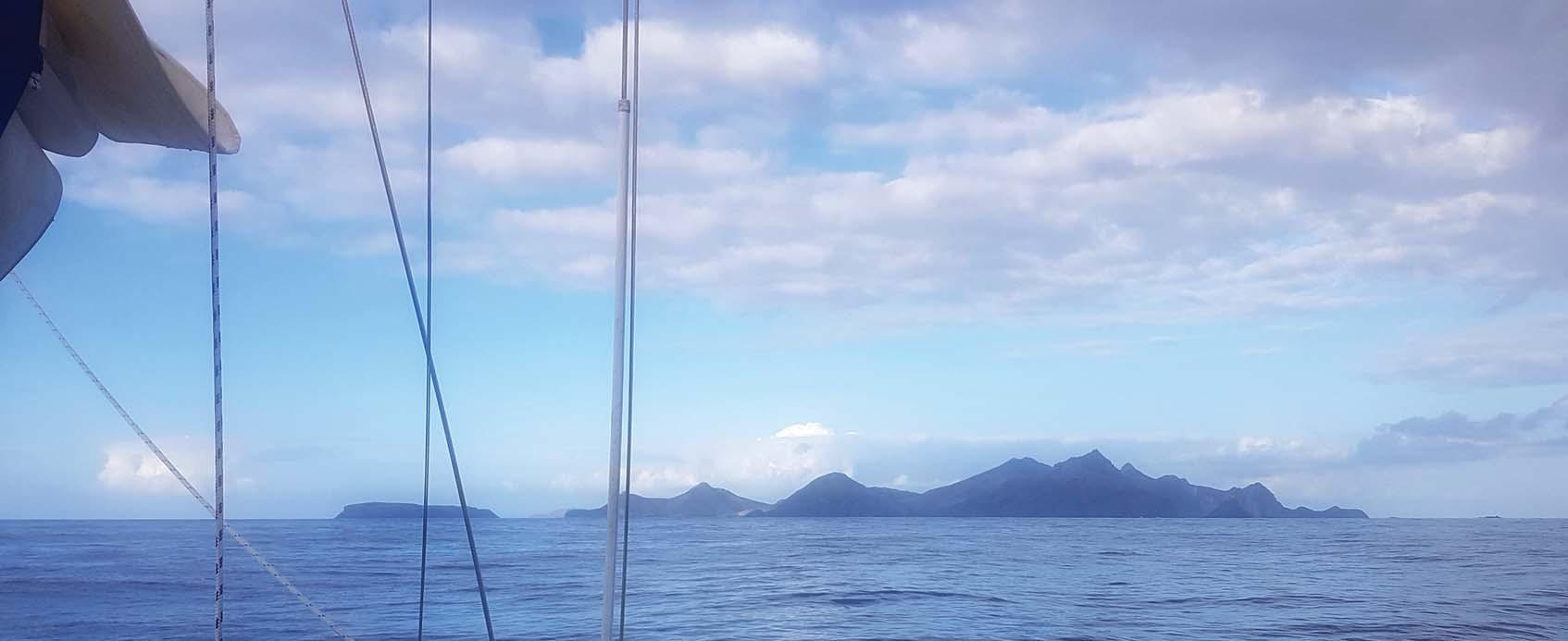
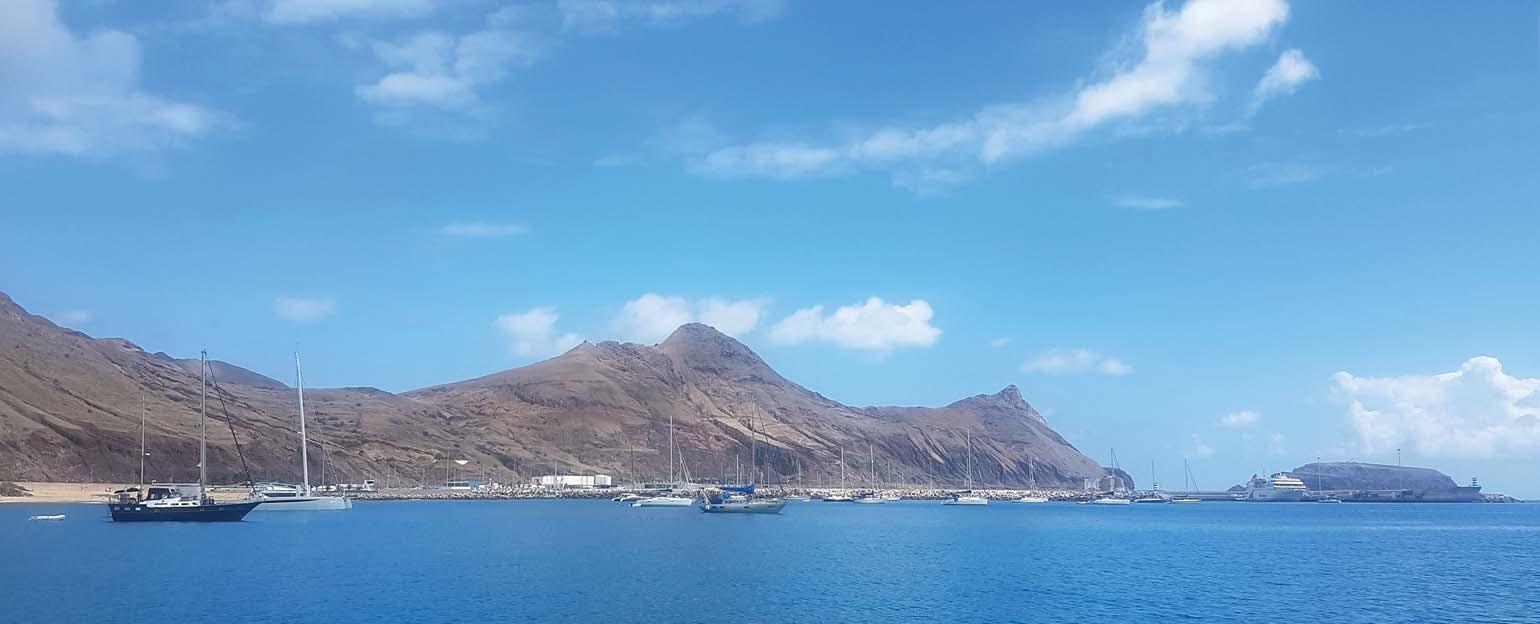
By contrast we had to motor the last miles to Porto Santo. For two days it was bliss there, with sunshine, light breeze and little swell. Then the wind went north and, though we’d moved into the harbour, we were still subject to violent gusts and williwaws coming down from the hilly slopes to the north. The boats at anchor going round and round in the gusts did not do so in unison, which was disturbing for fear of colliding.
Leonie left us to attend a course at home so the skipper and I were on our own for the last 300 miles to Tenerife. It was a reasonable passage, mainly broad-reaching, but watch on, watch off is exhausting at the end of a 2000-mile passage and the autopilot broke down on the last night. It was a relief next day to pull into Santa Cruz marina on Tenerife, where the skipper intended to spend the winter.
Porto Santo, sublime to begin with
So, a Westerly Typhoon? Fast, with high performance, and an ideal boat for cruises consisting of sailing by day and anchoring at night. But not a good boat for continuous ocean or open sea passages, though to be fair part of the trouble was that this boat had insufficient reefing lines. It was also difficult to make proper sea berths down below, and it was just too lively! I had a further short trip that summer, in a Sweden 42 on the west coast of Scotland. The weather was atrocious, with rain and winds gusting up to 30 knots, but the Sweden 42 just sailed on smoothly, serenely and sublimely, taking no notice of the awful conditions. What a contrast!
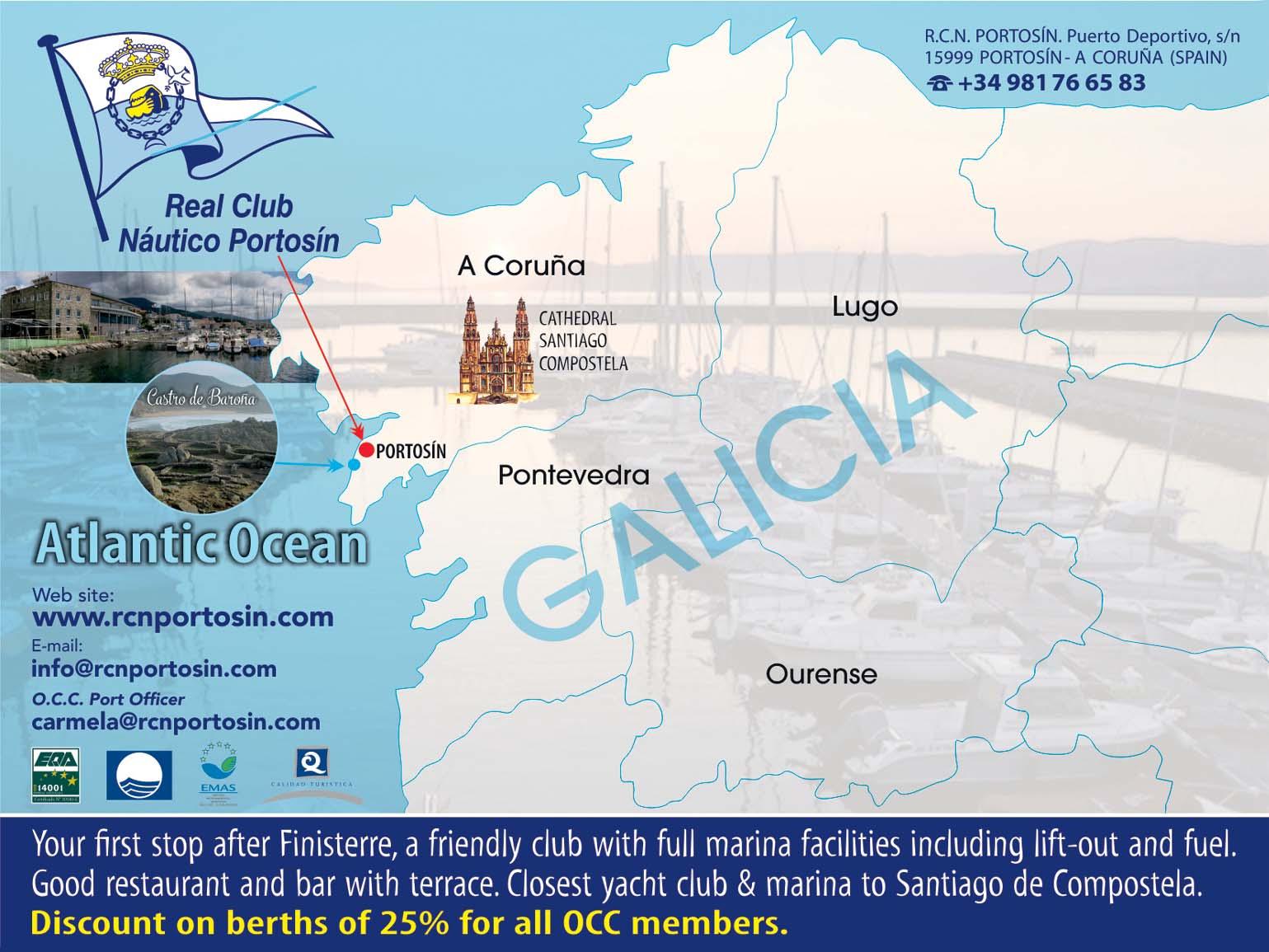


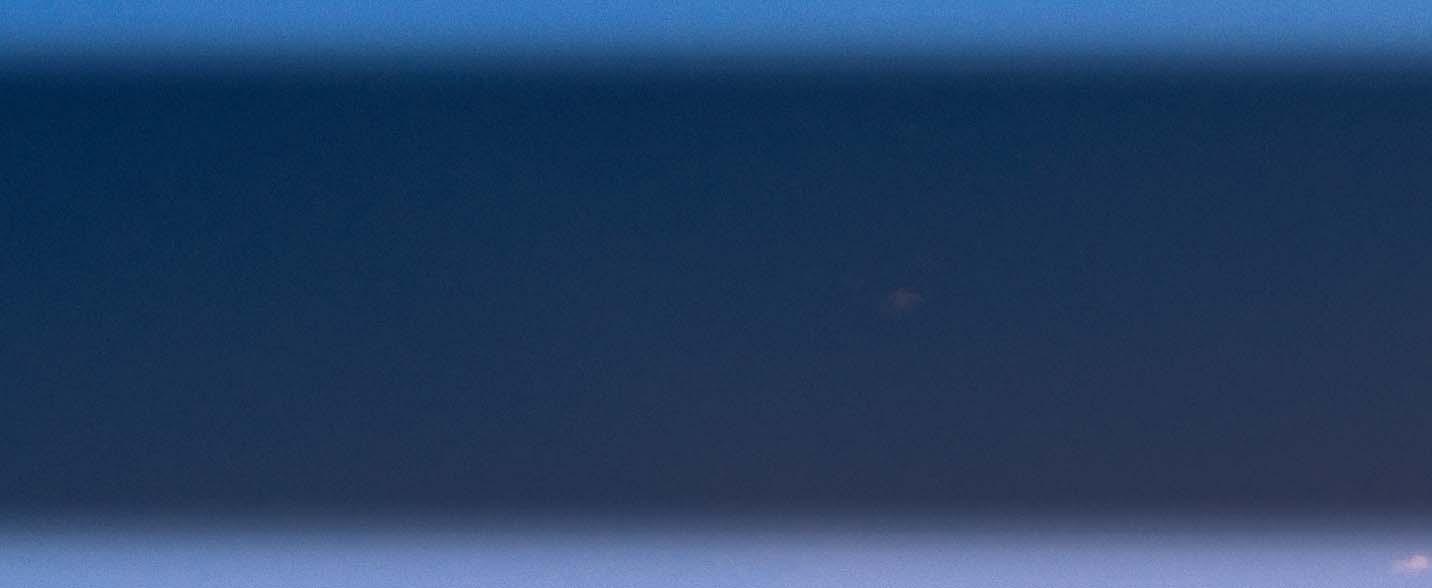


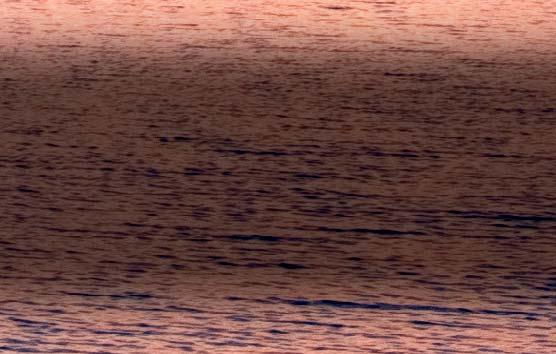











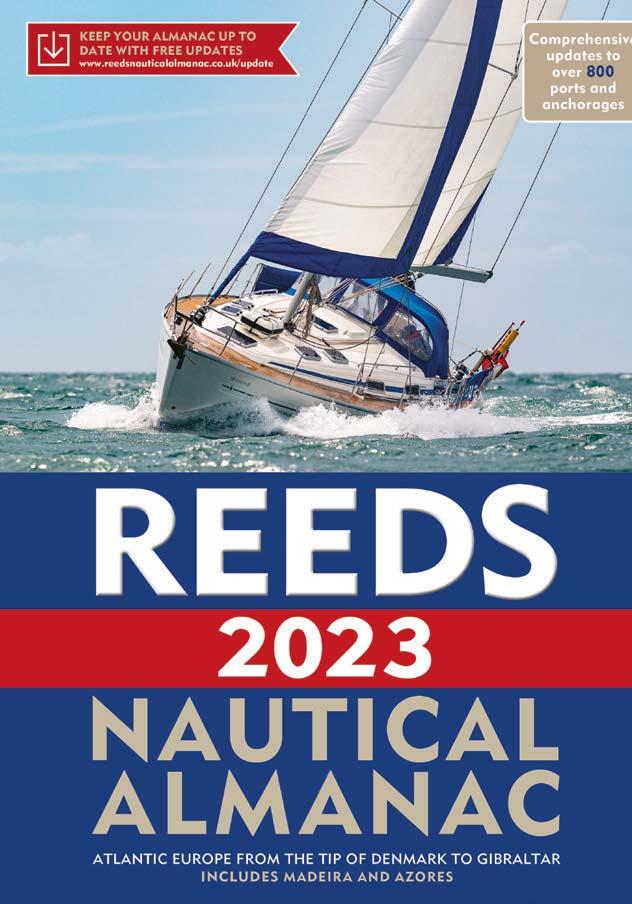




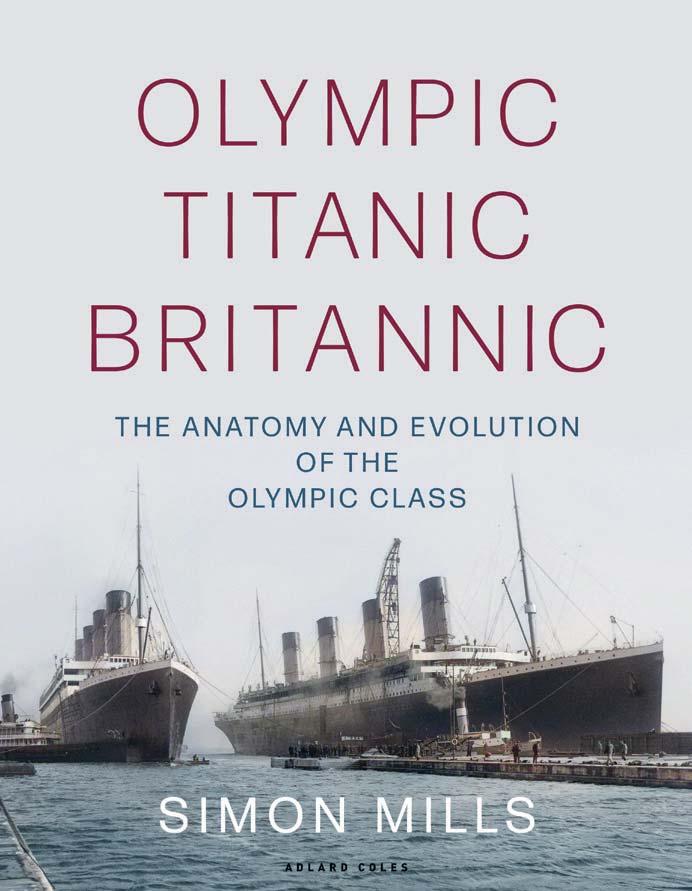












HEAVY WEATHER SAILING – Martin Thomas and Peter Bruce, 8th edition. Published in hard covers by Adlard Coles [www.bloomsbury.com] at £39.99. 320 179mm x 253mm pages, in full colour throughout with hundreds of photographs and diagrams. ISBN 978-1-4729-9260-4. Also available for Kindle.
Martin Thomas and Peter Bruce, sailing legends in their own times, have just produced the 8th edition of Heavy Weather Sailing, the book Pete Goss describes as the one you should buy for your voyage if you were to buy no other. It is a heavy, handsome, beautifully-produced volume which contains nothing, absolutely nothing, that is not worth saying. I found just one mistake, a typo which had me baffled for a moment –‘latitude’ instead of ‘altitude’ in the weather section, so clearly it had not been through the rigours of the Flying Fish proof-reading team. However, this proves that I actually did read it and in every other respect it is an immaculate production.
The original book of the same name was written and published by the late lamented Adlard Coles and though the format is similar there are significant differences. Like the original, the 8th edition is published by the firm that Adlard Coles founded, but my copy did not carry a price. Perhaps it is priceless? I own a copy of the 1967 edition, which was passed on to me by a sailing friend when I acquired my first proper boat in 1979, the year of the great Fastnet disaster. I kept it beside me while reading the new edition, but I have not read or seen editions two through seven, nor read any previous reviews of them.
The 8th edition is a hard-back, 320-pager made up of 24 chapters divided into two sections. The first section, of eight chapters, consists of specific, very graphicallydescribed storm experiences. At the end of each is a commentary by the editors who, while obviously able to be wise after the event, provide a very constructive insight into the individual experiences and the lessons to be drawn from them. The storm descriptions are difficult to put down once you have started reading them, like hard-core versions of some of the more adventurous Flying Fish articles. The victims of the first seven of these storms were remarkably resourceful, but the eighth tale is in a different league and would be a good reason not to offer this book to anyone toying with offshore sailing but yet to make up his or her mind. Just about everything goes wrong, from planning to equipping, weather forecasting, navigating and ultimate decision-making, ending with the death of a young man from hypothermia on a French Atlantic beach. It is a very sad and sobering story.
The remaining 16 chapters, which form the second section, are more like a textbook, although they draw on individual experiences in some detail and are supported by remarkable heavy weather photography. Each chapter covers a separate subject, some written by specialists in the field. I will not list them here but just say that they embrace every aspect of heavy weather sailing, starting with yacht design for heavy weather and

continuing with fascinating chapters on waves, weather systems, yacht stability and, most important, tactics for handling a yacht in severe weather. I found the part about drogues in heavy seas really informative. There is lots more as well.
Jumping back to the 1967 version, there has been such an accumulation of knowledge and experience since that time. In 1967, Francis Chichester became the first man to sail solo around the world with just one fairly lengthy stop, and his safe return home was a major event in the UK and elsewhere. He was immediately knighted by the Queen. Nobody had heard of Robin Knox-Johnston in 1967 and very few people had sailed alone across the Atlantic, or across the Atlantic at all. At that time no one could have imagined that Ellen MacArthur would circumnavigate solo in a huge trimaran, averaging 15∙9 knots and taking just 71 days, or that Vendée Globe competitors would routinely surf across the Southern Ocean on foils at breakneck speeds.

Adlard made a lot of sense in his 1967 edition, but the authors of the 8th edition have so much more material and experience to draw on. Heading out into blue water, I would go with Pete Goss and buy this excellent book in preference to any other.
WELL IT SEEMED LIKE A GOOD IDEA – Hugh Pilsworth. Published in soft covers by the author [blueflyer4905@yahoo.ie] at £11.34 / AU$ 29.86. 156 229mm x 152mm pages, with 35 coloured photographs. ISBN 978-0-6468-4242-4
Hugh Pilsworth was awarded the OCC’s Australian Trophy for 2017 for his circumnavigation in his yacht Blue Flyer and this is the story of that voyage.
Back in 2004 Hugh and his late wife Val looked for a yacht costing around AU $50,000 which they could sail from Dublin to Melbourne where their daughter lives. The Jeanneau Sun Odyssey 49 – which has a forward cabin and two aft cabins with showers and heads – suited them ideally for the passage to Australia via Panama. After Val sadly passed away in 2015 from motor neurone disease, Hugh decided to sail around the world as an escape from his loss. Blue Flyer was ideal for this, as she could easily accommodate the three or four crew with whom Hugh always sailed, while her fast hull shape helped her reach ports on schedule for crew changes.
Before departure Hugh carried out various modifications, including replacing the boom with an in-boom mainsail reefing system, installing electric winches, a desalinator, a new generator and a diving compressor, replacing the fuel tank, ordering a new genoa and buying a new liferaft, an EPIRB and Iridium Go! to receive e-mails at sea. Inevitably there were a number of equipment failures en route which Hugh, an engineer, either had to fix or arrange for experts to repair. One of the most serious was the breakage of one of the intermediate stainless mast stays while on passage from Panama to the Galapagos. Fortunately Hugh had two experienced crew aboard who made temporary repairs and on arrival in Tahiti nine items of rigging were replaced. Also replaced in Tahiti was the generator, essential for battery charging to power Otto the autopilot, the radio and the electric winches, as well as the GPS and other navigation instruments. Of course the weather was not always in their favour and a fair
amount of motor-sailing had to be done to reach each crew-change port. Hugh was full of admiration for his ever-faithful Yanmar engine which, he said, ‘never missed a beat in 12 years’. He also has high praise for the assistance he received from the OCC Port Officers and Port Officers Representatives whom he met during the voyage.
Hugh’s route took him up the east coast of Australia to Darwin and across the Indian Ocean to Cape Town, where he left Blue Flyer while he flew back to Melbourne for Christmas with his daughter and her family. Then he crossed the South Atlantic to Brazil, sailed north to the Caribbean and passed through the Panama Canal, where he left Blue Flyer on the Pacific side while he flew to Dublin to celebrate Val’s life with family and friends. From Panama he crossed the Pacific via Tahiti, Fiji and New Caledonia, re-entering Australia at Coffs Harbour north of Sydney, which he also visited before returning home to Melbourne. Blue Flyer was sold in Melbourne following the end of the circumnavigation and Hugh has since bought a smaller Jeanneau Sun Odyssey, the 349, reducing from 49ft to just under 35ft, in which he plans a passage from Melbourne to New Caledonia in 2023.
Hugh visited a total of 30 countries and, as well as detailing the all-important entry and customs formalities for many ports, he describes where to obtain fuel and water supplies and even recommends the best coffee shops and restaurants. There are no chartlets, but his detailed descriptions of port entries and anchorages would be very helpful to anyone following his route and will repay careful study. Well it Seemed like a Good Idea will also appeal to armchair sailors and those who are now too old for such lengthy voyages, both of whom will be able to imagine the many places that Hugh visited and which he describes so graphically. It is a book well worth studying for its useful content as well as to enjoy Hugh’s writing style.
FIRST AID AT SEA – Dr Douglas Justins and Dr Colin Berry, 8th edition. Published with spiral-bound semi-rigid pages between tough card covers by Adlard Coles [www.bloomsbury.com] at £11.69. 32 252mm x 191mm pages with dozens of drawings and photographs. ISBN 978-1-4729-9406-6
This revised 8th edition of First Aid at Sea continues to be one of those really useful bits of kit. It has been updated in line with current guidelines and best practice, including guidance relating to Covid. The authors manage to avoid medical jargon while communicating essential information and directions for first aid, as well as for non-life threatening situations for which cruisers may seek guidance and reassurance.
The highly practical, water-resistant, spiral-bound format allows the book to be laid flat for easy reference. The ability to take it into the cockpit while attending to a patient is of huge benefit and the colour-coded sections make finding the correct page quick and straightforward. Each page has clear illustrations with highlighted boxes for important points. These are easy to follow, logical and clear. The emphasis is on providing effective first aid as well as guidance on when to seek further help.
I particularly liked the recommended first aid kit. It is a good starting point that can

be easily expanded upon depending on destination and crew health/existing medical conditions. It’s certainly the most asked question for any sailing medic.
Many cruisers heading offshore worry about how to cope in a medical emergency. In a few pages this book manages to cover the serious injuries which are most likely to be encountered, such as head injury, drowning and hypothermia, giving reassurance and clear guidelines to inexperienced crew. It also offers help for sudden illness, again with clear description, first aid treatment and, most importantly, when to call for medical help or evacuation. There is also a new section on diving accidents which is very basic but useful for non-divers. All sailors will find it a good aide memoire regardless of skill level.
The final section on communication, with its checklist approach, ensures vital information both on the patient and their condition is passed down the line correctly. This is so very easily forgotten in an emergency situation. As it clearly states on page 29, help and advice can only be given if there is an accurate account of the patient’s condition.
This very reasonably-priced book may only be 32 pages long but it is jam-packed with useful, clear guidance and information. A worthwhile addition to any boat’s bookshelf.

NORWAY – Judy Lomax, 4th edition. Published in hard covers by Imray Laurie Norie & Wilson [ www.imray.com ] at £57.50. 301 A4 pages, in full colour throughout, with hundreds of photographs and chartlets. ISBN 978-1-7867-9186-3
To say that Judy has ‘cracked it’ yet again would be an understatement. Reading the introductory section it is clear that, based on her long association with the country, she has a wonderful understanding of and insight into the Norwegian people, their traditions and way of life as well as of the country’s sea and landscape. This gives any prospective cruiser a genuine feel of what to expect when visiting the country. (I speak as a Norwegian by adoption, who’s sailed up, down and around most of its coastline as well as having crossed the North Sea many times in both directions.)
The information in the introduction, both technical and official, is very well considered and as up-to-date as any cruising guide can be by the time it’s published. This includes the two-year cruising period which can now be enjoyed here and which I’m happy to say that I helped push though. I’d also underline the use of credit / debit cards. As Judy states, Norway is basically a cash-free country where you can’t even get cash at a bank. I never carry cash, not even to purchase a newspaper or an ice cream, though as a visitor it might be wise to have a little cash onboard just in case. I can also confirm that mobile phones do work in the deep fjords and that 5G is almost standard in the fjords and offshore.
I know many of the harbours, anchorages and routes that Judy mentions well and can confirm that she describes them with accuracy, even giving away some of my favourite anchorages which I’d hoped to keep secret! She has missed one or two in my area, but even after living here for the past 20 years I’ve not investigated all the many anchorages nearby. Check your charts if you visit and discover your own! Of course such a guide
can only give a brief thumbnail outline of Norway’s many harbours, anchorages and marinas, many of which improved their facilities over the Covid period. At my local marina at Nørvevika (page 174), we have built a new facilities block, added wifi and raised the protective mole.

Some of the anchorages mentioned now have free mooring buoys, placed by the local Kystverket (Coastguard), who are constantly updating and improving both coastal and inshore navigational marks and facilities. In the wrong weather conditions areas such as Statt, Hustadvika etc can be dangerous, but most of the time they are not.
Norway is mostly rock. The saying is that ‘rock, unlike sand, doesn’t move’, but in Norway they like moving rock, sometimes in a big way, eg. the proposed new Stattlandet Shipping Tunnel. New causeways and bridges, such as those between Lepsøya and the mainland, will spring up across fjords and between islands almost overnight. These works are not only for the benefit of the outlying islands, but also to provide better access for large cruise ships, which in turn help the sailing visitor.*
When I’m welcomed aboard a visiting yacht they nearly always have a copy of Judy Lomax’s NORWAY on board. It’s clearly the number one ‘go-to’ for Norwegian cruising information and with this 4th edition is set to remain that way, while the quality of Imray’s production goes without saying.
* Visit www.imray.com/corrections to check for free post-publication updates to Imray cruising guides and charts, and e-mail editor@imray.com to pass useful info back up the tree. Finally, www.explorewithimray.com contains data on over 12,000 locations corresponding to those in Imray books. Membership costs £49.99 a year or £8.99 a month.
PRINCIPLES OF YACHT DESIGN – Lars Larsson, Rolf E Eliasson and Michal Orych, 5th edition. Published in hard covers by Adlard Coles / Bloomsbury [www. bloomsbury.com], at £65.00 (discounted to £54.55 on Amazon). 400 272mm x 202mm pages with drawings on almost every page. ISBN 978-1-4729-8192-9. Also available for Kindle.
This book is the bible for all yacht designers apart, perhaps, from the arrogant few who think they know it all. Such books very seldom go to three editions so this one, now in its fifth, commands our attention. To say it is comprehensive grossly underrates it. If your boat seems slow, or weather-helmy, or you are wondering if that recent grounding has caused structural problems, or you are (very rightly these days) wondering if your rudder is about to break, there are answers in this book.
Like all books which contain lots of maths and graphs, Principles of Yacht Design calls for concentration and thought from the reader. But there is so much of great value, and it is not hard to understand. We learn, for instance, that the driving force gained from the headsail is so much more effective than the effort supplied by the mainsail. Therefore, as the wind rises the clever thing is to reef the main and hang on to the full foresail ... until things get rowdier.
From the point of view of the typical OCC member, this enjoyable and well-written book does have one disadvantage – almost all the illustrations show typical modern cruiser/racers with skimpy, short, deep fin keels and titchy dagger rudders. What you and I want is a boat which will ‘track’ in a steady straight line with no one at the helm, whatever the weather. We want our boats to keep this beneficial course even in a lumpy sea. A long, ‘old-fashioned’ keel helps a great deal in this respect. It also quite often softens the blow when going aground, especially if the ballast is lead which deforms and slightly cushions the blow on impact. In practice, most of us sail fibreglass boats these days, and this book confirms that it is an extremely bad idea to go aground, even slowly, in a ‘glass’ yacht. The adjective says it all.


Yacht design is a vast subject with many aspects. These range, for instance, from the importance of ending up with a beautiful yacht to the correct size and type of anchor and its best stowage location. This book is packed with such data, good procedures, research, calculations and helpful drawings. In addition there are two pages of References, so anything not in the text is likely to be found in the publications referenced.
It helps that there are three authors, each with extensive experience. Between them these three naval architects know a vast amount about yacht design. Now we can all enjoy sharing their knowledge.
QUIRKY HISTORY – John Quirk. Published in hard covers by Fernhurst Books [www.fernhurstbooks.com] at £17.99. 128 228mm x 186mm pages, with dozens of the author’s paintings and cartoons. ISBN 978-1-9126-2142-2
Subtitled ‘Maritime Moments Most History Books Forgot’, the 25 tales in Quirky History have only sporadic links to maritime history and almost none to sailing as we know it, but it merits inclusion here purely because your editor enjoyed it so much. Not only does John Quirk have a relaxed writing style with frequent flashes of unforced humour, but his cartoons – and occasional more serious paintings –complement the text perfectly.
Some of the stories are amusing – Camel Corps captures a U-Boat – some inspiring – The Great Lynmouth Lifeboat Rescue – some poignant – Whatever happened to Diesel? – and a few downright sad – The End Result – but all are true and all are well worth reading.
Quirky History would make a great Christmas present for almost anyone, but do give yourself time to enjoy it first!
ENGINE
– Duncan Wells and Jonathan Parker. Published in soft covers by Adlard Coles [www.bloomsbury.com] at £20.00. 160 246mm x 189mm pages with colour photos and diagrams on every page. ISBN 978-1-4729-8855-3
Like Duncan’s previous ‘Stress-Free’ titles (Stress-Free Sailing, Stress-Free Navigation etc), Stress-Free Engine Maintenance has clear text, plentiful illustrations and does exactly what it says on the tin. He and co-author Jonathan Parker, previously operations manager of Sea Start, a Solent-based get-you-home service, manage to fit a surprising level of detail into its 160 pages despite covering diesel and petrol inboards, saildrives and an impressively comprehensive section on the electrical system. It even includes QR codes linked to videos on such topics as ‘how to siphon from a can into a tank without getting a mouthful of fuel’. Useful stuff!
Accepting that many owners only get close and personal with their engines when something goes wrong, the focus is on trouble-shooting, peppered with salutary tales of the unlucky and sometimes sheer incompetent culminating in Chapter 11, Cautionary Tales.
It goes without saying that every cruising boat should carry the manufacturer’s manual for its own make and model of engine, but owners who have gaps in their knowledge or feel a little rusty could well find a copy of Stress-Free Engine Maintenance a very worthwhile investment.
SUPERYACHT CAPTAIN – Brendan O’Shannassy. Published in soft covers by Adlard Coles [www.bloomsbury.com] at £12.99 or US $18.00. 272 154mm x 234mm pages, with no illustrations of any kind other than the cover photo. ISBN 978-1-4729-9266-6. Also available for Kindle.
Subtitled ‘Life and Leadership in the World’s Most Incredible Industry’ Superyacht Captain gives a glimpse into a very different meaning of the word ‘yacht’. The superyachts that Brendan O’Shannassy captains are all over 100m and closer to small ships than to yachts as we know them.
After a childhood spent sailing dinghies on Australia’s west coast, the author joined the Royal Australian Navy followed by a spell running a maritime support business in Darwin – both excellent training for the superyacht world, which he appears to have fallen into almost by accident.
Brendan, who writes with pace and self-depreciating humour, follows by recounting various incidents, both amusing and potentially dangerous, during his 20 years in the trade, each chapter concluding with a brief ‘lessons learnt’ box. He’s somewhat hamstrung by being unable to identify the yachts in question – billionaires tend to be notoriously publicity-shy – and the book also lacks any photographs, even of the author himself.
OCC members may well enjoy this peek into a very different seagoing world, but it is owners and managers of small-to-medium sized businesses who probably stand to gain most from it. So, an interesting read, but of limited relevance to the average OCC member.


(Hatty’s route aboard Magic Dragon can be followed on the chartlet on page 38.)
I graduated from university in 2021, and was working in Austria on a ski job during my post grad gap year when an email from the OCC came through with a once-in-alifetime opportunity – a family of five was looking for an extra crew member for their Pacific Ocean crossing. I jumped at the chance and, after a couple of e-mail exchanges with Fiona Jones, Rear Commodore and co-ordinator of the OCC’s Youth Sponsorship Programme, was standing outside in the heavy snow on FaceTime to the Halling family – Jane, Rod and their three children Dorothy, eleven, and five-year-old twins Peter and Vera – who at the time were in the British Virgin Islands. We agreed on a very vague plan. I would fly out to Panama in just a couple of weeks’ time, join them for the next two to three months and fly home from somewhere in French Polynesia. The timings couldn’t have been more perfect, and I knew I would get along with this family when Jane mentioned that they carried an Optimist dinghy with them for the kids to sail (I was an Optimist coach in the UK and had sailed one between the ages of seven and fifteen).
The next couple of weeks were a mad rush, as my mum called it. I flew back to the UK for ten days of Optimist coaching over the Easter half term and then drove up to my family home in North Wales to pack before heading back to Heathrow. I had a stressful few hours at the airport as I had no return ticket and was refused check-in until I could prove that I would be leaving Panama! Luckily, Club Secretary Rachelle was on hand and rushed home from the pub to write a letter for me – I definitely owe her a few pints! I was then spot-checked at security after forgetting to put my
Jungle adventures with the Halling family

hand sanitiser in a plastic bag. This turned into a 40-minute conversation as to why I was travelling on my own through Colombia (my transfer airport) and then getting on a boat in Panama with no return ticket...

I eventually landed in Panama where, after a scenic taxi ride across what felt like the whole country, I boarded Magic Dragon, an Oyster 55. The next couple of days were spent swimming with the kids in the marina pool (a lot), exploring the nearby jungle with a guide, crocodile watching with unfortunately / maybenot-so-unfortunately no sightings and trying to survive the humidity, heat and time difference. After roping in a couple of local guys to be our extra linesmen for the Canal transit, we left Shelter Bay Marina and made our way around the corner to the Panama Canal. We picked up our first pilot and headed to the first set of locks, where we rafted up with another, smaller yacht to go through the Canal. I’d been told stories about transiting the Panama Canal, but none matched up to the experience. Those two days were awesome, exhausting, hot and stressful, but something I will never forget. Catching one of the monkey’s fists thrown by a Canal worker was definitely a highlight – even though the other linesmen were older men they didn’t catch a single one.
After transiting the Canal we needed to do what most other yachts planning to cross the Pacific do – provision – and as the Halling family intended to spend three months in French Polynesia with very limited access to fresh food, we had a LOT of provisioning to do. Luckily Jane had found a brand-new marina outside Panama City, called Ocean Reef Marina. It was so new it wasn’t even finished but it was perfect for what we needed. There were golf buggies to transport us and our endless amounts of shopping from the entrance to the boat. The pontoons turned out to be perfect for burning off the nippers’ energy on their scooters, until Peter had an unfortunate accident that led to his going in the drink. Thankfully we managed to find a couple of divers who were more than happy to retrieve it.
After what felt like weeks of provisioning – well done Jane for surviving all those shopping trips! – we were finally ready for the 1000 miles or so to the Galapagos. But first we decided to sail to one of the islands just off Panama City to check the hull. We had had a diver clean it before transiting the Canal, but thought it was worth rechecking in case we were turned away from the Galapagos and sent 100 miles into the Pacific to clean it. Although we saw it as an extra, mind-numbing job that was slowing us down, thank heavens we did check it as Jane found a whole load of crustaceans in the bow thrusters. We ended up anchoring overnight and carried on scraping in the morning before finally setting sail.
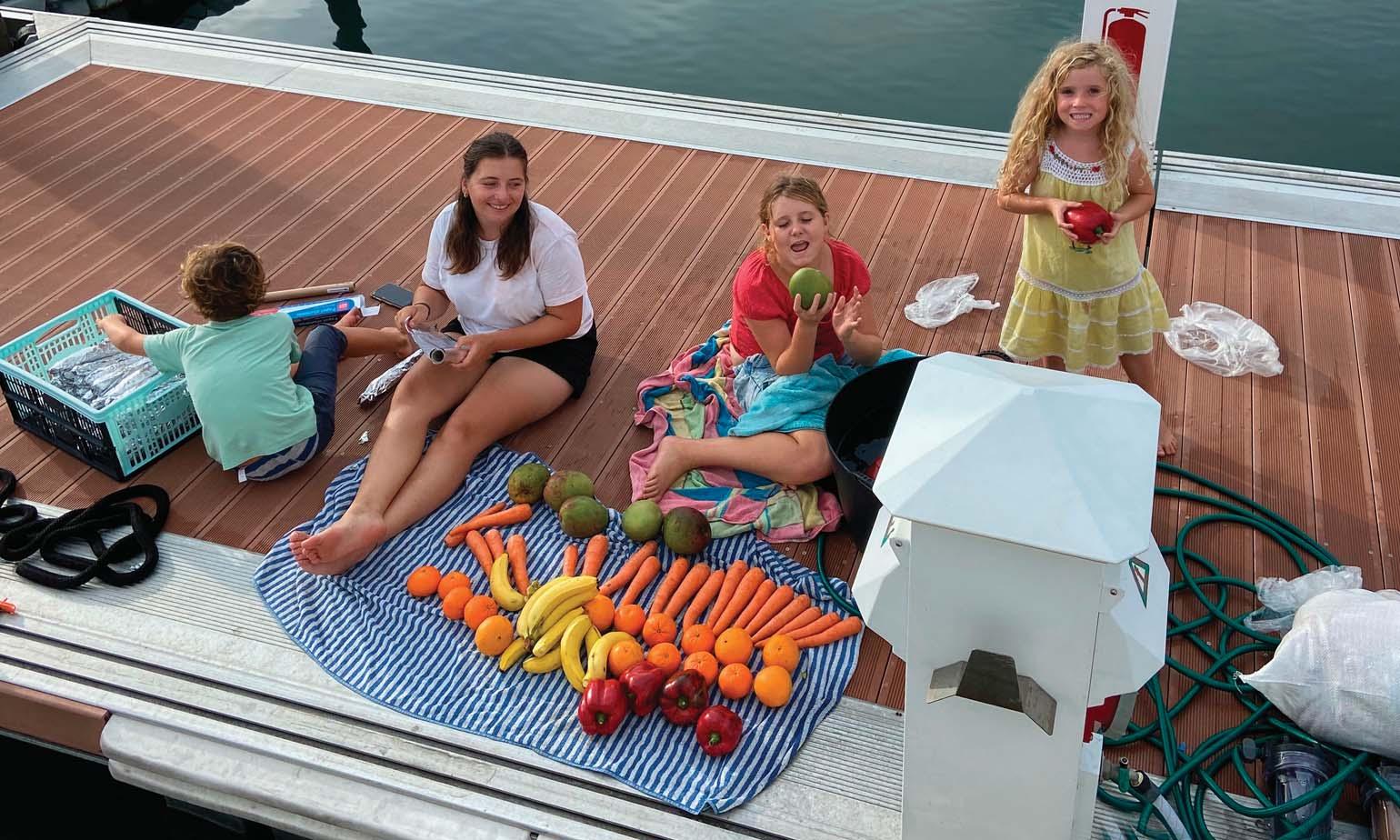
The first few days of the passage were slow and tortuous. The wind coming directly from the Galapagos meant we were beating, but with 2 knots of tide against us and less than 15 knots of wind we were making very little progress – we were heading towards Hawaii on
 Fruit cleaning with the nippers
Sunset onboard Magic Dragon
Fruit cleaning with the nippers
Sunset onboard Magic Dragon
one tack, Colombia/ Ecuador on the other. We had beautiful sunrises and sunsets, and luckily for me my watches, being 0400–0800 and 1600–2000, meant I got to witness all of them. After tacking a few more times than we should have in pursuit of more wind and less tide, we decided to stick on starboard tack and head towards the coast of Ecuador until we could tack back and hold a course for the Galapagos.
On our fifth day out disaster struck when the mainsail ripped almost its full length along the bottom panel seam. We were dumbfounded as to how it could have happened as the sails weren’t even a year old and we were over-reefed to keep the boat comfortable for the kids. We managed to furl the rest of the main, which meant we were sailing on headsail only, bows into the waves and still 2 knots of tide against us. After getting in contact with the agent in the Galapagos and friends from home, we decided that the best option was to carry on towards Ecuador where a friendly marina and sailmaker were awaiting our arrival. The wind dropped so we had to wind the headsail in and turn the engine on, giving us a few bouncy days – one night it was so bad I had to sleep in the saloon as I was being bounced off my bunk in the forecabin. Our moods were lifted by holding the obligatory Equator party. The nippers spent the morning making cards for Neptune and an outfit for Rod which strangely suited him! We eventually got to Marina de Puerto Lucia and, after a stressful few hours checking in and getting the sail ashore, we could finally stretch our legs on land in search of a welcoming G&T. We ended up spending a week waiting for the sail to be repaired before we could set sail for the Galapagos Islands ... again.
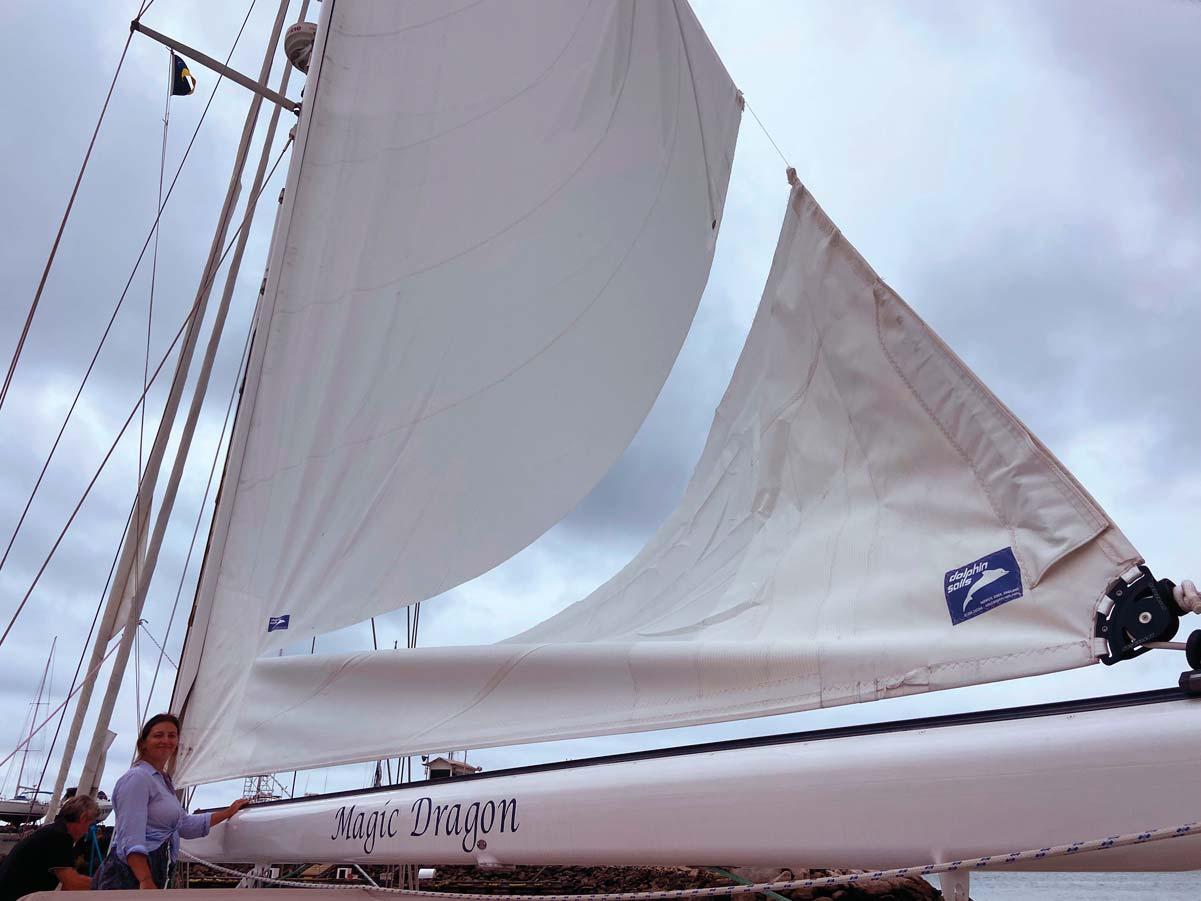
Just a small rip...
Attempt number two was much more successful. We had four easy days of sailing to reach San Cristóbal and spent the next five days exploring and relaxing on this beautiful island. Most memorable by far were the sea lions. They covered the beaches, roads, parks and pavements, and you could smell them way before you saw them. Swimming with them was a bit of a novelty – for the most part they were friendly and playful, until Jane and I got caught out with one of the males who decided my backside looked tasty enough to nibble on. We also discovered the incredible local food, with family-run restaurants serving a delicious set menu, changed daily, for just a few dollars.
Baby giant tortoises

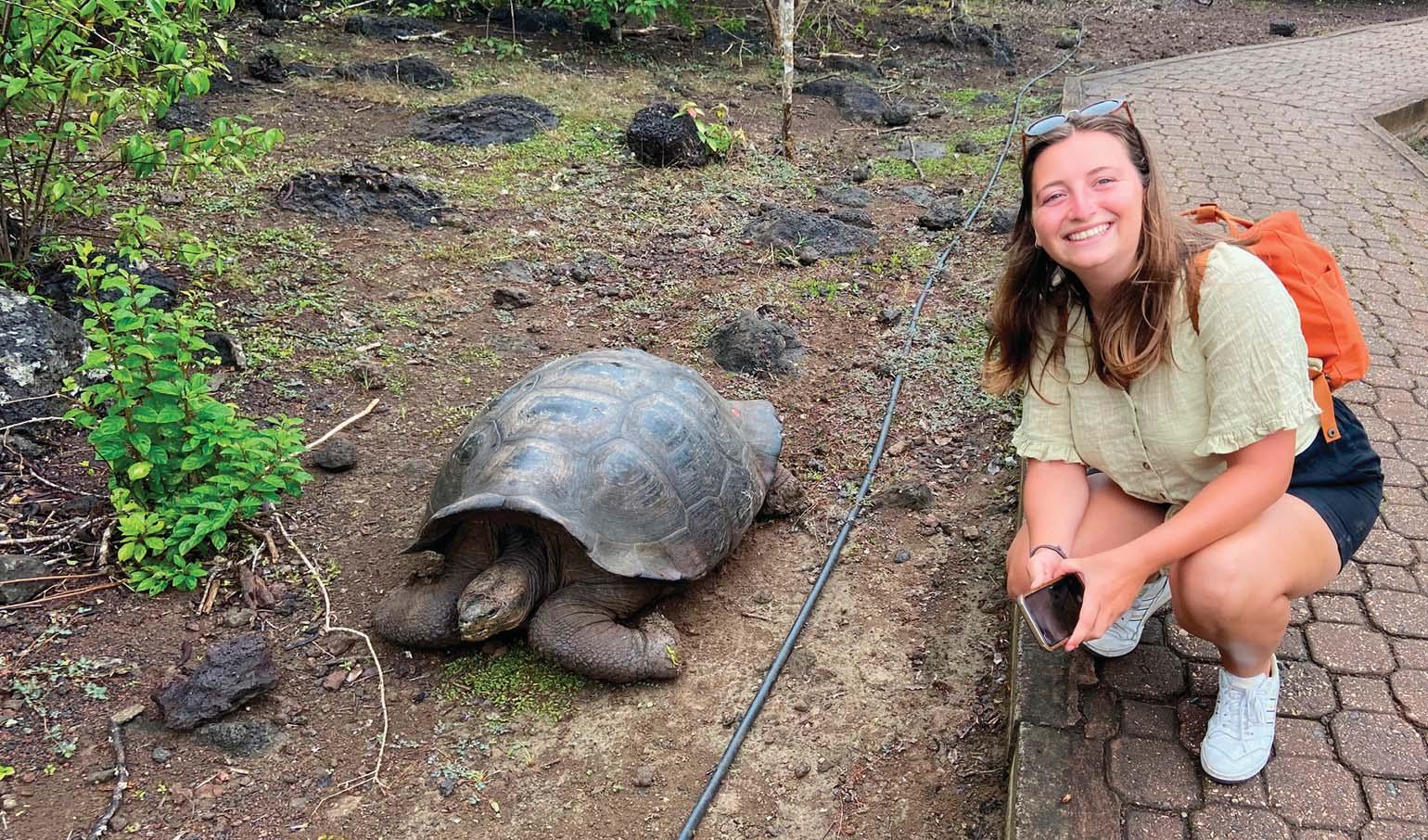
After relaxing for a couple of days on the local beaches we decided to take a taxi to the far side of the island to a giant tortoise sanctuary. We weren’t expecting to see many, but as soon as we walked in we came across the largest tortoise I have ever seen sitting right next to the entrance. We spent the next couple of hours walking around the sanctuary, spotting tortoises and climbing around the ones blocking the path. The sanctuary had a baby tortoise centre which the kids absolutely loved (so did the adults).
Next we moved on to Santa Cruz, which we all agreed was a bit of a disappointment. It was full of tourists and shops, and the anchorage was very rolly. We spent three nights there, which gave us enough time to do a bit of provisioning and some sightseeing, but I was definitely sleep-deprived by the time we left.
Anchorage buddies on Isla Isabela
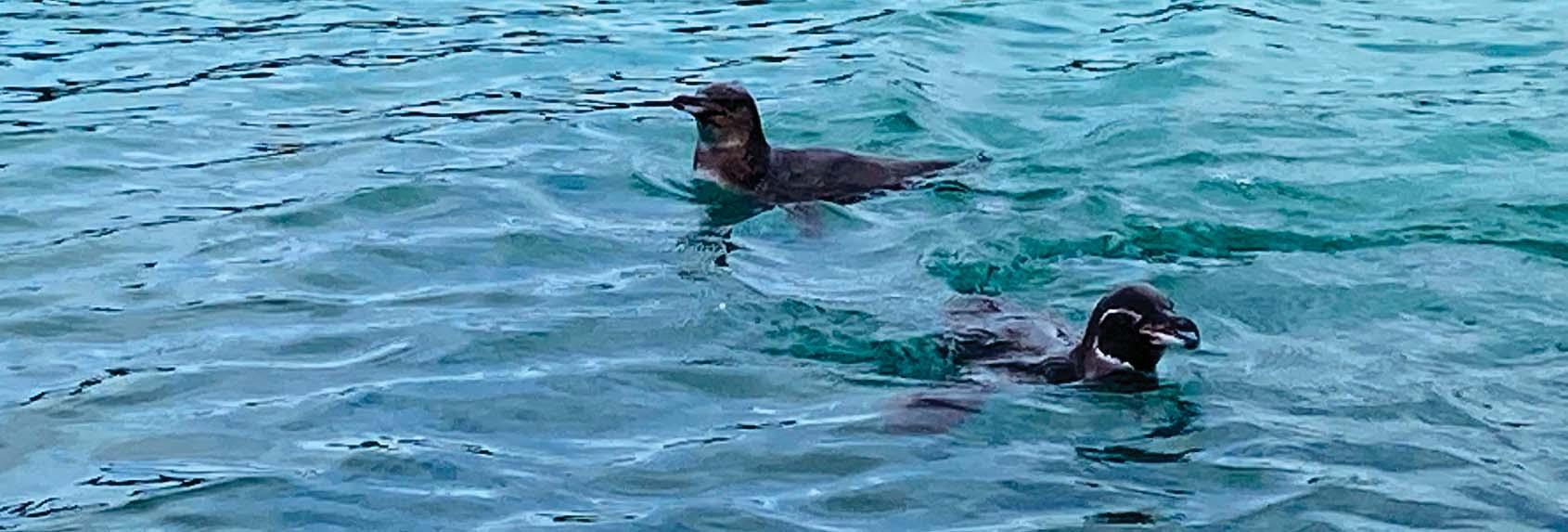
Our final island in the Galapagos archipelago was Isabela, where the saying ‘save the best till last’ definitely rang true. It felt like paradise. The anchorage was flat, quiet and, most importantly, we could see colonies of penguins from the boat. We ate delicious local food every day, chilled on the beach, had scooter races and met an awesome woman called Claudia who turned out to be a local guide who owned a pink beach bar and took us on a most incredible experience riding horses up one of the volcanoes.
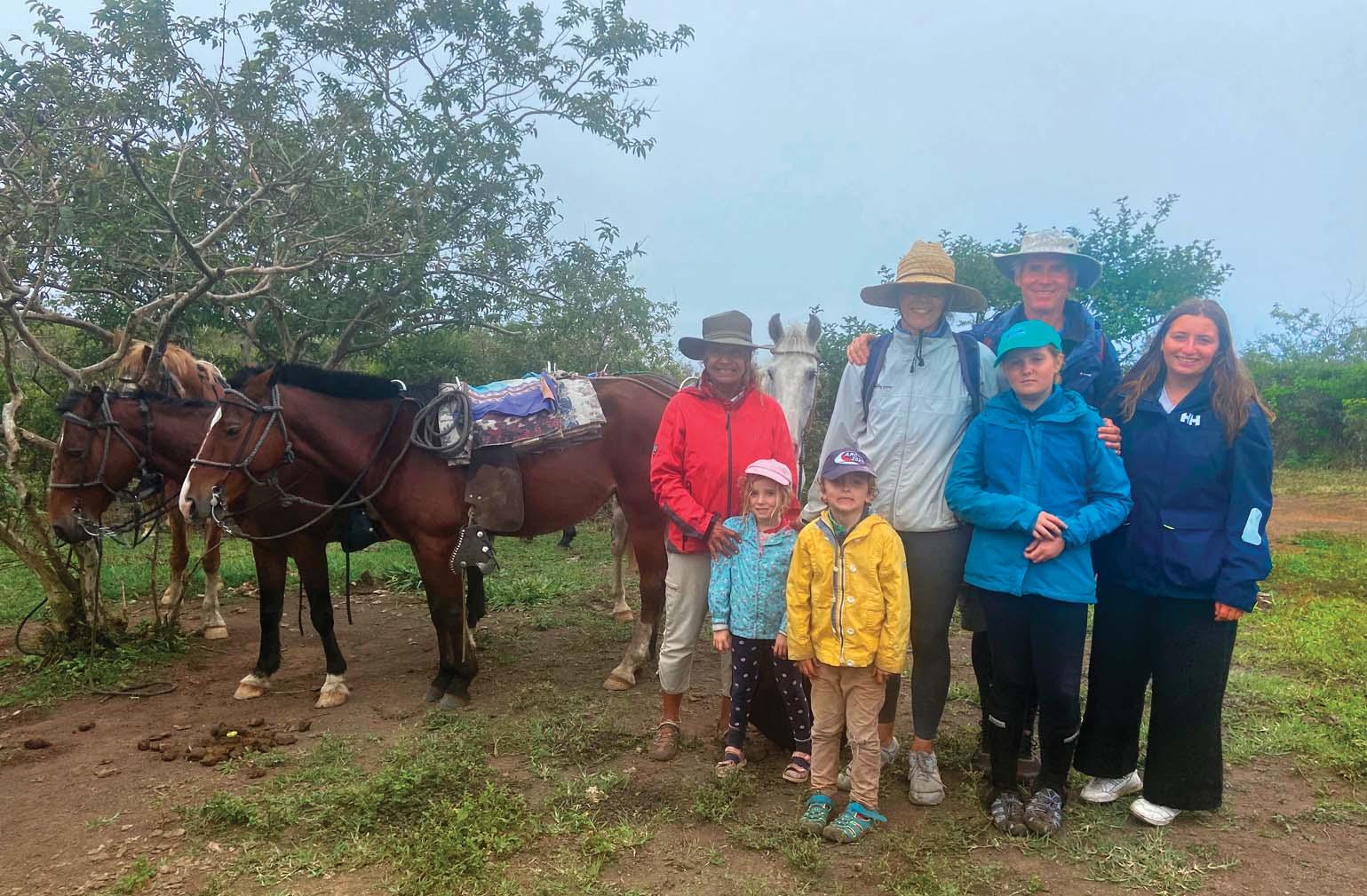
In the anchorage we met another family aboard a Discovery 55 and a couple in another Oyster 55. It seemed that we’d be setting off on the same day to cross the Pacific, though they planned to leave from Santa Cruz. It was clearly going to be a race! We spent an evening together drinking beer and discussing route options – the crew of the other Oyster 55 were planning to go north, as they had been told about favourable currents, whilst the family in the Discovery 55 were planning to sail the rhumb line as we were. After spending six days on Isabela – not long enough! – we weighed anchor at about 1000 after stowing the boat and taking a quick dive to retrieve the stern light which we had dropped the night before (sadly it didn’t survive).
Once out of the anchorage we set the sails and headed west towards French Polynesia. Turning the AIS on we could see that Salty Finch (the Discovery) was about 15 miles ahead of us while Ostrika (the other Oyster) was about 80 miles behind by the time they set off. After the first 24 hours the distances remained the same. That evening, as I was finishing my first day watch of the passage, Jane and I sat in the cockpit with hot chocolate watching a bright orange moon rising. My first night watch of the passage was a dream – I have never seen stars so bright. I sat at the back of the cockpit for hours, making out constellations and gazing at the Milky Way. The stars were so bright and clear that I could actually see them twinkling. Next day we had an afternoon treat of a huge pod of dolphins that spent half an hour diving under the boat, jumping and surfing the bow and stern waves.

At about 1800 on day four (halfway through my day watch), the nippers were down below watching a film and I was sitting on the cockpit steps watching the film and keeping an eye on things. As the light started to fade, the horizon suddenly illuminated with what looked like alien spaceships. We counted at least 25 lights surrounding us in a semicircle – it was one of the most bizarre sights I have ever seen. Luckily, before leaving, we had read about a Chinese fishing fleet of up to 500 boats that fish in the Pacific each year, so once we figured out it was them, and they started popping up on AIS and we could see their Chinese names, we weren’t too freaked out and all relaxed a bit. We saw them for another few days until they eventually vanished.
We got into a steady routine – either pancakes or cereal for breakfast, then Jane would take over the watch and either do some school work or an activity with the kids until it was Rod’s watch. I would take over as the 4pm film went on, with dinner halfway through, followed by some quiet time after the kids went to bed. This routine carried on for a week or so until my surprise half-birthday party. The kids had spent the morning making cards whilst I was sleeping and Jane baked brownies. After poling out the headsail everyone suddenly started singing Happy Birthday ... as I got the sinking feeling that I had forgotten someone’s big day! It took me the whole song to realise they were singing to me. I’ve never had a half-birthday before, but it’s definitely going to become an annual celebration! A couple of days later was the official halfway party with cake, games, dance-offs and endless
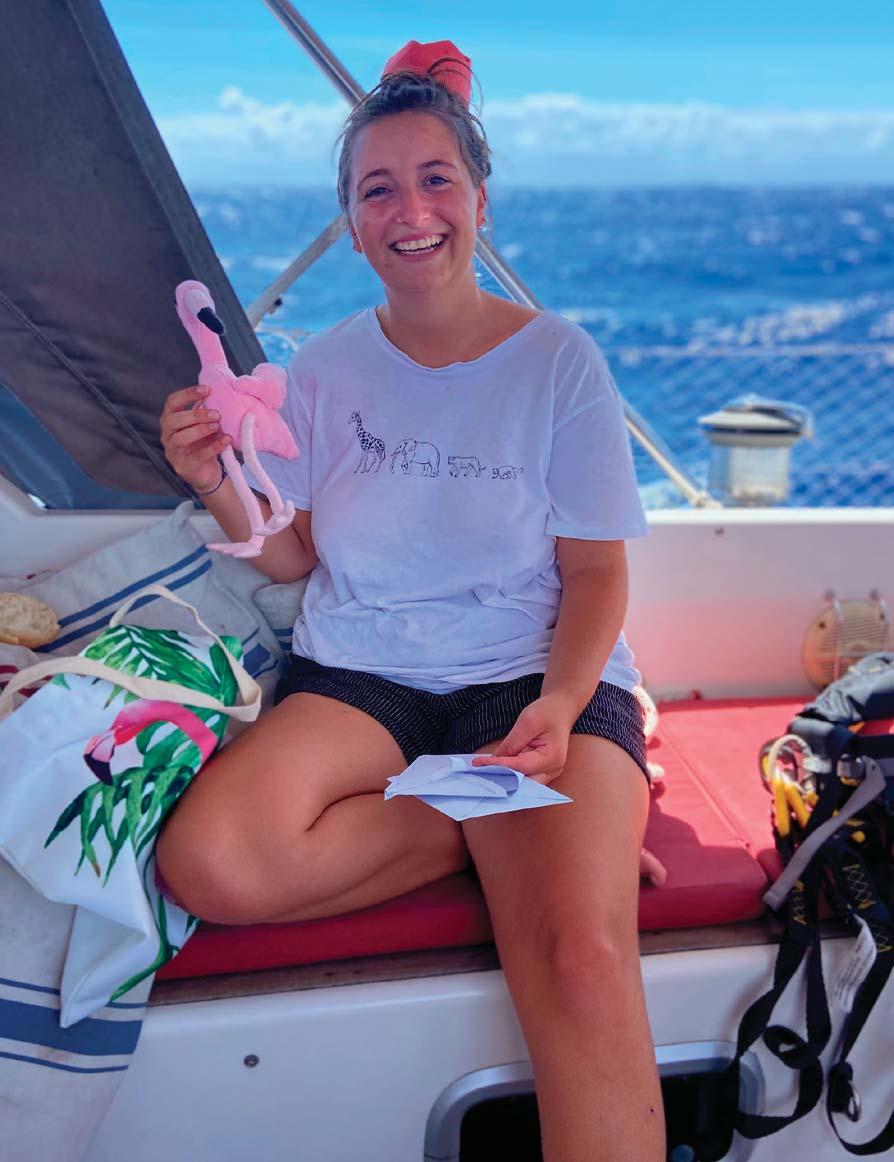
amounts of fun. It was the motivation we all needed (other than e-mails from home) to remind us that we were nearing the finish line.
After 16 days at sea we finally reached Hiva Oa in the Marquesas. I don’t think I’ve ever been in such a tight anchorage, but we managed to squeeze in and, with a bit of wriggling, to tie our stern onto a ship’s buoy to which eight other yachts were already secured. We cracked open a beer (soft cans for the nippers) and celebrated our arrival as we waited for the others to arrive. I was able to spend five days with the family exploring Hiva Oa before hopping on a flight to Tahiti for a couple of days and then flying to Paris to catch up with my boyfriend Harri before we eventually flew home together.
I can’t express my gratitude enough to the Halling family for adopting me for those few months. I had the most incredible time sailing and living with them, and cannot wait to catch up with them at some point in the next couple of years. I’ve always dreamt of someday owning my own boat and sailing around the world, so seeing them do it as a family and how much fun they have has made me want it so much more.
I would also like to thank the Ocean Cruising Club for helping provide these incredible opportunities to young adventurers and sailors like me and, in particular, Fi Jones, who deserves a huge shout out for setting me up with this awesome adventure.
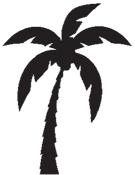
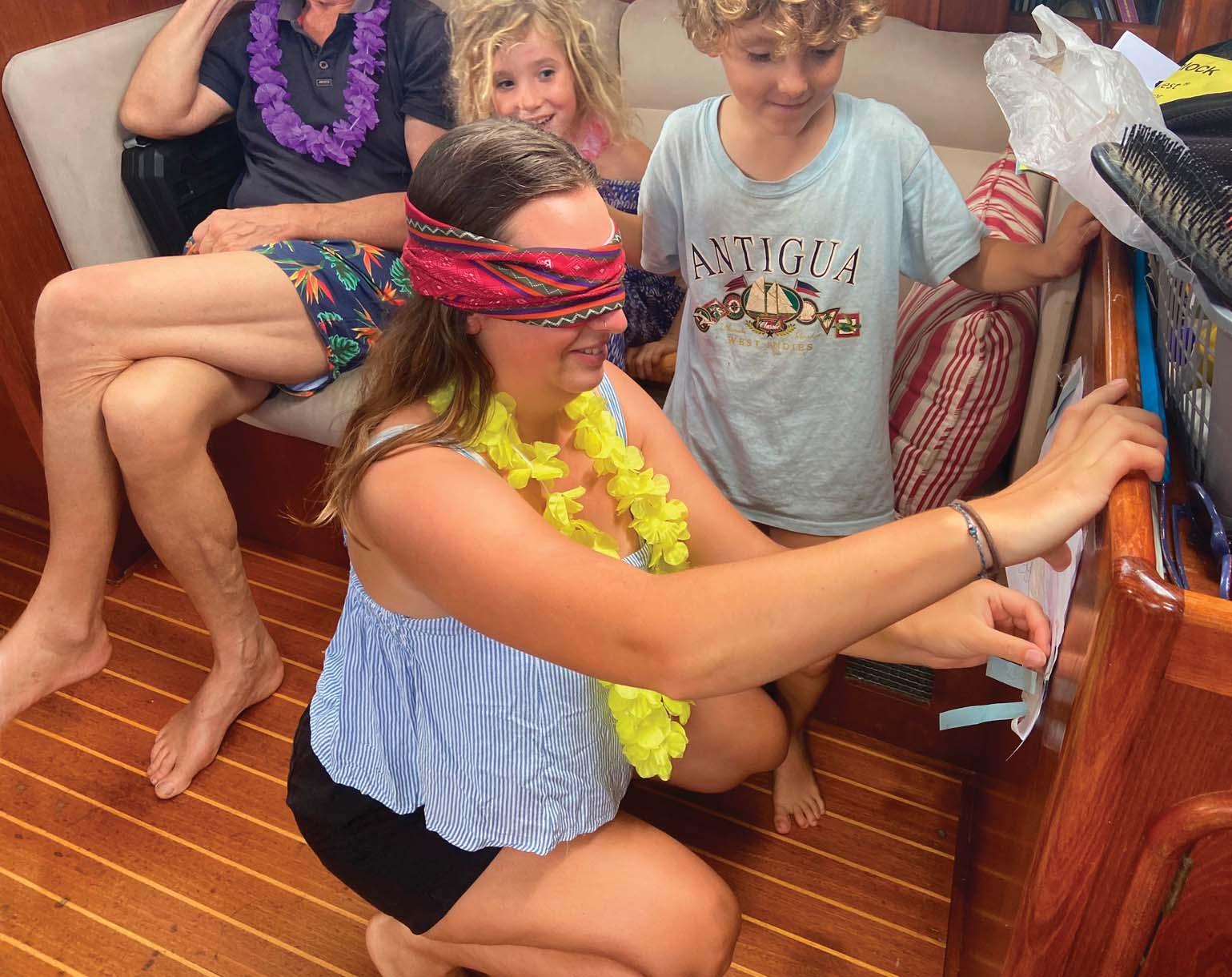

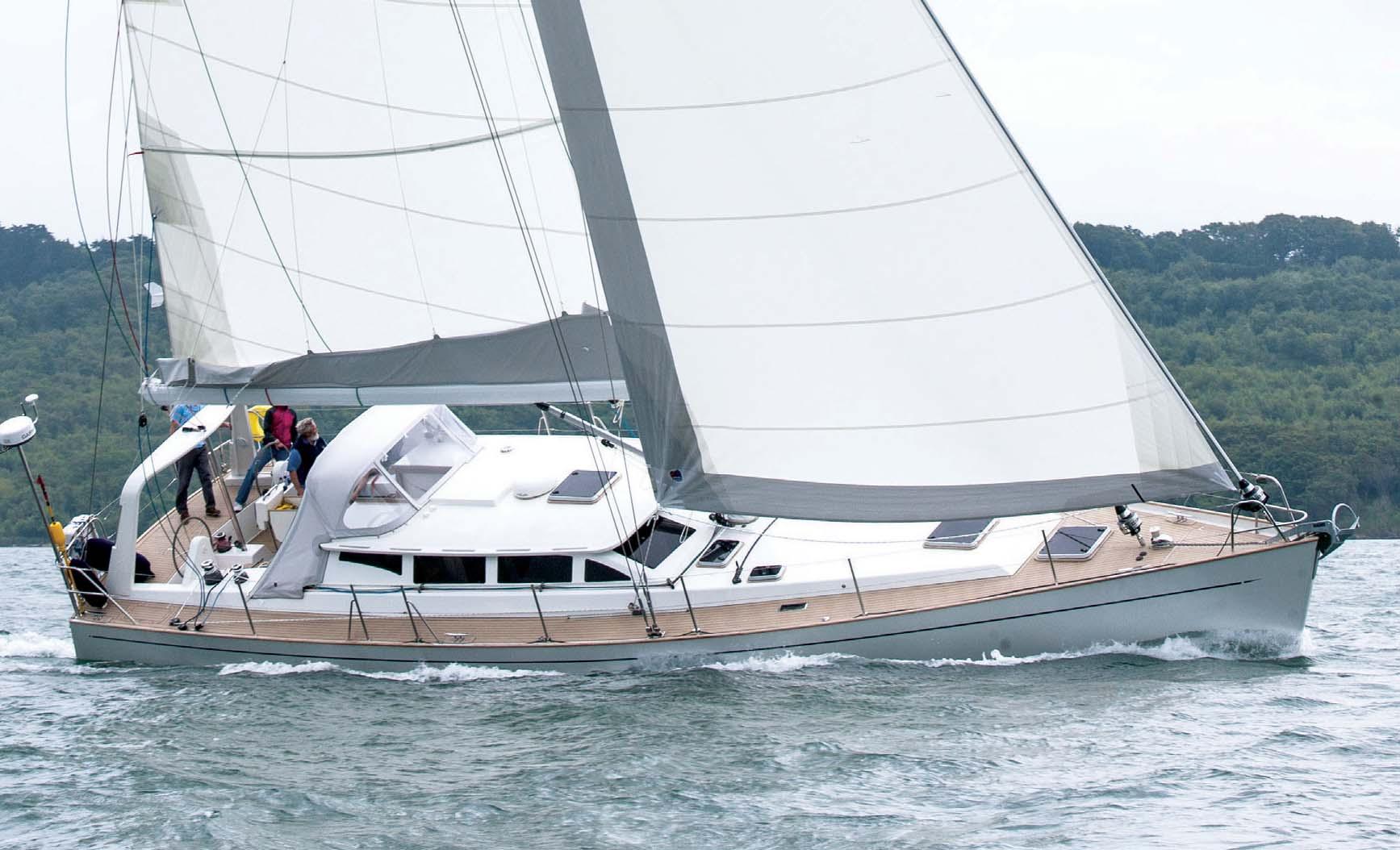




(Kurt and Carol both hail from the South Shore of Boston, Mass. Carol has sailed all her life, taught sailing and was a member of her university women’s team. They met on the water when her brother invited non-sailor Kurt along on a 4th of July sailing charter, and they were married three years later. Professional careers followed, as well as two sons raised in the Maryland suburbs of Washington, DC.
In 2013 they purchased IceBear, a 2001-built Morris Ocean Series 48 sloop, and five years later fulfilled a long-held dream by joining the World ARC. However, on reaching Fiji six months later they decided the trip was going way too fast, plus it didn’t take in New Zealand, so they dropped out of the 2018 ARC and, with five other ARC boats, headed to New Zealand.
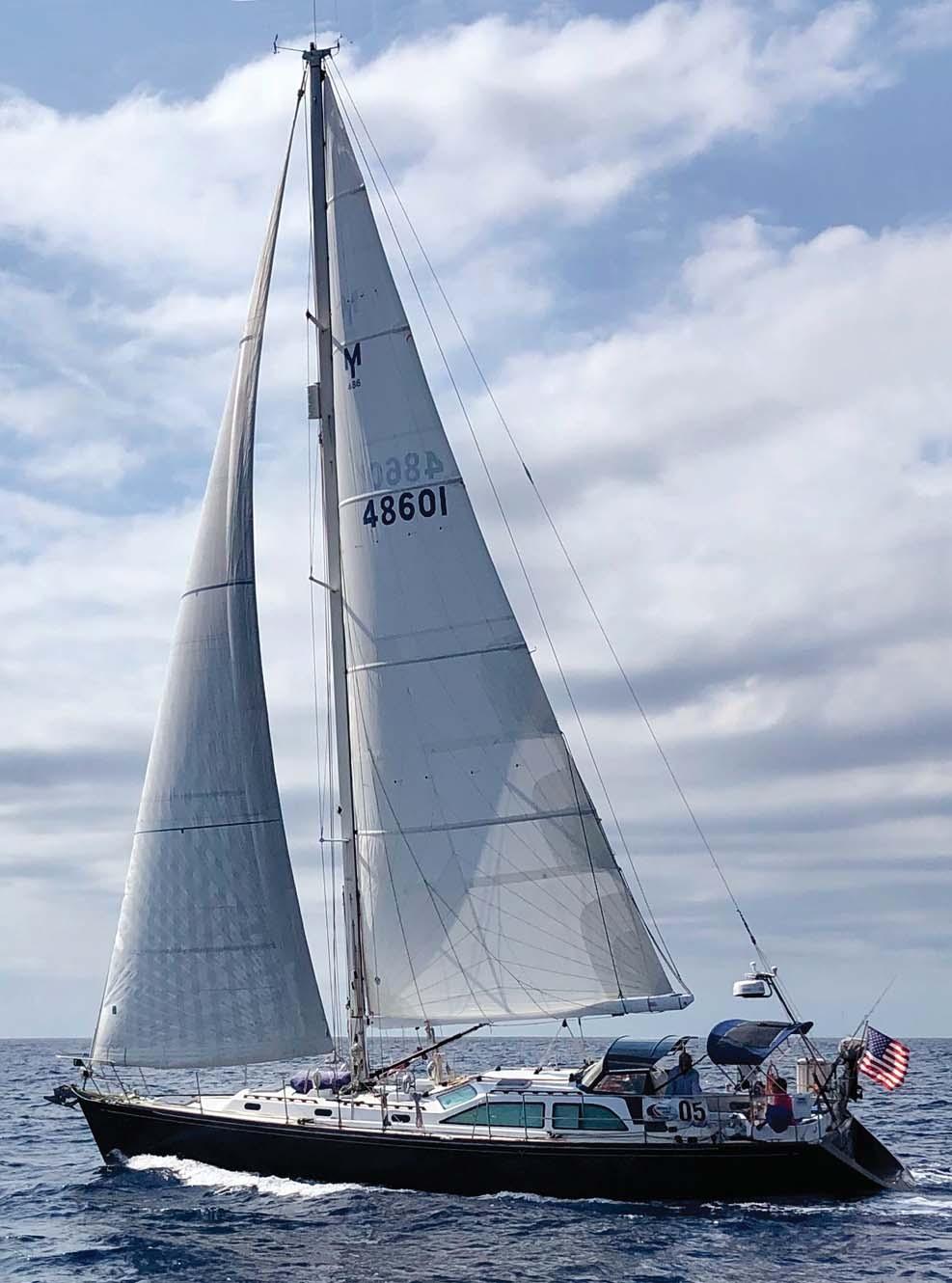
A year later they returned to Fiji to join the 2019 World ARC, continuing with the fleet to South Africa. After replacing the standing rigging and steering system in Cape Town they had fallen behind the ARC fleet, and as Covid was closing ports all the way back to the United States they decided to leave IceBear in Cape Town and hide from the virus in rural Downeast Maine for what they thought would be eight months but turned out to be twenty.)
“Hey Carol, do you want to fly to Cape Town and bring IceBear back home to Cutler?”
I asked. “Sure, let’s go!” was her immediate response. Although South Africa had just disclosed the new Omicron Coronavirus variant, Carol (whose career had been in medicine) had researched the new variant and determined that it was the natural devolved progression from a very deadly virus to a more contagious but less virulent strain. Besides, we were both vaccinated and boosted, happy to wear masks and ready to go.

We flew non-stop from Newark to Cape Town, leaving on 1st December 2021. Before the plane touched down in Cape Town the pilot notified us that once on the tarmac we would be taxiing under an arc of water from fire trucks to celebrate the first direct flight from the US to arrive in Cape Town since Covid had shut the country down in late March the previous year – no, the plane was not on fire! Coincidentally, on 23rd March 2020 we had been on the last direct flight out of Cape Town to Newark.
During the 20 months we were back in the United States Joshio Fisher, the general manager of the Victoria & Alfred Marina in Cape Town, had kept an eye on IceBear, had her cleaned, and every five or six weeks had checked the battery and bilge and run the engine and genset. When we laid eyes on her again in the marina we were delighted that she had been so well maintained during our Covid exile in the US.

We expected to spend the month of December checking out the systems, conducting sea trials and provisioning our beloved IceBear for the trip back to Cutler. We had also contacted a South African, a friend of a good friend, to join us for the voyage from Cape Town as far as Bermuda. The wait for him to obtain a United States visa would be at least 6 to 9 months, so Bermuda would be as far as he could go. We were planning to break our 7566 mile passage with a stop at Walvis Bay, Namibia, then island hop the rest of the way home via Saint Helena, Ascension Island, the Fernando de Noronha archipelago off Brazil, Antigua – which would close our circumnavigation loop – and then north to Bermuda and finally directly north to Cutler, Maine. This would take three to four months in total, with around two months at sea.
As always happens, there were some complications. During our rig inspection we noticed a small crack in the carbon fibre mast near the first spreader. We had replaced the entire standing rigging in Cape Town back in January 2020 and had had the superficial crack repaired then, so we were surprised to see it had returned. We decided it was time to investigate further, so the mast came off and went to the Fused Composites workshop in Cape Town for a thorough ultrasound inspection. This
V&A Marina reunion after 20 months
found that the thru-mast aluminium support for the first spreader was loose, allowing the starboard spreader to twist, which had caused the compression crack in the aft starboard corner of the mast. The Fused Composite people spoke with GMT Composites in Bristol, Rhode Island, manufacturer of the twenty-yearold mast, and they agreed a solution that would make the mast as good as new – and it did, but it took a couple of months. We eventually departed Cape Town on 2nd March 2022, the day our visas ran out!
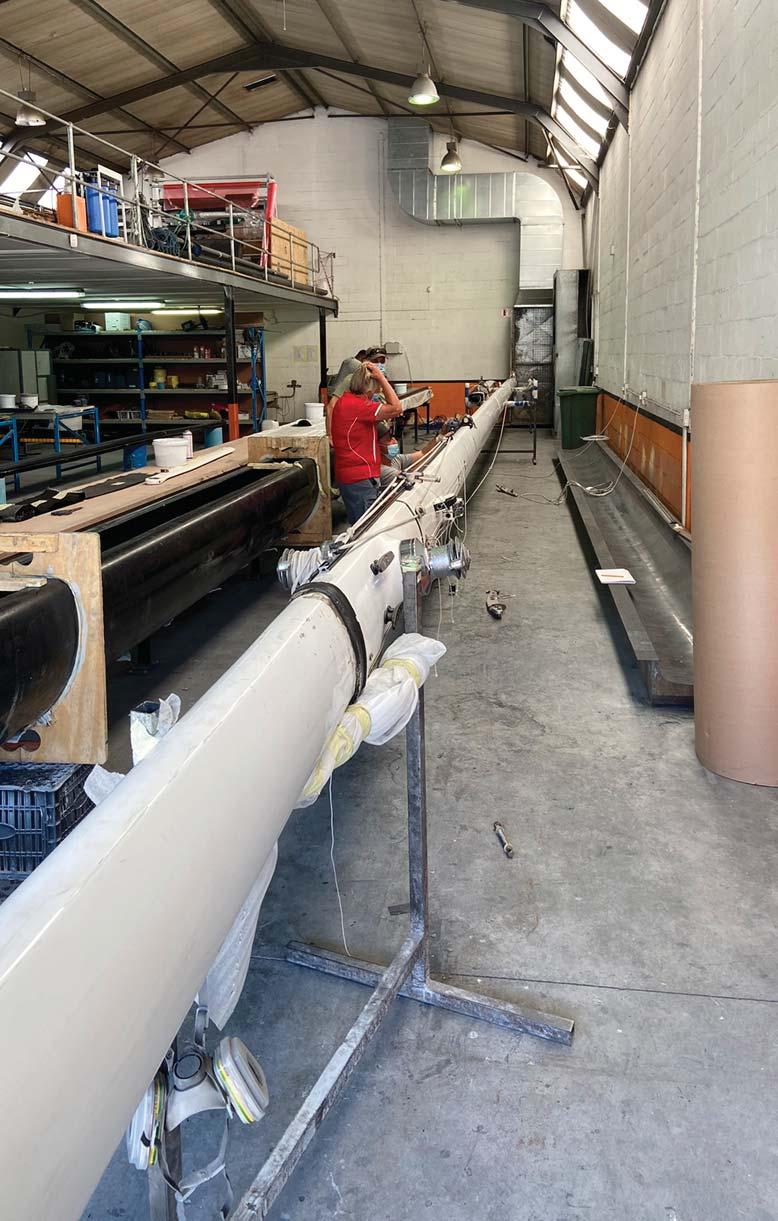
The 700 miles to Walvis Bay saw mainly 15–20 knot winds from directly astern and we sailed the majority of that
Sossusvlei’s Dune 45, 80m high and composed of fivemillion-year-old sand, is so called because it lies 45km beyond Sesriem on the road to Sossusvlei

were looking for a mooring and he looked up at us and shouted, “This is yours!”. His name was Gary Booth and, as luck would have it, he was a tour operator and very knowledgeable about the Namibian desert and especially its majestic dunes in Sossusvlei.
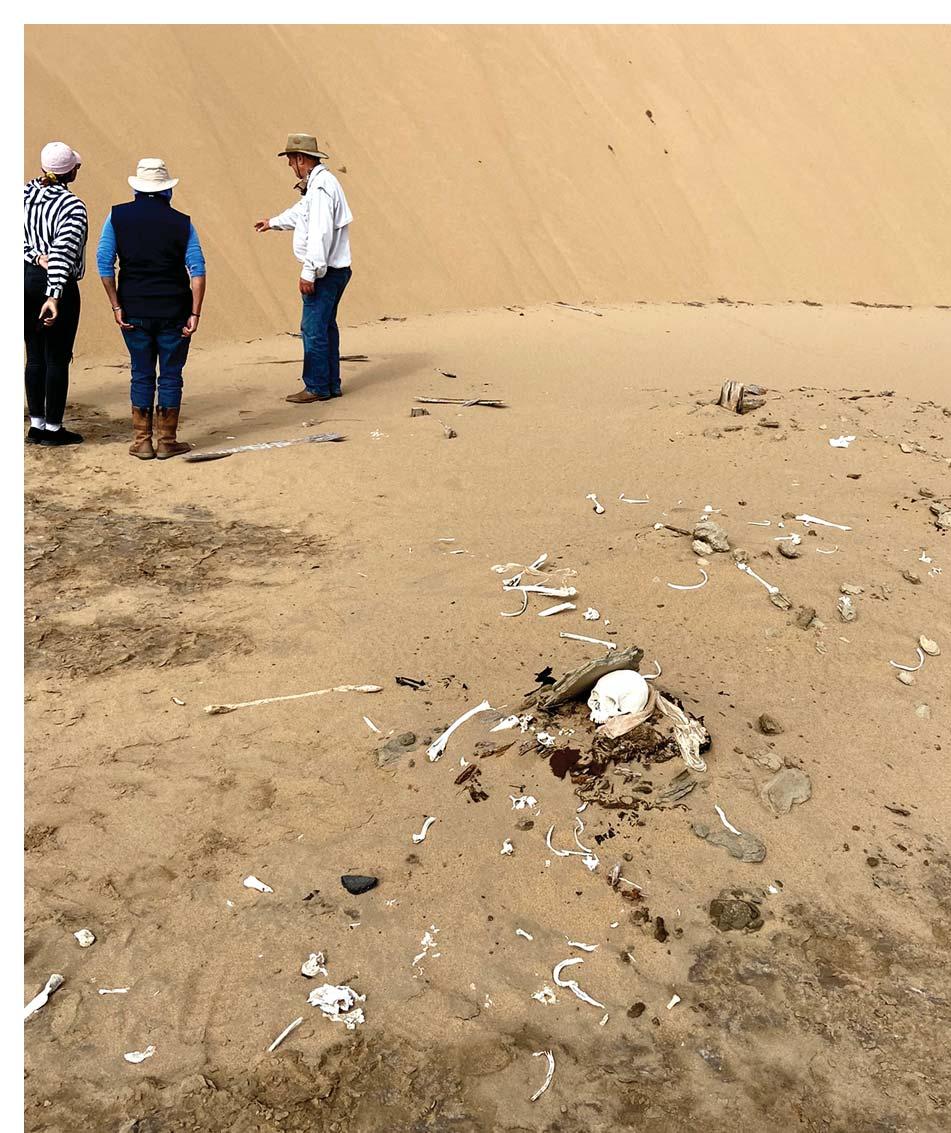
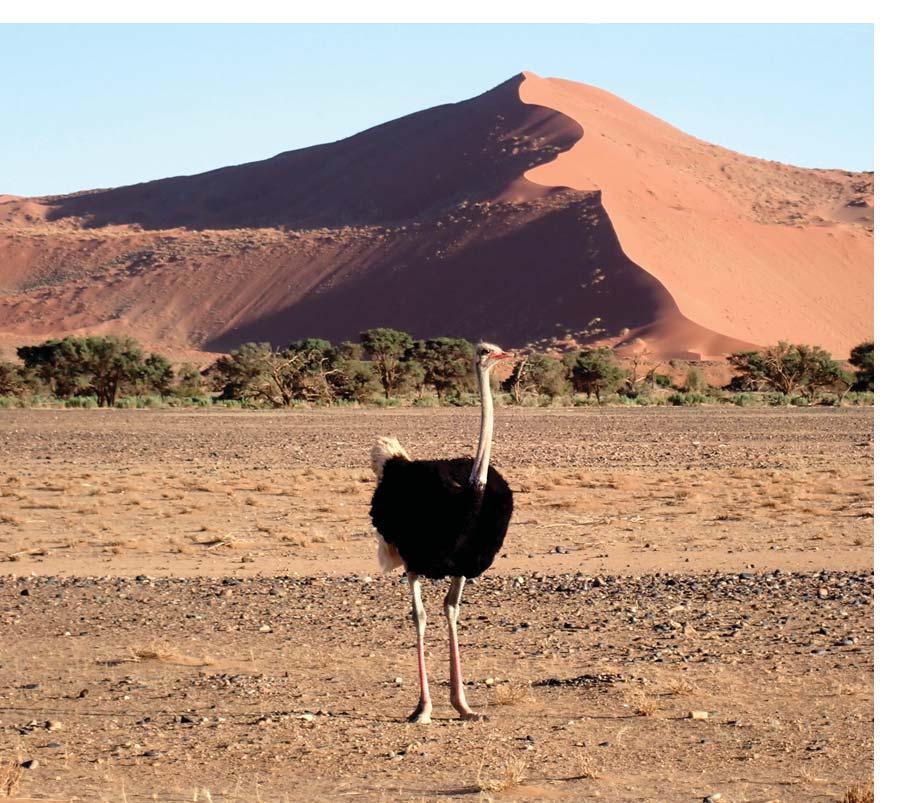
Gary joined us for a three-day trip to explore the Sossusvlei dunes ( Sossus is Nama for ‘no return’ or ‘dead end’ and vlei the Afrikaans word for marsh). We had
leg with just a jib, cruising comfortably at 6–7 knots in moderately large seas. The wind died as we approached Walvis Bay, and as we motored down the bay towards the yacht club we saw someone in a dinghy cleaning off a mooring. As we approached him we mentioned we
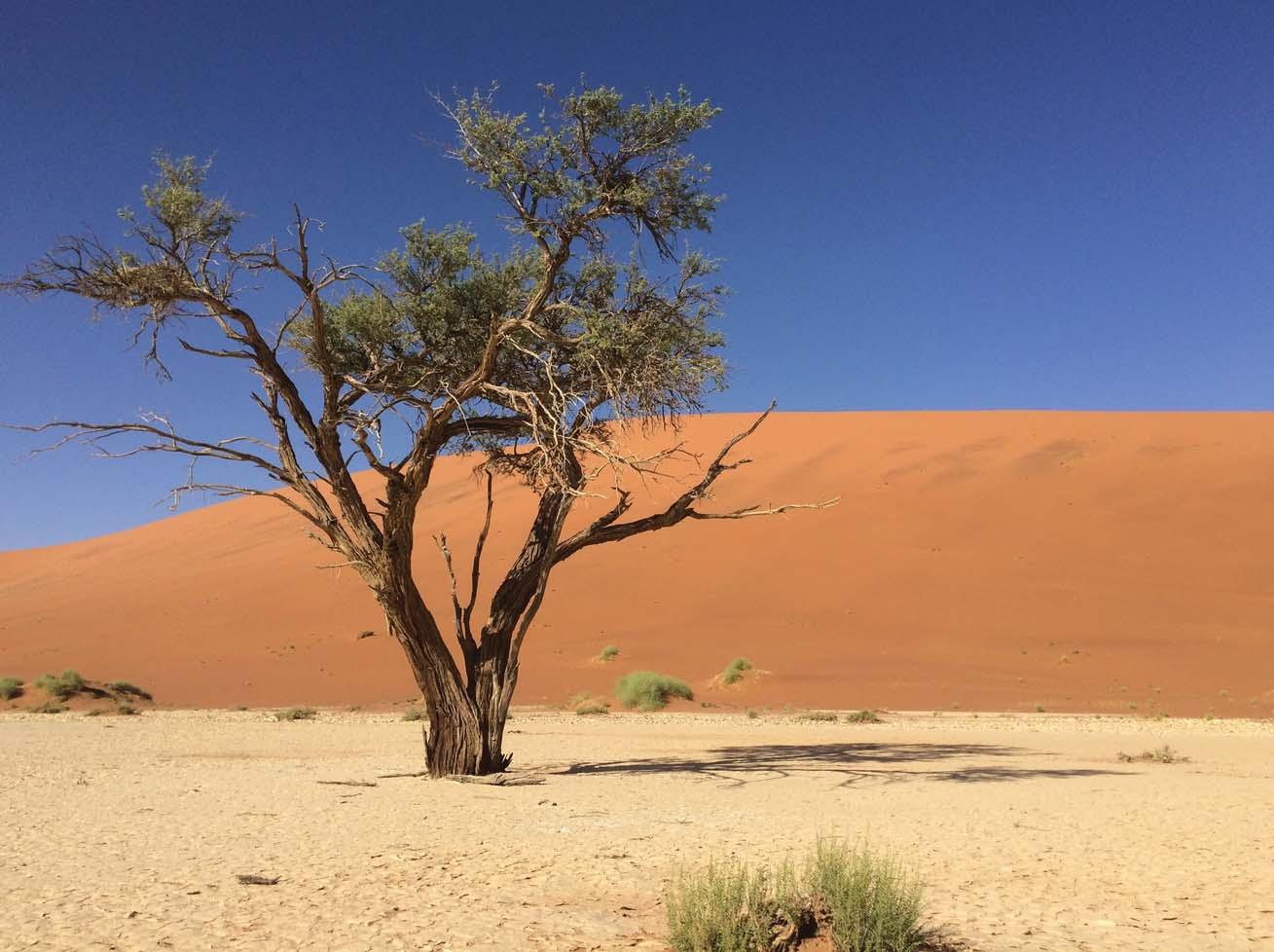 A Namibian ostrich
Magnificent Sossusvlei
Kuiseb Delta Tours at Walvis Bay
A Namibian ostrich
Magnificent Sossusvlei
Kuiseb Delta Tours at Walvis Bay
a beautiful stay at the Sossusvlei Lodge right at the gates of the park and were astounded by the natural beauty as well as the history and geography of that part of the Namibian coast. As part of our exploration we also took a one-day tour of the Kuiseb Delta dunes, adjacent to Walvis Bay, which included an archaeological tour.
After ten days in Namibia with the wonderful people of the Walvis Bay Yacht Club we set sail for Saint Helena, famous as the last home of Napoleon Bonaparte, who was exiled there. Carol celebrated her 70th birthday en route to Saint Helena and wished for some fresh sushi ... well, we caught a 40lb bluefin skipjack tuna on the way, so she got her birthday wish not only for sushi but also delicious grilled tuna. The 1200 mile leg from Namibia to Saint Helena gave us light and moderate winds and we were able
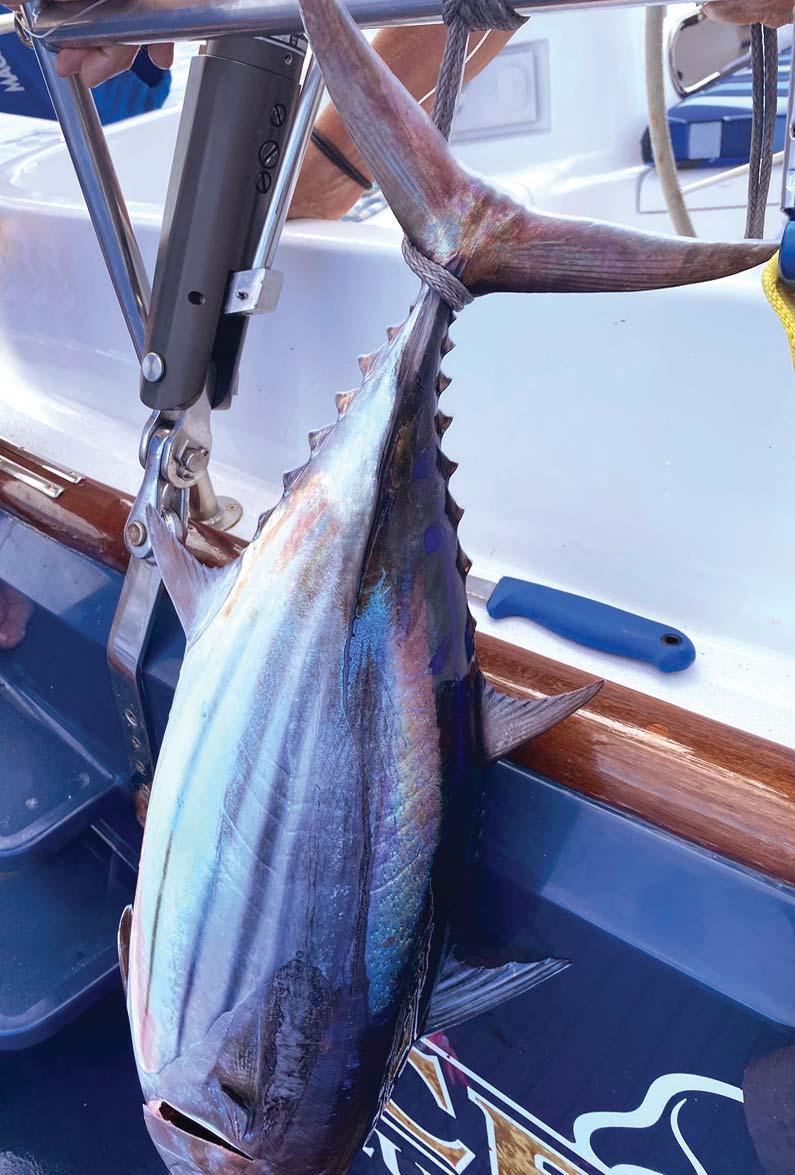
to fly the parasailor a few times. Saint Helena is also famous for Jacob’s Ladder, the 699 steps which ascend from the town square to the top of the mountain and its ancient fort. Finally, Saint Helena is also renowned for its exquisite coffee –highly recommended despite selling for US $45 per pound (0∙45kg)!
The next, 700 mile, leg to Ascension Island took about five days, during which we experienced beautiful 10–15 knot trade winds from the port quarter and were able to sail the parasailor night and day for five days! Ascension Island is a military base for Great Britain and the United States and has the
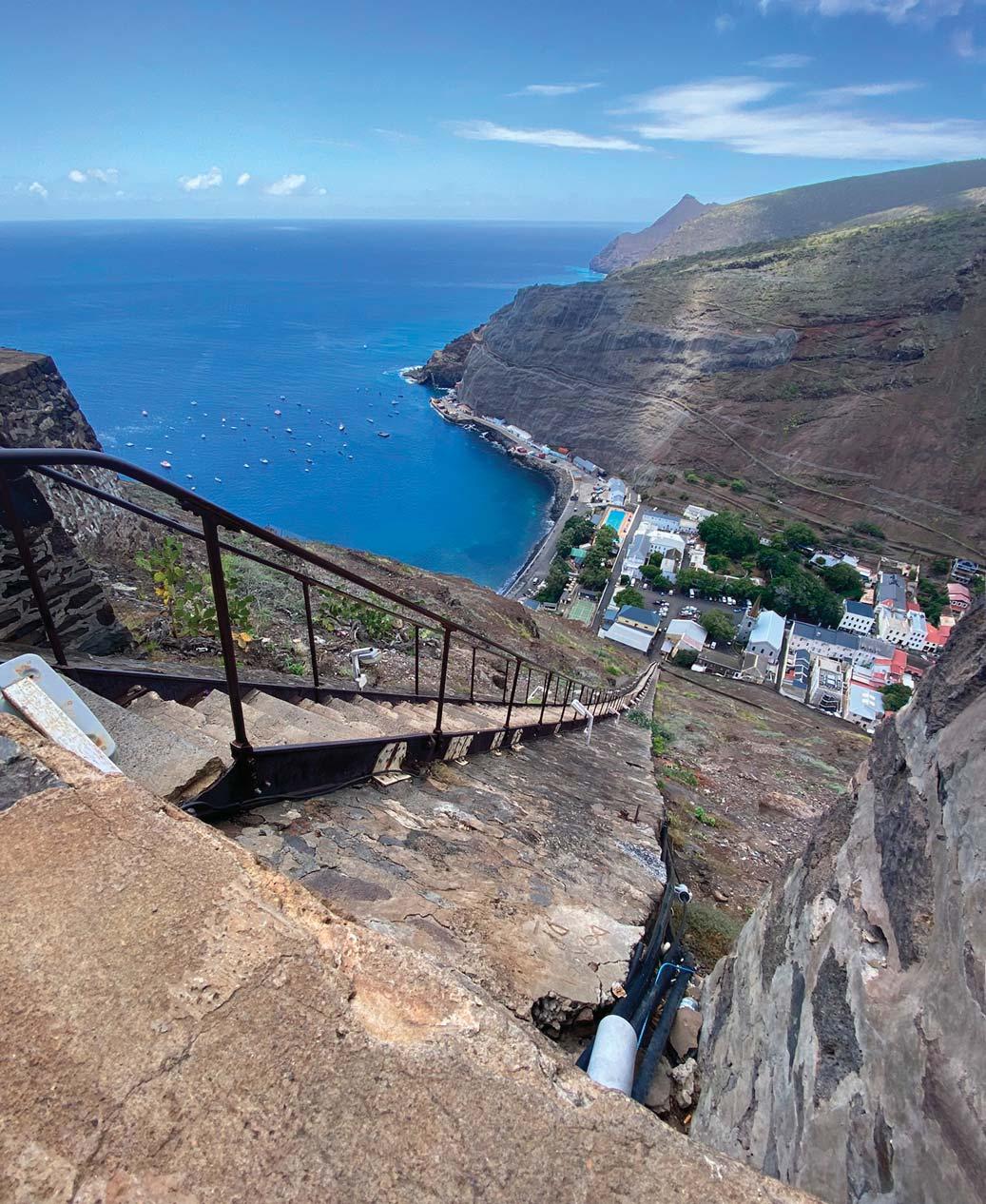 Jacob’s Ladder, Saint Helena
Carol’s birthday skipjack tuna
Jacob’s Ladder, Saint Helena
Carol’s birthday skipjack tuna
distinction of being the point on earth where astronaut Neil Armstrong’s first message from the surface of the moon was received. A huge highlight of our visit, and really the entire passage from Cape Town, was taking a conservationsponsored night tour of the beaches where the green turtles which have returned from Brazil come ashore to lay their eggs. They were huge, with shells 4–5 feet long and 3 feet wide, and dug pits 3 feet deep in which to lay their eggs. We also saw numerous hatchlings emerge through the sand and

head towards the ocean. No one knows where those baby turtles go for the next four to five years, but eventually they make it to Brazil and then the females return to the same beach at Ascension every year for the rest of their lives.
The 1100 mile leg to the Fernando de Noronha archipelago off Brazil was fairly unremarkable, with light to moderate southeasterly trade winds mixed with more squally conditions. We motored for two of the eight days it took us to reach the islands, but were unable to use the parasailor as much as we would have liked, given the frequent squalls. These beautiful, mountainous islands 200 miles off the coast of Brazil are a favourite resort destination for Brazilians but very few people speak English.
The next, 2100 mile, leg to Antigua was the longest of this passage and the third longest of our entire circumnavigation. The only longer ones had been the 3000 miles from the Galápagos to the Marquesas and the 2400 miles across the Indian Ocean

from Cocos Keeling to Mauritius. This leg would take us back across the Equator into the northern hemisphere for the first time since we had sailed from Panama to the Galápagos back in February 2018. It would also take us through the infamous Intertropical Convergence Zone (ITCZ), known also as the doldrums and feared for its intense electrical storms with lightning frequently striking the ocean. Although the North Brazil Current runs up the coast of South America from the Fernando archipelago to the Caribbean, our weather router recommended that we stay 500–600 miles offshore to avoid heavy thunderstorm activity closer to the coast. We agreed to sacrifice some of the current’s speed for safety – one lightning strike will not only ruin your whole day, it will ruin your entire circumnavigation.

We expected to motor through the ITCZ for several days, but fortunately after just two days the northeast trades started to fill in and we sailed most of the passage under reefed
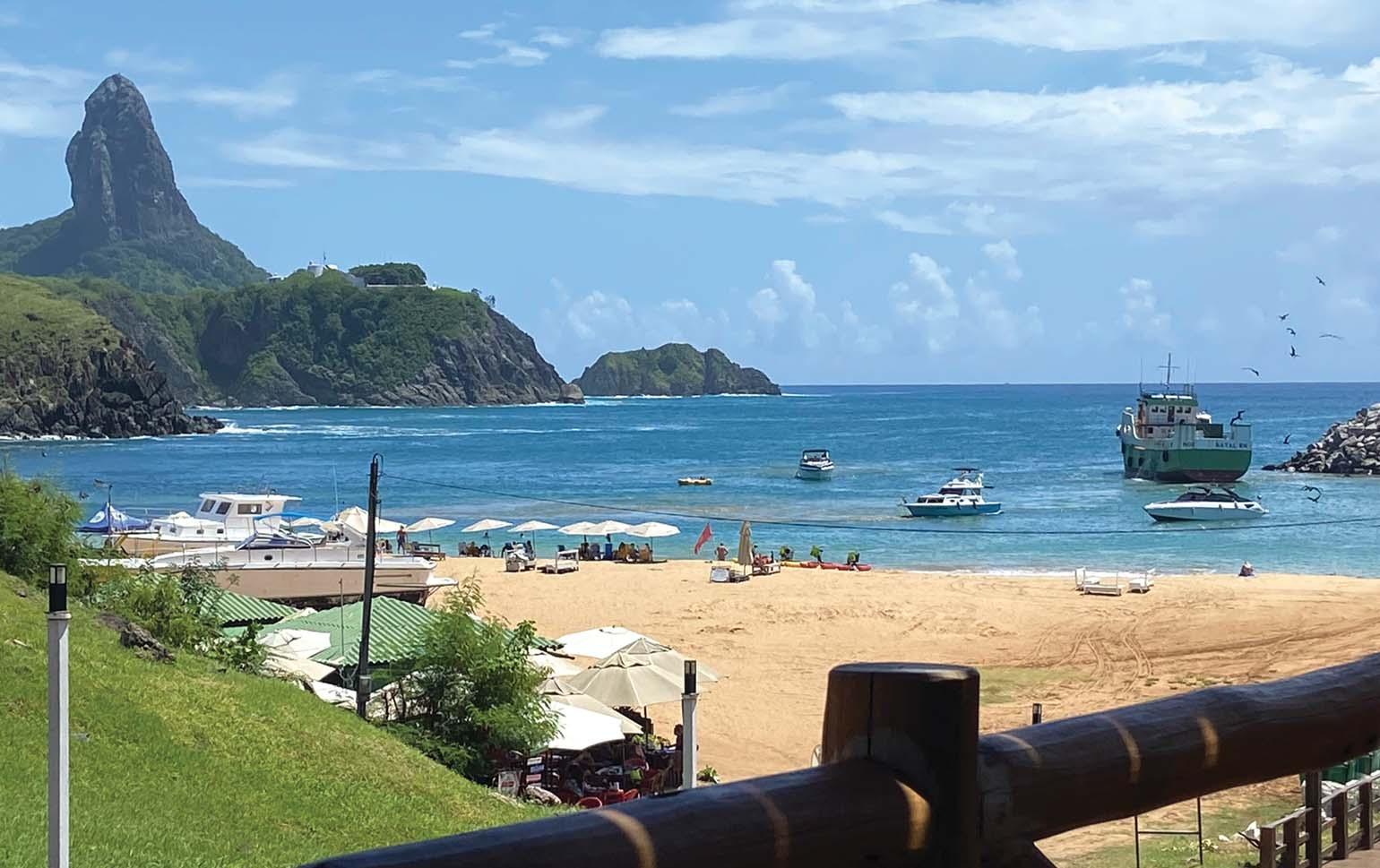 Fernando de Noronha
Crossing the Equator celebration
Fernando de Noronha
Crossing the Equator celebration
main and full jib with the wind on the beam. As we tied up in historic Nelson’s Dockyard in English Harbour, Antigua we completed our circumnavigation of Spaceship Earth. We also treated IceBear to some tender loving care, having her hauled out in neighbouring Falmouth Harbour to clean and repaint the bottom and carry out some maintenance on the saildrive. This was our first opportunity since leaving Cape Town to examine her hull carefully.


 English Harbour, Antigua from Shirley Heights
IceBear hauled out in Antigua
IceBear with the Clipper boats at the Royal Bermuda Yacht Club
English Harbour, Antigua from Shirley Heights
IceBear hauled out in Antigua
IceBear with the Clipper boats at the Royal Bermuda Yacht Club

We now had only two, relatively short, legs remaining – 900 miles to Bermuda and then 700 miles to Cutler, Maine – to complete the entire circumnavigation from our homeport. Both were almost directly north and would take us via our beloved Bermuda, to which we had sailed in five bluewater ocean races from New England in preparation for our round-the-world experience. We made arrangements for a berth at the Royal Bermuda Yacht Club in order to see the participants in the 2022 Newport Bermuda Race arrive. An unexpected highlight was the arrival of the 11 boats in the Clipper Round the World Race fleet. Carol even got to meet her childhood sailing hero Sir Robin Knox-Johnston, in 1968 the first man to circumnavigate the globe non-stop.
The final leg from Bermuda to Cutler took us through the Gulf Stream and, of course, the obligatory low pressure system off the coast of New England. Our weather router told us that a low pressure system to the east of us would create winds of 20–25 knots from the northeast and then, over the course of the next 12 to 18 hours, back around to the north, northwest, west and finally southwest. So we sailed westward, off the wind, for 11 or 12 hours by Georges Bank and then turned east, northeast and finally north to finish our passage to Cutler as the winds moderated and backed behind us. We made one final little detour as we approached Cutler, to sail past Machias Seal Island where we found the sky full of puffins fishing and nesting on this remote island – one of relatively few nesting places in the North Atlantic.
As we tied up at Dean’s Little River Lobster wharf, the first time since October 2017, we truly understood the maxim that we had repeated often during our journey – ‘The only difference between an ordeal and an adventure is your attitude’. We’d done it!
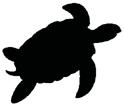
 IceBear back home in Cutler
IceBear back home in Cutler



(This article contains general information and advice for a Best Practices lithium battery installation on a cruising yacht. Many more details on what we learned, what equipment we used and how we did our installation are available from our website, www.svsoggypaws. com/electricalsystems.htm.

All photos by the author except where credited.)
When we purchased Soggy Paws, our 2004-built St Francis 44 catamaran seven years ago, the house bank consisted of six very high-quality German 6-volt gel batteries, for a rated total of 600 amp hours (Ahrs). In early 2020, locked down by Covid in the Philippines and with our gel battery bank then 13 years old, we decided it was a good opportunity to install new lithium technology. According to gel literature, and with our quality charging equipment, the gels might have lasted several more years, but given our location in SE Asia and the time we had available, this was a good opportunity to upgrade.
Our installation is optimised for a catamaran cruising full time overseas and we have little tolerance for jury rigs, marginally safe practices and unnecessarily highcost equipment. We believe that, if installing lithium on a cruising boat, it is worth developing the skills to install and make repairs ourselves with adequate spares and proper tools onboard. Had we not had the time to study the technology, place the orders and make the necessary electrical system changes, we would not have taken this on. It is not a project for those unwilling or unable to spend time learning how to do the installation properly.
Our sealed lead acid start battery on the left and the original 390 lbs/175 kilos of gel batteries on the right. ‘TCB’ and ‘Diode’ on the aluminium heat sink are for trickle-charging the start battery off the gels
LiFePO4 (LFP) batteries suitable for cruising boats consist of an appropriate number of individual prismatic 3.2-volt cells that operate safely within a narrow voltage range. Straying beyond this range can cause permanent cell damage. For a Best Practices
LFP battery system, a boat’s electrical system should have separate charging and load busses (connection points) wired to a single house bank through appropriate shunts and fuses. Each of the charging sources (solar, alternator, shore, etc) should have a relay that allows a battery management system (BMS), monitoring individual cells, to shut the charging device down, not just disconnect it from the battery. This should happen automatically if there is a problem beyond what the charging device does with its own onboard charge termination. In normal operation the charging sources, reading total battery voltage, will control the charging and charge termination using mainly the bulk phase with no or only minimal absorption. The BMS will act as a backup to terminate the charge if a single cell’s voltage gets too high (HVD) and the charging source fails to terminate the charge in time. There should also be a relay or relays on the load buss for the BMS to disconnect loads (LVD) if the battery reaches too low a state of charge.
After significant research and having lived with the new technology for over two years, we would like to share our thoughts on how to choose equipment and complete a DIY LiFePO4 lithium cell installation on a cruising yacht. But first some cautions:
The technology and supporting equipment are still evolving, with a multitude of choices available, some much better than others. Quality of equipment is an important issue, not only with lithium batteries but with all equipment on a boat.
Basic LiFePO4 battery wiring diagram with BMS and separate charging and load busses. Fuses, shunts, relays, etc not shown

No serious cruiser should change from lead acid (LA) to LFP batteries unless they are willing to spend a substantial amount of time in research, effort and money to do a proper installation.
There are many opinions regarding how best to do this and even the experts’ opinions differ. There are also substantial differences in off-grid home, electric vehicle (EV) and marine installation Best Practices.
If a marine installation is done by an installer but the owner may have to perform adjustments or repairs after he has left, it is crucial that the owner has detailed knowledge of the installation.
Competition among sellers of lithium equipment is stiff, especially among cell and BMS producers. US and European distributors can be significantly more expensive than purchasing cells direct from the manufacturer, usually in China.
Not everything you read on seller websites is true, and some important things that are true are not there. Taking a close look at specifications and warranties is time well spent, especially if you later have a problem.
Communication with the seller is important – some are much better than others. See lithium forums for the experiences of those who have made recent purchases.
In order to create a successful installation it is necessary to have an open mind and be curious about what has worked or not worked for others.
Replacing our lead acid gels with blue LiFePO4 lithium prismatic cells. Only one of eight LFP cells is shown
Because of the vast differences between these two types of battery technologies, great care must be taken not to make any mistakes during planning and installation. A number of different lithium ion type cells are available now, but LiFePO4 is the best choice for cruiser batteries. It has significant advantages over the others, including being reasonably stable and safe in a marine environment. Even some of the electric vehicle companies are now changing to LFP. Some differences between LFP and LA technologies:

LFP cells do not require a full charge on a daily basis – in fact, charging to 90% or even less is perfectly acceptable and may give a slightly longer service life. This is a huge advantage.
With LFP, no absorption or float charging is needed, only bulk. This means that once the bulk is completed the charger can be turned off, but not all LA chargers can do this.
LFP cells typically have 50% more usable capacity for the same overall rated capacity. 80–90% of LFP rated capacity is useable on a regular basis versus a maximum of 50% for LA under ideal conditions.
LFP service life is typically 3000–5000 full cycles versus 500–1000 cycles with LA.
Cell level monitoring, balancing and disconnect control are required with LFP, whereas only those for the total battery are typically needed during charging with LA.
Some significant electrical system modifications are usually required for a proper lithium installation. These include purchase of a quality and reliable BMS, installing separate charge and load busses and using separate inverters and chargers.
Charging with an alternator requires some modifications or you risk overheating your alternator internals. You must either make sure the alternator is externally controlled by a smart alternator regulator with temperature and reduced output control or use battery-to-battery controlled charging, possibly with a lead acid battery also connected to the alternator. The externally-regulated alternator is much preferred.
Batteries made of LFP cells are about one third the weight and take up two thirds the space of LA batteries. They can be charged significantly faster and have little voltage drop when placed under a heavy load.

After a great deal of research, we settled on prismatic-style aluminium-cased individual LFP cells, purchased directly from RJ Lithium in China [https://www.rj-lithium.com/]. There are a number of other well-regarded Chinese companies from which we could have bought the same thing, but cruising friends had researched the subject and were buying from RJ. Their reputation was good, they offered documented Grade-A cells, the sales representatives were responsive, the website was informative and they offered a 5-year warranty.
Four of our eight 3.2-volts per cell prismatic cells connected in parallel during top balancing. Grade A testing stickers are intact and show, among other things, capacity, voltage, serial number and date of manufacture
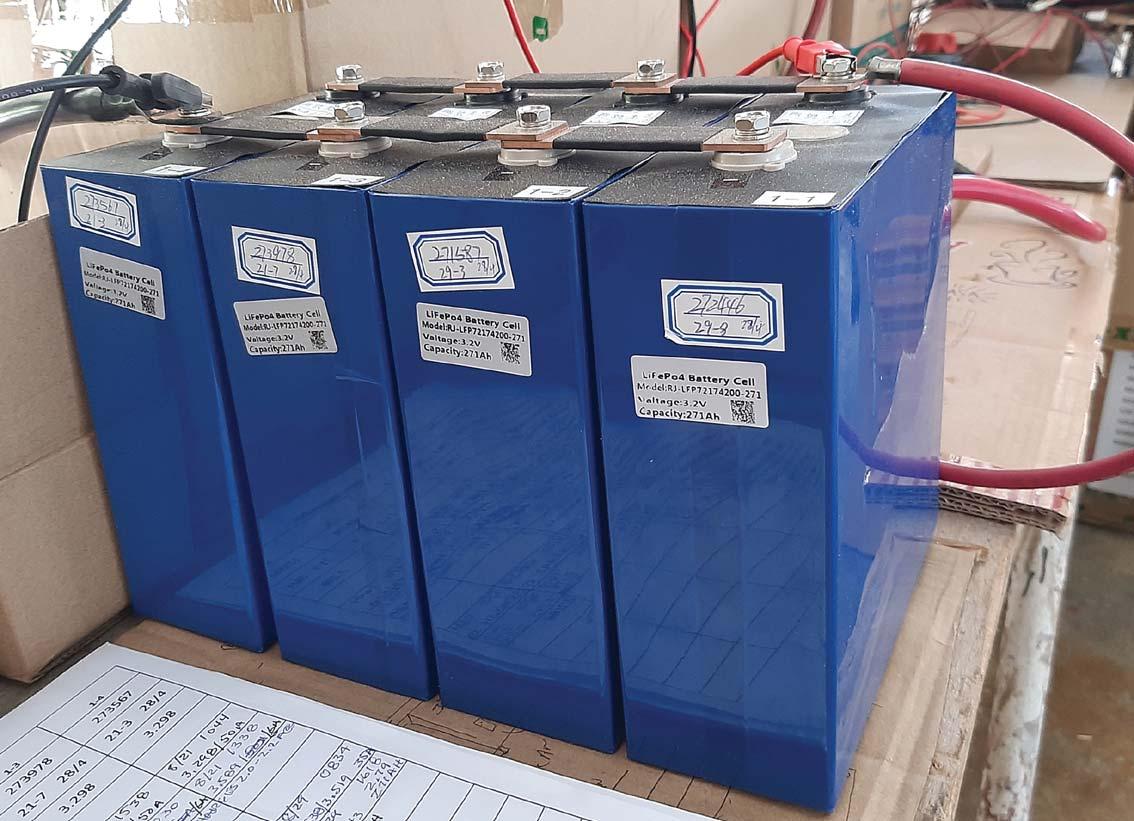 Our older Xantrex Link 2000 lead acid battery monitor which displays only total battery parameters
Our older Xantrex Link 2000 lead acid battery monitor which displays only total battery parameters
We purchased eight 3.2-volt 271 Ahr LFP cells. In order to get a single bank of 542 Ahrs at 12.8 volts, we arranged them in four sets of two cells in parallel (542 Ahrs at 3.2 volts for each set of cells) with the four sets arranged in series to make a 12.8 volt battery. Of that 542 Ahrs, more than 450 Ahrs are useable, so we increased our capacity by about 50% over our gel battery bank’s useable capacity, plus we were able to remove 390lbs (177kg) of gels and replace them with only 100lbs (45kg) of lithium cells. The LFP cells cost about US $150 plus about $35 shipping each, making a total cost of close to US $1500 for all eight. (The shipping cost was excessively high at the time due to the peculiarities of shipping into the Philippines via Hong Kong during Covid). We later discovered that, sourced locally here in the Philippines, we could have bought similar well-regarded but probably Grade B, EVE or Lishen cells without the longer warranty for about US $100 each plus a very modest shipping cost, totalling around US $900 including shipping. The LFP cell market is constantly changing and competition is fierce, so this pricing from China is no longer current. On the forums we often see these Grade A cells being shipped to the US and Europe at very reasonable prices. A cruising friend in our marina in the Philippines has recently purchased 240 Ahr Grade A EVE cells with a 2-year warranty and minimal shipping cost for about $100 US each.
We do not recommend installing what are commonly referred to as ‘preassembled’ or ‘drop in’ lithium batteries on a serious cruising boat. They are better suited to coastal power boats and outboards for the following reasons:
The cells and BMS are often secured inside a sealed battery box and may be inaccessible if there is a problem.

Typically, the BMS provided uses small internal MOSFET (metal-oxidesemiconductor field-effect transistor) relay components that must control the high currents usually found on cruising boats. If anything goes wrong the owner may have to replace the entire battery and BMS.
There may be little adjustment available to the charging and other control parameters which you may want to customise for your installation and longer service life.
External communications with wifi or Bluetooth for monitoring and control may be limited. This is a critical component of the system and must be rock solid.
If bought through a dealer, they can be extremely expensive compared to a
similar DIY installation using individual cells and separate quality BMS. Typically, quality units are two to three times the cost of a DIY installation.
You will still need to do many of the same modifications to your electrical system as with a DIY system, in particular the separation of charging sources and loads into two busses.
If you can’t take the time to do a proper DIY installation yourself, or with help from a knowledgeable friend who will teach you the system, we recommend buying quality gel batteries to install into your existing LA electrical system.
The LFP cell charging curve is very flat in the middle between 3.2 and 3.4 volts per cell (VPC). It then goes nearly vertical (the knee) as the cell approaches full state of charge (SOC) at about 3.45 VPC and above. Because charging through the upper knee takes only a couple of minutes it represents very few Ahrs and may not be really necessary. Likewise, as the battery is discharging, the voltage stays very flat until dropping off rapidly below about 3.15 VPC as the battery reaches 10% SOC. The relatively high stable voltage and flat discharge curve are a big help when using high amp draw equipment like an inverter or windlass. This charging and discharging graph is provided by Energie Panda [ www.energiepanda.com ], a supplier of high quality LiFePO4 cells for DIY LiFePO4 batteries.
LiFePO4 cell charge and discharge curve comparison. Image courtesy Energie Panda
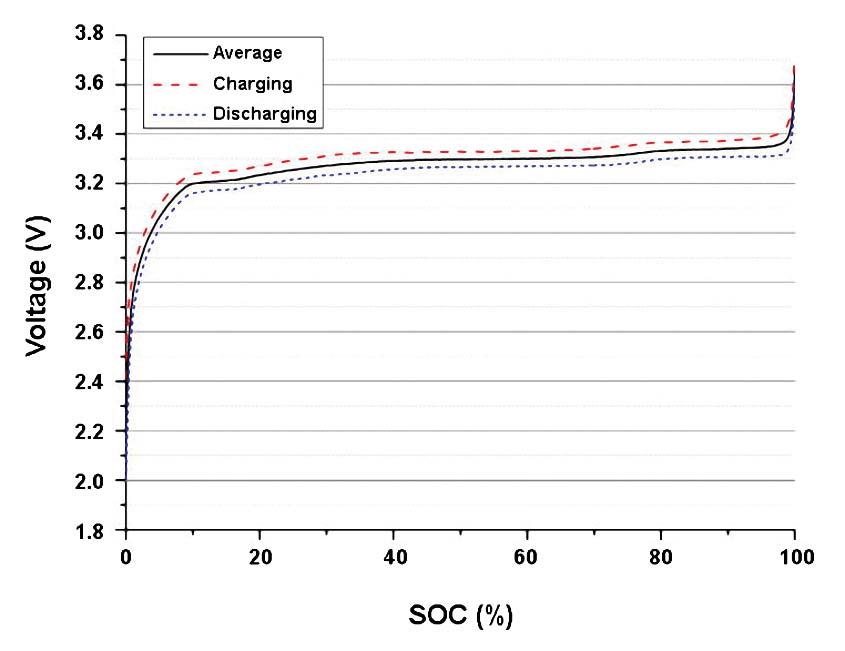
Factory matching of LFP cell capacity and internal resistance are important for being able to maintain cell voltage balance. But it is a labour-intensive, and therefore expensive, process, so few companies selling cells at competitive prices are able to do a perfect job. Several, such as Winston and a few others, do better than average matching work, but this is reflected in their significantly higher prices. This is where a good balancer in the BMS (at least 200 milliamps) or a separately-purchased quality balancer earns its keep.
If the cells are not perfectly matched in capacity and internal resistance when charging, one cell can get to 3.65 VPC well before the others. This is an over-voltage situation which can destroy that cell before the total battery voltage reaches an alarm condition. Likewise, when discharging, if one cell is slightly more depleted than the others, its voltage can drop rapidly to below 2.5 VPC, a destructive under-voltage situation, again while the overall battery voltage is still at a safe level. A quality BMS which can monitor cell voltages can control these situations through external relays and prevent cell damage.
Finally, cells that are not well-matched for internal resistance will have slightly different charge curves, which might cause an automatic balancer to balance the wrong cells during charging. Our cells are not perfectly matched, so their charge curves intertwine voltage levels as they are being charged. Sometimes the low voltage cell at the start of charging becomes the high voltage cell at charge termination. A good cell-balancer can handle this and keep individual cell voltage balance levels within a reasonable difference.
Well-regarded lithium factories produce thousands of individual cells a week. During initial testing, those that match advertised specifications and have no physical damage are graded as A cells. Those that do not become grade B cells and could have a range of problems. Both are sold on the open market. Grade A cells are usually more expensive, have QR and testing stickers intact and usually have warranties of a year or more. Grade B cells are often sold to off-grid applications that use hundreds of cells so can afford to have a few with problems. Serious cruisers would do well always to buy Grade A cells from a well-regarded supplier, as it helps ensure full useable bank capacity and makes balancing much easier.
Banks of lithium cells are typically connected in sets of four 3.2-volt cells in series for a nominal 12-volt battery system. For a 24-volt electrical system, connect eight cells in series. For more capacity than four or eight single cells will allow, first connect cells in equal parallel sets, then wire those sets in series. The parallel sets can include cells of varying capacity, but the series sets must all be of equally-rated capacity and voltage.
We originally planned to configure our eight cells into two four-cell 12-volt nominal ‘batteries’, with a 1-2-both selector switch so we could change batteries if we ran into a problem with one. However, once we started wiring up our two ElectroDacus BMSs, we found that trying to control the separate loads, charging sources, two busses and multiple external relays with our two BMSs became too difficult. Some internal relay BMSs are able to do this, but with somewhat degraded reliability and battery balance problems. We also realised that if we ever ran into an (extremely rare) sudden cell problem, rearranging the cells with our spares to make repairs was a pretty simple temporary solution. We ended up with four sets of two cells in parallel to make four ‘supercells’, then those four supercells in series for a 542 Ahr at 13.2-volt bank. This also had the advantage of requiring only one BMS instead of two. Since we had ordered two ElectroDacus SBMS0 BMSs we now had a spare.
Whether our configuration is called a 2P4S or 4S2P configuration depends on who you ask. It is written both ways in the lithium literature and on the internet. Be mindful of this when asking questions on lithium forums – sometimes it is preferable to describe your configuration rather than using one of these abbreviations.
Most literature and experts on LFP cells recommend using a ‘compression box’ to contain the cells. On a boat this is also a ‘limitation box’ which provides cushioning, prevents the cells from chafing against each other and shorting, prevents terminals
Our eight LiFePO4 cells in their compression box in a 2P4S configuration, with two of the four threaded compression rods visible in place. Flexible connecting straps are made of multiple layers of copper carefully cleaned and firmly fastened to the terminals. The thin grey ribbon cable wiring is for the BMS monitoring and balancing functions
being damaged by connector tension as a result of expansion during charging and stops any sliding around as a bank in rough weather. According to EVE Energy, one of the largest lithium cell manufacturers in China, their aluminium case cells require compression in order to reach their full service life. Many others agree.
With this in mind we built a compression box to store the cells, using epoxy-coated ¾” (19mm) marine plywood and 3/8” (9∙5mm) SS threaded rod. Between the cells we used 1 mm soft placemat material to prevent the cell sides from shorting together and provide somewhat of a cushion. The box has a polycarbonate cover and is strongly secured under our main cabin settee in the middle of the boat. It is only about 3ft (90cm) from the BMS, busses, regulators, relays and other major wiring.
A good BMS is a critical component of a LiFePO4 system. Unlike most lead acid battery monitors that display only overall battery voltages, a good BMS must monitor individual cell voltages. In order to prevent cell damage a BMS must watch the voltage and SOC of each cell and make appropriate decisions regarding when to disconnect charge sources in case of a cell over-voltage event or disconnect loads in case of a cell under voltage-event.

There are two types of BMS. One uses small internal MOSFET relays to turn on and off charging and loads when required. The other type of BMS controls more capable external relays. Since loads like inverters and windlasses and charging sources like alternators and generators might involve relatively high currents, cruising boat systems are better done with a BMS that can control high capacity external relays.
An important BMS feature is its ability to display externally what it is doing and important battery details such as voltage, current and SOC. Options include hard wiring to a display device such as a computer, wireless wifi and wireless Bluetooth using an application. We use wifi so that we can custom configure the display and see what is happening with our system when on or off the boat.
A good BMS will also have some sort of cell-balancing capability. 200 milliamps are usually sufficient to keep most reasonably matched and balanced marine house bank cells in line. Although most BMSs use some form of low current passive balancing,
and that is usually sufficient over time, larger active balancers are available. They work with large cell deltas more quickly, removing excess amp hours from high voltage cells and placing them in lower cells.
BMSs range in price from cheap/dumb US $15 small open boards with no user interface, to high-quality programmable BMSs that will integrate seamlessly with existing proprietary equipment, such as quality Victron components, for about US $600. High price doesn’t always give you all the equipment features you may need, but better quality BMSs are usually priced over US $100. Before purchasing a BMS you should look at the several internet sources for comparing BMSs, including user forums and YouTube videos. Just remember – serious cruisers cannot afford unreliable gear, so paying for reasonable quality and reliability is worthwhile, but there’s no need to go overboard for capabilities you won’t use.
We chose a very smart programmable BMS, an ElectroDacus SBMS0, made in Canada by a small, well-regarded company [https://electrodacus.com]. This one is targeted at the DIY solar community and can control multiple external relays with many adjustable parameters. It has an included detailed monitor screen, a 200 milliamp balancer, excellent HVD/LVD protection capability and an optional wifi interface. Just about every parameter for charging, discharging, balancing and HVD/ LVD control is adjustable by the user. The HVD and LVD controls have six ways to set the control function and it has a very sophisticated logging capability. Finally, the developer and others provide significant help to users as needed via a forum and several beginners’ guides.
Our ElectroDacus SBMS0 and its main monitoring screen, one of about two dozen screens available for monitoring and parameter adjustment. This screen shows, among other things, cell and total voltages, charging and load amps, maximum cell delta and SOC

I suspect that most underwriters are suspicious of Chinese lithium batteries (where almost all are made) and BMSs. However, even most ‘US’ branded ‘drop-in’ lithium batteries use Chinese cells and BMSs.
LiFePO4 technology is different from, and safer than, lithium-ion batteries used in electronic devices like cell/mobile phones, computers and most electric vehicles.
A year after installation, the danger from a cell problem is minimal but danger from a poor installation or equipment continues. A cruiser must be very familiar with his or her installation.
There are several ways to do a lithium installation, including for off-grid homes and
electric vehicles where a failure is not such a big problem. Not all are suitable for a cruising boat, especially one travelling overseas, where failed equipment or poor installation techniques can spell disaster.
Not all installers, though ‘certified’, will be as familiar as you might like with your marine installation. Even if using an installer, you must be familiar with your boat’s electrical system and what will be required for a ‘Best Practices’ installation. Make sure the installer is also, and that you both agree the installation details. Be aware that the installer’s choice of equipment may be best for his profit margin but not necessarily best for your installation.
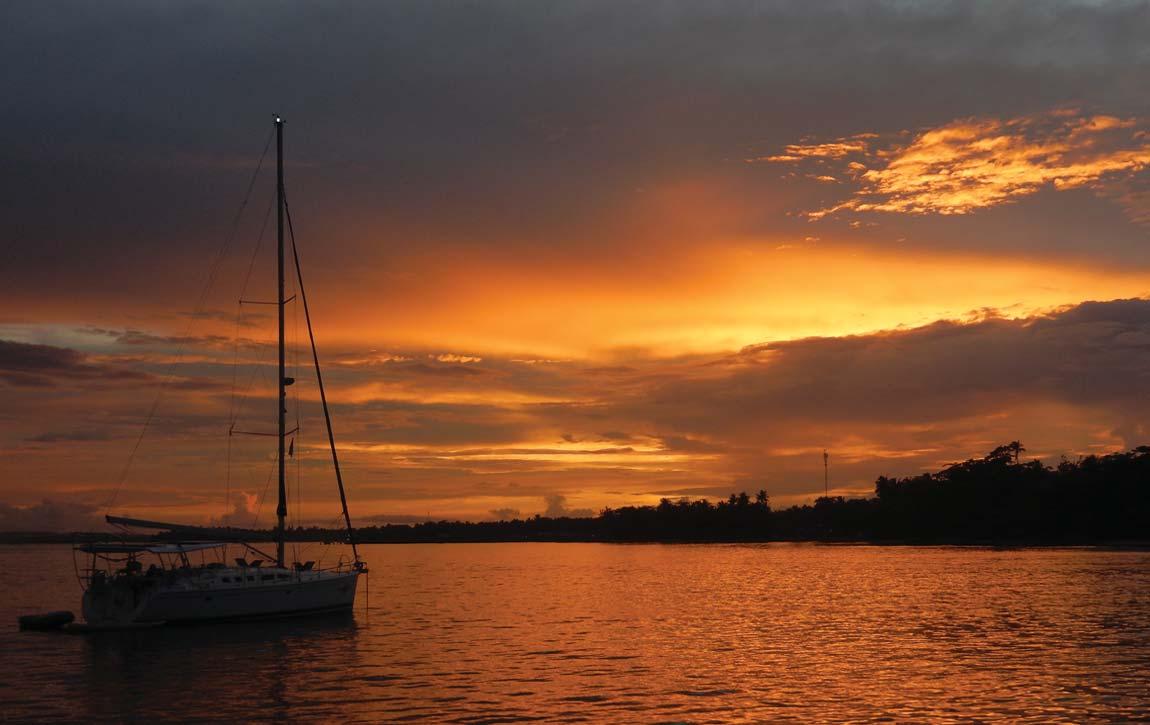
A lithium battery installation is not for everyone. If lithium installation challenges are insurmountable, our experience with high quality gel batteries has convinced us that they are the best LA technology for cruisers.
Watch the installation very closely and double-check the installer’s mounting, wiring and termination techniques. This will further familiarise you with the system and hopefully allow you to spot and effectively troubleshoot a problem in the future.
If you have done the research, know what you are doing and are willing to do the installation yourself, you can ensure a proper installation and save a considerable amount of money. It is not rocket science and there’s a lot of help available on the internet.
A good way to start an LFP project is to read this article in full, together with other detailed information about our installation, on our website at www.svsoggypaws.com/ electricalsystems.htm.
Next join the Facebook group Lithium Batteries on a Boat, then watch some of Will Prouse’s Mobile-solarpower.com YouTube videos. Graduate to some of those on Andy’s Off-Grid-Garage.com. Finally, read the detailed LFP articles at MarineHowTo. com and NordkynDesign.com. Once finished, and if you can remember most of it, you should be ready to start your own DIY LFP project. Links to these and other resources will be found on our website above.
Enjoy learning about this new technology, but remember that the experienced experts don’t all agree. The forums, especially, are full of conflicting opinions, but there are also many good options. Study carefully and subscribe, as we did, to the preponderance of evidence from trusted sources. In the end the effort will be well worth it, enabling you to spend more time cruising and less time working on your boat.
Sunset in the Indonesian tropicsTretheague Coronation Chicken (serves three to four as a main dish)
Ingredients
• 450g or approximately 8 boneless chicken thighs
• 2-3 tbsp apricot jam (according to taste)
• 1 heaped tbsp curry paste
• 1 tsp turmeric
• 300ml good shop-bought mayonnaise
• 150ml crème fraîche
• 1 tbsp tomato purée
• finely grated zest and juice of 1 or 2 lemons
• 2 large spring onions, finely chopped
• salt and freshly ground black pepper
• 175g black and green seedless grapes, cut in half lengthways
• rocket or pea shoots and grapes to garnish
Cut the chicken thighs into bite sized pieces, removing the skin or leaving on as desired. Season with salt and pepper and cook in an ovenproof dish in a very small amount of oil at 180° (350°F or Gas Mk 4) for about 25 minutes.
Put the jam, turmeric and curry powder in a small pan and heat gently, or into an ovenproof dish in the oven on a shelf lower than the chicken. Stir from time to time until the jam has melted and the curry paste dissolved. Set aside to cool a little. Mix the mayonnaise, crème fraîche, tomato purée, lemon juice and lemon zest together in a large mixing bowl until combined. Stir in the jam and curry spice mixture, add the cooked chicken pieces and lastly the spring onions. Season with salt and freshly ground black pepper, add half the grapes and stir until combined. Spoon onto a serving platter and garnish with the remaining grapes and the rocket or pea-shoots. Serve at room temperature.
(Sara produced a tray of piping hot fish cakes at this year’s West Country Meet pontoon party – see page 16 of the December 2022 Newsletter – made from a tuna caught on passage home from the Azores.)
You can’t beat a fish cake when you’re on board. These are so easy to make and offer another way to cook all that fish your other half catches! I used tuna on this occasion, but any fish will do.
• 350g potatoes (Maris Piper work best) peeled and cut into bitesized pieces
• 350g fresh fish, filleted
• 100g smoked fish
• chopped parsley (optional)
• one egg
• Panko breadcrumbs*
• Vegetable oil for frying
Peel the potatoes and cook in salted water until tender but not broken. Turn off the heat and add the uncooked fish to the water. Leave to cool, by which time the fish will have cooked. Remove the fish and discard any skin. Strain the potatoes and leave to cool. Mash the potatoes in a bowl and then add the cooked fish, the smoked fish and parsley if desired. Season to taste and chill. Beat the egg on a plate and have the Panko breadcrumbs ready on another plate. Form the chilled fish mixture into patties and roll in the egg and then the breadcrumbs. Heat some vegetable oil in a frying pan and cook the fish cakes gently until golden brown.
Chilli Dipping Sauce
Ingredients
• 4 tbsp sugar
• 4 tbsp water
• chilli flakes
• soy sauce
Heat the sugar and water gently in a saucepan until the sugar has dissolved, then bring to the boil. Turn off the heat, add a sprinkling of chilli flakes and a dash of soy sauce, and leave to cool.
* A Japanese style of breadcrumbs traditionally used to coat deep-fried foods. Available in some supermarkets, or make by lightly baking coarse breadcrumbs for extra crunch.
Ceviche
Ingredients
• any freshly caught fish (I generally use the scraps after taking some decent size fillets)
• red onion, red pepper and tomatoes
• lime juice and zest
• a dash of Tabasco sauce
• salt and pepper
• fresh coriander (cilantro) if available
• lettuce to serve
Finely chop some red onion, red pepper and tomato. Add plenty of lime zest and lime juice, a dash of Tabasco sauce, salt, pepper and, if you have it, some fresh coriander (cilantro). Leave to marinade in the fridge for a few hours and serve on a bed of lettuce. Delicious!

(In Flying Fish 2021/2 Tom and Vicky, now based in Nelson on New Zealand’s South Island, described parting with their much-loved S&S 40 Sunstone and replacing her with the somewhat less physically-demanding Zest, a locally designed Craddock 36.
All the photos were taken by Vicky except where credited.)
Nautical reminiscence in the form of revisiting favourite cruising grounds is the prerogative of elderly sailors. One of our many favourites is Port Pegasus at the southwest corner of Stewart Island in the far south of New Zealand. Though small in area, Port Pegasus has numerous anchorages. Fortunately several of these are all-weather, giving shelter from the volatile conditions of the southern 40s – Southwest Cape, one of the five ‘Great Capes’ is only a few miles away. Cruising the south of New Zealand is best done in La Niña years when the highs follow the cooler waters, letting the lows do their worst on the North Island. Fortunately 2022 was such a year.
From Nelson, our home port, to Stewart Island is about 600 miles whether by the west or east coast routes. The latter is more appealing to those who, like us, now prefer to break passages into digestible chunks as there are convenient ports for pleasant stops at the Marlborough Sounds, Lyttelton, Akaroa and Dunedin. Having departed Nelson just before Christmas, a combination of motoring and enjoyable reaching saw us entering Taiaroa Heads on 9th January for the long, winding motor up Otago Harbour, past Port Chalmers to Dunedin. Though the Otago Yacht Club is rarely a hive of activity it makes visitors welcome – or at least those with shallow enough draft to get through the shoal entrance of its tiny but well-protected harbour.
The hills of Lyttelton and Akaroa had encouraged hiking rather than biking, but Dunedin’s landscape is more gently rolling and our bikes emerged from their cramped quarters in the cockpit locker for an airing, first to Port Chalmers in the rain and then to the south coast beaches in beautiful, bright sunshine. Sophisticated food stocks are in short supply at the store in Oban on Stewart Island, so we replenished, refuelled and watered.
 Port Hardy, The Sounds
Port Hardy, The Sounds
A window of fair winds opened as if by arrangement and we headed away, though not without incident. Almost immediately the autopilot threw a temporary tantrum, through no fault of its own as its wiring had been disturbed by the ructions of restowing the bikes. Then, as we sailed down Otago Harbour, we found that we could not turn the engine off with its stop solenoid. We have to confess that, despite its generally reliable and powerful performance, we have not made friends with Zest’s Vetus engine. In any case, given our likely arrival in a small harbour with no guarantee of a convenient mooring, we decided to keep the engine idling until we reached Oban where we’d be able to give it still more of the attention which it so often demands.
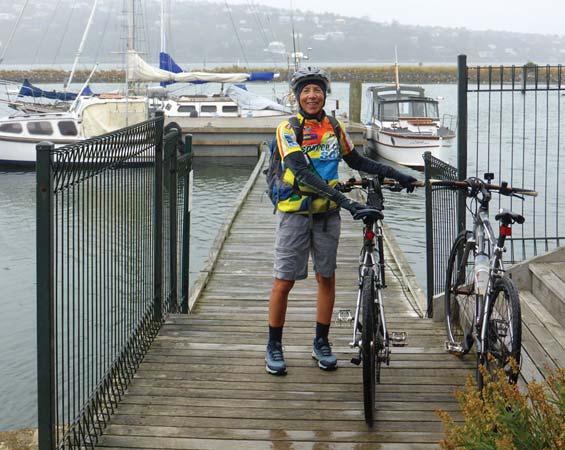
A delightful, full-moon-lit night sail took us to within striking distance of Oban. Though fog descended during our approach, the sun broke through as we entered the harbour at Half Moon Bay where we picked up a convenient mooring and shut down the engine. A day spent studying wiring diagrams and investigating their possible correspondence to
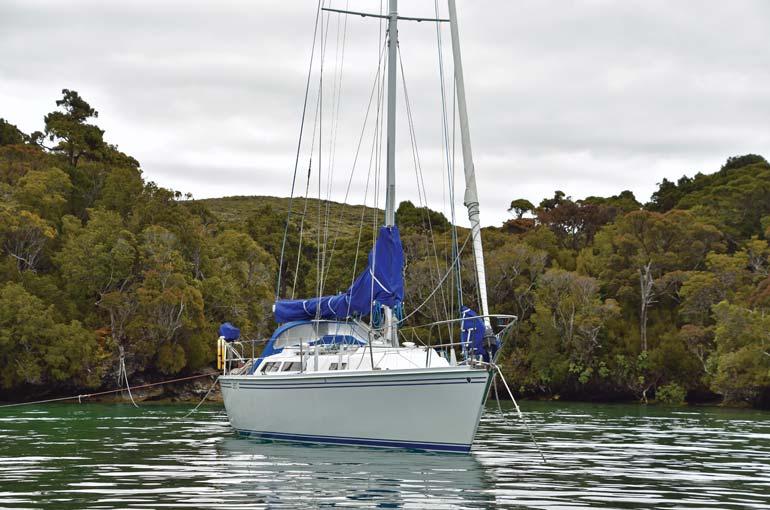 Vicky at Otago Yacht Club following a wet bike ride.
Photo Tom Jackson
Zest in Evening Cove
Vicky at Otago Yacht Club following a wet bike ride.
Photo Tom Jackson
Zest in Evening Cove
reality produced only tentative conclusions, but eventually the disconnection of an apparently redundant wire seemed to restore order to the system.
This was our fifth visit to Oban. It is impossible to visit such a small, tightly knit community (population 400) without making friends, with whom we then caught up. Oban is also a crossroads for cruisers, headed not only to Port Pegasus but also further on to Fiordland on the west coast of the South Island. Though their numbers are few, the quality is high and we enjoyed chatting to several old friends and some new ones. Though we missed the famed and raucous quiz night at the South Seas Hotel, we celebrated there with two friends from Nelson on their completion of the demanding Rakiura Track.
During the spell of blustery weather that followed we headed across Patterson Inlet to Little Glory Cove for a few nights in that quiet and well-protected anchorage with native bush all around. A spell of clement weather allowed us to head out for the sail around the south coast to Port Pegasus in gentle reaching conditions, though the big swell from the south reminded us that there were only a few isolated islands between us and Antarctica. Port Pegasus has three navigable entrances and is divided into two halves connected by a narrow passage. We passed through the southern entrance and continued on to tree-lined Evening Cove. Like Patagonia and Alaska, the most protected anchorages in Port Pegasus require lines ashore to tuck well in. The time spent is well repaid
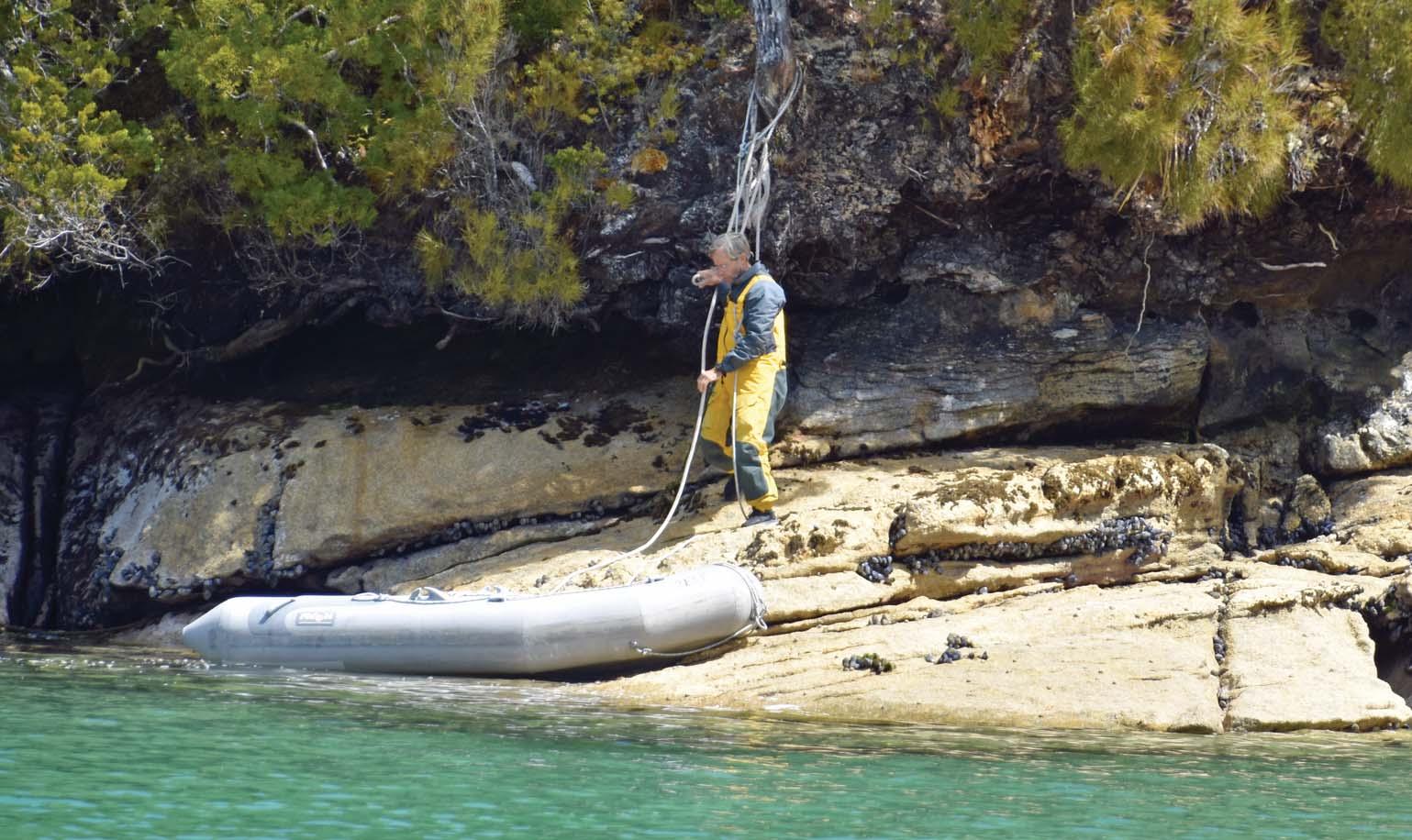
 Vicky and Tom at Evening Cove
Lines ashore at Evening Cove
Vicky and Tom at Evening Cove
Lines ashore at Evening Cove

in peace of mind and sound sleep. Fortunately in many anchorages local fishermen have set up permanent lines, which speed the process.
Along the skyline to the west of the Cove are the high granite outcrops of the Scotch Cap, Gog and Magog. Reaching Magog and returning along a mostly unmarked route is an all-day tramp even for the young and fit. We had previously managed to reach Scotch Cap, and tried again, but after struggling through extensive, head-high tangles of bush we lost touch with the best route and surrendered to nature and fatigue, returning to Zest to lick our wounds, actual and figurative.
Three days later a spell of calm weather allowed us to anchor just off the small creek which leads to the start of the route up to Bald Cone, another granite outcrop. After our failure to reach Scotch Cap we were determined to reach the top this time. The open moorland leading to the Cone makes for easy walking but the Cone itself is more challenging. A smooth, slippery, granite funnel known as the Chute is the only easy route to the summit. Fortunately there are some set ropes along its sides, up which we climbed, pulling ourselves hand over hand. The 360° views from the top in cloudless sunshine were well worth the effort of the climb up and the subsequent nervous, semi-abseiling descent.
 Looking down to Port Pegasus from the top of Bald Cone
Looking down to Port Pegasus from the top of Bald Cone

In the 40s calm, sunny days are often followed closely by howling gales, so we motored the same afternoon to the shelter of Disappointment Cove – justifiably renamed by Gary, our local fisherman friend, as ‘Peacehaven’ after a retirement home in Invercargill. The anchorage is approached through a very narrow channel, followed by a sharp turn to starboard where one faces a large hawser stretched right across between the shore and a small island. With an anchor toward the entrance and lines to both the hawser and the island we were snug from the strong southerlies of the following couple of days.
A short walk from the cove through dripping, temperate rainforest took us to a long, sandy, south-facing beach to watch the swells rolling in. This beach is also a favourite with the local sealions, which do not always take kindly to visitors as Vicky had discovered on a previous visit. They may look ungainly, but sealions can move surprisingly quickly and have unpleasantly spiky teeth. Though we walked the beach unmolested on this occasion, we found on our return that the dinghy was guarded by a young female. After a period of mutual contemplation she came ashore and waddled a short distance into the bush, allowing us to make a dart for the dinghy.
A sealion near our dinghy

We particularly wanted to see Bell Topper Falls at the northern end of Port Pegasus. We passed through the narrow Pegasus Passage and anchored in Water Lily Cove. From there it was a long dinghy ride up the North Arm to the Falls. The unusually dry weather of the summer limited the flow this year – the Falls were still beautiful, but not quite as striking as when we first viewed them in 2000.

With easterlies forecast to set in for a few days we made a late afternoon passage in fast, reaching conditions along the south coast to Abraham’s Bosom near the southeast corner of Stewart Island. The anchorage is a favourite with local fishermen, and the name is a favourite with us. The following day saw us back in Oban preparing for our return passage up the east coast of the South Island.
The generally light wind conditions of our sailing thus far had also meant that we had seen less bird life than usual. Just before our departure from Oban and during our quick, windier passage to Akaroa this changed. We were regularly surrounded by flocks of albatross and mollymawks, much to our delight, which was further increased by the usual escort of Hector’s dolphin near to and into Akaroa Harbour.
Buller’s albatross
 Bell Topper Falls
Bell Topper Falls
Having reached the Banks Peninsula we had only 200 more miles to the shelter of the Marlborough Sounds. However, the conditions were unsettled and the remnant of Cyclone Dovi was on its way south from the tropics. More by luck than judgement we managed to pick a short window of reasonable weather to get us up the coast in moderate reaching and running conditions until, as we approached the narrow, tide-swept entrance to Tory Channel, the fog closed in. We do not have radar on Zest and so pilotage was entirely reliant on GPS accuracy, the sound of waves breaking on rocks and finally on the sight of the shore, uncomfortably close to port. Fortunately the fog lifted somewhat once into The Sounds as we made our way to Waikawa Marina near Picton to sit out what promised to be a very windy and wet few days. The promise was fulfilled, with 50+ knots even in the shelter of the marina. Fortunately the wind direction kept us off the dock and our doubled, and even quadrupled, lines held.


We are firm believers in the Puritan ethic of weather and it applies to almost everything else – you have to suffer the bad to earn the good. Having suffered the storm we were blessed with several days of idyllic summer weather during which we made our way by successive gentle stages to an anchorage in Annie Bay, a mooring in Catherine Cove to await an early morning slack tide in narrow French Pass, and then home to our berth in Nelson Marina.
We achieved our not overly challenging and very achievable target of revisiting Port Pegasus and cruised 1340 miles during eight delightful weeks. We only hope that the Puritan ethic of weather does not catch up with us when we compete in the TwoHanded Round North Island Race which starts in February 2023.

The Mariner having left the vast Ocean, and brought his Ship in Soundings near the Land, amongst Tides or Streams, his Art now must be laid aside, and Pilotage taken in hand. The nearer the Land the greater the Danger, therefore your care ought to be the more.
Being in Tides-ways, narrow Channels, Rocks and Sands, I hope the ingenious Mariner will not take it amiss in recommending this to your care, your Tides, Courses, Soundings, and the goodness of your Compasses.
Captain Greenvile Collins, Great Britain’s Coasting Pilot (1693)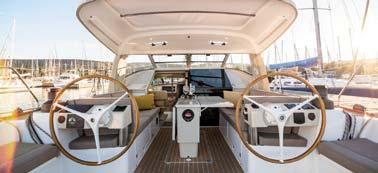
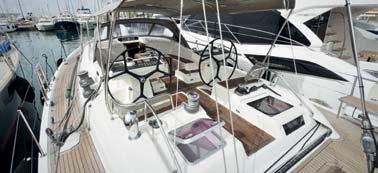

Oyster 655
£950,000 + VAT
West Mediterranean
2008 splash, powerful mile muncher from Rob Humphreys and the mollusc people with a carbon spar, proper sailor’s sailplan and a major nautical makeover in 2022. Built to MCA Cat 2 with fab teak interior and in full cruising trim.
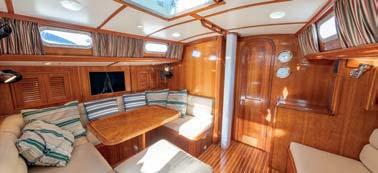
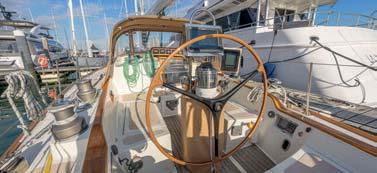



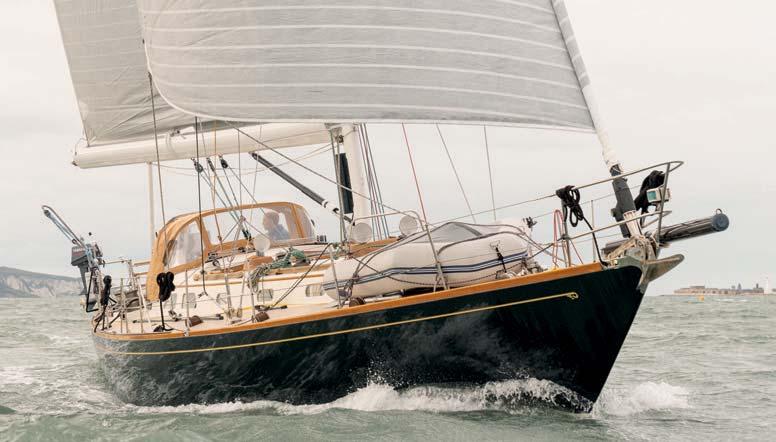
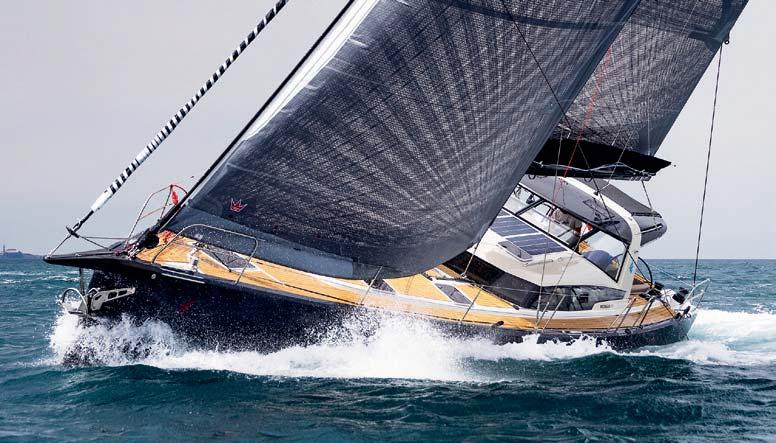
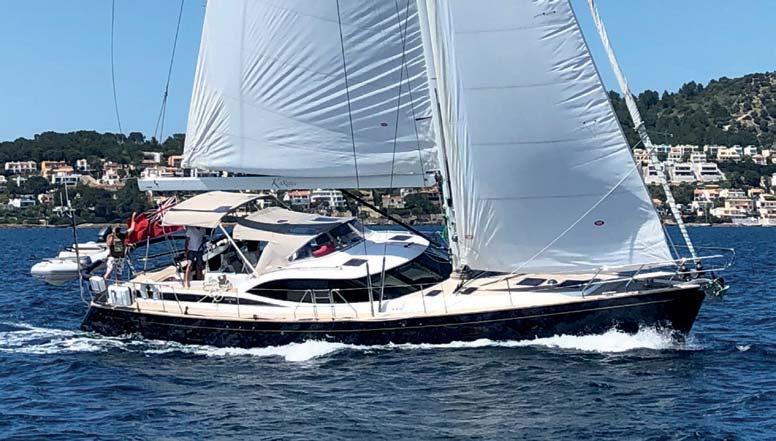

POA
West Mediterranean
topsides livery, Solent rig for easy short-handed sailing, a proper deck saloon and interior watch keeping from which to watch the oceans slide past.
US $435,000 + VAT Lymington
Airex Foam with a Kevlar and S Glass deck, she is of course ferociously quick. Hatched in 1993, new carbon rig last year and Leisurefurl for easy shorthanded.
€1,1150,000 + VAT Europe
New build from the team that brought us the Shipman range, she will be sailing in 2023. Kind to the planet with electric drive. Also comes with carbon build and rig as well as a great deck saloon.























































































































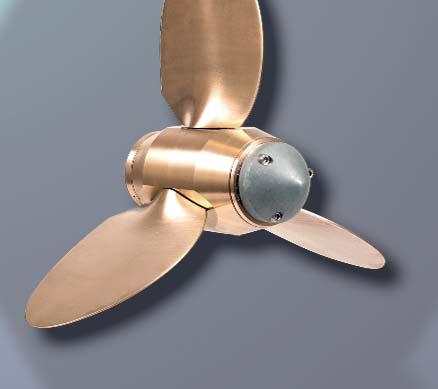

























My name is Bori. I am from Hungary and I am 25 years old. I studied economics at the University of Amsterdam and towards the end of my course I realised that the life opportunities that an economics diploma offers nowadays and my current outlook on life might not be the perfect match, so I decided to travel after finishing my studies. I had it in mind to discover South America, as all the people I met from there were filled with positivity and an appetite for life. However, due to the Covid situation my parents were quite worried, so I decided to move back to Budapest once I had completed my master’s degree.
I took a position working as an assistant in a social research institute which involved watching a shiny computer screen for eight hours a day. From the beginning I felt that this lifestyle was just not for me. I am someone who loves to be active, physically, socially and mentally. I love playing frisbee, football, jamming
 Bori, happy on an afternoon watch
Varuna under power in the Cape Verde islands
Bori, happy on an afternoon watch
Varuna under power in the Cape Verde islands
with my friends, learning to play new instruments and being outside in the natural world under the sun. I had signed a two-year contract so it wasn’t easy to leave early, and my colleagues were good people. But my gut feeling about living a less mundane life was stronger, so after eight months I resigned and decided to travel, despite whatever the Covid situation put in my way. I also had an idea of not flying to South America but taking a more earthbound way of getting there. First I thought of working on a big ship, but I found out that it is quite a rough lifestyle, with 16-hours shifts on most cruise ships ... but what about sailing?
This idea got stuck in my mind. I started looking online, ordered some sailing books, signed up to many crew-finder websites and joined ‘hitch-a-boat’ and similar Facebook groups. This was when I found out about the OCC and its Youth Sponsorship Programme and realised that it might be possible for me to cross the Atlantic on a yacht. I contacted the OCC and their reply was quick and very positive. As my sailing experience was limited and, up to this point I had not yet sailed on the sea, initially they put me in touch with a New Zealand skipper and his crew, who was another YSP recipient. They gave me a lot of information, but as I had already booked a flight to Gran Canaria in the hopes of finding a boat to join, I decided not to take up their offer of joining them to sail from Portugal to the Canary Islands.

Once in Las Palmas I posted an advertisement on the notice board of the famous Sailor’s* Bay Bar, where many others were also looking to find a transatlantic passage, many with much more experience than me. This advert was not a success, but through crewbay.com I got in touch with a German guy with whom I sailed to La Gomera, a 24-hour sail on an 8m boat with lots of wind and heeling over – definitely a new experience. I fell in love with that island, stayed almost two months, then sailed back to Gran Canaria with an English skipper to gain more sea miles.
I realised that, for various reasons, I would prefer to cross the Atlantic on a somewhat bigger boat with more crew, not just me and
* Not a typo – that’s what it says on their website and their awnings!
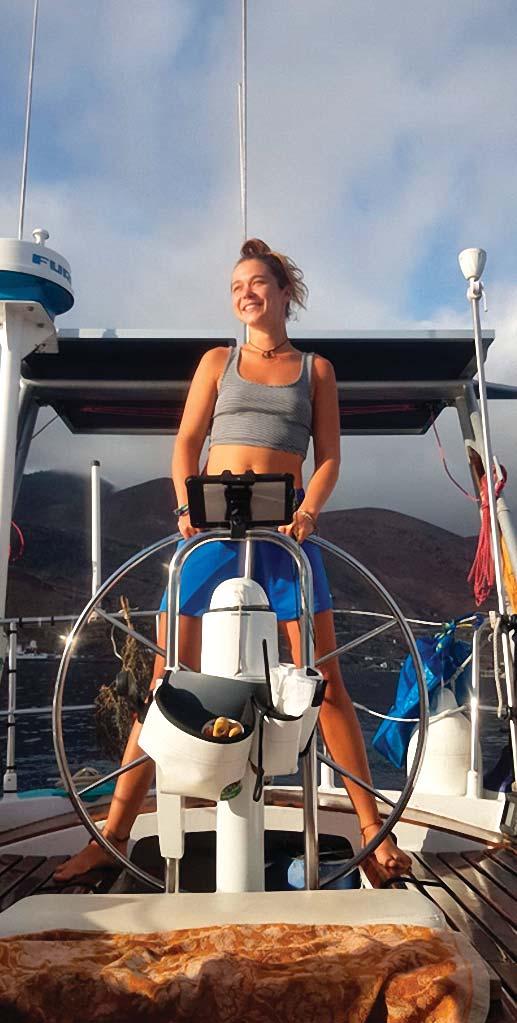
a solo-sailor. Before leaving La Gomera for Gran Canaria we stopped off for a party at Playa da Chinguarime on the south coast of the island. About a month before this I had been contacted by a French skipper who was looking for a fourth crew member, but who then told me the position was full. We did, however, start to follow each others’ journeys on Instagram, and while at anchor in Chinguarime I realised this French boat was in the same anchorage. We went over for a coffee and a chat, but then left for Gran Canaria. Three or four days later I received a message from the skipper, who had had some issues with one of his crew and offered me the chance to join the boat.
I flew back to La Gomera and joined Varuna*, an Ovni 39, three days later. The crew consisted of two French guys aged 32 and 34, and a German girl, who was 33. We got along well, and two days after I moved aboard we left for the island of El Hierro, a single day’s sail to the southwest. We spent a week there and grew closer in that time, and on Christmas Eve left for the Cape Verde islands. It took us six days to get to the island of Sal, my first long, non-stop voyage. Those six days were absolute magic. No internet and beautiful sunrises, sunsets, moon-rises and moon-sets. At one point about
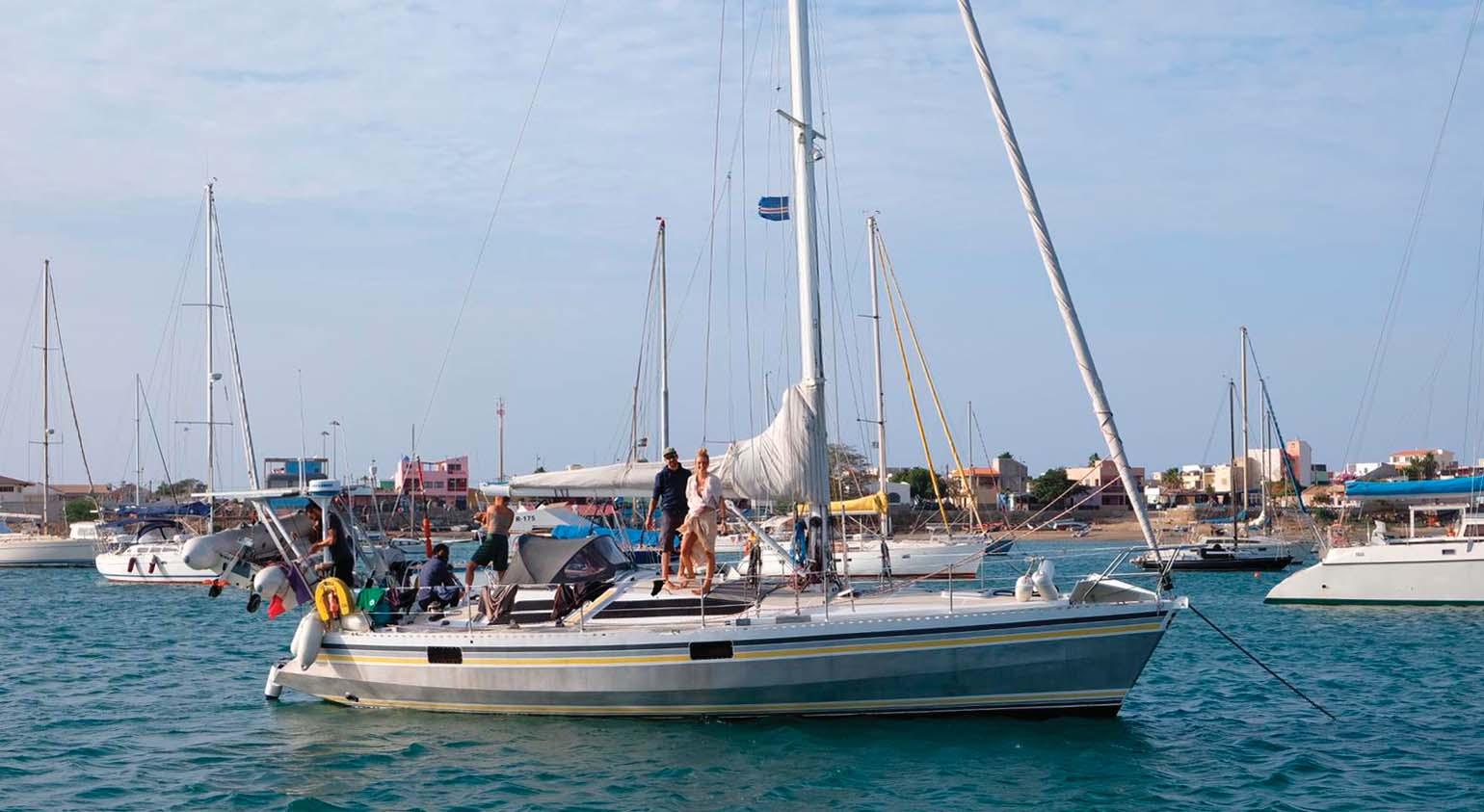
* In ancient Hindu literature, Varuna is the god of oceans and guardian deity of the western direction.
 Varuna on arrival in Porto da Palmeira, Ilha do Sal
Varuna on arrival in Porto da Palmeira, Ilha do Sal
50 dolphins joined us, happily enjoying the waves of our boat. I read much more than ever at home, knotted many bracelets, cooked nice food learning new recipes from the others, and swam in the ocean. The official language on board was English, even though it was not the native language of any of us, and even the two French guys talked in English when it was sailing-related.
We spent about two weeks in the Cape Verde islands, visiting São Nicolao and Santa Luzia as well as Sal, and left for the Atlantic crossing from Mindelo, São Vicente. We had some surprising weather in the early stages of the passage as we did not have satellite communications. We downloaded the forecast for a month ahead before leaving, but of course it changed. We got into some quite confused weather with the wind changing direction all the time, then no wind, then too much wind. At one point we had to turn off all the instruments as there was lightning all around us. These were new experiences

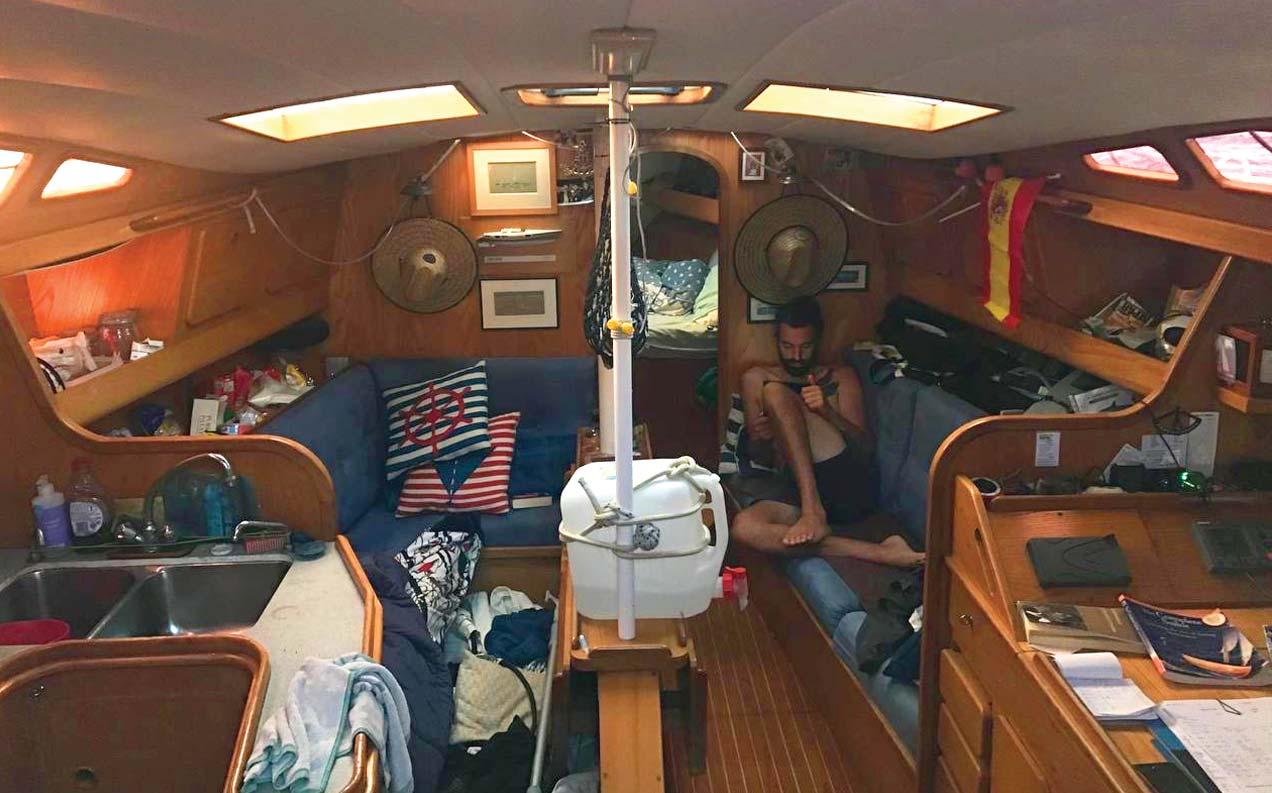
for me, but
I did not get scared as I felt that the skipper was in control of the situation. Later we managed to get a weatherWaiting for clearance in Porto da Palmeira Life aboard – interior mess!
forecast from a cargo ship via VHF and by day 7 we had the expected trade winds, sailing mainly goose-winged and doing on average 5∙5 knots over the ground. I enjoyed the manoeuvres even though they could have seemed monotonous as I learned something new each time.
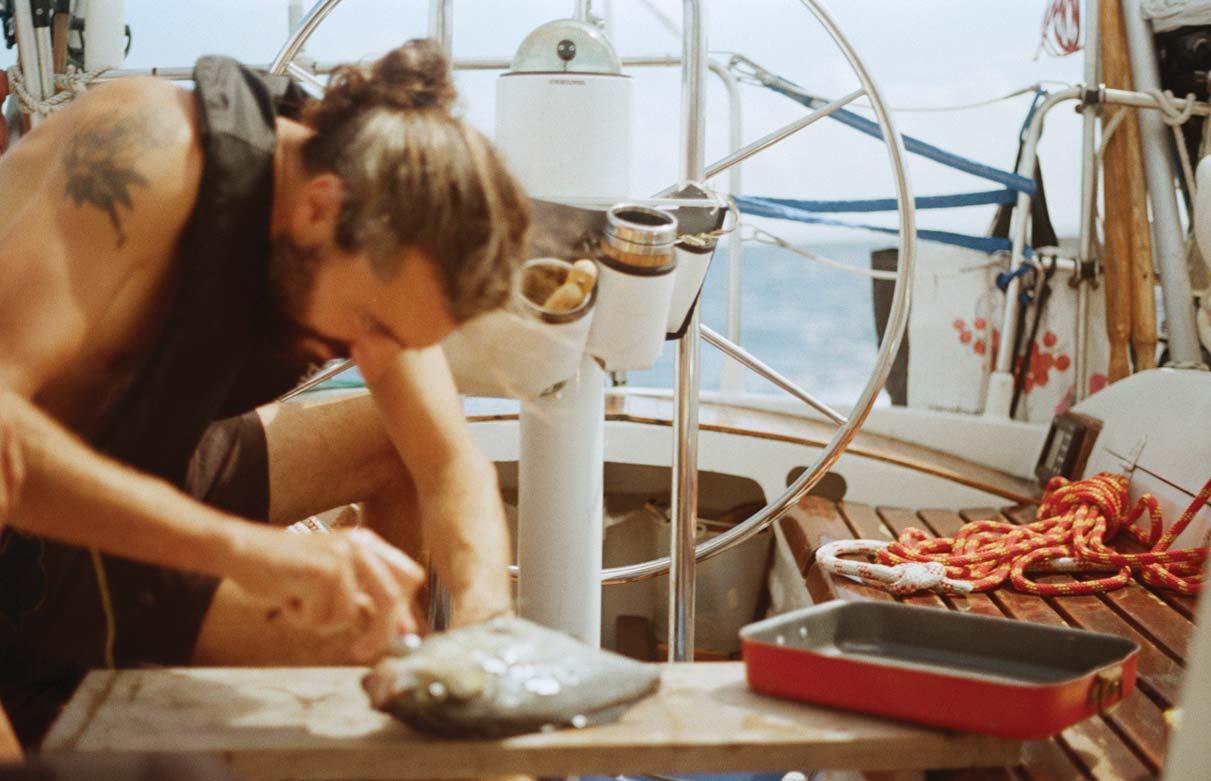
The days of the crossing were beautiful. We had a good routine, playing chess, reading, meditating, learning to play the ukulele and talking, sharing family stories and past experiences. In a way, not having the chance to look at my phone took a burden off me and made me more connected to nature and to the people around me. I chose to have the sunrise watch – it
One of the mahimahis we caught
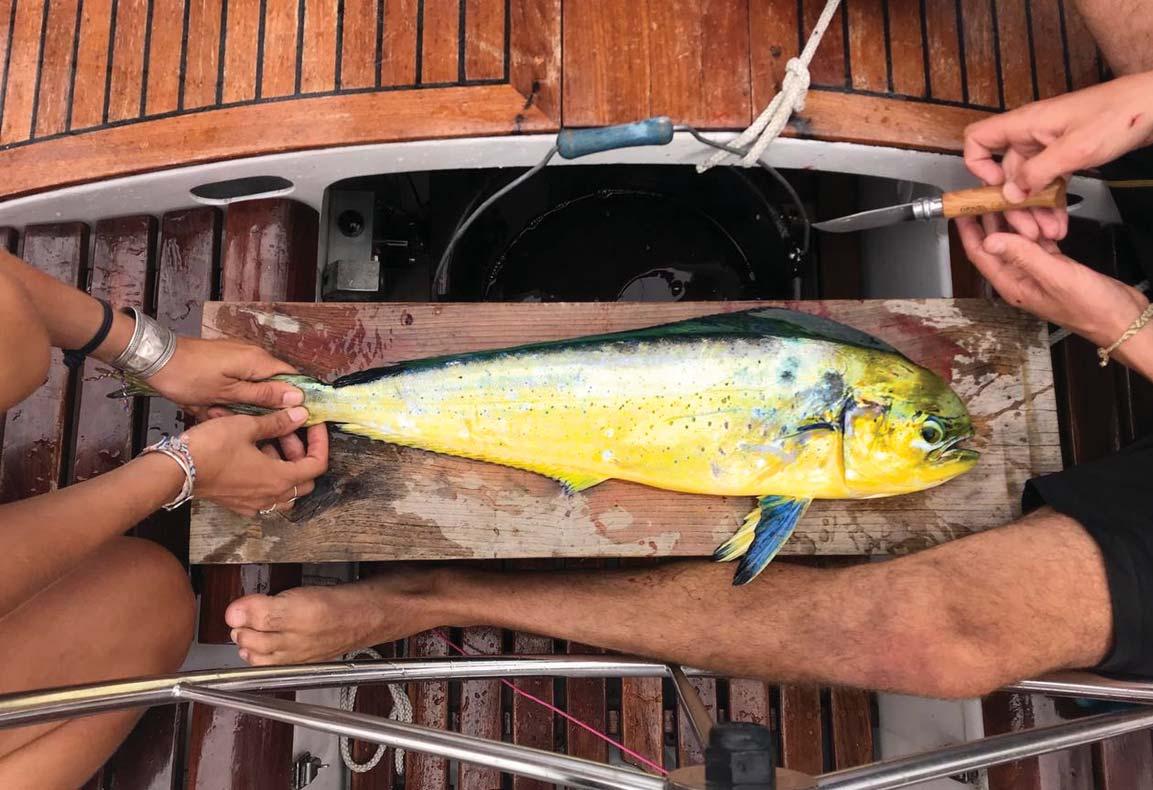
was just astonishing to observe how this shining fireball comes above the horizon every morning in such a different way due to the clouds, wind etc. The transformation from night to day was also something that in a city I did not get to experience regularly. It took us 20 days to reach Sainte-Anne in southern Martinique and for a few days after arriving I still woke at 0100 as my body had got used to having this night watch. It is quite amazing how adaptable our biological clock is.
I cannot put into words the happiness I feel at having taken the decision to change my life. I feel brave and proud. Of course there are moments when I think... Where is my life heading...? What am I going to do next? Is this like a non-stop vacation...? People of my age usually have careers and sometimes families already – my mother had me when she was 22, my grandma had her when she was 23 – but I am different and that is fine.
Pierre preparing dinnerIn the office I used to be depressed and sad sitting at a desk for eight hours a day. Now I was pulling ropes, optimising the sail plan in relation to the wind and the swell, and observing how the sun rises later as we sailed further west. I was outside, under the


sun, the rain and the wind most of the day. I just loved it. It’s a different lifestyle, with many more enjoyable opportunities relative to my needs and not just a vacation. What life will bring after this experience I don’t know, but I’ve learnt so much, including how to approach the unknown with a positive attitude. I might stay in the sailing world or I might just keep on chasing the sun in different ways.
The OCC and the sponsorship I received did much to allow this dream to come true. It took financial worries away from me, which let me enjoy the moment and take good decisions. I am very, very grateful to have had the opportunity to take part in this programme, with Fiona and Rachelle always being supersupportive, cautious and readily available. Thank you, OCC!
Skipper Malo Richard adds: Bori made me aware of the OCC when I offered her the chance to join Varuna. Since I joined the Club I’ve downloaded the app and checked out stories of the members. Reading these stories makes me realise the shared values of exploration within this network of ocean cruisers. What convinced me to join was when she
told me about the Youth Sponsorship Programme. I find it amazing that you offer young, aspiring sailors the chance to experiment with the cruising lifestyle and make an ocean crossing – a truly life changing experience. I would have loved to have had this opportunity a few years back.
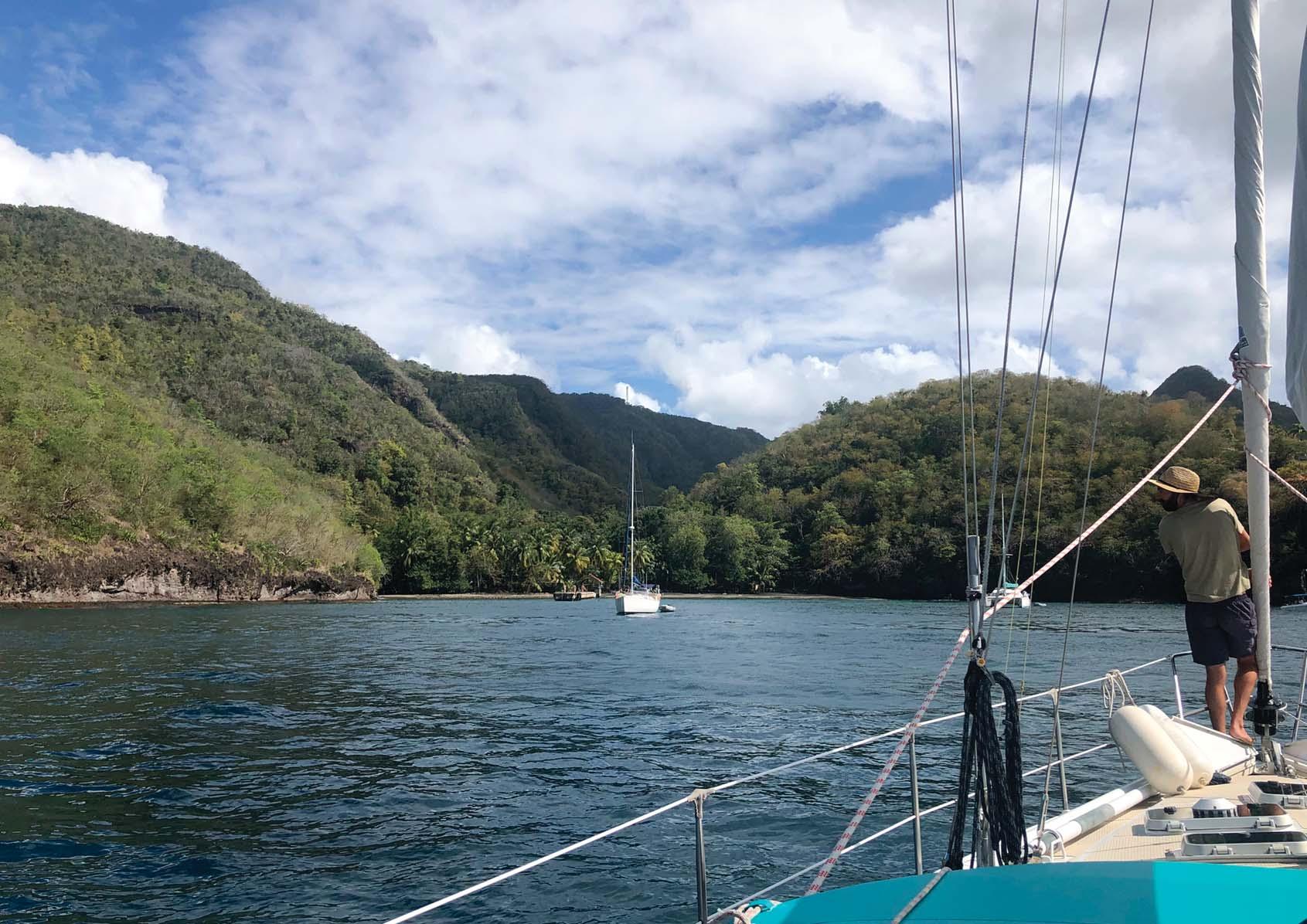
Bori joined the crew in La Gomera. We had met her once before when she was on another boat and it seemed like she would fit perfectly in the existing crew. She had done some coastal sailing but still had very little experience. From the first moment we set the sails she had the biggest smile on her face – you could tell she loved it. It didn’t take her long to find her place on board. She learned fast and was really willing to put herself in an active position on the boat, furling the genoa, trimming the main etc. After our first passage she understood a lot about the boat and kept asking for more information. Unfortunately I’m not the best teacher!
By the time we reached the Cape Verdes I knew she was a good person to have on board for the crossing. This was very rich in terms of learning for everyone, on both the human and the sailing side. We went through all kind of weather from thunderstorms two nights in a row to no wind at all. We finally found the trade winds but they were not very well established. After 19 days and 2080 miles we reached Martinique, where we could finally rest under the sun and enjoy the local rhum and acras (local fish fritters).
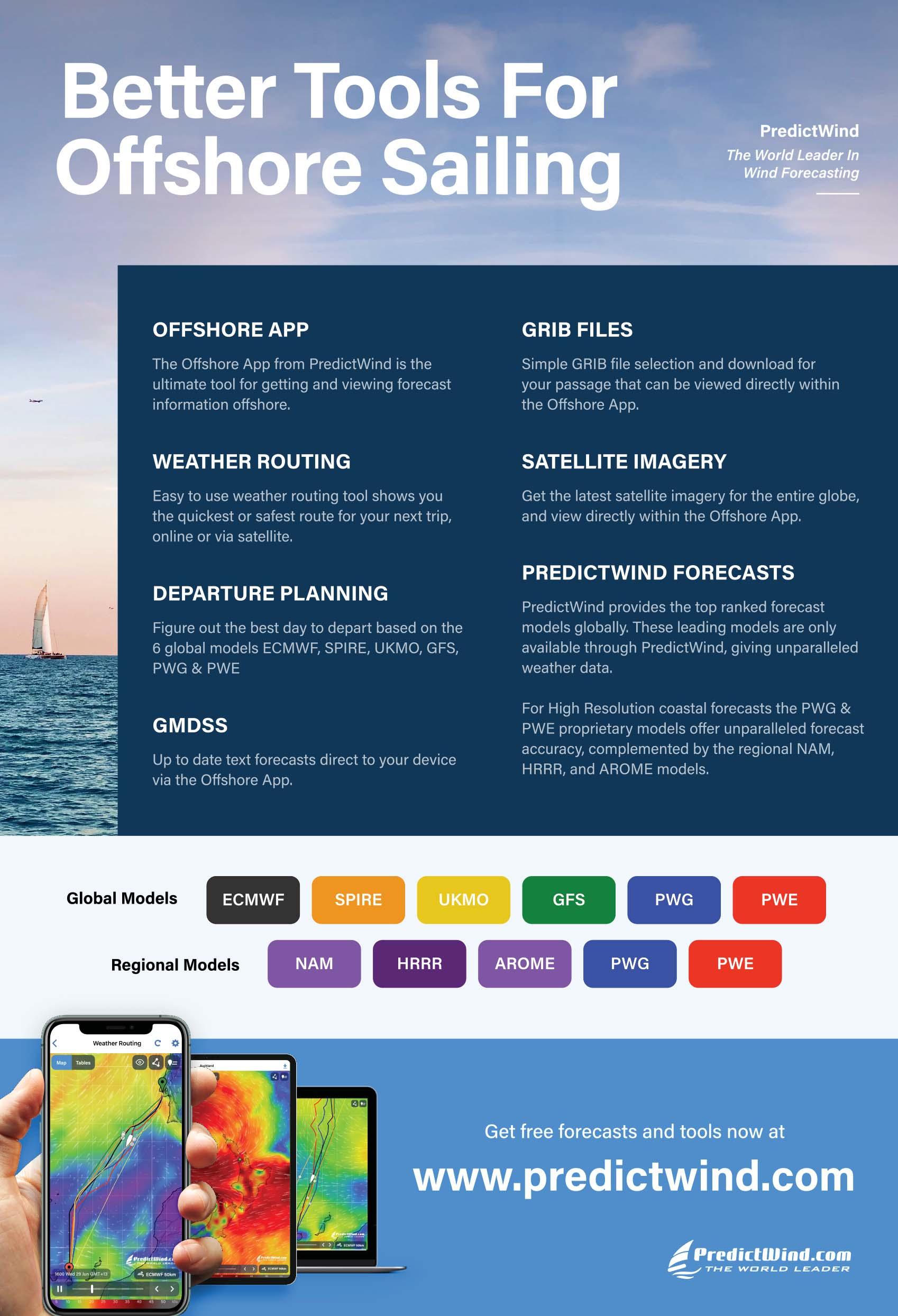
Liveaboard cruising, and travelling across oceans to far-flung places without a long-term plan has many unexpected consequences. Over time what started as a means of fulfilling a half-imagined dream becomes a home, a sanctuary, a defence against wild elements, a place where you belong. Your boat becomes part of your family. Consequently, when the time came to part company with Three Ships, our Gitana 43 and home for 14 years, with which we had travelled over 96,800 miles and shared many an adventurous passage with family and countless friends, it was not easy. She is a vessel destined to be forever on the move and the thought of her sitting in a marina for years on end was not an option. Fi and I agreed that her next owner had to be someone exceptional.
The e-mail from Shaun – who at the time was working as a construction engineer in Kazakhstan – stating that he had seen Three Ships was for sale and wanted to buy her, looked a bit sketchy to say the least. However, when he told us that one of his lifelong sailing ambitions was to join the OCC, we began to take notice. So we asked him to tell us a bit about his background, to get a flavour of who might be her next custodian. This is what he told us:
“I’ve worked in 37 countries and sailed for 40 years. My main qualification in life is that I love it. I have driven trucks from Scotland to Tashkent, fallen asleep and broken my body. I sailed a Laser from Dover to Calais when I was 11, got arrested, was collected and came home to a severe telling off! I have built two hovercraft with lift ability of 6000kg. As a construction manager for contractors in the world’s largest oil and gas project, I was instrumental in the rock piling project for Kashagan oil field riser island in the Caspian Sea. I love motorbikes but I am too crazy to ride them, which is why now I want to live on Three Ships. There’s only one problem – I haven’t got any money”.
That was back in 2018. We met, did a deal and became trusted friends. There are few people in the world I judge as more dependable, equally mad at times, but more likely to fulfil a promise.
Shaun met his wife Ainur when they worked together at the Future Growth Project in the Atyrau region of Kazakhstan, where she was working as a trilingual translator. She has a degree in Finance and Economics from the Kazakh British Technical University, where she followed her course in English. She speaks Kazakh, Russian and English fluently as well as some Turkish and Spanish. They make a great team.
In many ways Shaun and Ainur’s adventure epitomises what I valued most when I joined the OCC 30 years ago and still value today.
Over to Shaun to hear what happened next:
In March 2022 Ainur and I and our beloved Three Ships set out from Panama heading via the northern route to Papua New Guinea (their route can be followed on the
Light wind sailing – the calm before the squall
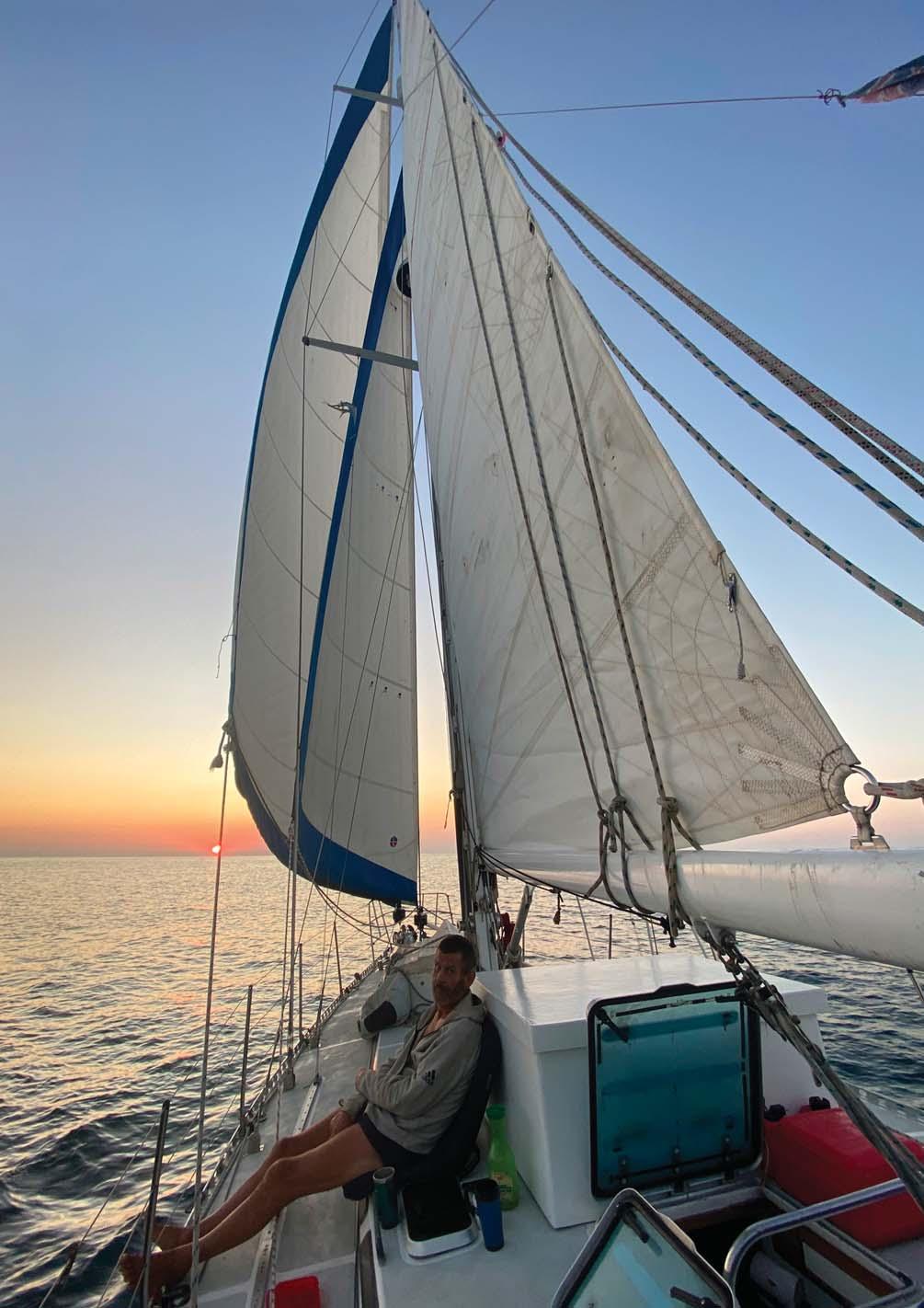
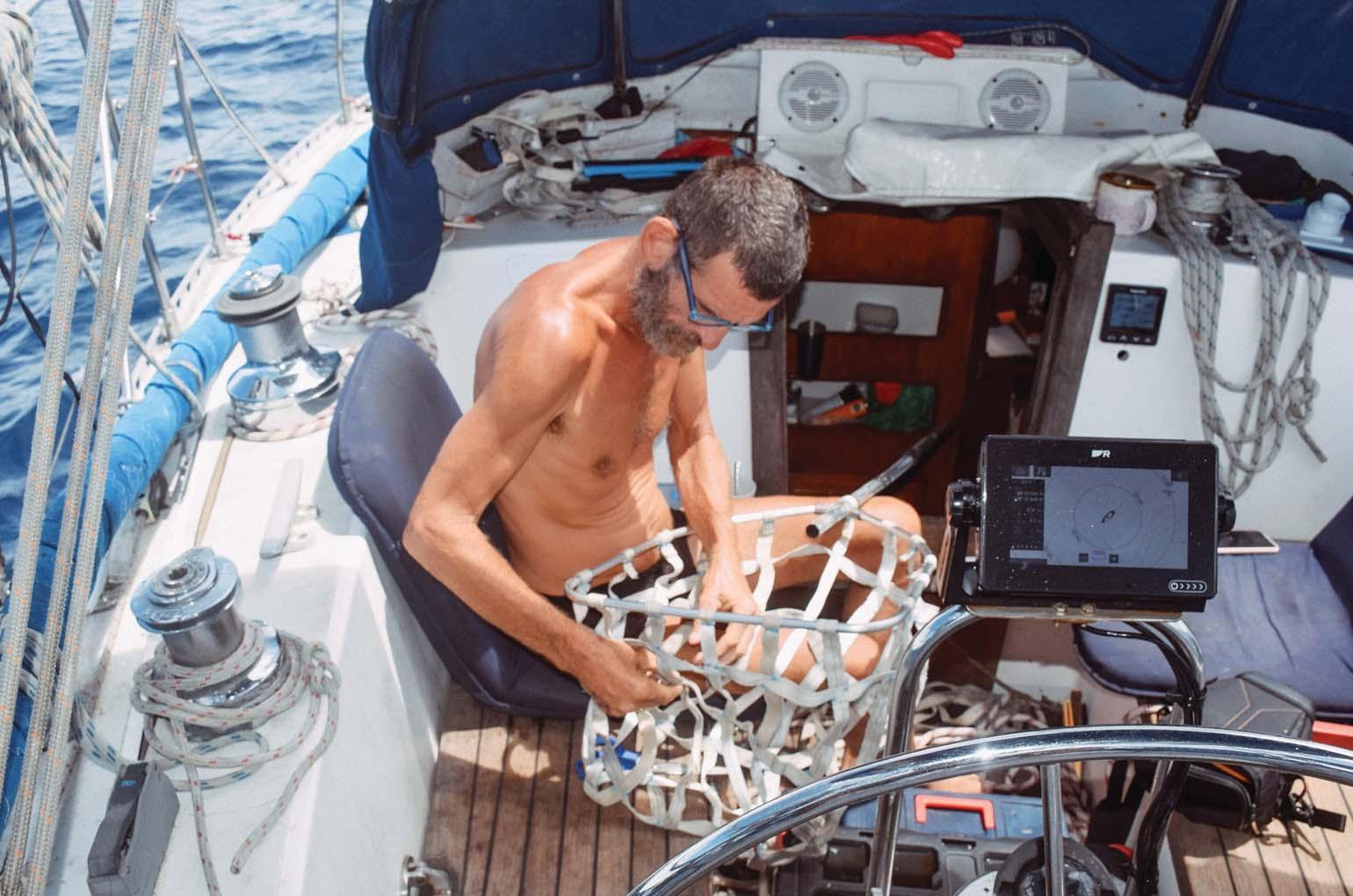
chartlet on page 38). It may seem like a strange way to go, but with all the chaos in the world at the time following the Covid travel restrictions we decided it would be the least stressful way.
We set off with a beautiful 20 knot northeasterly and enjoyed two days of great sailing. Sadly that was where it finished – the wind died completely and we ended up motoring north to try and find it again. It became apparent that we were not going to have enough diesel to continue with this strategy, so we resorted to drifting and trying to sail when even the slightest breeze appeared.
Shaun constructing a tuna landing netAfter three weeks of this we decided to pull into Costa Rica for fuel. This did not go well. We were refused entry, so anchored off the beach and made a deal with a local fisherman who, for the grand total of US $90 made three trips with our cans so that we once again had full tanks. We raised the anchor bright and early with the hope of finding some wind. Many phone calls and messages had bounced between us and Chris and Fi regarding weather and current information, and after some motoring and some more drifting we found a bit of wind at around 12°N. After that things went well for a few days, even though we had to dodge north and south to keep the wind.
Success!
We had been eating mahi mahi and both fresh and canned tuna for quite some time, which was all lovely, but we were looking forward to one of our three safelystowed frozen steaks for two months. We had brought them from Panama – one for the Equator crossing, one for the International Date Line and one for the ‘500 miles to go’ point – so having the first one was a delight as well as a milestone. We crossed


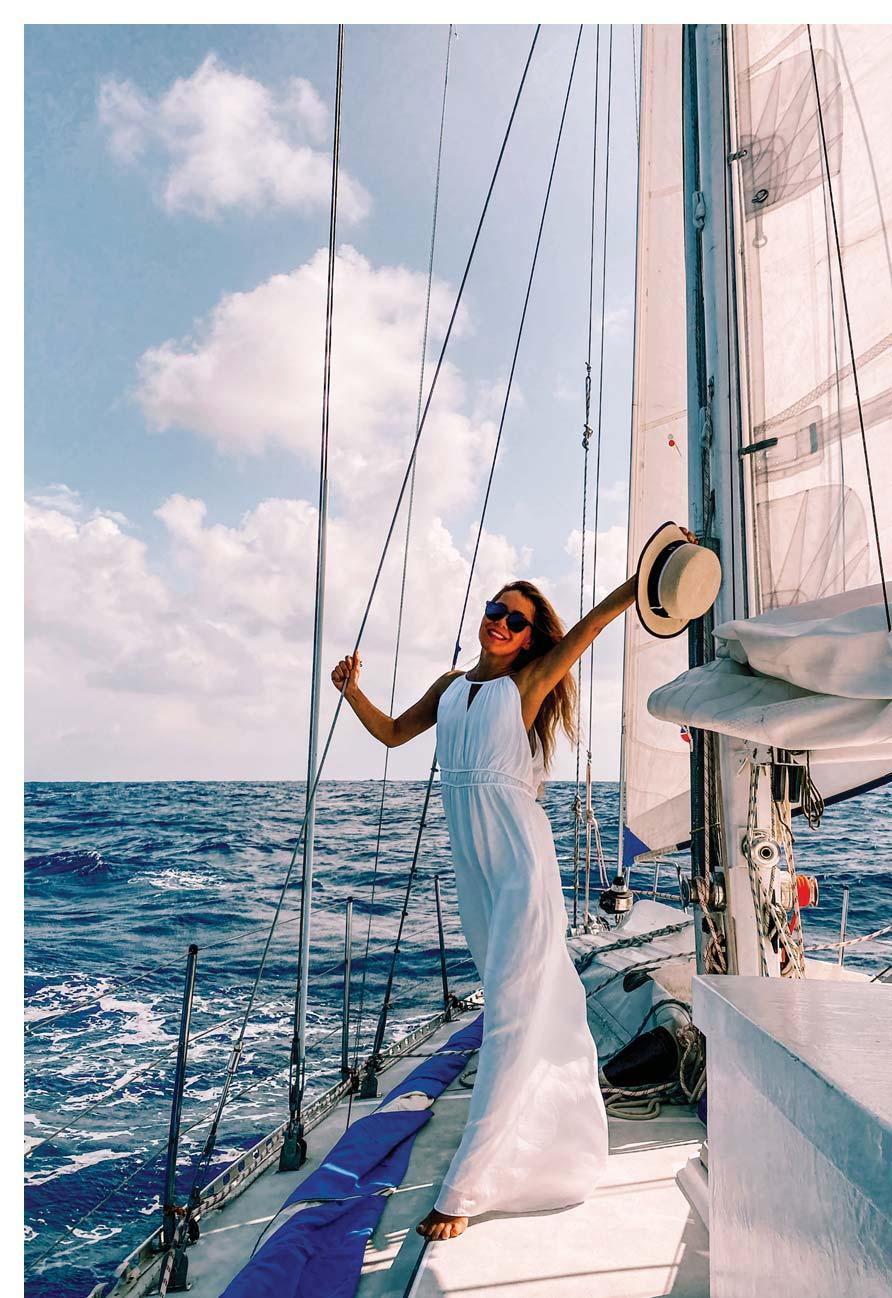
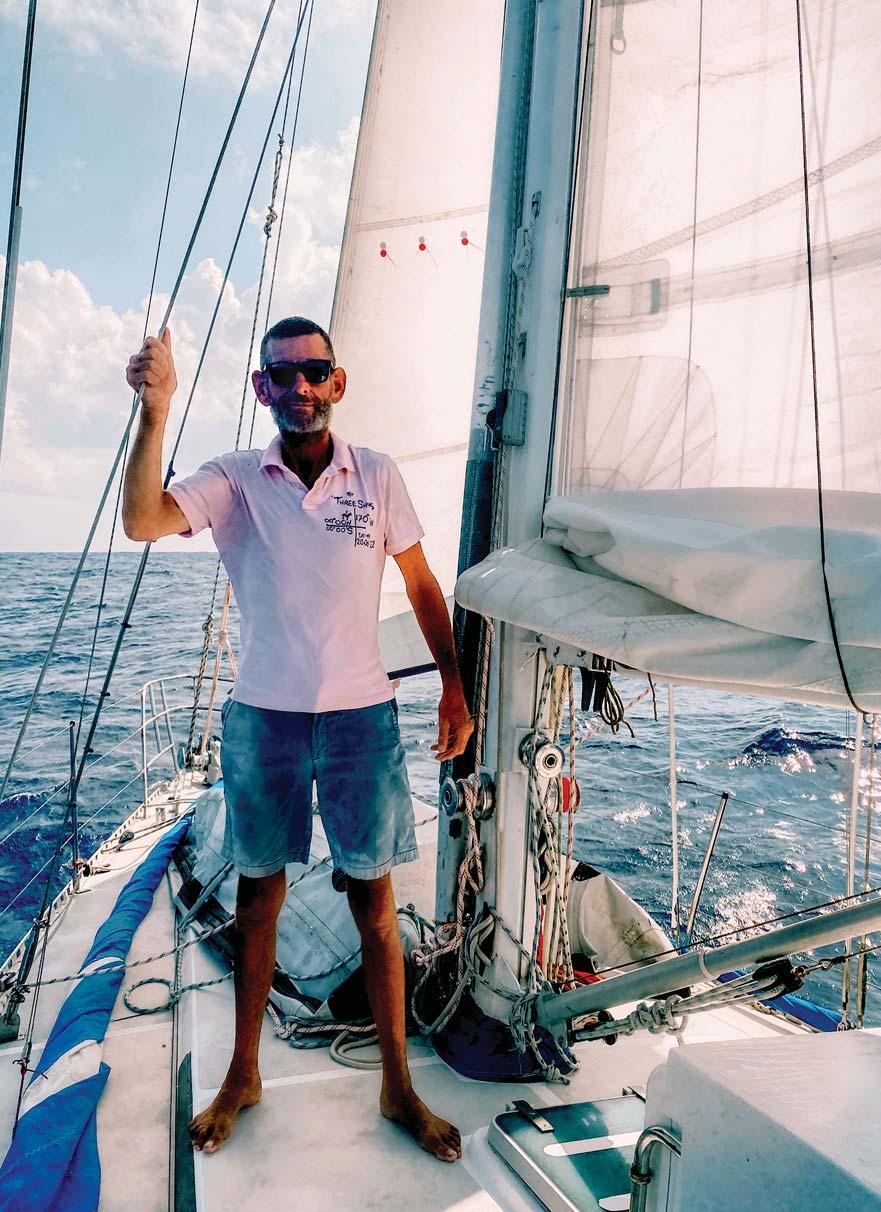
the Equator at approximately 170°W and, having enjoyed our feast in light airs, Ainur decided to mark the occasion by dressing up for a brief photo shoot to post on Instagram once we reached land. There were a few other surprises along the way. I was unaware that Ainur had hidden cans of beer for me for special occasions – she never told me how many she had or where they were hidden and they always appeared when I least expected it. Those six cans of beer along the way were the best I have ever tasted! (I had decided not to take any beer or rum with us to give the old body a break.) We also had a tub of 100 lollipops, allowed on special occasions with a list to make sure we had 50 each. Somehow Ainur beat me though, as she ended up having ten more than I did!

Unfortunately the pleasure was soon snatched away from us as the weather went from a steady 15 knots to absolute zero and once again we found ourselves drifting. When you get to the point of celebrating covering 30 miles in 24 hours you know it’s going slowly! We pushed on, finally picking up some wind at around 7°S, but unfortunately with the new breeze came significant squalls. One particularly nasty one caused an accidental gybe, at which point the preventer snapped and all hell broke loose. I couldn’t get the boat back under control as there was no feeling on the helm, and a quick look below found that the tie rod between steering box and rudder had let go. This was not good news, so after a mammoth effort we wrestled the mainsail down, secured it and furled the genoa.

I squeezed myself down behind the engine into the steering bay to see what could be done and, after being thrown around as though I was in a washing machine, finally managed to temporarily secure the rudder. Feeling very bruised and very tired I decided that we would just shut the hatches and get some rest. Leaving Three Ships to her own devices, we waited for the calm to arrive which it did and not at all too soon. I returned to the cramped steering bay and, in calmer conditions, started to assess the damage and make amends.
The steering tie bar had spun round, crashing into the cockpit drain pipe and cracking the joint where it exits through the stern, allowing water to leak into the engine room. The leak was relatively slow even when the squalls were at their worst, but it still caused concern of the brown stain variety. I used some water-activated fibreglass to stop the leak – now all I had to do was to resolve the issue with the tie bar! I thought it would be easy enough for an engineer as adaptable as me to simply weld it back together with a splint on the side, but that was not to be as my pack of welding rods had, at some point, succumbed to water from who knows where. For those few days it felt like we had challenges coming from all directions.
After some head-scratching and fiddling I fashioned a new tie rod which, I am amazed and pleased to say, held all the way to PNG. I also drilled a couple of extra holes and fitted a soft tie link so that if the tie rod were to fail again the rudder would remain attached, as opposed to being free to swing through 180°, risking the loss of fingers whilst securing it. Unfortunately, another by-product of this catastrophe was a smashed autopilot gearbox for which, through an oversight on my part, we had no spare parts. It just hadn’t occurred to me as we hardly ever used it, favouring the Monitor wind vane unless we were dead downwind in light winds or under power.
Once we had got ourselves reorganised and were continuing our passage, the next adventure started with a loud banging from on deck as the forestay had parted, probably as a result of the earlier hard gybe. After a lot of swearing and grunting we retrieved the genoa and furler from over the side and secured them around the deck – not the best
We left messages for each other at change of watch...
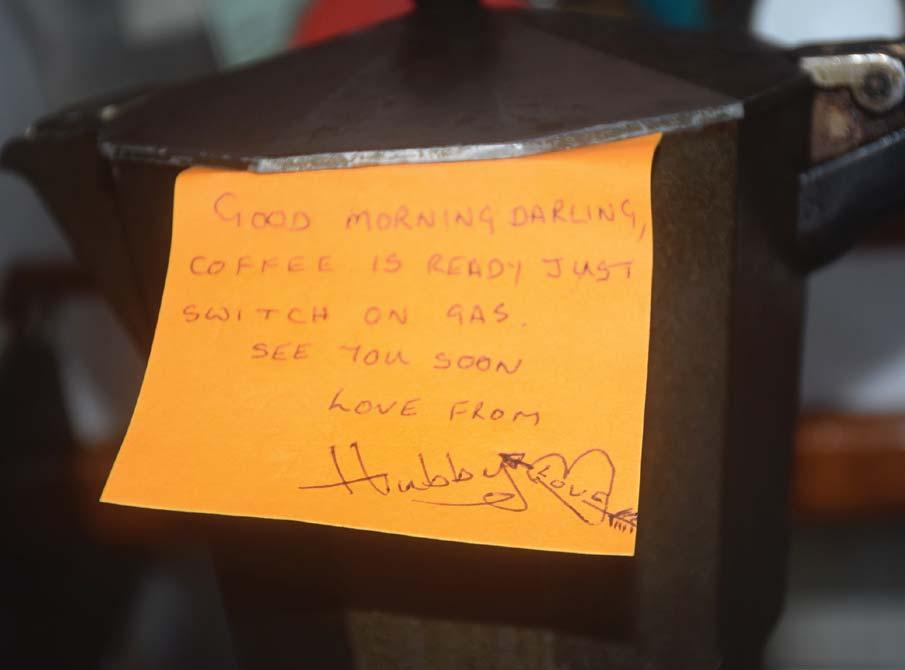
news considering we still had about 2000 miles to go. After some calls with Chris he suggested a new idea, at least in my book, of rigging the whiskerpole to sail goose-winged using the staysail and main. This worked very well and after a couple of tweaks that was how we continued.
Then we had the problem of trying to persuade the Monitor to steer Three Ships as, after the damage to the steering box, there were a couple of tight spots and at such low speeds the Monitor couldn’t generate enough power to turn the wheel. We resorted to hand-steering, taking watches, which started out, as most things do, running well and following a steady pattern. Ainur didn’t like the constant up and down every three or four hours, however, and suggested we do twelve hours on and twelve hours off, which actually worked well for us. She did the nights and I did the days – no problem apart from a couple of moments in heavy squalls when in her words she was ‘Schumachering it’, loving the speeds and getting super-excited, which was great to see. For the final 43 days of the passage that was how we handled the boat and it worked very well. Ainur continued cooking and I pumped water out of the engine room, as another problem we had was an old issue with Three Ships whereby the lower rudder bearing seal weeped a little. During our earlier fiasco the stuffing box had obviously been disturbed and it was now leaking more seriously, requiring pumping out for about three minutes every six to eight hours.
All too soon for Ainur, but barely soon enough for me, we were reaching the end of our journey. I was looking forward to having some beers and she just wanted to keep going, but on this occasion I won ... hee-hee-hee!! We had already organised visas through friends in PNG and Chris sent us some useful waypoints to help us get into the harbour at Port Moresby ... and then the games with Customs and Immigration began. A little part of me could see their point: Why would anyone choose to sail our route? Why would anyone sail from the drugs capital of the world to PNG and only switch on their AIS every 12 hours or so? Needless to say they had a very comprehensive search of the boat and tested every substance they could find, and in the end all was fine.
Naan bread cooking
All in all it was a great trip. I obviously wish we had suffered less damage, which would have made it significantly quicker, but that said we were not in a hurry. We had plenty of food and plenty of fun catching fish. Our Spectra watermaker didn’t miss a beat the whole voyage. We had made contingency plans for cooking gas and we still had enough for about two weeks left. Ainur’s willingness to adapt to ocean cruising was brilliant and I would not have wanted to make the passage without her. She was beaming when the realisation of what we had achieved sank in properly and she realised she could now become a full member of the OCC as well as being a member of the Royal Welsh Yacht Club, so all is well in our world.
Once at anchor outside the harbour and before the games with Immigration and Customs began, we made contact with Port Officer Representative Brian Hull, whom we had previously contacted for local information. I asked him how much trouble it would cause if I put the dinghy in the water and popped to the supermarket, and he replied stressing that this would definitely be a very bad idea. He said that instead of this he would ask his boatman to come out and get a list and he would pop to the supermarket for us. When I explained that I didn’t have cash with me he volunteered to pay for the groceries and beer, saying that I could pay him once we were inside and settled. This was a very kind gesture and to me epitomised the spirit of the OCC –like-minded people wanting and being willing to help. Thank you Brian, that cup of tea with fresh milk and sugar was much anticipated and it did not disappoint!
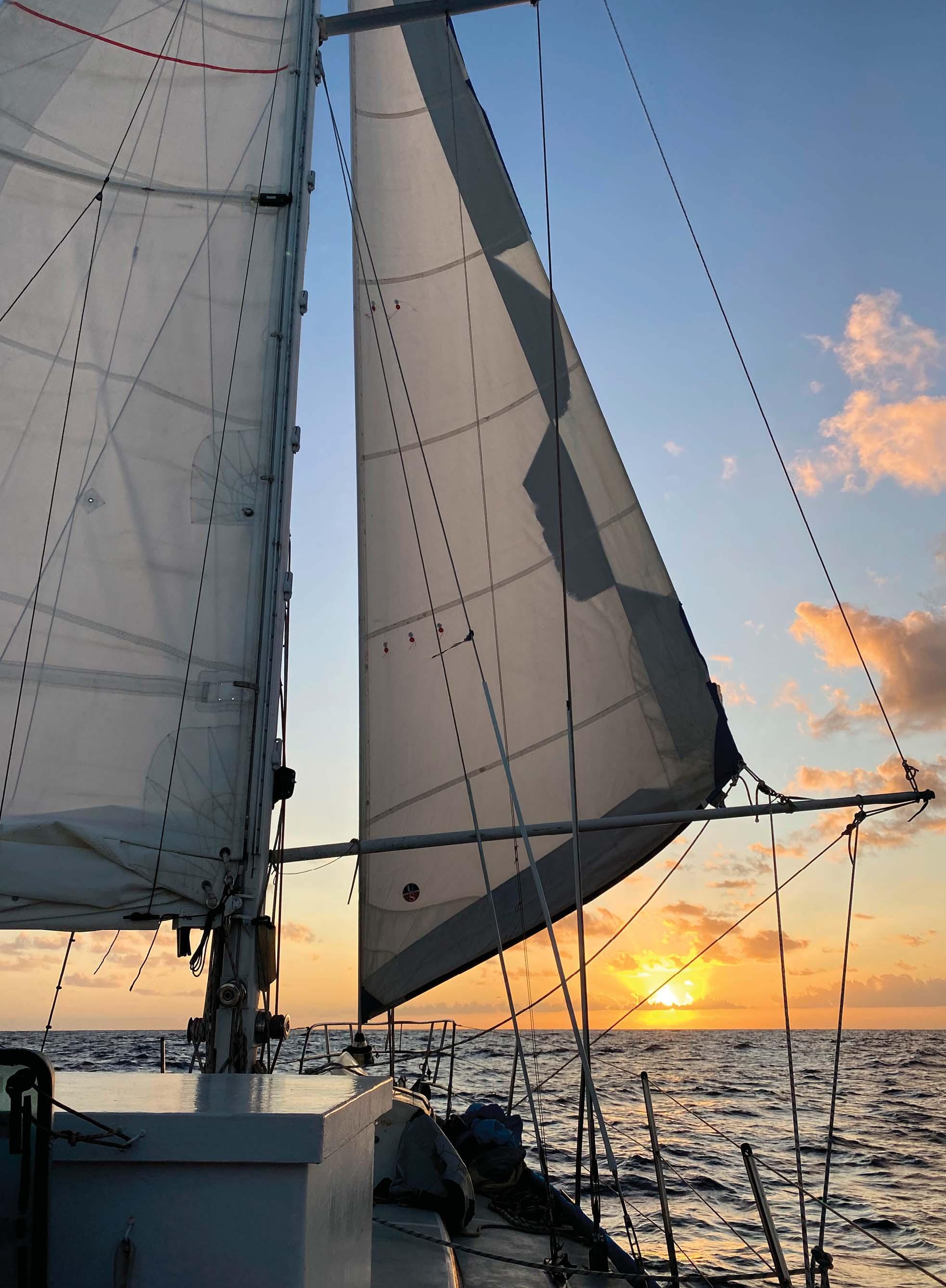
Ainur’s account completes the picture:
Three years ago my husband Shaun introduced me to sailing and the cruising life. It was a little strange to start with, but I soon fell in love with this new way of life.

After three years of ‘contemplation’ and wondering how far I was prepared to go with my new found love, I have cruised the Caribbean from Antigua and now crossed the Pacific Ocean aboard Three Ships. We spent 4½ months sailing 8900 miles non-stop across the ocean from Panama to Papua New Guinea, crossing the Equator and the International Date Line, and on day 144 we reached Port Moresby, PNG.
I am so grateful for this once-in-a-lifetime adventure! During the crossing I experienced wonders that cannot be seen with physical eyes but only felt. Sunrises and sunsets, with rich shades and palettes which cannot be conveyed in words but only on the canvas of a great artist. I was amazed at just how many millions of stars light up the night sky, how the ocean glows for a few nights after a full moon, how the dolphins swam up to us in the morning and at sunset, how fish and birds hunted intensely at the same time each day, how the ocean lives its life whether we are there or not.
Whilst I was prepared physically for the journey, I think that nothing could have prepared me for the mental aspects of our trip. I felt very humbled to be on the ocean for such a long time but also every day, in one way or another, it brought even more wonder. I started out with the same feelings I had experienced when we completed passages before, but the longest ones for me so far had been a matter of a few days and I had been quite happy to step ashore and experience the new sights. This time I just didn’t want the voyage to end – I have never felt such complete calm inside me even though we had some very difficult moments.
This was my first ocean passage and first experience of planning for weeks and not just days at sea, and I would definitely do it again given the opportunity. Wonderful, fantastic, incredible, hard ... but I loved it all.
On being asked ‘what next?’ Shaun replied: When we arrived here we were planning to pick up some work and then head on, but that’s taking longer than anticipated and the boat is still in need of TLC. We’ll be away from here soon though, even if we fly out to do temporary contracts elsewhere. The next stop for Three Ships will be Langkawi in Malaysia for a complete refit, but not this week...

– Ian Nicolson (previously published as Understanding Yacht Design). Published in soft covers by Fernhurst Books [www.fernhurstbooks.com] at £15.99. 96 170mm x 240mm pages with dozens of the author’s very clear line drawings and diagrams. ISBN 978-1-9126-2144-6. Also available for Kindle.

There are many books on yacht design – indeed Ian Nicolson, author of Introduction to Yacht Design and a Founder Member of the OCC – reviews Principles of Yacht Design on page 93 of this issue. Most, however, assume some prior knowledge of the subject, or possibly that the reader is studying the subject at university. Ian does not. Indeed, when sending me the previous edition back in 2003 he insisted it be reviewed by someone with ‘no design knowledge at all’, making me the ideal candidate. I’m assuming that instruction still holds good.
How many readers of Introduction to Yacht Design will go on to design their dream boat and have her built (or build her themselves) is open to question, but what is not is that, by studying this book, almost any owner will gain a far deeper understanding of why their boat behaves as she does and how, possibly, to improve it. Unfortunately even a basic set of lines may not be forthcoming for a production yacht, but should detailed plans be available this book will allow the new or less-experienced owner to extract the maximum amount of information from them.
Introduction to Yacht Design is divided into four sections: How to Begin, Designing the Yacht, Making Alterations to a Design and Computer-Aided Design. There is also a useful Glossary and a Bibliography which includes both design classics and some of Ian’s other books devoted to specific topics.
Part 1, ‘How to Begin’, encourages the reader to think deeply about what they want from their potential yacht – the old saying that ‘every yacht is a compromise’ is never truer than at the design stage. Ian, who has been involved in yacht design since he started his apprenticeship during the Second World War, also goes into the practicalities of drawing lines on paper, even recommending the best pencils, paper and lighting for the task. Computer-Aided Design (CAD) is discussed separately near the end.
Part 2, ‘ Designing the Yacht’ guides the reader through drawing lines, weight and displacement, and the relationship between design and performance. While never condescending, at no time does Ian forget that he’s writing for those with little or no prior knowledge of yacht design. A certain amount of maths is unavoidable, but Ian keeps this to a minimum, provides clear explanations when necessary and frequently backs these up by simple rules-of-thumb. Perhaps mindful of those struggling to keep up with the more technical aspects, Ian drops in the occasional visual joke, as on page 27.
Discussing sails, as well as calculating the area required to drive the boat, Ian recommends a thoroughly practical approach to deciding the maximum area of any single sail – to think about who will have to handle it. Will it be ‘a fit experienced man’ (46m2 / 500ft2), ‘someone who leads a sedentary life’ (35m2 / 375ft2) or ‘children and creaky pensioners’ (23m2 / 250ft2)? An eminently sensible if slightly broad-brush guide that this reviewer has never seen elsewhere.
For many new yachts the engine will be the single most expensive item, a subject also relevant to owners of older yachts considering replacement (my own 54-year-old boat is on her third engine). Having packed the essentials into six pages, Ian directs readers to the Bibliography for further, more detailed, study. Interior layout includes sage advice against attempting to reinvent the wheel, while discussion of the deck plan places the main emphasis on creating a safe working platform but also touches on ventilation, so essential in a cruising boat which may visit the tropics. Rounding off Part 2, Chapter 13 (is this by chance?) outlines how to cost up the building of a nascent design, whether amateur or professionally built, including a reminder to include overheads in the former.
Part 3, ‘Making Alterations to a Design’ primarily covers altering the sail plan, perhaps to make the yacht easier on the helm or to improve sluggish performance. Designing alterations to both deck layout and interior are also covered, though personally I’d have put Ian’s ‘Basic Rules for Designing Alterations’ on page 1 – that ‘what works in harbour may be dreadful at sea’, ‘arrangements, materials and fittings for houses and caravans are often a disaster offshore’ (I’ll never forget encountering a narrow, rolly Nicholson Jolina, refitted for an Atlantic crossing with B&Q rolled-edge worktops in the galley and no fiddles), and ‘it often makes sense to copy another successful small craft’.
Part 4 consists of a single chapter discussing the pros and cons of Computer-Aided Design (CAD). While the entire book has been updated since the previous, 2003, edition, it is particularly true of this final chapter.
When I reviewed this book under its previous title nearly 20 years ago, I criticised the way that all too many of Ian’s line drawings and diagrams had been stretched over facing pages, making them – and sometimes the captions – difficult to follow. I’m delighted to say that the publishers have corrected this unthinking error and the design and layout of the new edition cannot be faulted. To paraphrase myself of 19 years ago, the publishers have corrected the only real fault in this otherwise excellent – and sensibly priced – book, which I can recommend without hesitation to all curiousminded OCC members.
THE COMPLETE OCEAN SKIPPER – Tom Cunliffe, 2nd edition. Published in hard covers by Adlard Coles [www.bloomsbury.com] at £32.00. 272 177mm x 246mm pages, with many colour photographs and diagrams. ISBN 978-1-47291813-0. Also available for Kindle.
Tom Cunliffe’s latest edition of The Complete Ocean Skipper encompasses all the necessary knowledge, attributes and skills needed for successful ocean voyaging.

Published by Adlard Coles, it is a well-presented book with excellent layout, quality photographs and graphics. Cunliffe is a popular author with years of sailing experience and a well-honed style of writing that produces an enjoyable, informative and accessible read. Inevitably with such a vast topic it must be a reasonably top-level approach, but with illustrative grass roots examples the salient points are well established.
There are three main sections starting with The Offshore Yacht. This describes the wide choice of hulls, rigs and steering available alongside accommodation issues. Also included are engines and electric systems. Having selected our ideal yacht, we move on to the largest section, concerning Ocean Navigation and Deep-Sea Seamanship. Naturally, weather considerations and dealing with extreme conditions feature here, allied to their importance in general passage planning. There are informative sections on charting and great circle sailing, with pragmatic solutions to passage execution.
Whilst no Luddite, Cunliffe’s obvious passion for traditional themes seeps through, nowhere more so than in the 30 pages devoted to celestial navigation, longer than the entire section on Life On Board. His justification is that by learning all the underlying theory you will be able to move on into the wonderful world of star navigation. I believe that a simple tabular routine to gain a position line with nothing more demanding than addition and subtraction, certainly nothing as terrifying as dividing, would provide sufficient fallback for anyone in the unlikely event of GPS failure.
Further topics include systems management, which fundamentally concerns monitoring electricity, fuel, gas and water usage – an important issue on long passages, especially with inexperienced crew unused to limited supplies. The section concludes with Extreme Emergencies, covering such events as man overboard, steering failure, mast loss, flooding and other undesirable occurrences. Abandoning ship is the worstcase scenario for any sailor and attending an RYA Sea Survival course is recommended. I would thoroughly endorse this.
The final section concerns Life On Board, primarily focused on keeping the crew happy, healthy and well fed. The ever burgeoning bureaucracy facing ocean cruisers worldwide is discussed, with the issue of firearms being raised. The section concludes with a brief overview of computers, the internet and long-distance communications.
Reviewing this book has been a pleasure. One gets the feeling of sharing in the vast experiences of the author, who provides personal anecdotes on most ocean cruising subjects and situations ranging from broken booms to murdering cockroaches. Further reading material is recommended throughout.
Any prospective long-distance skipper should be well primed to understand what he is letting himself in for, and the knowledge required to make a success of the passage, after studying this book. It is not just for skippers, however, but will also enable prospective crew to appreciate more fully the amazing array of talents of their leader and possibly develop more discerning judgement regarding those with whom they wish to sail. All in all a great read for anyone interested in sailing at any level.

newgeneration-publishing.com] at £16.23 and £12.23. 346 203mm x 127mm pages, with a route plan and numerous b/w photos. ISBN: 978-1-8003-1326-2 (hard cover), 978-1-8003-1327-9 (soft cover)
OCC members sail a variety of yachts from the very smallest upwards, and the average size of OCC boats has certainly been increasing over the years, but even so, at 65ft and with accommodation for six as well as two professional crew, Louise is definitely at the ‘top-end’. Owner Grant Gordon commissioned her in order to fulfil his ambition to follow his hero, the 18th century French circumnavigator and explorer Louis-Antoine de Bougainville, whose book A Voyage Round the World was published in 1771.
Grant’s account is basically a diary of their four-year circumnavigation, during which many of their friends joined them at different stages. For their guests this book would be a wonderful reminder of the time they spent aboard Louise – but what is there for other readers? The size and operating budget of this yacht enabled her and her crew to explore areas of the world beyond the reach of most cruisers, so while reviewing the book I focused on these places and I wasn’t disappointed. Setting off in 2013, by December Louise was in Argentina, heading for the Falkland Islands, South Georgia and the Antarctic Peninsula. Grant’s description of the history and settlement of the Falkland Islands makes particularly interesting reading.
From Port Stanley Louise sailed the 800 miles to South Georgia, where she tied up at the old whaling station and the crew explored the island, visiting Shackleton’s grave and an albatross breeding colony on Prion Island. Her voyage continued to South Shetland, Deception Island and the Gerlache Strait, where the crew encountered orcas and humpback whales and spent a night at the only jetty for yachts in the Antarctic Peninsula, ‘a rusty wreck of a Norwegian whaling ship which sank in 1916’. They reached 65°S and visited the Vernadsky Station on Galindez Island.
Turning north, Louise sailed ‘surrounded by penguins bobbing in the water all around her’. A strong weather system from the west helped her cross the Drake Passage on her 500-mile voyage back to South America. By 9th February 2014 they were abeam of Cape Horn and a day later in Ushuaia. Over the next three months Louise visited Chile, Juan Fernandez Island, Easter Island and Pitcairn, arriving in the Marquesas in June. These hard-to-reach islands are well documented in the book – fascinating reading, but interspersed with almost too much detail of the day to day progress of the yacht.
So Louise continued through the Tuamotus, French Polynesia and the Society Islands to New Zealand and Australia. Here, stripped of her cruising interior, she took part in the Sydney Hobart Race and, with a crew of 14, completed the race in 2 days and 22 hours. Returning to New Zealand she resumed her normal role as a very well-appointed cruising yacht. Over the next few months she visited Fiji, Vanuatu (where they met up with Graham and Avril Johnson aboard Dream Away), New Caledonia and Cairns, Australia. The circumnavigation continued with several months in Indonesia, leaving from Bali for Singapore. During all of the many lengthy stop-overs the yacht was cared for by her professional crew, a couple who became great friends of the owner and his guests. Grant and his wife Brigitte frequently flew home to the UK to visit family, including their young grandchildren.
From Thailand Louise visited the Andaman Islands, returned to Thailand for scrubbing and antifouling, then sailed the 1000 miles to Sri Lanka. This was followed
by visits to the Chagos Archipelago, the Seychelles – where they spent three months – and Madagascar, checking in at Nosy Be. After a lengthy stay, the yacht and her crew of six left Mayotte in the Comoros Islands for the 2000-mile passage down the Mozambique Channel, into the Indian Ocean and to Cape Town with stop-overs in Maputo Bay, Richard’s Bay, Durban and East London. After a month in port, where routine maintenance included repairing a huge tear in the mainsail, Louise set sail in November 2016 for St Helena and Ascension Island. Again, the inclusion of interesting historical facts makes this book very readable, and the story of St Helena is typical.

After a brief visit to Ascension Island to refuel, Louise left for all points west, making landfall in Grenada. OCC members will be familiar with the many Caribbean islands that she visited on her way north before leaving for Bermuda from the British Virgin Islands. Rather than the more usual crossing via the Azores, Grant then chose to cruise Nova Scotia and the eastern coast of Canada before the 2200 mile crossing back to her home port of St Helier, Jersey. During her four-year circumnavigation Louise sailed some 55,000 miles and visited 35 countries.
My only regret concerning this book was the lack of colour photos – black and white simply doesn’t do them justice – and the single chartlet of Louise’s route, which is clear but at the front so one has to keep referring back to it. Some more detailed chartlets of individual sections of her voyage would have been nice. To sum up – a most interesting, detailed account of a circumnavigation, with plenty of relevant and well-researched historical information. Even if your voyages are on a much tighter budget and have to be considerably less ambitious, this book will certainly inspire you.
EHMHUNCOMMON COURAGE: The Yachtsmen Volunteers of World War Two – Julia Jones. Published in hard covers by Adlard Coles [www.bloomsbury.com] at £20.00 and in paperback at £9.99. 320 162mm x 243mm pages, but sadly no photographs or other illustrations. ISBN 978-1-4729-8710-5. Also available for Kindle.
Uncommon Courage is a truly impressive book, packed with detailed research and jaw-dropping facts, but light reading it is not. The author’s father was a member of the Royal Naval Volunteer Supplementary Reserve (RNVSR), a branch of Britain’s armed forces of which many – including this reviewer – have never heard. The RNR and RNVR* yes, but the RNVSR? Uncommon Courage recounts the formation and exploits of this somewhat unconventional branch of the Royal Navy just prior to and during the Second World War.
With war in Europe already on the horizon, in 1936 The Board of Admiralty decided that a new Reserve, the RNVSR, would be formed of ‘Gentlemen interested in yachting and similar pursuits, desirous of being earmarked for training as executive officers in the event of war’. The intention was to utilise the particular talents of Britain’s amateur yachtsmen – handling small vessels in restricted waters, independent decision-making
* The Royal Naval Reserve and Royal Naval Volunteer Reserve.
and skippering small crews ... echoes of Erskine Childers’ 1903 classic, The Riddle of the Sands. Some 2000 men volunteered, most of whom would not otherwise have been called up due to age or profession. They had no idea where or how long they would serve, or what they might be given to do. Some spent the summer of 1939 cruising the European coast while quietly collecting information about ports, piers and nearby facilities, but the reality of war was somewhat different.
Initially dismissed all-too-often as ‘amateurs’, particularly by regular naval personnel, they soon proved themselves brave and resourceful in combat. By the early 1940s RNVSR officers were commanding vessels from submarines to minesweepers and, perhaps most famously and dangerously, small, high-speed gunboats and motor torpedo boats. They were also involved in bomb disposal, sabotage and even special operations. RNVSR officers did it all. Many lost their lives, a sorrow magnified among this relatively close-knit community, some of whom were related by blood or marriage or had known each other for decades.

By the later stages of the war many were suffering from what would now be recognised as Post Traumatic Stress Disorder, albeit frequently dismissed as simple exhaustion, and after it ended some found it almost impossible to return to civilian life, though this must have been true of many who had served in the armed forces. Even sailing proved difficult for some, though for others it was a first step back to normalcy.
Julia Jones is Literary Contributor to Yachting Monthly magazine, for which her father wrvote a column for many years. As might be expected, she writes clearly, concisely and with authority. All the events she describes actually happened, and in the few instances where she doubts her sources she makes this clear. Extracts from letters, diaries and other contemporary accounts are always attributed and placed in context – hence the 19 pages of Endnotes, Acknowledgements and Bibliography. There is also a comprehensive Index. All in all, Uncommon Courage is a fine tribute to the thousands of amateur sailors who served in the RNVSR during the Second World War, in particular to those who did not return.
GERMANY AND DENMARK – Nicholas Hill. Published in soft covers by Imray Laurie Norie & Wilson [www.imray.com] and the RCC Pilotage Foundation at £37.50 (discounted on Amazon). 280 A4 pages in full colour throughout, with hundreds of photographs and chartlets. ISBN 978-1-7867-9006-4
Despite being a Swedish national living in Stockholm I have always considered Denmark and Germany as my home waters and have cruised them extensively. It was therefore with much anticipation that I received this book and started reading. I felt joy, recognition and nostalgia as I read about all the familiar places and, more importantly, I was pleased to see that the author had not just used old sources but had researched his topic meticulously and comprehensively, detailing new marinas and developments. He appears to have made the effort to visit even the smallest harbour, which gives his views and comments authenticity and authority.
The layout, which follows a geographical structure, appears well integrated and consistent. Ports and marinas are first identified on charts covering the area and then presented in detail. Marinas are presented with practical descriptions, plans and photographs as well as contact details. This is well done, but one plan is missing – the book should include the port of Svaneke on the northeastern coast of Bornholm. This extremely popular port has recently extended its breakwater and deserves an updated plan.
A major benefit of this guide is that Nicholas Hill has included details of the main waterways leading into and also within the Baltic. The three options for the yachtsman are the Kiel Canal, Limfjorden and the longer passage around Skagen leading into Store and Lille Baelt, as well as the Sound, and the author lists the advantages and disadvantages associated with each route. The yachtsman who is venturing into the Baltic from the North Sea for the first time will find the chapter on the Kiel Canal particular invaluable as it also covers procedures when locking into/out of the canal. He also covers the Peenestrom, which leads from Greifswalder Bodden to the Stettiner Haff (Zalew Szczeciński) and Poland. Even seasoned Baltic sailors will benefit greatly from the detailed description of this waterway. Descriptions of the different places are often accompanied by photos and a short historic overview, which is helpful and interesting. These comments are pertinent and accurate but occasionally the reader might have liked some further information. One such example is the history of the iconic Arkona light on the island of Rügen. From Arkona you have a fantastic view of the island and the sea, but it was also the last stand of the Slavic Rani tribe in Jaromarsburg, their round hill fort. The Danish king Valdemar I sacked the fort in 1168 and the Rani were forced to convert to Christianity. Now, 800 years later, half the fort has disappeared into the sea due to coastal erosion. In another couple of hundred years the remaining part of the fort will also have disappeared. Any sailor interested in history needs to hurry and visit before that happens!
The research behind this book is commendable and well presented, but there are always new developments to be added. Recently, the shipping line connecting Gedser in Denmark to Rostock in Germany has introduced Flettner Rotor technology on two of their ships in order to reduce carbon emissions. These look like high pillars on top of the ships, which not only gives them an unusual appearance but adds to their navigation lights, with a red light on top of the rotor which might confuse the yachtsman trying to ascertain the ship’s movements.
Nicholas Hill correctly mentions that many ports and marinas are congested in summer time. In particular, the ports around Bornholm and Rügen may be full. Several charter companies operate from Rügen and consequently the marina in Stralsund could also be full at weekends due to charter boat turnovers. In July, many ports on Bornholm are filled beyond capacity and I have seen Svaneke, probably the island’s most popular port, accepting yachts moored way out on the breakwaters – not the safest practice should there be a sudden change of weather. Similarly, on arrival in Christiansø, the ‘pearl’ of the Baltic, you may have to accept rafting up several boats deep, though there is more space after the post boat leaves in the afternoon.
Sadly Nicholas Hill died while the Germany and Denmark was in production, so never got to see the very nice finished result, and the RCC Pilotage Foundation and Imray should be commended for overseeing the remaining part of the project. I just wish books of this quality had been available when I started my cruising career many years ago!

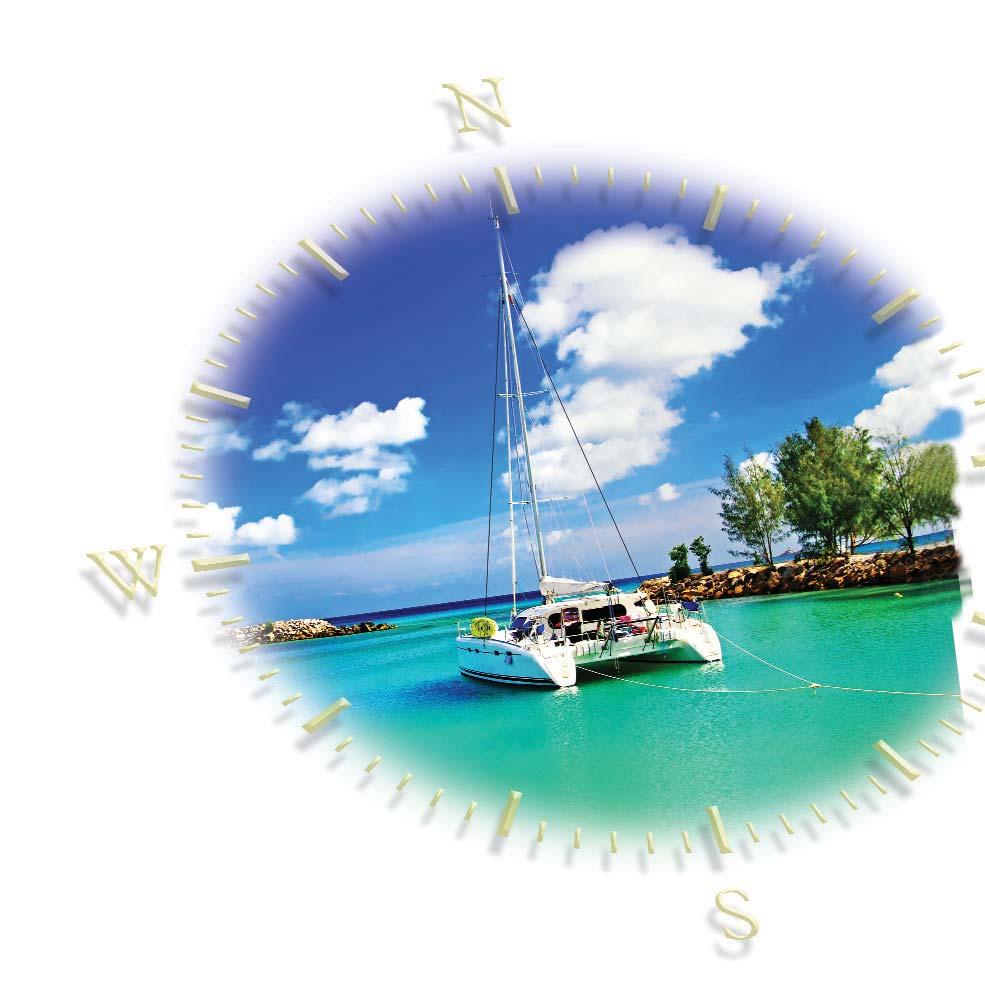




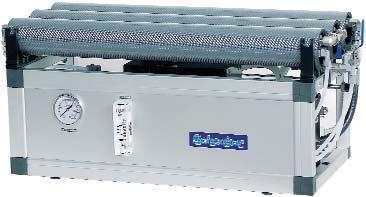
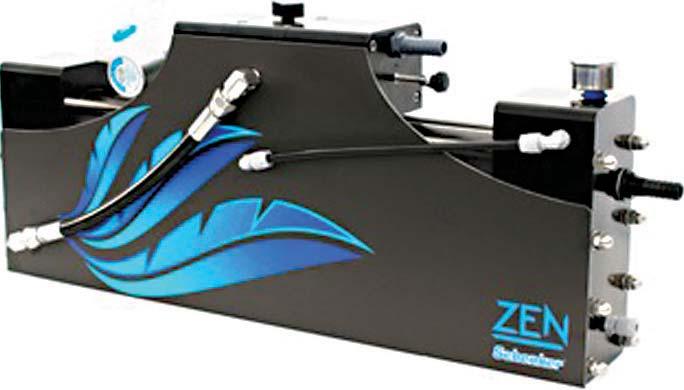


I’m only 18 and I’m sitting on a beautiful beach in the Caribbean – it feels like I’m in a movie. How did I manage this? It’s certainly been quite a journey, with many hurdles to cross and last-minute changes of plan to overcome. I wanted to travel. I wanted an adventure. I wanted to see the world, but with Covid and now only 90 days’ stay allowed in Europe, travelling seemed almost impossible. Fortunately my brother Matt had just done a year of Covid-affected travel so I knew that there was hope.
With financial support from the OCC Youth Sponsorship Programme, Matt had crossed the Atlantic twice and had also explored part of the Caribbean in between*. He had so many amazing stories and it inspired me to apply to the Programme too, as crossing a big ocean sounded like the ultimate adventure.
To my delight I was accepted ... but what next? I needed to find a boat to go on and, with very limited experience and knowledge of sailing, that might be almost impossible. I joined every Facebook group I could and visited websites linking crew with boats. I was constantly messaging boats in my search for any sort of ocean passage or sailing opportunity. Everyone else seemed to be much older, more experienced and a better candidate than me. I was determined that this was what I wanted to do, however, and all I needed was one boat!
After being let down a few times I found a boat that was going to be cruising in the Mediterranean and then eventually head into the Atlantic. The skipper seemed nice, the boat seemed to be in good condition, and it was the perfect opportunity to get the hang of
* See Maritime Backpacking in a Global Pandemic and Caribbean Freedom, both in Flying Fish 2021/2.
 Relaxing in front of Palma Cathedral
Relaxing in front of Palma Cathedral
sailing for a few months before doing the crossing. After one video call with the skipper and a few last-minute Amazon Prime deliveries, on 21st September 2021 I hopped on a plane to Palma, Mallorca to meet Darren and his 47ft catamaran. I felt the classic mix of nerves and excitement – I was putting all my trust in someone I had never even met before.
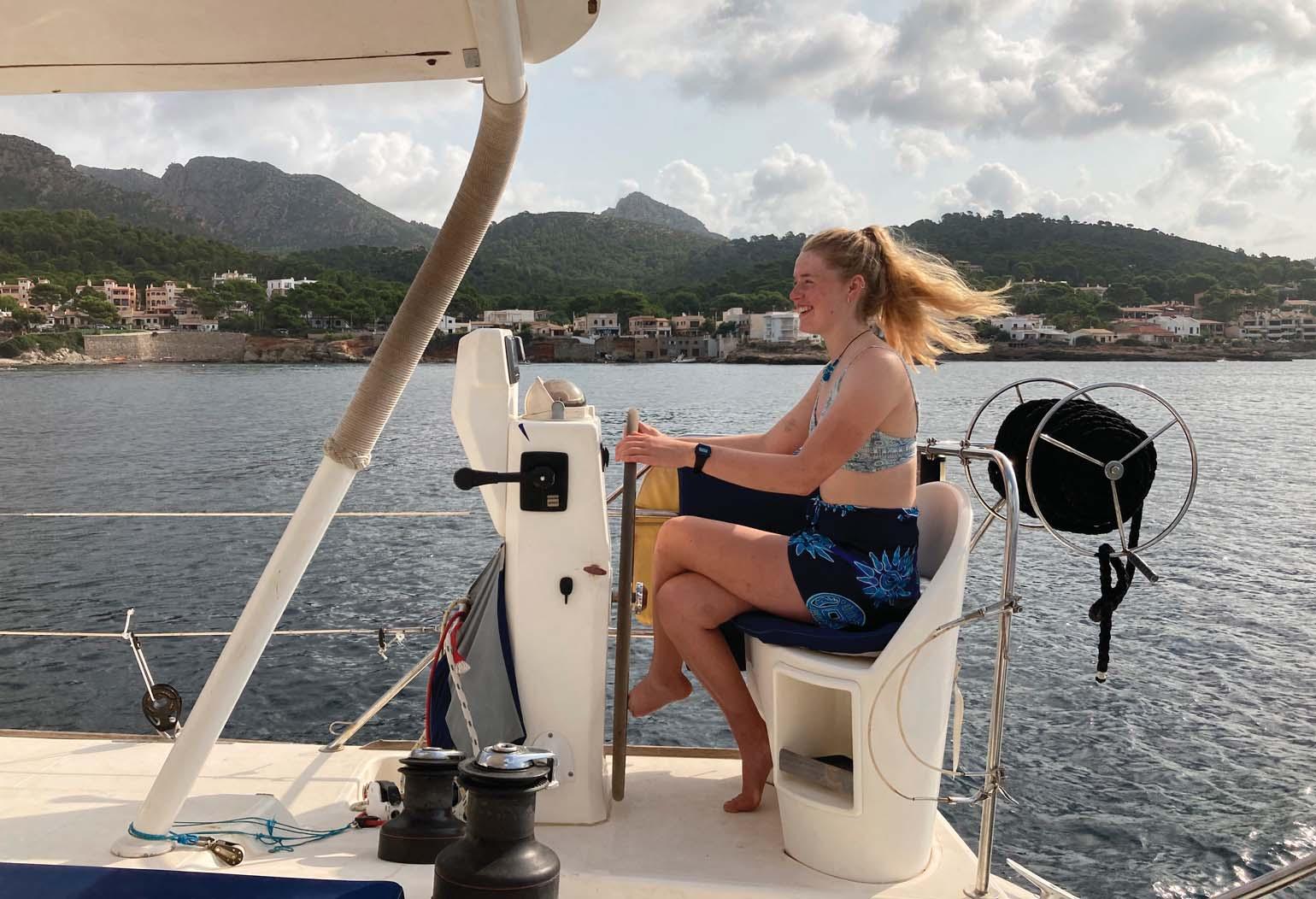
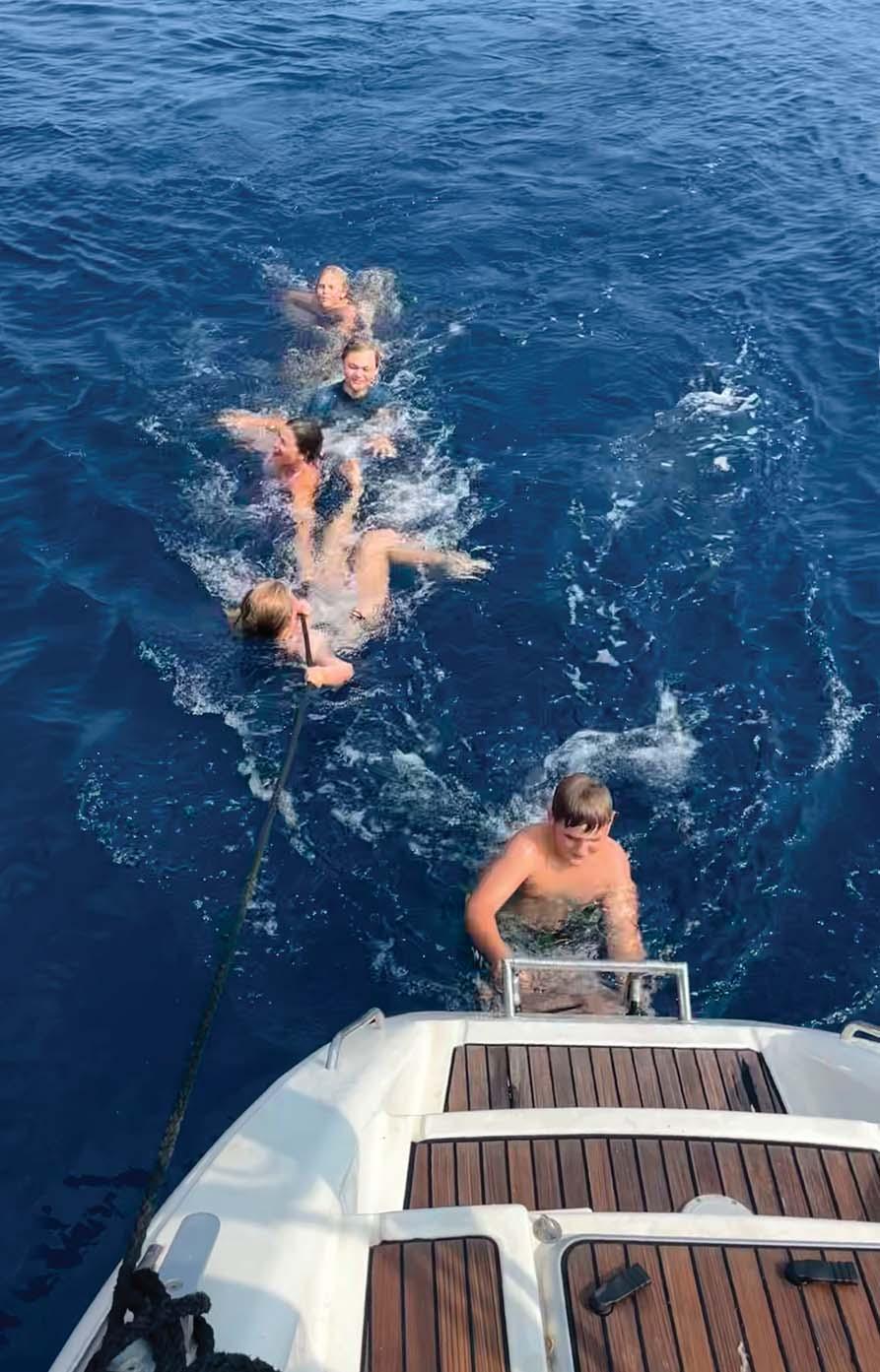
Luckily for me Darren was a nice guy and another female crew who was also very friendly came to join us. The coast of Mallorca is truly spectacular. I swam in blue waters with shiny little fish almost every day, climbed tall rocks straight from the sea and explored caves and gorges on shore. Over a few weeks we sailed along the coast of Mallorca, across to Valencia, and then down the coast of Spain to Portugal.
Light winds aren’t always a bad thing!
I experienced my first night watch when we crossed to mainland Spain. I got a bit of a fright when I turned around to see a big, bright, orange light that looked really close, but soon realised it was just the moon rising and was very glad I hadn’t panicked and woken Darren because of it. We took our time and I got to explore many Spanish towns and cities as well as seeing some amazing caves and landscapes.
On the Spanish coast we visited the Mar Menor, the largest saltwater lake in Europe, and Cartagena, a very quirky city with lots of Roman remains. We also spent an entire day with dolphins swimming alongside the bow. Next came the Strait of Gibraltar, which was spectacular. We entered it at sunset and surfed through on huge waves, hitting 17 knots while one of the crew made fresh scones in the galley!
We stayed in Cádiz for a while to do boat repairs. I was lucky to see the SailGP* race here, watch Ben Ainslie capsize in the final and then later have a chat with him in a nightclub! I got to meet some of the locals and was taught how to flamenco dance,

* SailGP is an international sailing competition which uses high-performance F50 foiling catamarans.
 A great sunset in the Med
Bumping into Ben Ainsley in a Cadiz nightclub
A great sunset in the Med
Bumping into Ben Ainsley in a Cadiz nightclub
Walking with a friend in the Portuguese countryside


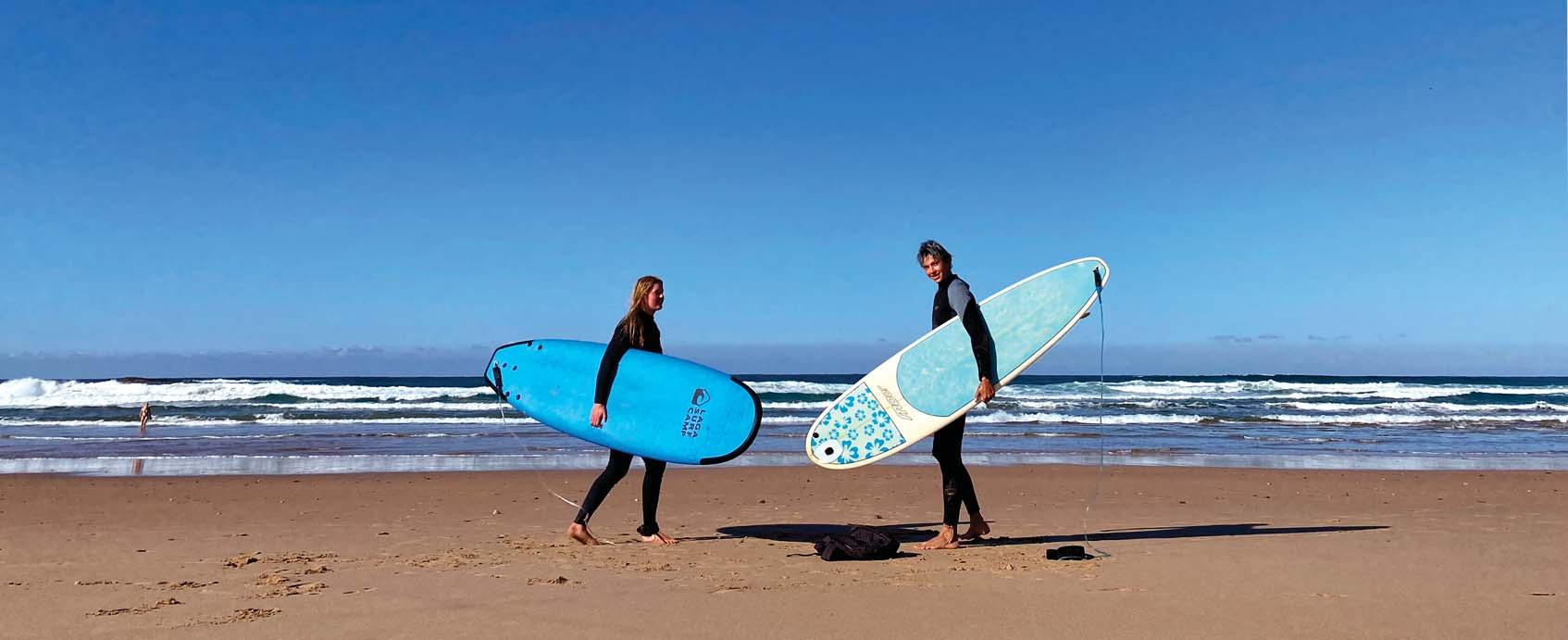
learnt about the city and picked up some Spanish. Just before I left someone told me that ‘sailing is just fixing your boat in pretty places’. I couldn’t agree more, but I found the repairs we did interesting and they helped me learn and understand more about the boat. Being winched up the mast is always exciting, too!
Next came Portugal, where I spent a few weeks with a friendly liveaboard family helping to home school the kids. We collected and cooked little shellfish with the locals, saw wild flamingos and visited some amazing caves along the coast. Darren had some more work to do on the boat before the Atlantic crossing, so I decided to do some land travel and was surprised by what a perfect location south Portugal offered. I lived in a community in the mountains for a few weeks and then travelled with friends in campervans. We surfed and did yoga on beautiful beaches in the daytime and sang around campfires at night. I met so many amazing young backpackers like
Surfing in Portugalme in Portugal and made friends I’m sure I will keep for life.
Sad to leave new friends but excited to start the next part of the adventure, I returned to meet Darren and his new crew. It was the night before the first long passage to the Canary Islands, the food provisions were aboard and only a few things were left to fix on the boat ... or so we thought ... until the engine started smoking and various systems failed to work properly. I soon realised that the boat would not be going anywhere anytime soon.
Frustrated and upset, I was unsure what to do. I really wanted to cross the Atlantic but the possibility of it happening felt so far away. It was already December so most boats had already started crossing and I wasn’t anywhere near where those still to depart would be preparing. I realised that the chance of finding a passage down to the Canaries was very small, so decided to fly out to Las Palmas in the hope of finding an Atlantic passage, despite this seeming almost impossible. First I talked to Fiona Jones, OCC Rear Commodore and Youth Sponsorship co-ordinator, who was concerned about my taking this risk, explaining that I could not swap my funding to another skipper and boat without the OCC checking the suitability of both. I decided to go anyway and see what happened, and Fiona contacted Agustin Martin, Port Officer for Gran Canaria, who agreed to help me if I got stuck. On arrival I was surprised to see the number of young travellers like myself trying to get a passage across the Atlantic – many had been there for months without finding a boat. It felt like I was back to square one and I was sure that I would never succeed, but I had to try.
What happened next was almost a miracle. The first morning I started my search I met a very friendly German skipper named Andreas who was leaving for the Caribbean the following day in his Contest 42, Cocon. He was surprised that I was alone and looking to join a boat with people I did not know. He discussed taking me aboard with his crew, Robert, and then said yes, just like that! The crew were about to go shopping for provisions so asked if I would go with them to get more food as there would be an extra person on board.
Walking around that supermarket my brain was crazily running things through in my head. It all seemed so sudden. Was I really lucky or were there lots of boats crossing? Should I wait for a different boat? Was this a bad decision? What if I got seasick? Was crossing the Atlantic with two complete strangers and spending Christmas and New Year with them a bad idea? They could be anyone and English wasn’t even their first language. The boat might not be seaworthy. I had never sailed in rough weather, and my first time on a monohull bigger than a dinghy would be an Atlantic crossing. Finally, what would I do on reaching the other side?
Despite all these thoughts I decided to go for it and take the risk. I managed to contact Fiona again quickly, explaining I was to set out in 24 hours’ time. She was very concerned and asked for information about the boat and the skipper and whether I had talked to my parents about this. Despite it being late evening Fiona called Commodore Simon Currin to discuss the situation. She also got an e-mail from Andreas about the boat and his experience and learned that he was a member of the German club Trans-Ocean. It was possible to find connections and get some reassurance about his experience and ability.
There was a late evening WhatsApp video call between Andreas, Fiona and me, at which Andreas said he felt they should take me on board as they were worried about
who I might end up sailing with otherwise! Andreas was really impressed to hear about the Youth Sponsorship Programme and offered to join the OCC if it would help me transfer my YSP funding. Apparently a lot of late-night phone calls and checking followed, and OCC admin assistant Emily Winter agreed to process the paperwork late into the night. Amazingly, that meant I had my sponsorship and my berth was approved for this last-minute opportunity. I knew there would be ups and downs and at points I

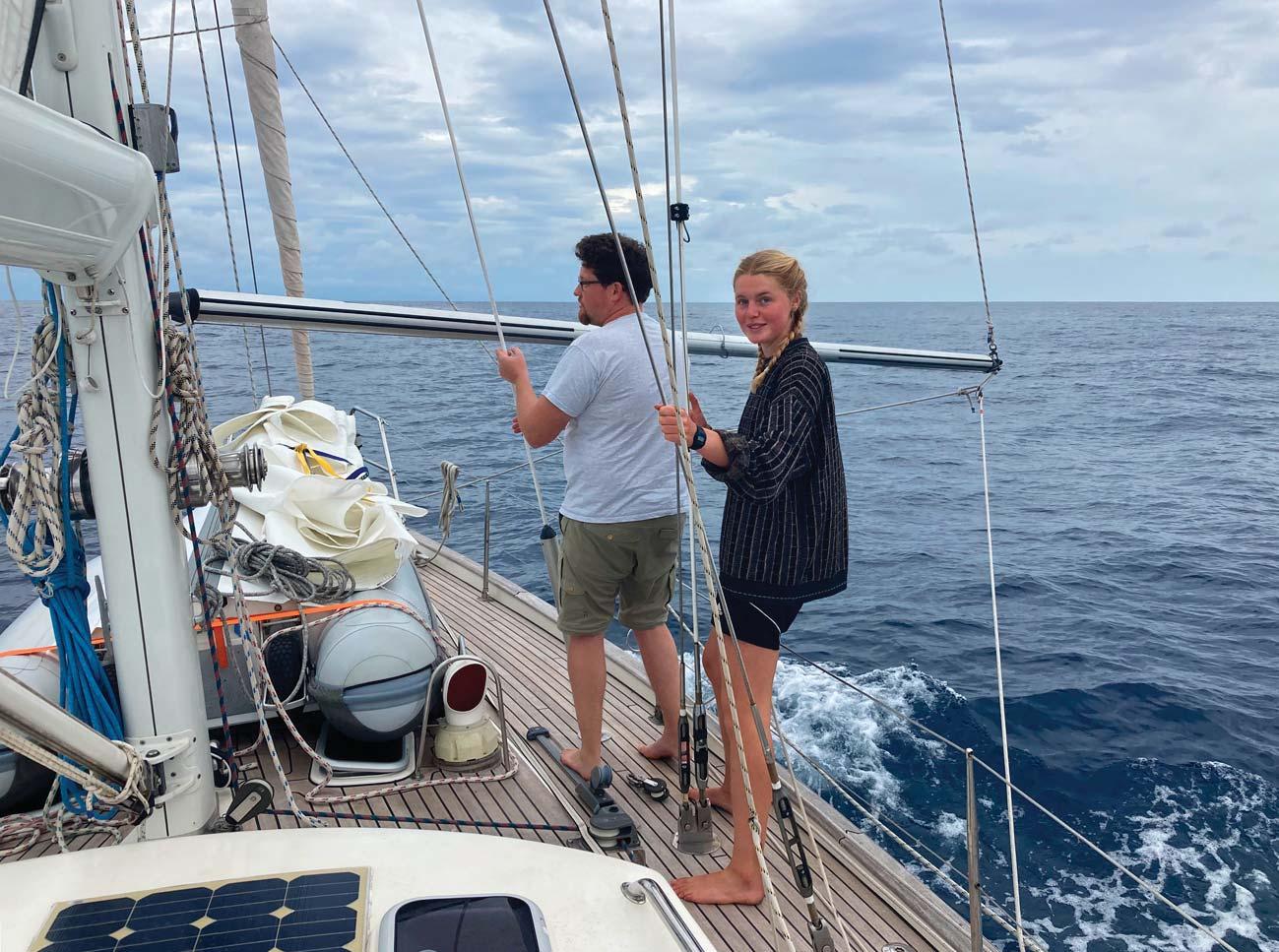
might even regret the decision, but I also knew that this was what I really wanted to do. I quickly messaged friends and family, letting them know that I was sailing to
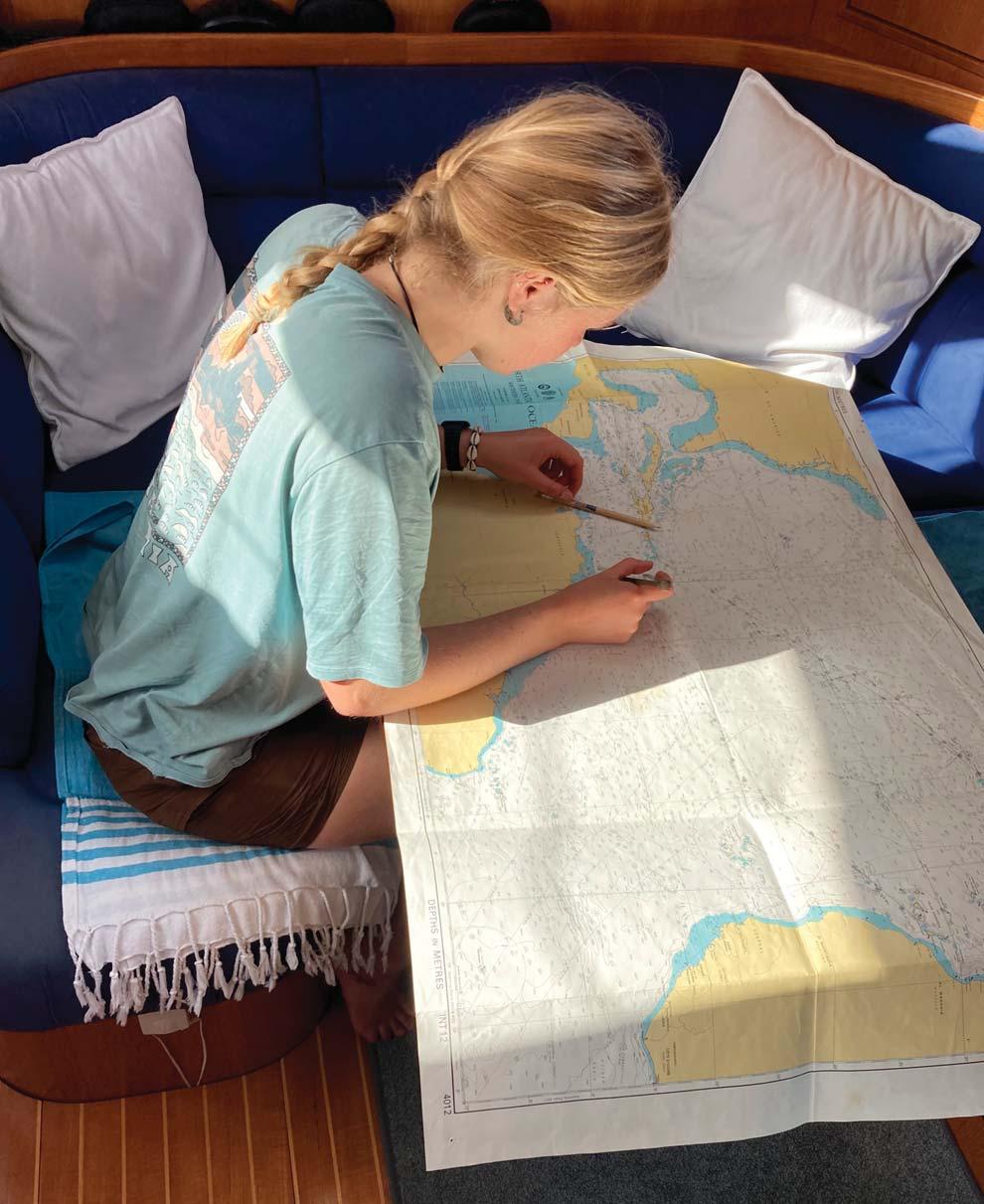
the Caribbean the following day, and downloaded as many podcasts and movies as I could. There was a little leaderboard among the sailing hitchhikers in Las Palmas – before I arrived the record was two days but I had cut this to just a few hours.
Before I knew it I was off and we were alone with the ocean! We set sail for Martinique on 13th December, with Fiona able to track our passage and get reports by e-mail. On the first morning I woke suddenly to Robert telling me there were dolphins at the bow. I ran up on deck putting my life jacket on as I went and watched the dolphins gently weave in and out of each other as the morning sun began to rise. What a great first morning! I knew then that I had made the right decision. Over the next few days the idea that I was actually crossing the Atlantic Ocean slowly settled in. These days were the toughest for me – being in an unfamiliar environment with new people takes some time to adjust to. There were quite light winds which made progress slow, but it was progress nevertheless! I loved looking out and watching the endless rolling waves, knowing it was a view I could never get bored with. Not only was I learning a lot about sailing, but I also became
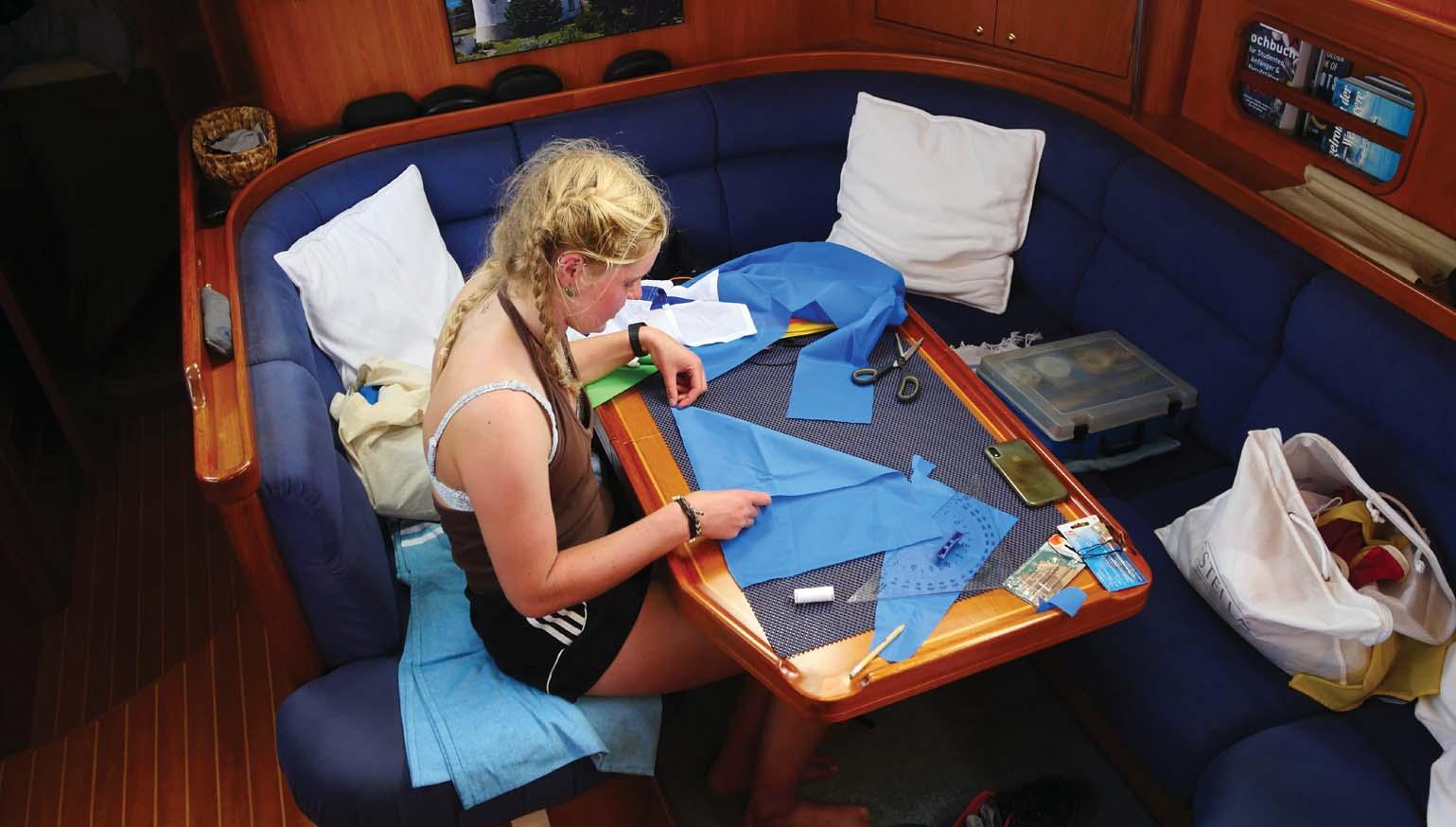
Not many places to buy a courtesy flag at sea
fascinated by the stars which were by far the brightest I had ever seen. I learnt many of the constellations and how their positions change relative to each other, as well as the basics of celestial navigation. Gaining a better understanding of the universe around me was a great feeling, though I certainly never thought I’d be using trigonometry while travelling! The learning continued and I began to do some night watches by myself. Andreas showed me how to plot our position on a paper chart and taught me about the Mercator projection so I could work out distances.
At the floating bar in Mindelo marina

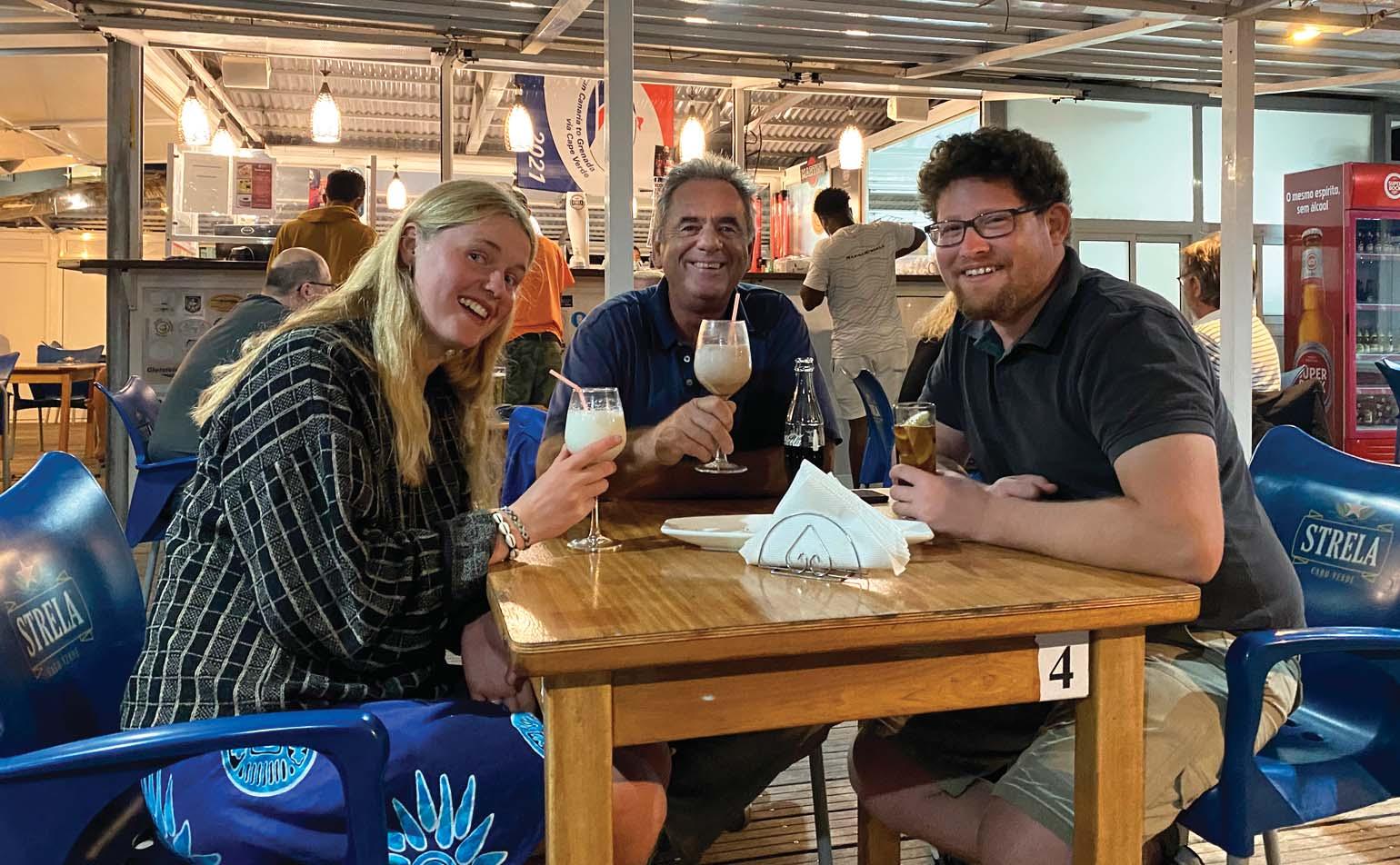
After provisioning in one of the small supermarkets we set sail on Christmas Day with strong trade winds blowing us towards the Caribbean. I treated myself for Christmas dinner with my absolute favourite meal – beans on toast. The German crew definitely weren’t impressed! With more time on our hands than in normal life we spent hours having long chats and debates and reading books, with a backdrop of stunning sunsets and huge skies. Most of all I think I really got to appreciate just thinking and taking time to relax completely and enjoy the beauty of the vast ocean. A particular favourite memory is of watching dolphins in the dark. The green bioluminescent
Not a rarity on the crossing
It’s extra hard with those waves...
Due to the light winds and slow progress we decided to call in at Mindelo in the Cape Verde islands. A shark fin followed us into the bay on São Vicente, a small African island full of culture. On the western island of Santo Antão

I saw some of the most dramatic and breathtaking scenery I had ever seen in my life. Banana and sugar cane plants lined the green slopes, and locals ran barefoot along the steep mountain paths with their donkeys.
Out on the ocean again, and now for twice the time!

light created by their movement makes them resemble torpedoes jetting through the black water. It was magical to watch. Towards the end we really sped up and surfed our way to Martinique on huge, deep blue waves. Along with giant waves there were also sudden downpours of rain, which was a nice way to remember home. It all made the boat very rolly, which made normal things like cooking and getting changed rather exciting. We finally made landfall on 10th January after 16 days at sea.
The crossing was an amazing experience that I will never forget, and I learnt as much about myself as I did about sailing. I know that sailing will be part of my future as well as of my memories. I was so lucky to have the OCC supporting me throughout and making me feel confident enough to seize the opportunity. It’s now late July 2022, ten months since I flew out to Mallorca, and I’ve just arrived back home. After the Caribbean I decided to fly to Colombia, then worked my way south through Ecuador and Peru. I spent time volunteering in tiny villages teaching English, hiking up to glaciers, stringing my hammock in beautiful canyons, surfing under incredible sunsets, rock climbing a 200m wall and doing a remote, nine-day unsupported wild camping trek in some of the biggest and most beautiful mountains in the world. One of my most special memories is of living in an indigenous community in the Amazon jungle and being the first English person ever to stay with them. I never dreamed that the world could be as amazing as what I have experienced over the last ten months and I’m so grateful to all the inspiring people I’ve been lucky enough to meet along the way.

To take a person from some harbour dock on board for a long ocean passage is not an easy decision. You don’t know if and for how long the person will be seasick, or if his or her personality will be a good fit with the team spirit on board and will make living together in a reduced space easy and enjoyable. You have no idea how he or she reacts in
We decide to opt for something other than pasta
tricky or stressful situations and you can hardly judge their sailing experience, of which most claim to have at least a little. All such people say they want to learn and can cook.

Most of those asking us for an ocean passage were couples (or several people) and obviously on very reduced budgets. We did not want to legally take people into a foreign country who then had no money to leave by plane, so that we would be forced to keep them on board until they found another boat or other means to leave. After some days and discussions we decided not to take crew and stay just the two of us.
Then I saw Emma standing on the docks in Las Palmas asking for a transatlantic passage. She was alone and only 18, and I suddenly had the impression of a sympathetic person who wanted to learn, contribute where she could and had at least some sailing experience. I felt she would fit well into our two-person crew. That she spoke only English was a bit of a challenge for us (two German guys), but was not a real counterargument. That I had to join the OCC was, for me, almost a show stopper, but the young sailors’ support programme of the OCC really convinced me. I’ve been a member of the German Trans-Ocean Club since 1998, but that has no similar programme and I felt happy to support the initiative by taking a young person on board. After five minutes’ discussion with my crew we decided to say ‘yes’. So a two-person team turned into a three-generation crew, given our very different ages.
We never regretted our decision. Emma took every opportunity to help and learn and became a full crew member during the crossing. She understood the technical systems better and better each day. At first we had watches with her, but later on she had her own ‘sunrise’ watch. By the end of the crossing she had experienced the challenges of when friendly trade winds turn into a race of squalls and heavy seas. In these tricky situations, Robert and I – as an experienced team – covered the watches with her as a helping hand.
All in all it was a good experience both for us and for Emma, and I would strongly recommend that other OCC members consider making a similar decision. The Youth Sponsorship Programme takes a lot of the counter-arguments away and is a good entry door for young people to experience and share our fantastic way of living the cruising life.
www.latellsails.com
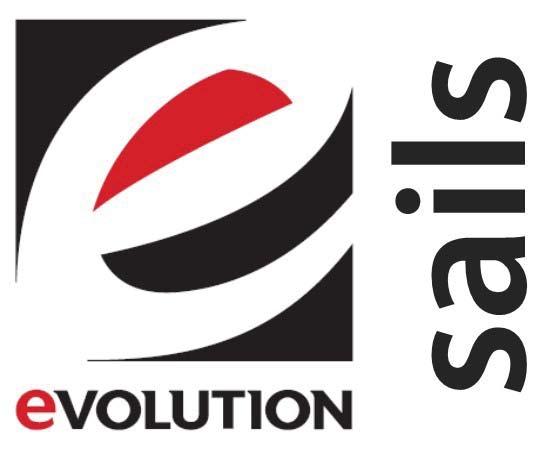


804-776-6151
Charleston, SC USA
Chicago, IL USA
Cleveland, OH USA
Sandusky, OH USA
Auckland, New Zealand
Queensland, Australia
Sydney, Australia
Toronto Canada
Quebec, Canada
Vancouver, Canada
Palma de Mallorca, ESP
Izmir, Turkey
La na, Italy
EXPLORE – LEARN – SHARE summarise the purpose of our journey.
We call the journey Escape West because west is the direction of our travels. Our boat, SY Escape, is a Beneteau First 47.7 and her home port is Stavanger, Norway. We have sailed her thousands of miles since 2009 and she has served us well. Literally and figuratively we are, Vetle (one month shy of eight years at time of writing), Ma Theresa and me, Dag.
Our Escape West journey started when we left Stavanger in July 2019. We sailed to Gran Canaria, continued across the Atlantic in January 2020 and cruised the Caribbean until Covid caught up with us in March/April 2020 (see Flying Fish 2020/2). In May 2020 we left Escape on the hard in Curaçao, returning at the end of July 2021 to continue our westbound explorations. This is the story of our Pacific Drift in April 2022.
Nuku Hiva, French Polynesia, September 2022
“How do we know the way?”, Vetle asked. He had been up for a while silently looking at the stars – he was always quiet when he knew he should be in bed. I guess the question had been maturing in the two weeks that had passed since we left Las Perlas in Panama. “How do we know, Papa?”.
“You see that one there? The bright one just above the horizon?”, I sat comfortably in the cockpit with my back to the companionway looking at Escape finding her route through the following seas guided by Monique, our Hydrovane self-steering gear. “Yes Papa, I see the one, but it is behind us. We go the other way,” Vetle said as he lifted the phone pointing at the bright star. “It is Venus,” he proclaimed triumphantly.
We had played with the StarWalk app on many nights exploring the night sky. It was my gateway into talking about the universe and, more importantly, the Earth and its environment. “Yes, it is and you know that without the app,” I replied. “Venus is the brightest star we have after the Sun and the Moon and it rotates backwards,” I heard him say as he looked up from the app. “What does that mean Papa?”. I was clueless. “I guess it means it rotates the other way,” I said without offering a better explanation. “Oh, we would all be dizzy there”.
“But how, Papa? How do we know the way to Bounty Island?”. “When I see Venus covered by our aft stay, I know we are on course to Pitcairn or the Gambier Islands,” I said. “If not, we are too much to the west or the south. It is called celestial navigation”. Unsatisfied with my response, he continued, “But Pitcairn is so small. What if we pass it and never see it?”. The Bounty adventures had rubbed off somehow. “Pitcairn became famous because it is hard to find,” I told him. “I know,” agreed our adventurous sevenyear-old. It was time for bed and he knew it. My night watch continued while Escape comfortably headed deeper into the southern hemisphere pushed by the southeast trades.
After returning at the end of July 2021 we survived a six-month yard stay at Curaçao Marine. We don’t mind doing work on our boat, but discovering a small crack in the keel-matrix only days before launching was a serious setback. Something had happened during the 15-month storage but no one could offer any explanation. Our plans were
bombed, timeline gone and monthly budget blown while to-do lists multiplied. It was not until January 2022 that Escape was ready for the high seas, stronger and better than before. By then we had celebrated birthdays, Christmas and New Year in Curaçao.
After a week on a Bonaire mooring the itching grew and in early afternoon we cast off again for San Blas, Panama. The 700-mile passage took us along the Colombian coast, guided through the night on our way southwest by the radiance of Santa Marta, Barranquilla and Cartagena on the horizon. We had them marked down as optional stopovers, but the Colombian Covid-motivated red tape was too rigorous for us. It was a quick ride with fresh winds and seas which allowed us to rediscover our boat after the long separation and repair. Before long we rounded the East Holandes and sailed up the Mayflower Channel to El Porvenir in San Blas. It felt good to get behind the reefs and out of the ocean swell and to drop the anchor in 10m of clear, warm water. The passage had passed without any problems with either boat or crew.
The San Blas were beautiful but touristy. We enjoyed sailing the ins and outs of the islands, all offering beaches, palm trees, clear waters and good anchorages. We enjoyed the snorkelling and meeting fellow sailors on the beach in the evening. We enjoyed finally being on the boat again, blending exploration, school, chores and boat maintenance. All too soon our cash and provisions ran low, forcing us to seek out the nearest ATM and grocery shop, which were in Shelter Bay Marina, Colón, Panama.
Arriving at Shelter Bay was a shift in mindset and pace. It was now all about transiting the Canal and entering the Pacific. Business cards recommending Canal transiting agents, Uber drivers and others were put into our hands by Shelter Bay Marina. Panamanian business culture snuck up on us too fast and before long preparations for the transit were in progress – measurement of the boat, organising lines and line handlers and preparing to submit documents ... but first and foremost fees and payment. Nothing happens in Panama until money changes hands. We chose a recommended Canal agent, services were agreed and dollars paid over. Then silence and waiting, until finally a date for the transit came through. We would transit on 8th March. And we did. We had time to visit the last refuge of Captain Morgan and the fortresses at Portobelo, enjoying its history while having Pirate Pizza in Casa Vela.
We entered the Panama Canal with great anticipation on the afternoon of Sunset in Portobelo
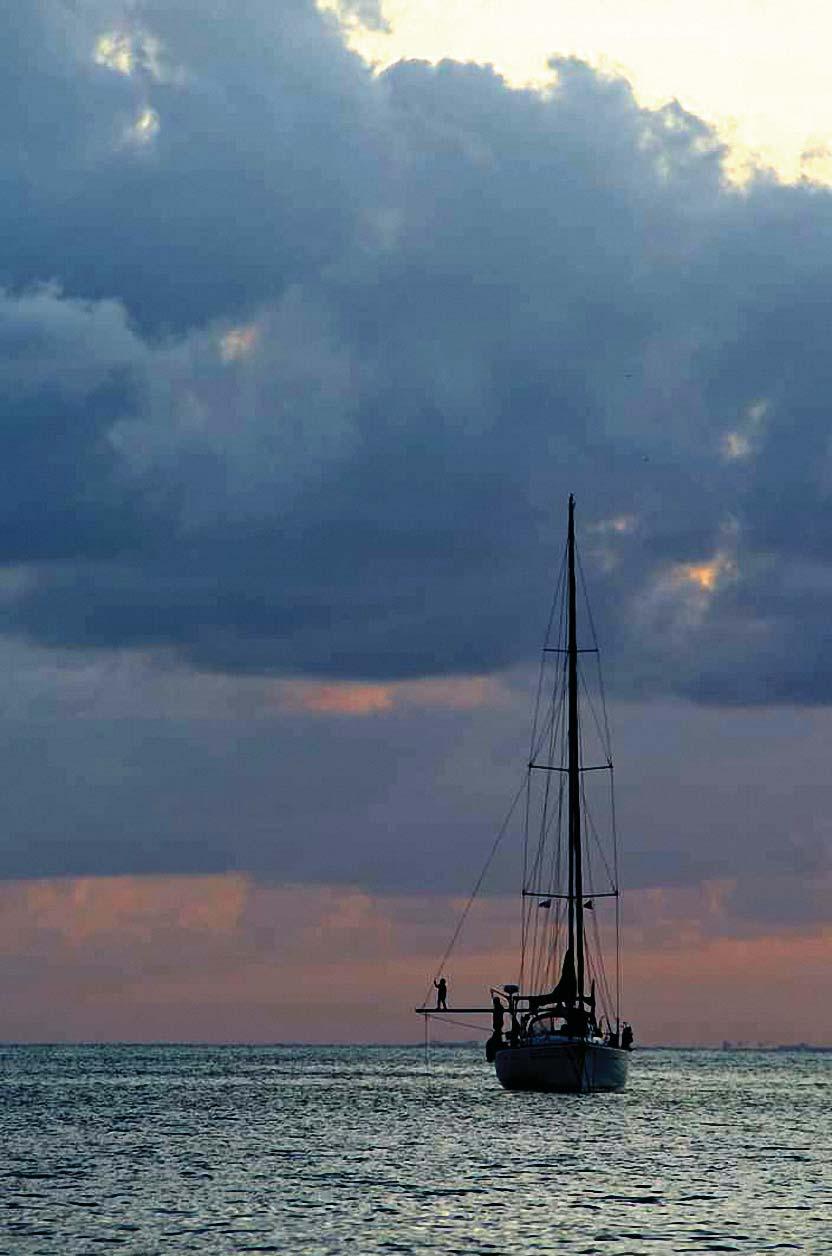
Nomadica, our buddy boat for several weeks
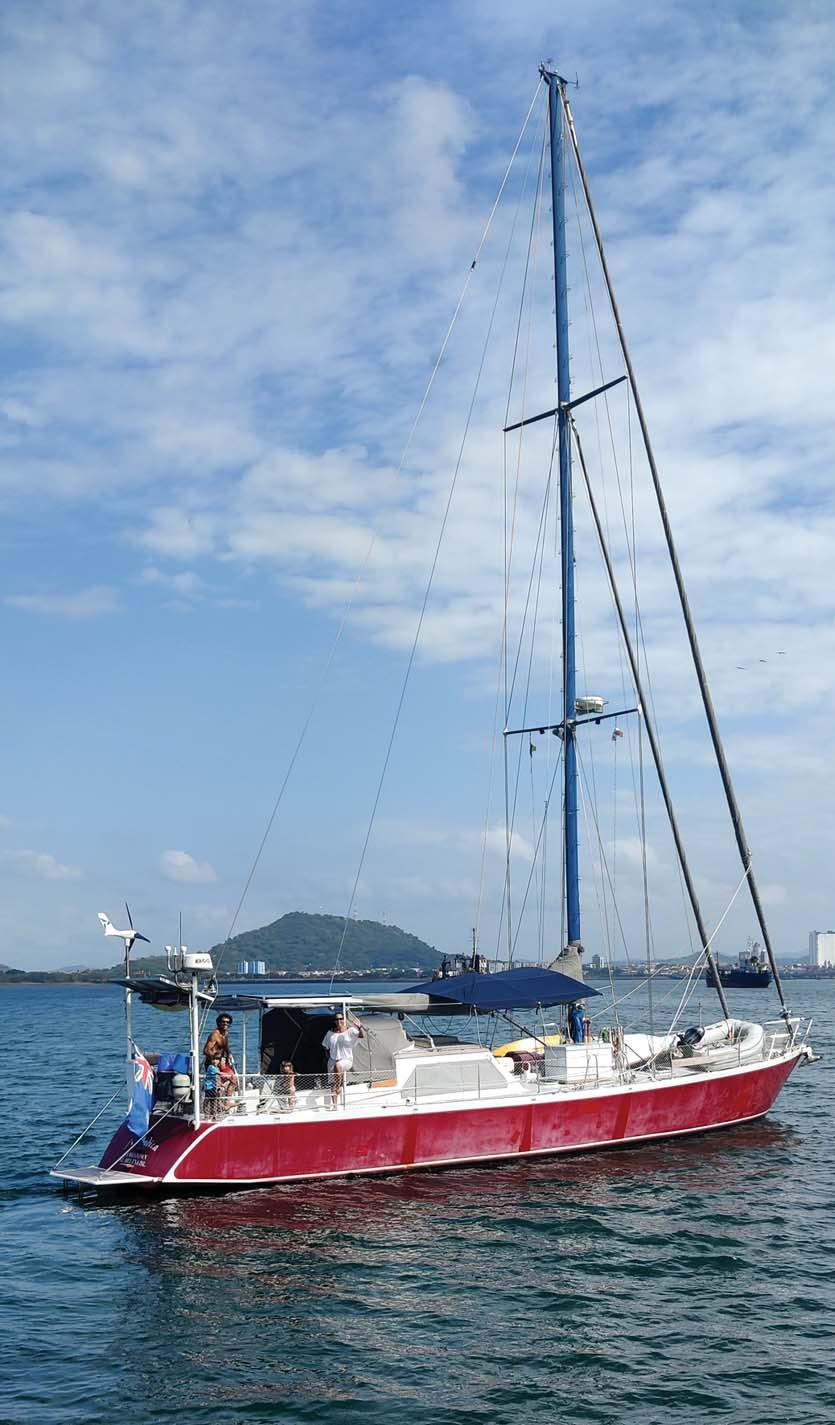
8th March. It was a milestone in our journey westwards and Miraflores, the final gate, was the door to our Narnia. The transit is actually an easy 40 miles. The Canal guide arrived as agreed on ‘the flats’ outside the entrance to Shelter Bay Marina and we progressed quickly to the Gatun locks that lifted us up to our overnight stay in the Gatun Lake. Before entering the lock we rafted up with Nomadica, a 58ft steel yacht sailed by Morgan and Cheryl Morice (OCC) and their children Gäel and Naiya, whom we’d met in the San Blas. There was a third yacht on the other side.
On exiting the gate the other yacht suddenly lost power so we towed them to their mooring for the night. Later we learnt that they’d had to stay there for two weeks while the Canal Authorities sent a mechanic to remove their entire engine for repair. They were not allowed to do anything other than wait – everything was decided by the Canal
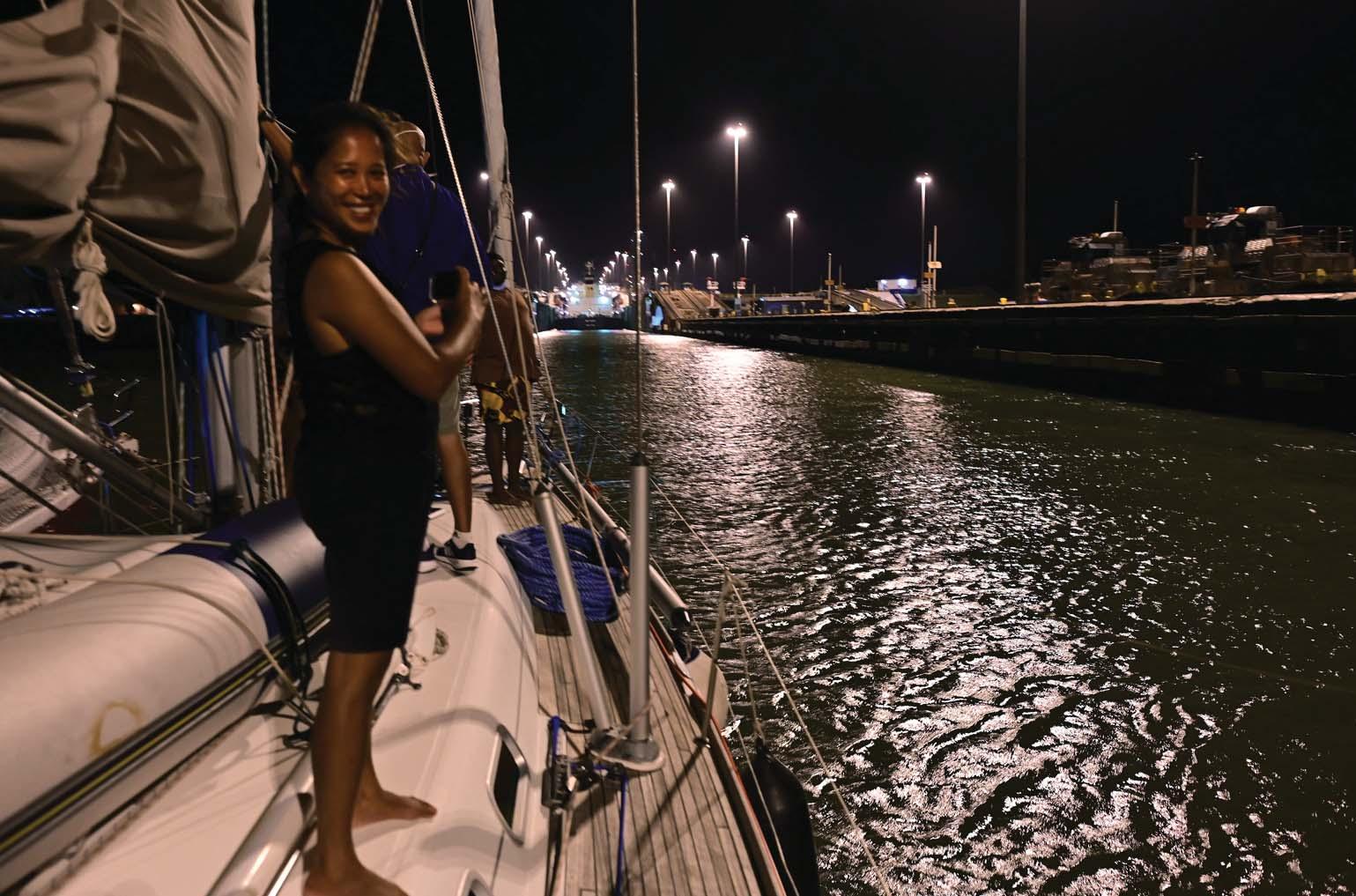 Approaching Gatun Lock at night
Approaching Gatun Lock at night
Nomadica waiting for the lock to open
authorities while the cost soared. Be sure everything is in good working order before entering the Canal! The following morning a new Canal guide arrived. We motored across the Gatun Lake, squeezed through the Culebra Passage, snuck under the Centenario Bridge, took the Pedro Miguel locks down one floor and headed for the Miraflores Lock –the gateway to the Pacific.

When the Miraflores Gate on the Pacific side of the Panama Canal opened in front of us we were at the start of the biggest ocean on the planet. We left behind Captain Morgan, Long John Silver and all the
 The gateway to Narnia –the Pacific Ocean
The gateway to Narnia –the Pacific Ocean
pirates of the Caribbean whilst welcoming Robinson Crusoe, HMS Bounty, the works of Herman Melville, the South Pacific tales of Jack London and many other stories about this great ocean. We were excited. We exited the Canal, rounded Isla Flamenco and dropped anchor in 12m of dirty water with the skyline of Panama City in front of us. We were to stay there for a month, exploring, provisioning and enjoying big-city life.
Our first 24 hours in the Pacific was a joy ride, together with our buddy boat Nomadica. The forecast showed great following winds and the current pushed us in the right direction. I went below to prepare a coffee for my night watch. Vetle and Theresa were sound asleep and all was quiet apart from the sounds of Escape eagerly heading southwest through the waves. Venus danced from port to starboard of our backstay and I had only to look up to confirm that Monique was keeping us on course towards the elusive Pitcairn at 23S. The celestial navigation was going well and we still had 3500 miles in which to fine tune it.
We passed the Galapagos north of the main islands and just south of Wolf Island, and crossed the Equator at 96W, 30 minutes into my birthday on 19th April. We had opted out of visiting the Galapagos before leaving Panama – it seemed too expensive and cumbersome, requiring fumigation and certification, compared with what cruisers actually get to see.
In our second week out, at 5S, the southeast trades finally firmed up and gave us a steady push of 20–25 knots of warm winds. We were happy, Escape was happy and all was good. Time at sea had allowed us to enter into the rhythm of our daily offshore routines –breakfast at sunrise and checking the rig, steering and running rigging for chafe. After the morning log book entry, some hours of sleep for me while Theresa kept the boat running safely. A hot lunch at midday, then getting together in the cockpit in the early afternoon
* Escape’s route in the Pacific can be followed on the chartlet on page 38.

to talk, do some school if the weather permitted and prepare for dinner at sunset. Theresa struggled with seasickness, but with the following seas and steady wind she managed.
We met dolphins and pilot whales. We lost some lures to tuna, mahi mahi and wahoos but the only fish we landed was after sundown. It was an ugly, slimy creature with a barracuda head and body like an eel. Needless to say, we dropped it back into the ocean. Later we heard that there is a deepwater fish commonly called ‘night barracuda’ that comes to the surface after dark to feed.
Panama was long forgotten and the South Pacific islands not yet on our horizon. Night followed day and dawn brought the promise of yet another day at sea. Escape sailed herself. If the wind was too brisk we reduced sail, and when the breeze allowed we flew the spinnaker through the day. We did runs of between 120 and 160 miles between noon positions depending on the wind. We always sail conservatively on long passages to avoid breakages or, worse, any injuries.
By the third week of our crossing we started to look for a weather window to visit Pitcairn. This was all prepared before leaving Panama and Brenda, the jack of all trades in Pitcairn, was ready to welcome us to their island, their history and their community. Through the whole crossing we kept in contact with Nomadica, plotting both boats’ progress. They had gained about 150 miles by keeping further south than we had.
We started to calculate, first by ourselves in our heads in quiet moments, then in whispered conversations after Vetle was in bed. “We may be in by Wednesday”. “There’s a low forming southwest of Pitcairn, but we may make it if we can manage 150 mile daily runs for the next 48 hours”. “Looks like Nomadica will make the weather window before the low closes in”. Once the cat was out of the bag it became the daily topic of discussion and navigation. Every morning the downloaded weather was scrutinised and flooded with courses, isobars and distance calculations.
As the remaining distance to Pitcairn decreased and the forecast accuracy improved it became obvious that we would not make the weather window, so one morning we made the decision to head straight for the islands in French Polynesia. Pitcairn and the Gambier archipelago are only 300 miles apart, but we had to make the decision before the apparent wind angle became too tight to make the Gambiers.
 Servicing Vetle’s car on the crossing
Servicing Vetle’s car on the crossing
“It looks like Venus is not dancing, Papa. Venus is always on the same side of our aft stay. Can we find the Bounty Island, Papa?”. We had to break the news to Vetle somehow. “We are so close now that we had to look at the weather and decide. We cannot go ashore on Bounty Island because the weather is too windy,” I said. “Will Gäel and Naiya go there?” he asked. “I think so,” I replied, “they are just enough ahead of us to make it while the weather is still good”. Theresa entered the conversation, “Remember that the Bounty Island is hard to find and it is hard to get on land”. “Are we still doing celestial navigation, Papa,” I heard him ask. “Yes, we are,” I replied. “That is why the Bounty Island is so hard to find”. “We can use the phone to show the way, Papa,” he said showing us the Navionics app on his phone. He was right and it showed our course firmly set for the Gambier archipelago. Who did we think we’d
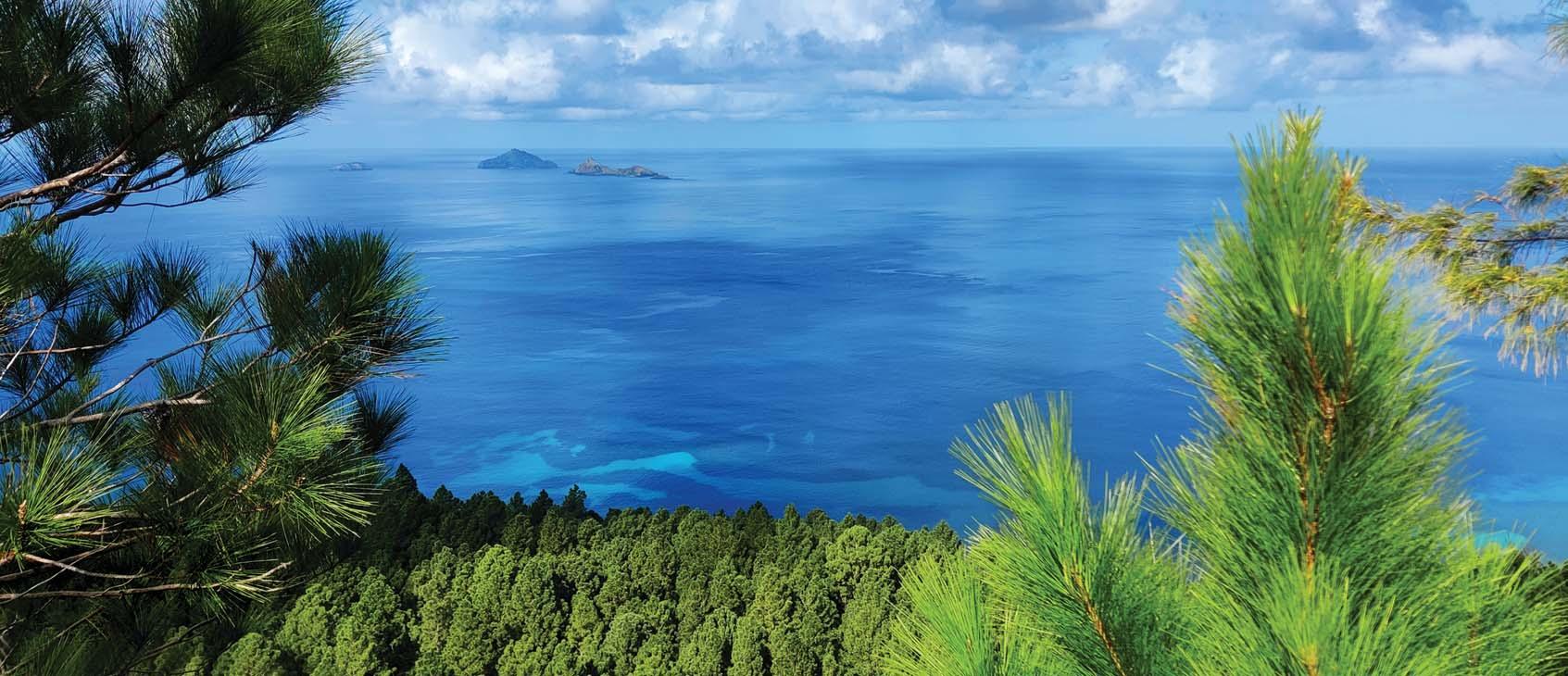
We entered the southwest pass into the Gambier archipelago 30 days after departing Panama. The crossing had been long but pleasant. We had enjoyed days and nights at sea and our adventure in the South Pacific had just started. We will have to keep Easter Island and Pitcairn on our list for the next time we pass, but that may not be for a while.
School goes on and on
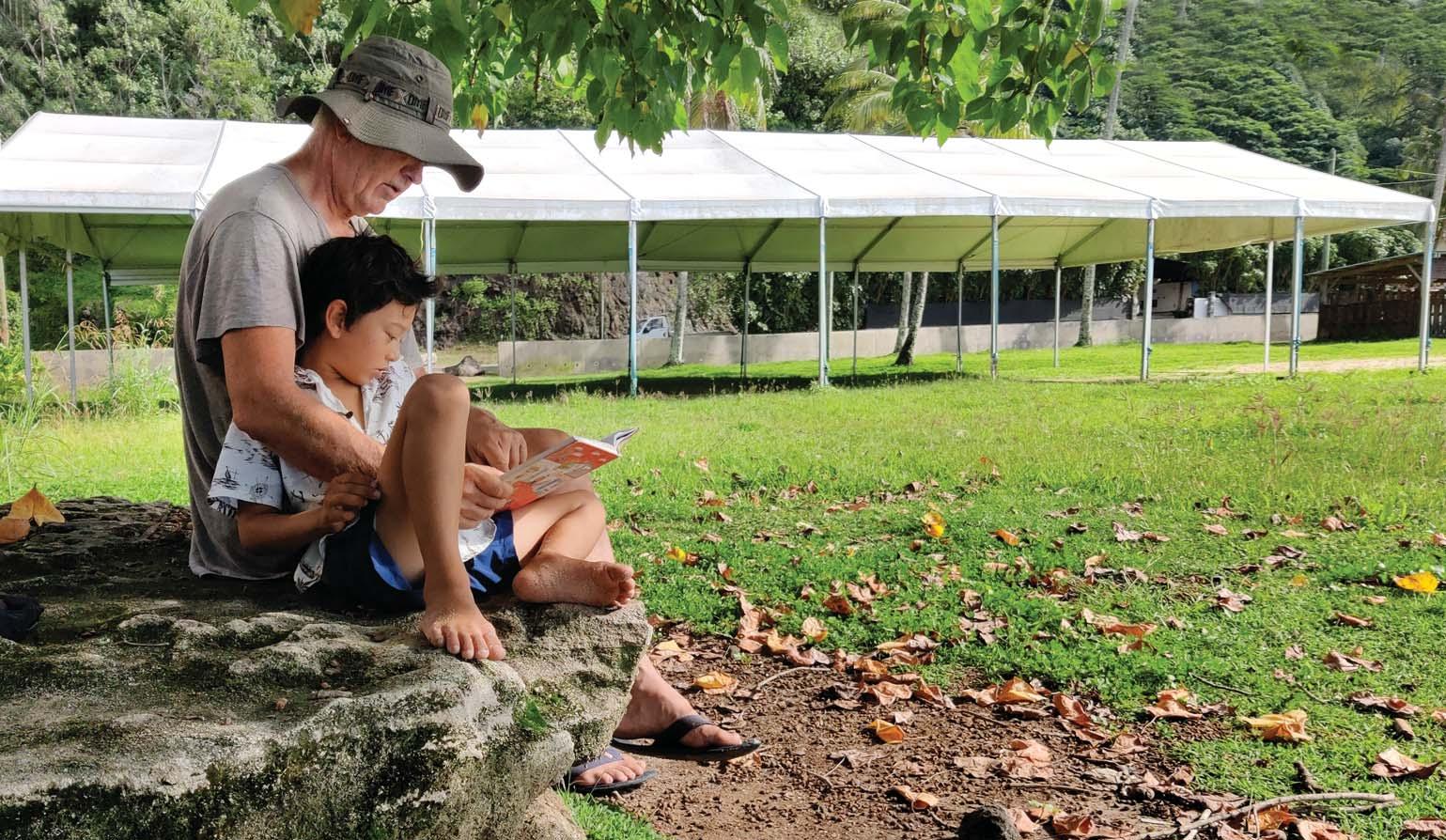 The Gambier archipelago
The Gambier archipelago
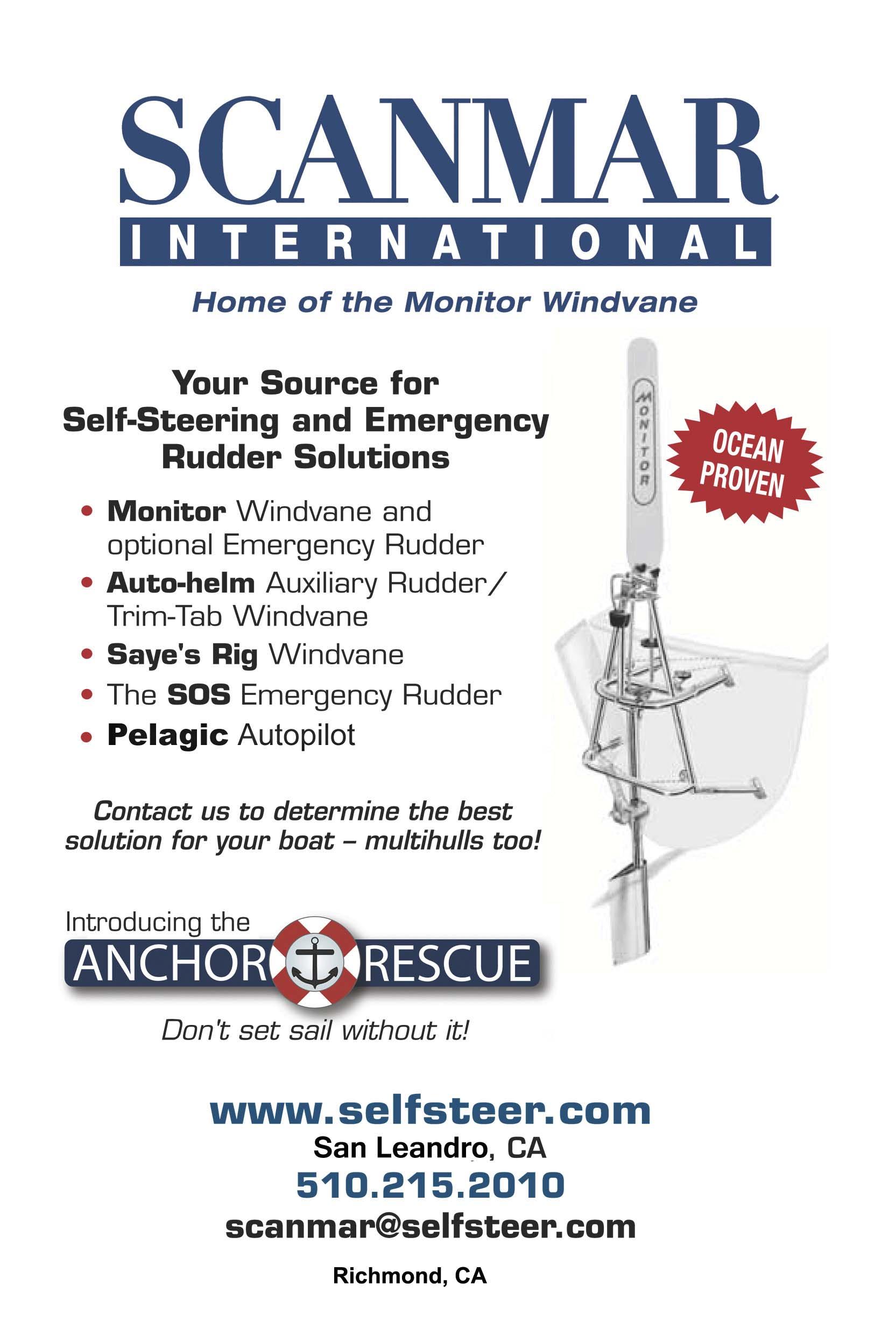
(Trevor first sailed from Western Australia in 1975 and has wandered the world’s oceans ever since, going ashore only to earn enough to continue passagemaking. He has voyaged widely in vessels from 30ft to 38ft LOA built of wood, fibreglass and steel. In his previous vessel, Iron Bark II, a 35ft steel gaff cutter, he wintered alone in the ice of Antarctica, and twice wintered in Greenland’s ice, once with Annie Hill and once alone.
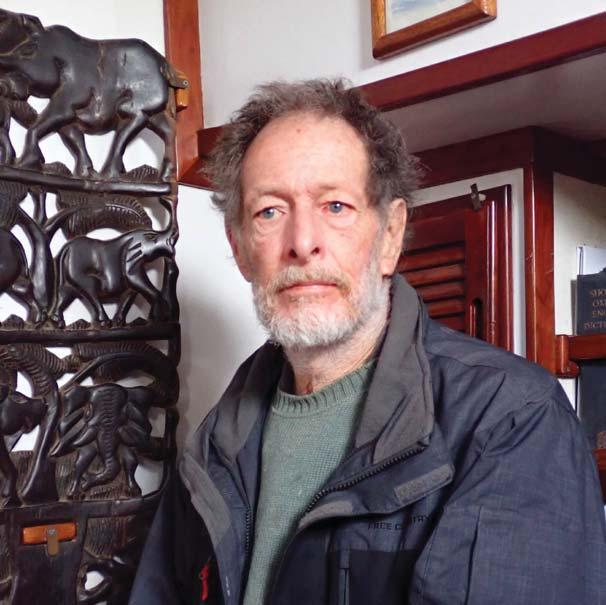
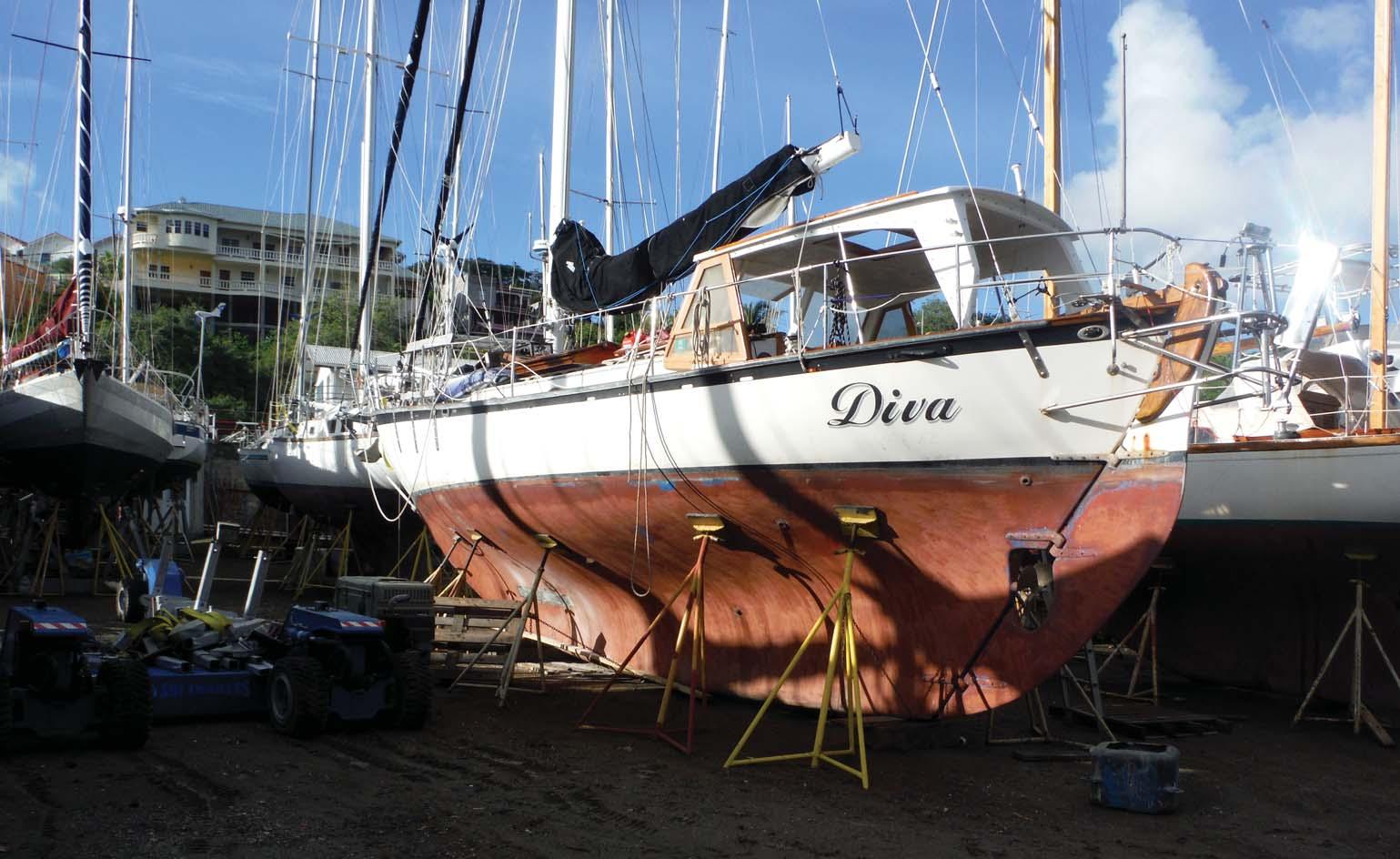
Following the passages recounted here, Trevor sailed north to the Faroes and Iceland. Read more about his adventures at iron-bark.blogspot.com/p/ iron-barks-travels.html.)
On 5 May 2021, having spent the previous two years in the eastern Caribbean, I cleared from Carriacou, intending to sail to Ireland by way of Iceland. Two years is a long time to spend in one place – blame it on Covid travel restrictions plus a slow refit to convert the new-to-me Iron Bark III into an ocean-going vessel. The new Iron Bark is an Alajuela 38, a GRP double-ender designed by William Atkins and built in California in 1977. When I bought her she was fitted out for short coastal passages in fine weather, with all the paraphernalia that goes with that sort of sailing. To make her capable of at least a fair-weather, temperatelatitude voyage, I threw off a pile of irrelevant clutter (air conditioner, autopilot, fridge, pressurised water, water heater, a huge hardtop, barbecue, half a skip-load of wire and hose ... the list goes on) and added a proper anchor and a Monitor wind vane,
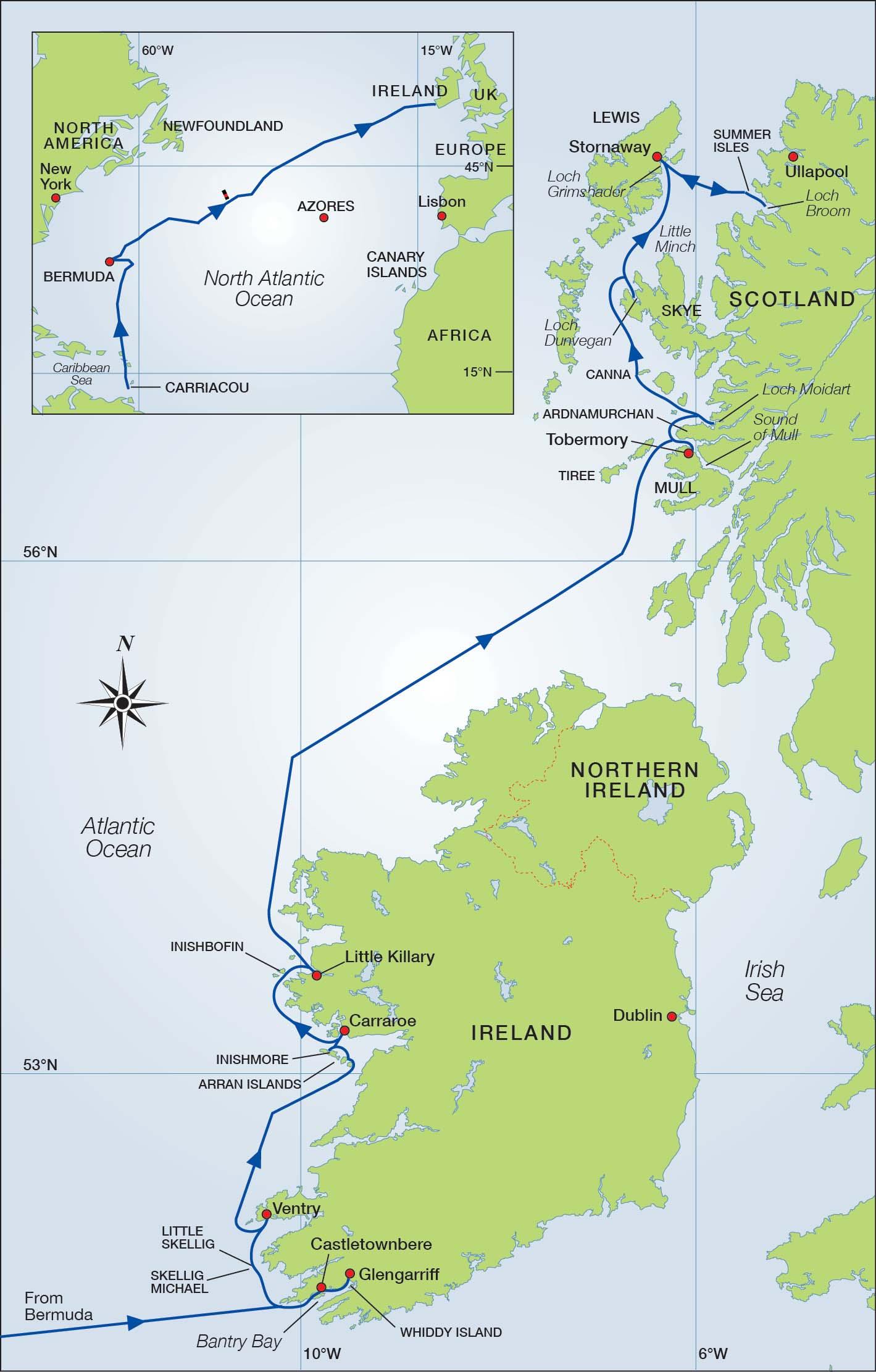
replaced the running rigging and inspected the standing rig. In the Caribbean I rebuilt the rudder head, built new hatches, modified the sail plan to something that was usable in more than force 4, built anchor rollers that were strong enough to be relied on, rebuilt the bowsprit, built lockers that would function in a seaway, sorted out the fuel system, and on and on down an apparently endless list. There was still much that was less than ideal on Iron Bark, but I hoped that I had done enough for her to make a summer Atlantic crossing safely. I also hoped that harbour rot had not dulled my abilities too badly.

The breeze was eastnortheast 6 when I left Carriacou, brisker than I would have chosen for a shake-down sail, and for five days the wind held fresh to strong giving me a fast reach north through the island chain. The daily runs reflected this, including one of 165 miles under double-reefed main and staysail only. At 26°N, a week out from Carriacou, we lost the trades and sailed into typical horse latitude weather with four days of variable wind and daily runs of under 80 miles.
Eleven days out and 200 miles east of Bermuda the wind increased to northeast 6, then veered to east, squally with heavy rain and the barometer falling – a depression was approaching. The wind veered further to southeast 6 and, in expectation of the arrival of the cold front, I tucked in the third reef. A few minutes later a line of squalls convinced me to drop the main entirely and carry on under staysail alone. The wind continued to veer and strengthened to southerly 8–9 with the barometer still falling. We ran on in a very rough sea with only about 50ft2 of the staysail showing.
At 1500 the front arrived and the wind backed abruptly to northeasterly force 10. To say I was surprised by its strength is a considerable understatement – this is not the sort of weather I expected in the latitude of Bermuda in May. I ran off under bare poles, deployed the Jordan drogue, lashed the tiller amidships and scuttled below, peering out occasionally. The scene was wild. The whole sea surface was covered in thick foam and the air was filled with spray, but although a steep sea quickly built up it was not breaking heavily. The sky overhead was clear and blue but at sea level spray reduced visibility
Lying to the drogue in force 10
to less than half a mile. The drogue kept the stern into the seas and there seemed to be no immediate danger of broaching. I tried to photograph it but the camera lens was instantly blurred with spray. With the passage of the front the barometer rose 10mb and I logged the wind as northerly 10–11, with squalls to hurricane force some of which lasted a long time. There was now considerable weight in some of the breaking seas. At that point the Monitor wind vane’s servo paddle tore free from the gear and, held by its safety lanyard, beat a tattoo against the rudder that was loud enough to be heard over the general mayhem. I crawled aft and retrieved it, though working on deck in those conditions was thoroughly unpleasant, verging on dangerous. With the drogue streamed and the tiller lashed the self-steering was disconnected, so losing use of the Monitor did not affect my current situation.
By 2030, some 5½ hours after the passage of the front, the wind had eased to northeasterly 9 and, although the seas were steep and breaking, the drogue allowed us to ride them with little heavy water coming aboard. Four hours later it was down to gale force, but lingering in the cockpit was unpleasant so I cowered below, pumping intermittently. By dawn the wind had eased to northerly 6 and the seas were no more than rough, so I roused out to assess the damage.

This was considerable for such a short-lived, though intense, blow. The drogue is attached to a pair of chain plates bolted through the stern bulwarks. One chain plate was missing, its mounting bolts sheared, leaving the drogue attached by the port chain plate only. The tiller was broken, with the stub jammed on the toerail shoving the rudder hard over. Finally, the fresh water tank was contaminated with sea water. The water tank filler is not quite flush with the deck and something (perhaps the drogue as it ran out) had torn the filler cap off, allowing sea water to flood in.
During the Carriacou refit I had rebuilt the rudder head, replacing the wooden cheeks and the first 60cm (2ft) of the tiller with a fabrication welded from 6mm stainless steel. The original tiller was a bit over 2m (6ft 6in) long so I cut it down to 1∙5m (5ft) and slotted it into the new stainless steel section. The wooden part of the tiller looked insubstantial against the new metal sections but I convinced myself that the wooden tiller had steered the vessel for 45 years without any metal reinforcement so it should be adequate. It was not, and broke where it was slotted into the metal. I should have followed my instinct and built a stronger tiller. Despite the rudder being jammed hard over and the Jordan drogue streaming out from the quarter due to the loss of one chainplate, the
drogue kept Iron Bark’s stern within 10° or 15° of the wind and nothing but a few wave tops broke aboard. A bit of brutal gouging of the teak toerail with a chisel freed the tiller and a couple of hours of heavy hauling got the drogue back aboard.

The wind vane paddle had detached because it had lost its hinge pin, something that would be difficult or impossible to fabricate and replace at sea, so I was reduced to hand-steering or steering with balanced sails. The tiller stump was too short to give enough power to steer the boat so I rigged up a relieving tackle to the stump to steer. The contaminated water tank meant that I was down to 30 litres of fresh water in cans. Although nothing in that list was truly serious, continuing 2900 miles to Iceland was unattractive with Bermuda only 250 miles away, so it was there that I turned to refit.
I was tired even before I started retrieving the Jordan drogue, and by the time it was aboard and stowed and I had made sail, I was sore too. For the next three slow days I spent long hours hand-steering towards Bermuda using that awkward relieving tackle system. Tiredness and lack of recent sea-time are the only excuses I can offer for the mess I made of anchoring on arrival in Bermuda. I dragged on the first attempt (too close to another boat hence too little scope), then the windlass failed when I tried to re-anchor. Eventually I called across to a friend, Adam Seeber on Millennial Falcon, who was anchored nearby. Adam is young and strong and together we retrieved the anchor and set it properly.
At this time (late May 2021) Covid quarantine restrictions in Bermuda were strict. I was confined aboard for five days until I had two negative PCR tests, for the next ten days I was allowed ashore but only for shopping, then needed a third negative PCR test before being permitted ashore freely. Bermuda’s Covid rules were enforced rigorously but in a thoroughly professional, courteous manner.
While quarantined I made a new tiller from a fender board and, when allowed ashore, bought new mounting bolts for the drogue’s chain plates. I also made a metal emergency tiller, something I should have done in Carriacou. I refilled the freshwater tank, Making a new tiller in Bermuda
then stripped the windlass to find its problem, which was that the commutator on the windlass motor was so badly worn that the carbon brushes were no longer making contact. I replaced the brushes and extended them with wooden wedges, but this was at best a temporary expedient. There was also a leak in the chain locker and I spent several days fibre glassing in that confined space to seal it.
A chance-met Bermudan yachtsman arranged for me to have my second Covid vaccination shot, necessary because I had sailed from Grenada before I could get it there. Despite a shortage
Gentle weather between Bermuda and Ireland
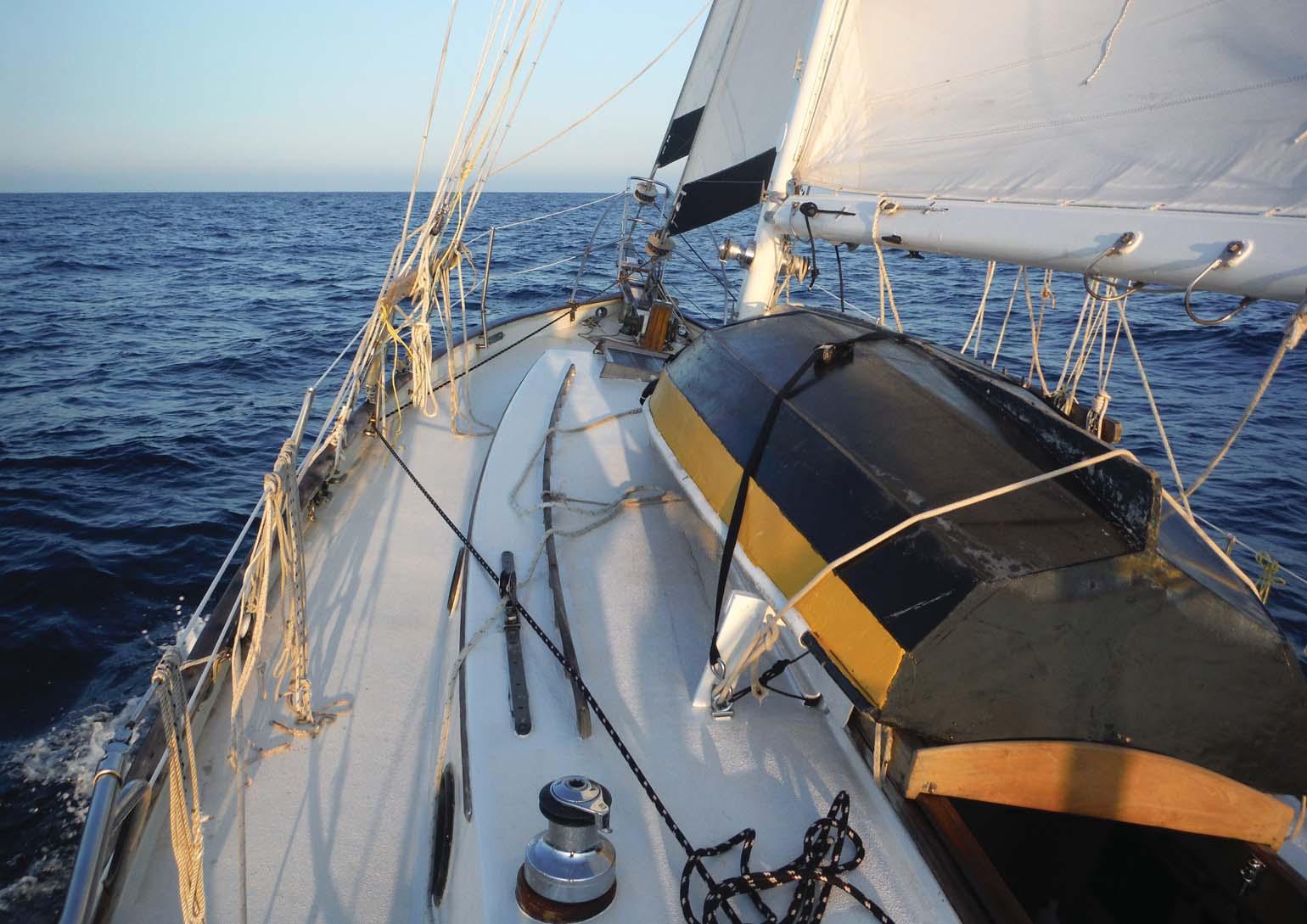
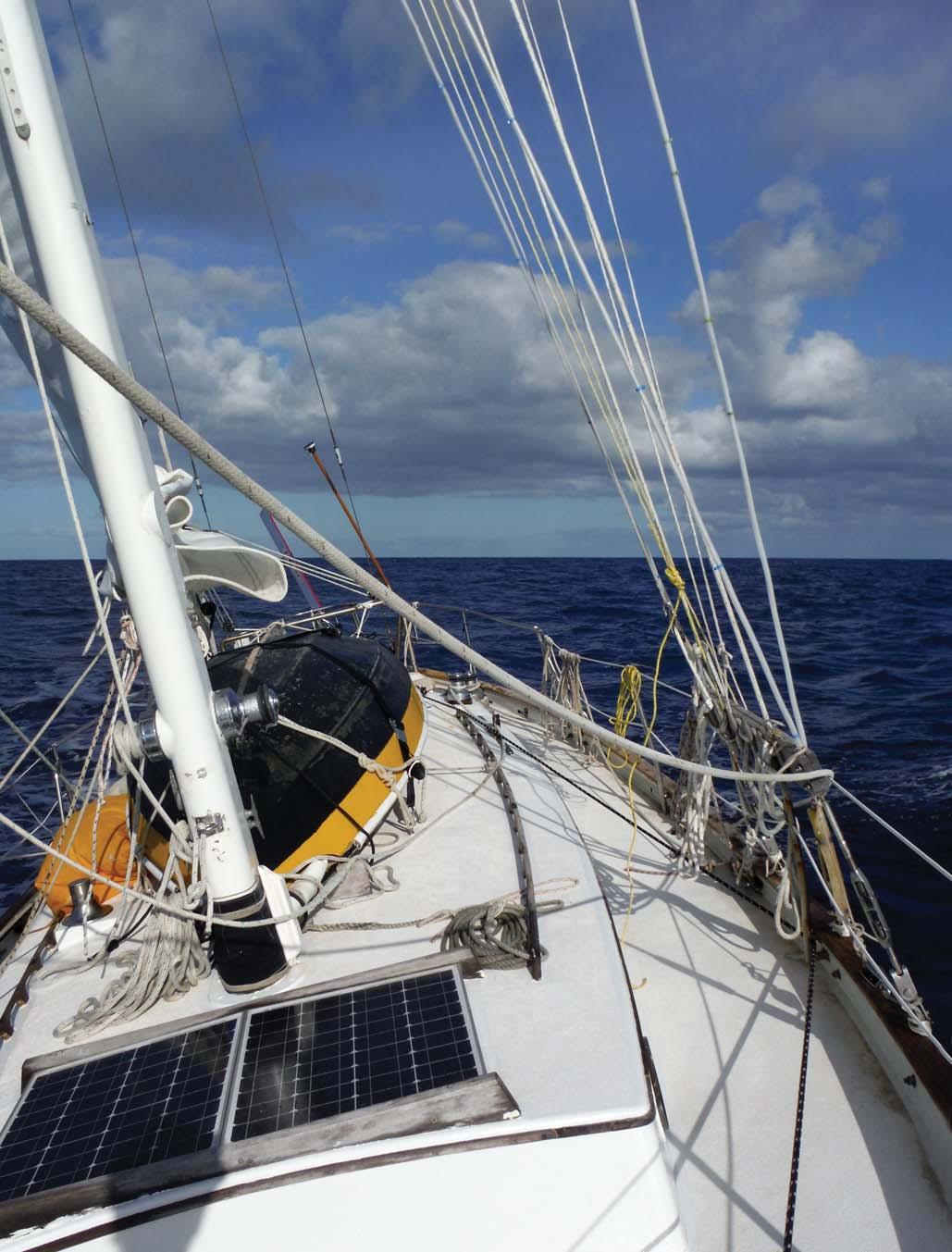
A large, metal isolated danger buoy adrift in mid-Atlantic

of vaccine elsewhere in the world, Bermuda had enough to vaccinate a transient foreigner and an efficient system to administer it. My admiration for Bermuda went up another notch.
Ireland announced that it would be open to fully-vaccinated travellers from 19th July so I decided to sail there without going via Iceland. This gave me an extra couple of weeks in Bermuda, which I used to do some of the things left undone during the Carriacou refit. Finally I jumarred* up the mast to inspect the rig, topped off provisions and water and on 18th June cleared for Ireland. The windlass failed, predictably, before the anchor was half-way home. I hauled up the remainder using a messenger to a cockpit winch, motored through the Town Cut and made sail.
A mid-summer, mid-latitude crossing of the North Atlantic should be an uneventful affair provided there are no hurricanes, and thus it was – a slow, easy passage with only the odd midnight tumble-to to reef and no equipment failures that could not easily be solved. Almost the only incident was on 1st July, about halfway across the Atlantic at 39°31’∙9N, 45°39’W, where we passed close to a metal isolated danger buoy, adrift, unlit and large enough to be a danger to small craft.
About 160 miles off the Irish coast we sailed into a calm and drifted for three days, slowly closing the coast. On 19th July, the day the border was due to open, I was still 30 miles offshore so motored those final miles to anchor off Bantry, 31 days from Bermuda
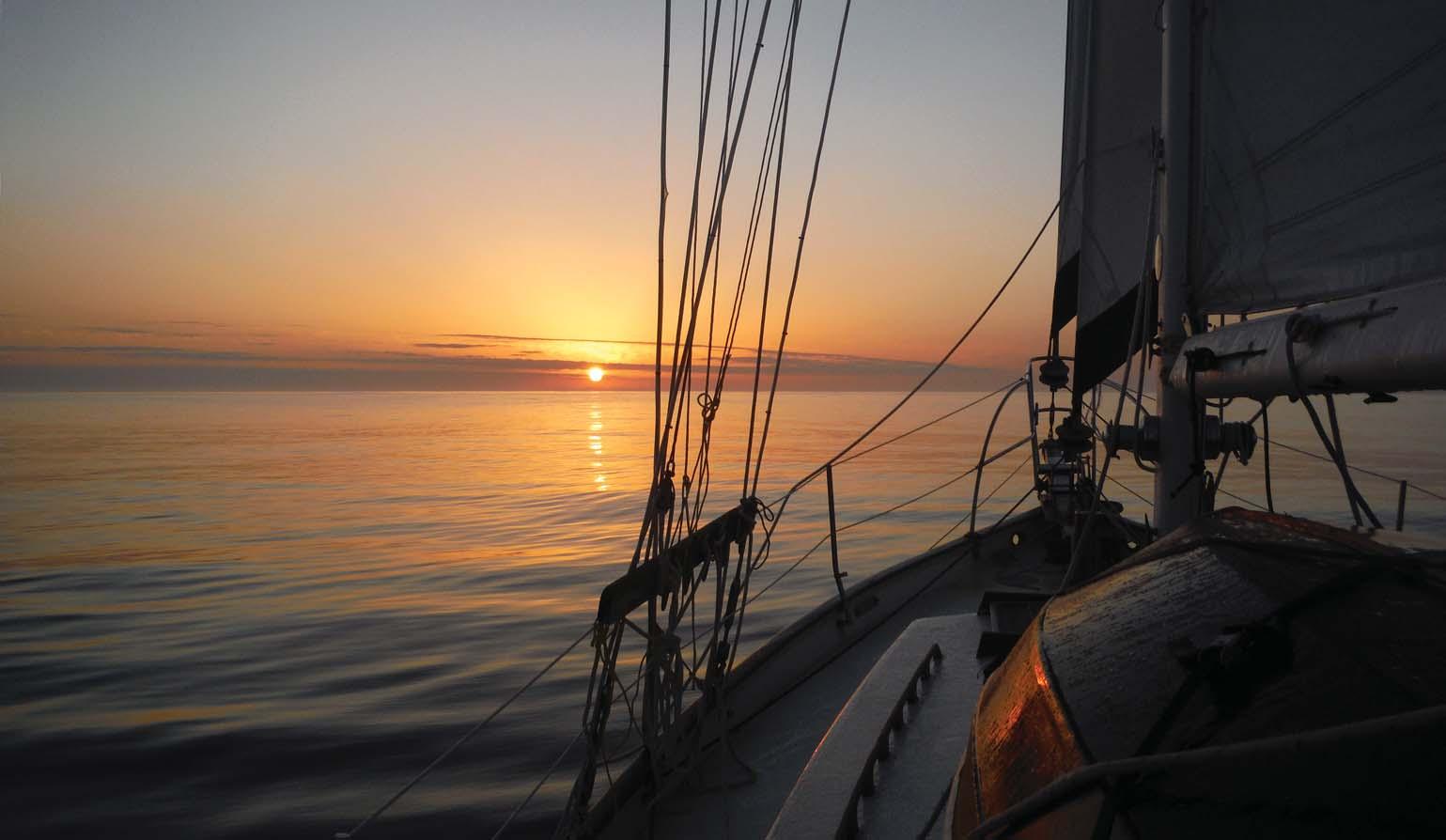 * Pairs of jumars are mused by climbers to ascend a rope or, in the case of mast-climbers, a halyard by clipping on ‘hand over hand’.
Becalmed off the Irish coast
* Pairs of jumars are mused by climbers to ascend a rope or, in the case of mast-climbers, a halyard by clipping on ‘hand over hand’.
Becalmed off the Irish coast
and having sailed about 3100 miles to make good 2700. Bantry Bay is a lovely landfall with uncrowded, secure anchorages in beautiful countryside and friendly, welcoming people. Where else, when you first go ashore after an Atlantic crossing, will a publican recognise you after a gap of several years, start to pull a Guinness as you walk to the bar and look offended when you attempt to pay for it?
In Bantry Helena Willes, a friend from New Zealand, arrived to join Iron Bark. She was understandably keen to get moving and see something of the Atlantic’s Celtic fringe, but first I needed to sort out the windlass – a 33kg anchor is too heavy for me to haul without mechanical assistance. There was not a suitable windlass in Ireland and UK suppliers regarded the post-Brexit paperwork as an insurmountable obstacle to exporting one, so we sourced it in Germany. Fitting it required fibreglassing in a new mounting pad, shortening the bowsprit and cutting new hawse holes, as well as fitting a new solenoid and deck switches. I also replaced the chain, as the old chain was American and their chain sizes have little standardisation even within that country and are entirely incompatible with those used in the rest of the world. The whole affair took nearly a month, which we spent anchored off Whiddy Island or Glengarriff. I have friends in both places so it was a sociable time.
There are crossroads in the sailing world where you meet sailing friends last seen half a world away. Glengarriff is one of them. On a previous trip I anchored in Glengarriff to find two foreign yachts there – Irene, American, last seen in Chile and recently arrived in Ireland by way of the Northwest Passage and Kraken, Australian, last seen in Antarctica. This time I met Nick Dwyer on Selene, last seen in New Zealand.
Glengarriff is also an excellent place to work on a boat. The protection is total and the holding excellent, a good thing as there was an extended period when hauling the anchor would have been difficult. The weather was fine and Helena spent her time walking and foraging for blackberries and mushrooms – she is a fine chef and the quality of the food on Iron Bark improved dramatically. She is also good with animals and soon knew the name and pedigree of every donkey within an hour’s walk.
The enforced stop allowed me to renew my passport through the Australian consulate in Dublin. For various reasons I did not fit in to their computer system so, like any misfit, I was batted between government departments then cast adrift. It took weeks of messing around and an appeal at ministerial level to get my passport renewed. The Australian civil service could learn a lot from Bermuda.
Eventually the new windlass and chain were installed and on 22nd August we motored down Bantry Bay in a flat calm to Castletownbere. There we went ashore to watch the Irish hurling final on television, described to us as ‘a grand thing, twentytwo Paddies in a field beating each other with sticks’. The next day, in continuing calm, we motored around the corner of Ireland and anchored in Ventry for the night, drifting on the next day with just enough wind take us close to Skellig Michael to see the monks’ beehive cells and to Little Skellig to see the huge gannetry. We sailed on overnight to Inishmore in the Arran Islands, anchored, and walked up to see the iron age fort of Dun Aengus. One wonders what, on Inishmore, a fairly barren island, was valuable enough to justify the effort of building such a huge defensive structure. The Iron Age was clearly not a time of peace and love between neighbours.
We returned to the mainland at Carraroe so I could catch a bus to Dublin to collect
my new passport, then overnight to Inishbofin island, which has a fine pub with good music, good walking and, if you are fortunate, corn crakes. Helena rowed across to a fishing boat to buy some fish and returned with a bucketful, all payment being refused other than that for a lobster which she ordered for delivery the next day. With such excellent raw materials and Helena’s cooking skills, dining on Iron Bark reached even greater heights.
We moved on reluctantly after four days at Inishbofin. It was now early September and I wanted to be on the west coast of Scotland and within reach of the shelter of its sea lochs before the onset of autumn gales. Our last anchorage in Ireland was the lovely bay of Little Killary, where we went ashore for a walk and to feed the midges before sailing for Scotland.

From Little Killary it is about 275 miles to Mull, which took three days in generally moderate wind. Helena kept watch by day and I by night. A pod of dolphins surfed the quarter wave to Helena’s delight, and there was a minke whale off Tiree. The breeze headed us in the Sound of Mull and we beat up to Tobermory and picked up a mooring early on 7 September.
Tobermory is a tourist town of no great appeal, chosen as a place to clear into the UK because it is big enough to have a harbour master and mobile phone reception. I never know what to expect when clearing in using the UK’s National Yachtline. Sometimes they demand ship’s papers, last clearance and passports to be photocopied, certified by the harbour master and faxed to them, other times they appear to be bored by the whole affair. This clearance was of the latter sort. The harbour master was completely uninterested and Yachtline scarcely more so.
Moidart, complete with ruined castle

With clearance into fortress UK out of the way we bought the Clyde Cruising Club guides for Scotland, had a couple of pints of beer and next morning sailed to Loch Drumbuie. This was much more to our taste – a well-protected, empty anchorage with good walks and no need to depend on a mooring or to pay for the privilege. Now that we were among the sea lochs we could slow down, as there was always shelter close by to ride out bad weather. The only issue is that, deep within many of the lochs, weather forecasts are difficult as VHF and mobile phone reception are poor.

We meandered northwards around Ardnamurchan Point to Loch Moidart and anchored in a pool protected by a picturesque island complete with a ruined castle. The channel into the inner part of Loch Moidart is tortuous with one section that is too shallow to pass at less than half tide. Our entry would have been easier if I had not miscounted the islets, got lost and strayed out of the channel. We did not run aground, but there was not much water under the keel by the time I realised my mistake.
We lay in Moidart for three days, during which time we walked, looked at villages abandoned during the Highland clearances and foraged for chanterelle mushrooms.
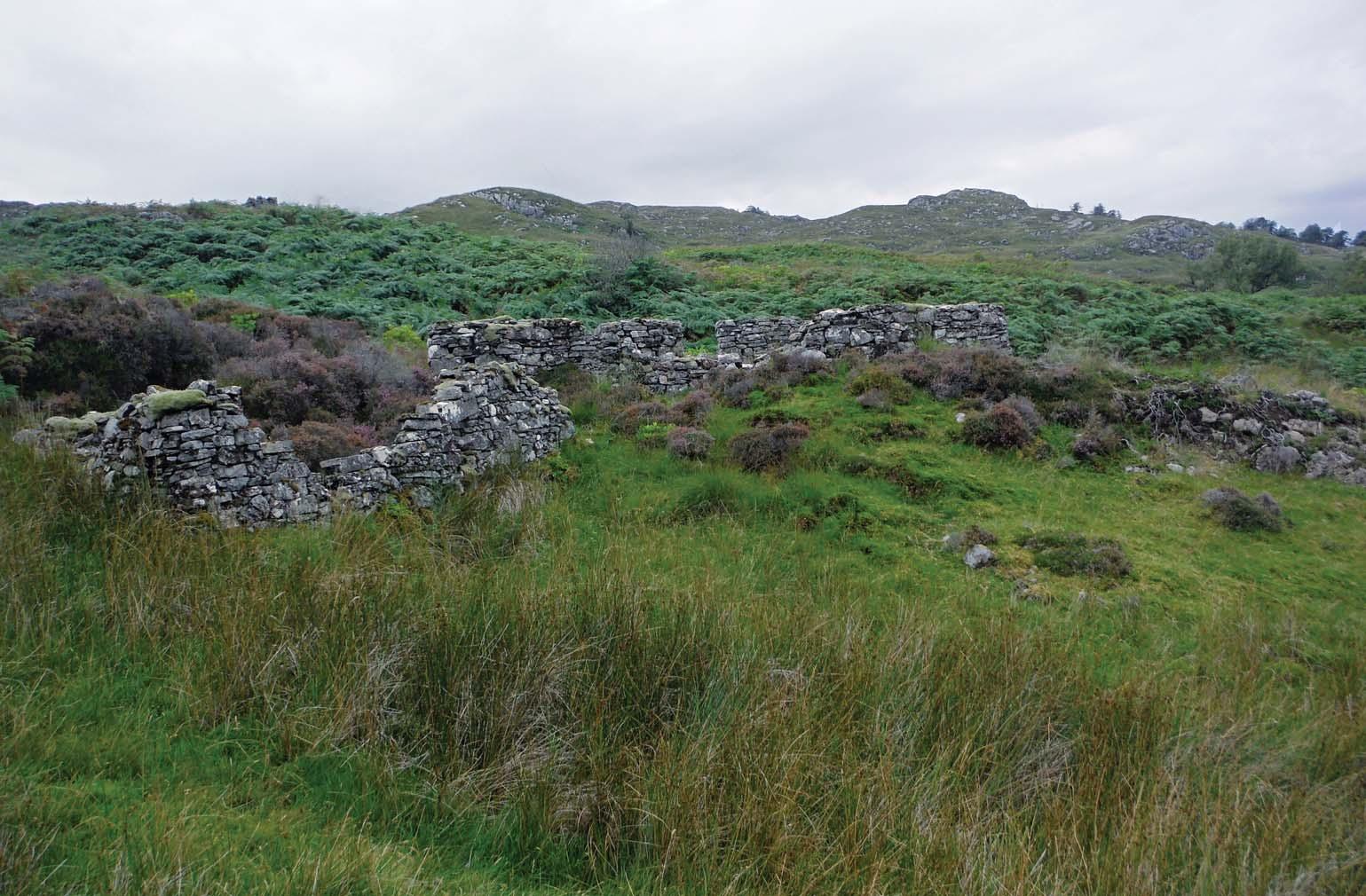
Helena hitch-hiked 6 or 8km to the nearest village to get internet access so she could send a graphics design file to New Zealand for a job she was doing. Helena has long hair and I have noticed that people with long hair have better success hitch-hiking than those whose hair is short. Perhaps I should grow mine.
Thence to Canna, which is by far the best anchorage in the Small Isles. It is wellprotected and has good holding provided the anchor sets before it is fouled by kelp. We walked (it was too late in the year to see any puffins in their nest burrows), went to a music workshop by James and Kathy McKenzie of Shawbost on Lewis (I had met James in 2015 when he gave a concert in Stornoway) and Helena treated us to the Canna Cafe’s deservedly famous seafood platter. This was despite my being in her bad books for disrupting the cabin while sorting out an alternator problem. It is depressing how quickly pulling out tools and parts for a minor job renders a previously orderly vessel uninhabitable.
Helena wanted to see Skye, so we sailed up the Sea of the Hebrides to Loch Dunvegan and picked up a mooring as there is little room to anchor. Dunvegan has an excellent, quirky vegetable shop run by a rosy-cheeked, white-headed elf but little else of interest. We took a bus to Portree, which confirmed my previous prejudice that the bridge to the mainland has transformed anywhere on Skye within reach of a road into a motor-home park.
We fled across the Little Minch to the Isle of Lewis and anchored in Loch Seaforth for two windy, squally days during which we did not even launch the dinghy, then sailed north to Loch Grimshader. There we were boarded by Border Force, who were clearly underemployed and looking for ways to justify their existence. Grimshader is a well-protected anchorage close to Stornoway, making it a pleasant alternative to using Stornoway’s marina for those who dislike such things. The bus service on Lewis is good, and we used it to go shopping in Stornoway and to see the standing stones at Callanish. The only thing Grimshader lacks is a watering stream or tap within rowing distance of the anchorage.
On 4th October we sailed back across the Minch in drizzle to anchor behind Isle Martin in the mouth of Loch Broom, lit the heater to dry out, and went for a walk on Isle Martin. A day later we sailed down Loch Broom to Ullapool to see old friends. I like the village of Ullapool and its people, and was pleased that so many of them remembered my last visit on Iron Bark II. Ullapool would be higher on my list of desirable places if the anchorage was not so deep and so open to the east. The harbour authority has eight visitor’s moorings which alleviates this problem, at a price, but dinghy work in a northeast wind of any strength is difficult.
From Ullapool we sailed down Loch Broom to the Summer Isles, a lovely spot, thence again across the Minch to Grimshader. I had decided to spend the winter in Stornoway, as I had done in 2014–2015. It is an interesting town, the harbour is well-protected and in winter the marina fees are low. We lay in Grimshader for a week and then, in late October when harbour dues fell to winter rates, I moved Iron Bark to her winter berth in the Stornoway town marina. Helena left, the standard of eating fell and I got on with the apparently endless task of transforming Iron Bark III into a voyaging vessel.
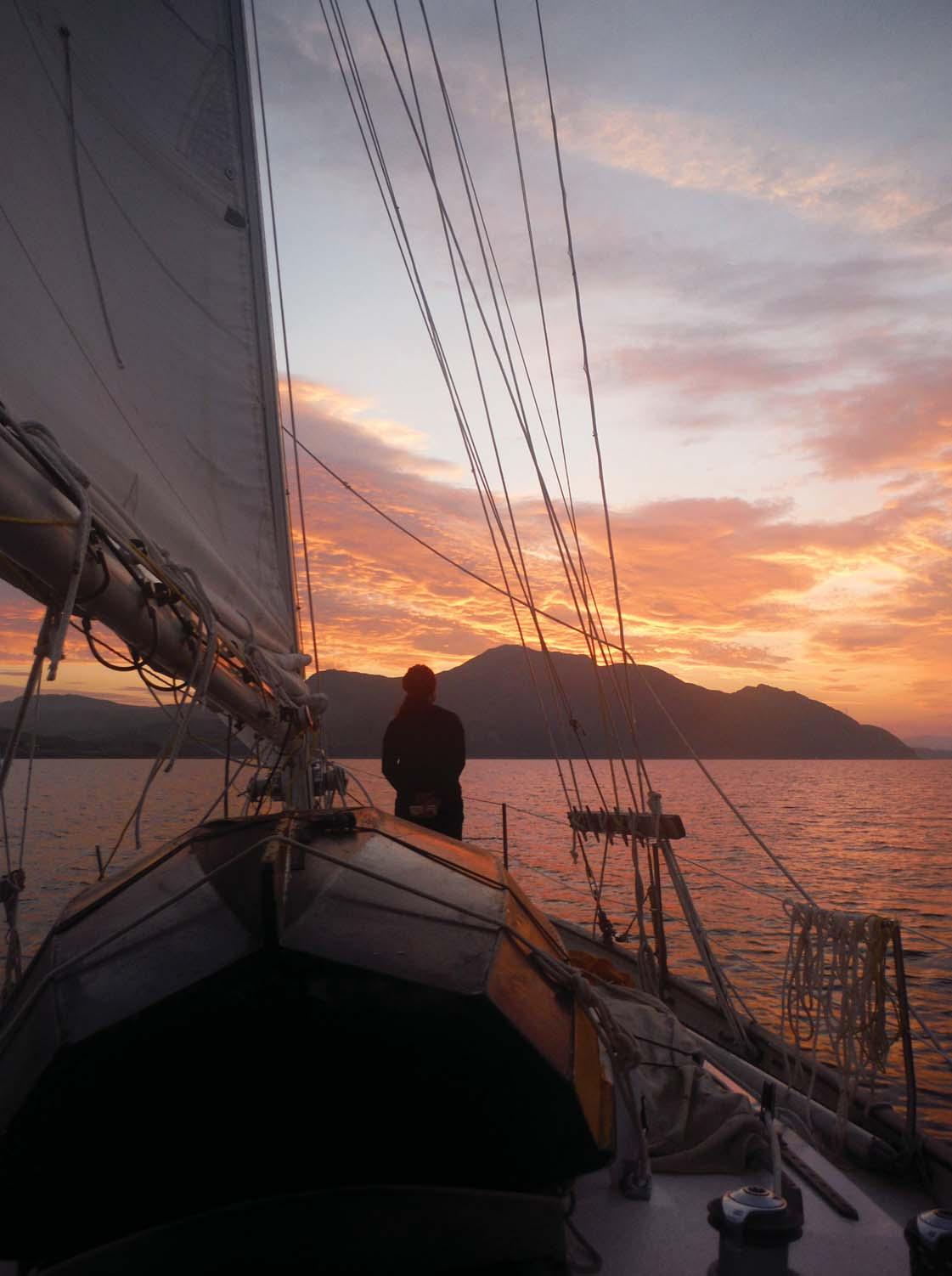 Quiet sunset sailing in the Minch
Quiet sunset sailing in the Minch
With a completely independent self-steering windvane AND Emergency rudder... in place and ready to go
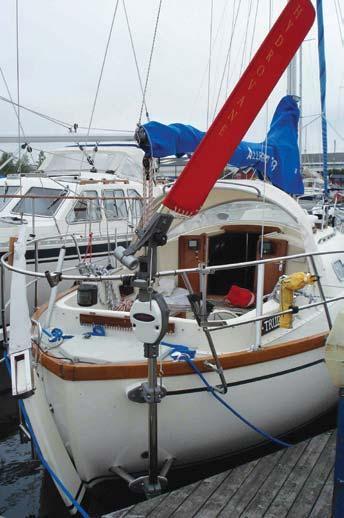

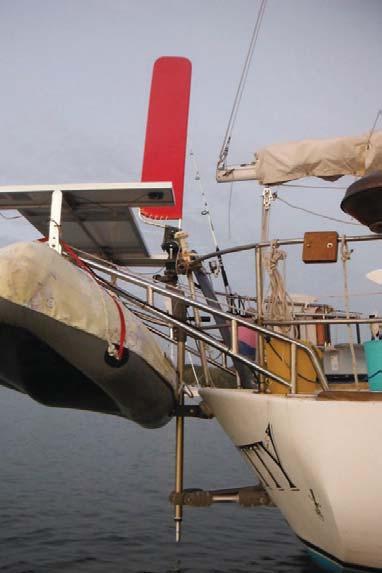

Your best crew member - steers 24/7 with no complaint!
Full access to your cockpit with main wheel / tiller fixed No problem to install off center - keep your davits or platform

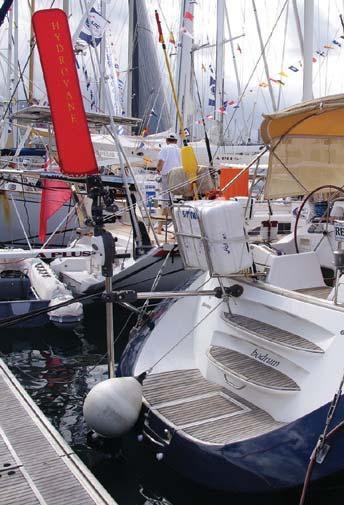


Have confidence in case of main steering or rudder failure

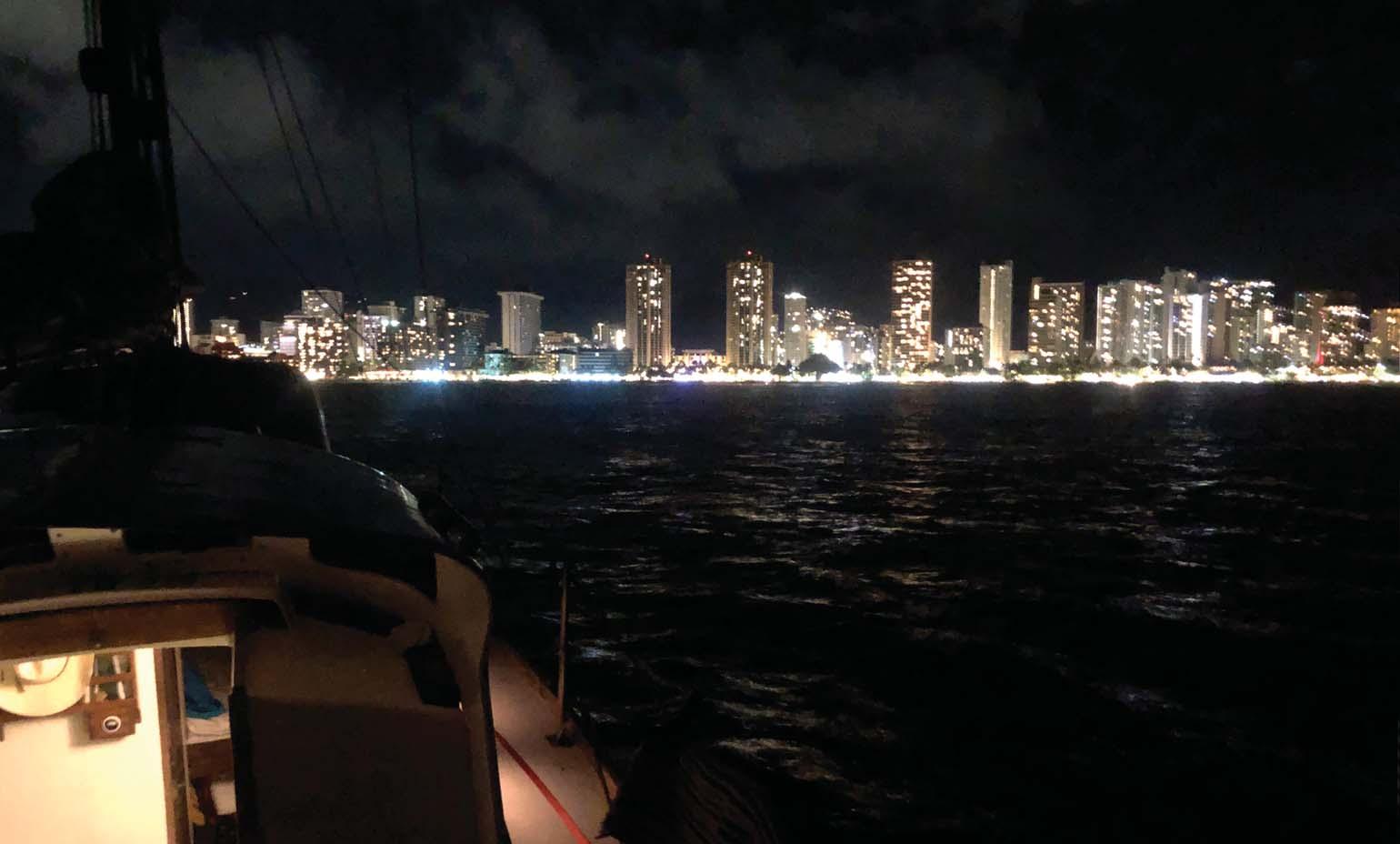 James Frederick
James Frederick
(See 1000 Miles Steered by Drogue in Flying Fish 2021/2 for some background on both James and his 1965-built Alberg 30 Triteia – and why, in October last year, he was testing out a jury repair...
James’s atmospheric photo of Triteia at anchor off Rangiroa in the Tuamotu islands appears on the front cover of this issue.)
The stove swung in the familiar way as Triteia rolled in the Pacific swell while I made dinner. I looked aft out of the companionway and saw a beautiful gradient of orange to blue as the night chased twilight from the sky. Climbing out on deck I moved with the rolls and turned towards the bow. I was caught off guard by what I saw, the sparkling skyline of Honolulu standing just shy of the long stretch of sandy beach the world knows as Waikiki. We were on the hook, so it was not the city itself that had surprised me but rather the cinematic beauty of such a dramatic skyline aglow with lights shining in the growing darkness as the tropical Pacific Ocean rolled in wave after wave. Diamond Head stood sentry off my port side, an icon of O‘ahu and Honolulu. The steady trades found their way over the low ridge and kept Triteia in the lee of the island and coral that protects the town’s beaches. I stood and took in the sight – it was one I will remember.
Earlier in the day I had left the dock at Ala Wai Harbor on my maiden voyage with my jury repaired rudder. I’d had stainless steel strap tangs made and had dived on the boat, hammered them into place and used a hand drill to drill out and through-bolt them to my wooden rudder. Along with these new tangs I had readjusted and left in place one of the ratchet straps that I had installed the day after my arrival to complete
Waikiki by night ...my buoy run*. After my jury repair was complete I decided it was time to climb back on the horse, as they say, and get out to see some of O‘ahu’s anchorages. My first passage was a nail-biter as I was alone and knew from the experience of my arrival that the tow services in Hawaii could not be relied on. I made my way out of the harbour and through the dredged channel which sits between a breakwater to starboard and surfers riding perfect waves a few boat lengths to port at a popular surf spot locally known as ‘bowls’. While I had full faith in my repair, that didn’t stop me from gripping the tiller so tightly that my knuckles turned white. This first, high-stress passage covered a distance of 1½ nautical miles, which probably lasted less than half an hour but felt like five hours. I dropped the hook at ‘the bight’ anchorage off Waikiki, the same spot where I had anchored on arriving at O‘ahu after 32 days at sea.
My plan was to spend the night in this exposed roadstead anchorage and depart before first light. This quick hop to the only anchorage close to Honolulu gave me some confidence in my jury repair, and I was relieved to have a short test-run before committing to longer passages. I had hoped to head up the Molokai Channel in the early morning bound for Kaneohe Bay on O‘ahu’s East Side, but a close look at the weather a few days out showed that the trades were forecast to increase to force 6. This would have placed me on a lee shore and trapped me in a bay littered with uncharted bommies (see footnote page 40). With this knowledge I decided to depart in the early morning and make my way to O‘ahu’s west coast anchorages, my first destination being Pokai Bay.
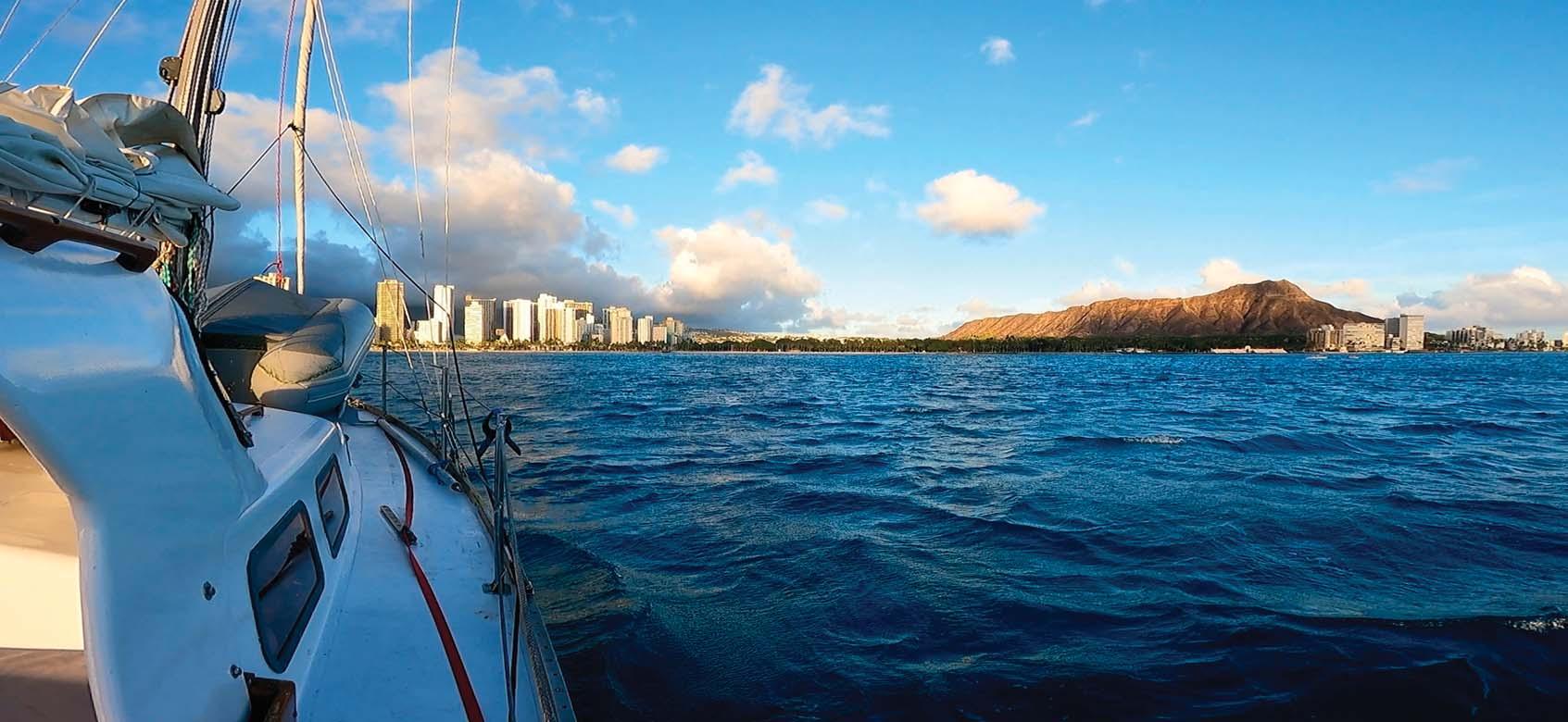
I woke at 0300 rolling from one side of my V-berth to the other like an errant pencil left on a chart table in a seaway. The wind had dropped and a large swell was wrapping around the island, causing the boat’s motion to almost be comical had one been watching it from dry land. I made my way out of the berth with motions and
* A requirement for all newly arrived boats to get a guest slip in the state harbour is to motor out from the inspection berth, down the channel and around the last of the channel marker buoys before returning to the inspection dock. They require this even if you have just sailed from the mainland. (When I cleared in I didn’t mention to the harbour master that my rudder was broken, and aimed to keep that knowledge to myself).

movements usually reserved for navigating those amusement park buildings whose trick floors move in all directions. I had even deployed my roll stabiliser before turning in for the night, but the Pacific seemed not to notice as she made her way under Triteia and continued her course. I lit and stabilised the stove and, against common advice, watched the kettle waiting for it to boil. Once the coffee was made and consumed I wasted no time readying the ship and recovering the anchor. Motor-sailing in the light winds of the early morning I made great speed with the current’s assistance.
The passage was a quick one, making some 30 miles in under six hours, taking us past the Pearl Harbor Security zone and rounding Barbers Point. There the seas became a bit sloppy and the winds increased, adding to our speed. Once around the point and on the island’s leeward side I hugged the coastline, trying to identify landmarks from my cruising guide. The dramatic Waianae Range stands proud onshore, once part of a large volcano that crumbled into the sea, its beauty is something to behold.
As I sailed just off Kalaeokakao I saw the deep cobalt-blue waters turn into a brilliant turquoise and saw the depth sounder jump from 70ft to 12ft (21m to 3∙6m). I quickly grabbed the tiller and steered Triteia out into the deep blue sea, grateful that she has
On passage to Pokai Bay

shoal draft. Soon I was able to see masts and an A-frame structure onshore that helped me identify Waianae Small Boat Harbor, which sits just across the bay from our intended anchorage of Pokai Bay. The cruising guide said it was very difficult to see the entrance to this unique anchorage and they were correct. I spent half the time looking at my Navionics app and half the time staring at small waves breaking on what appeared to be a rocky shore. Pokai Bay is a very unusual anchorage, situated behind a breakwater that protected a marina which once occupied the bay. Soon I could make out masts in the anchorage, confirming that the rocky shore was the breakwater, and in short order I was coming about into the anchorage. A sailor on a larger sloop anchored the furthest in stood on his aft deck waving me in and motioning for me to tuck in between him and the shore and I thanked him as I passed by.
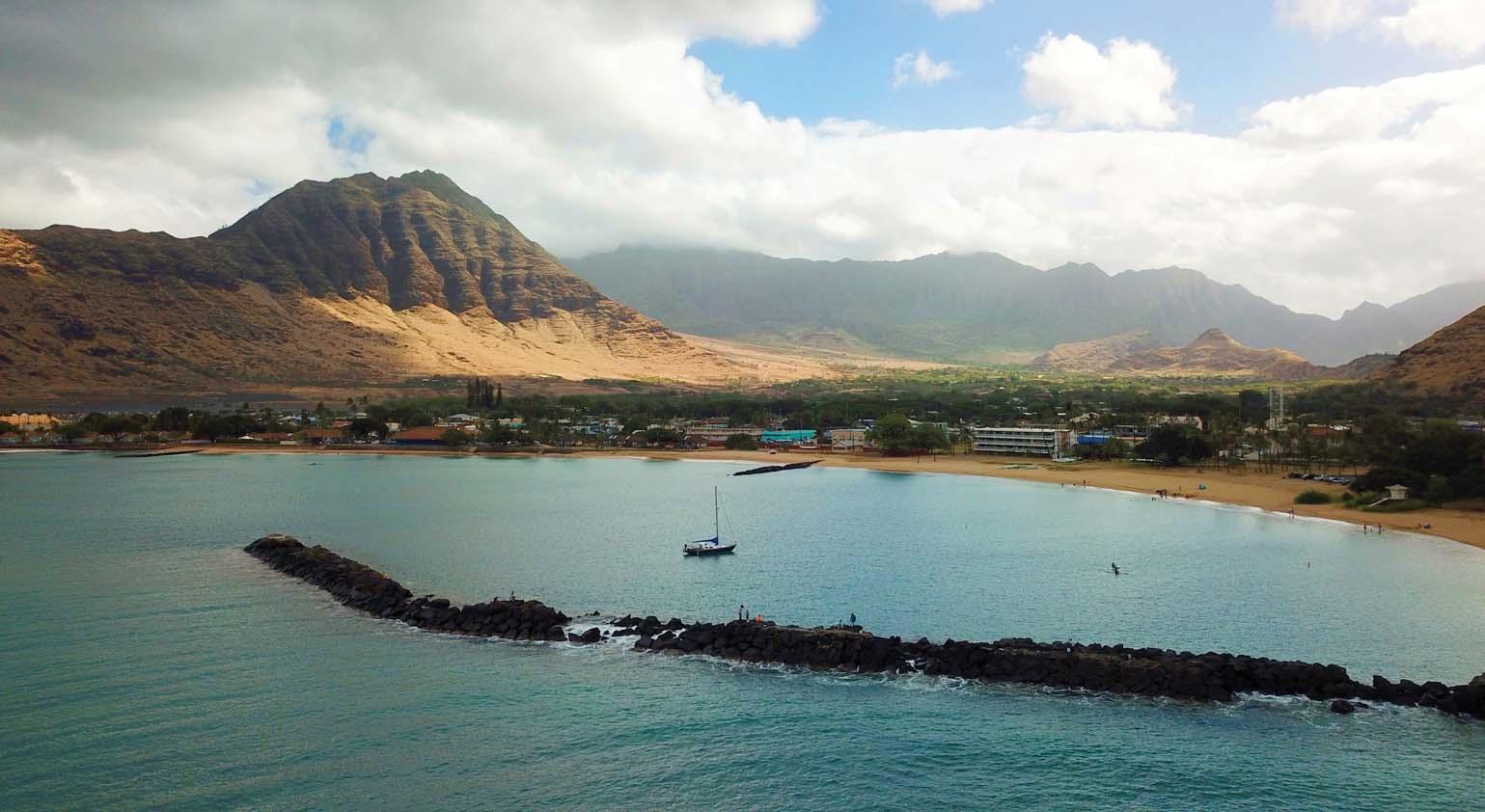
I dropped the hook in 12ft of water and paid out x5 scope, but hauled up some time later and reset the hook after finding poor holding close in. I attempted to dive on the anchor but could not find it due to zero visibility. I recorded my distance to the breakwater with my rangefinder and wrote it in the logbook, which I kept open on the chart table for quick reference. While the breakwater offered wonderful protection from the swell, it was also in our lee with the prevailing winds becoming katabatic as they made their way down to the sea and into the bay. I got my dinghy in the water
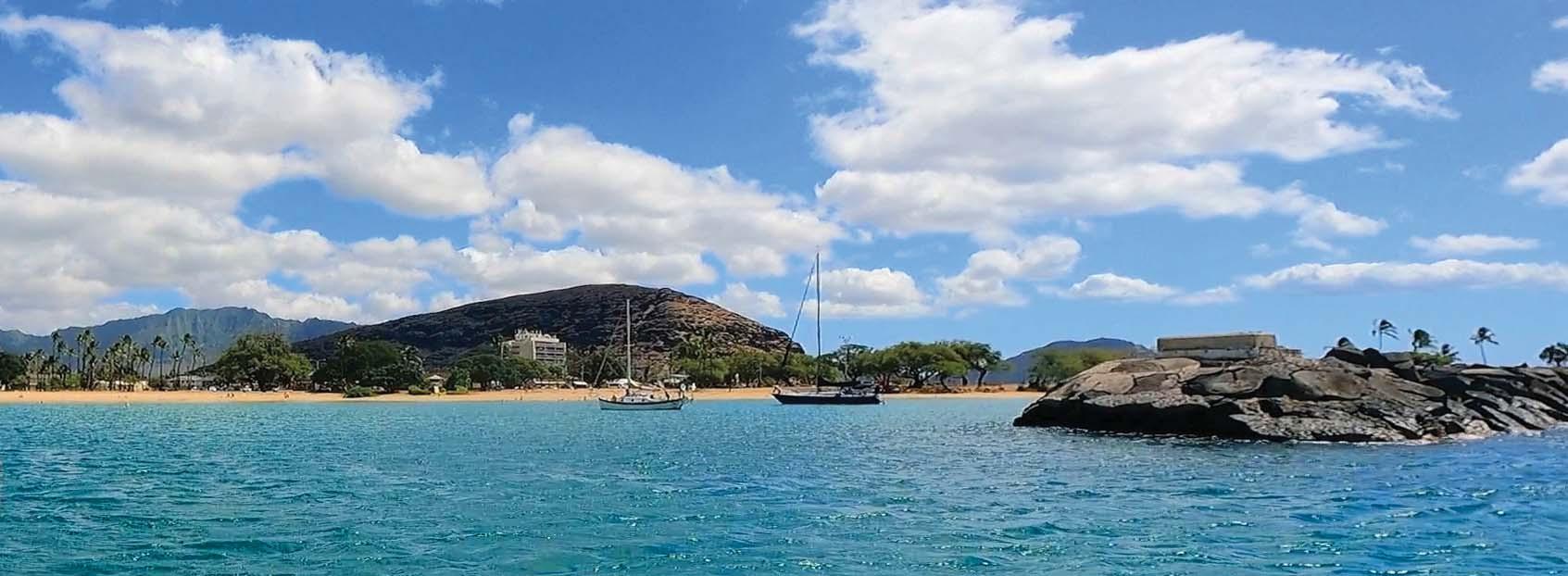 Pokai Bay, sheltered by its disused breakwater
Pokai Bay, sheltered by its disused breakwater
and made my way over to the friendly sloop to thank them for suggesting I anchor so close to them, something I would not have done without an invitation. We had a nice chat and they passed on some local knowledge and tips about the other west coast anchorages I planned to visit.
I spent the rest of the afternoon snorkelling and enjoying the warm waters of the shallow bay, taking in the underwater sights along the old breakwater while fishermen stood atop doing their best to catch some dinner. The underwater visibility slowly improved as I made my way out and around the breakwater. Some of the highlights were seeing a large school of tang, a slender trumpet fish and some of the usual suspects of moorish idols, sergeant majors, rainbow wrasse and triggerfish. I also came across a ‘honu’ (Hawaiian for turtle) cleaning station, where large Hawaiian green sea turtles enjoy a spa day while small fish clean them of parasites and algae.
Once back aboard Triteia I sat on the bow as the sun set and listened to local families enjoying the protected beaches of this small bay, while staring in amazement at the towering mountains that surrounded me. As the golden hour passed the erosion patterns on the mountain faces cast dramatic shadows on an already remarkable scene. The muted light on the Waianae range made it look as though it were the backdrop in a 1960s western.
The night was so peaceful and still that it felt like I was anchored on a lake, quite a contrast to the previous night’s motion at Waikiki. Next morning I heard the boat next to me hauling up and heading out. I grabbed my goggles and swam out to get eyes on my anchor. After some searching, I found it sitting perfectly positioned on top of hard pan with about 1 inch of its fluke in a small notch with no hope of setting any deeper. Knowing the winds were forecast to increase in the night and
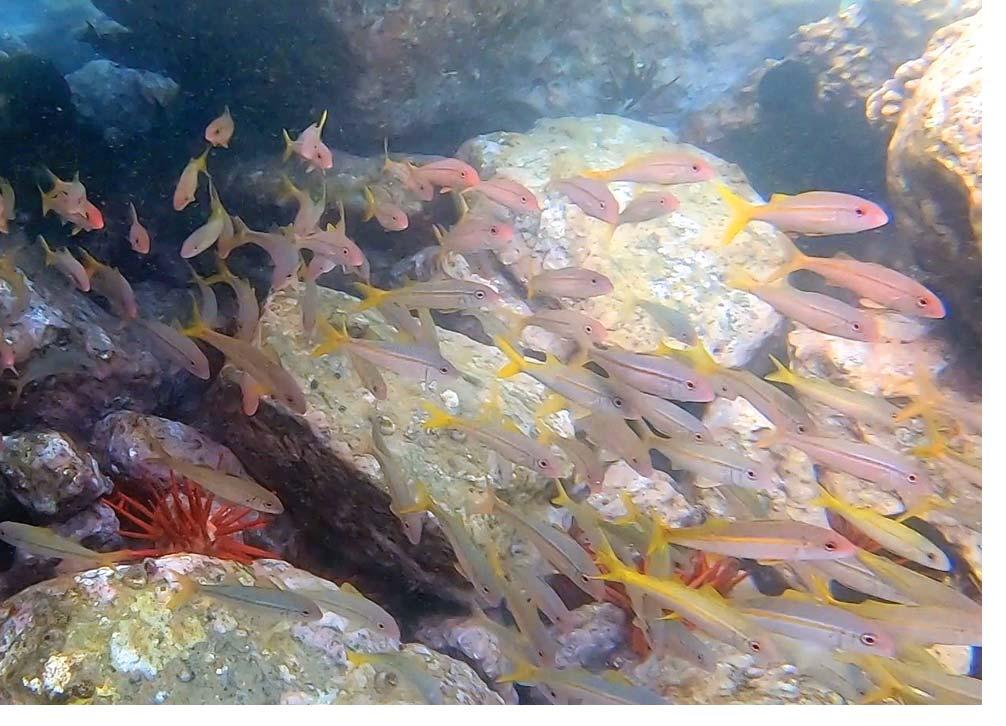
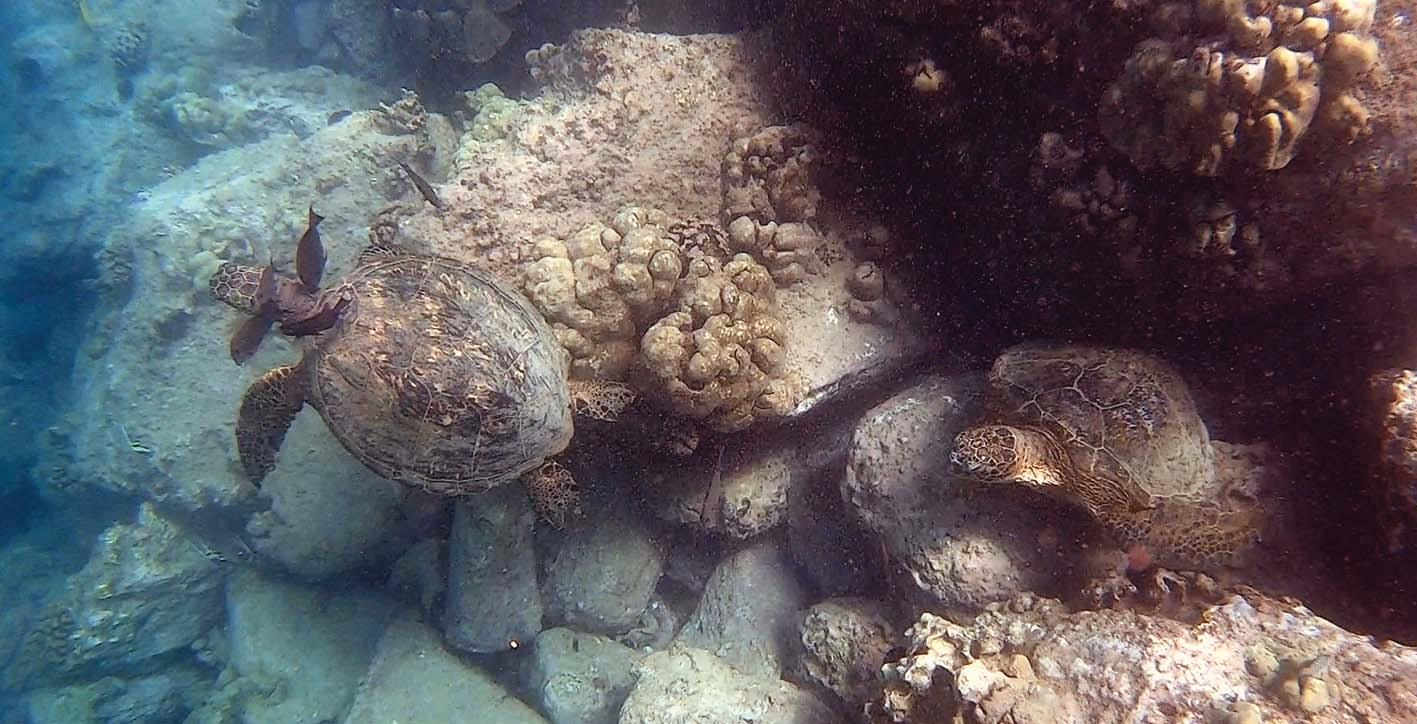 The turtle cleaning station
The turtle cleaning station
that they would remain strong for days to come, I returned to the boat and hauled up, moving Triteia into the spot of the yacht that had just departed. The hook set solid and deep, and I paid out x5 scope with room to let out x7 if needed. This time when I dived on the anchor it was buried in sand up to the roll bar and was completely obscured.
The breeze began to increase in the afternoon and the high winds arrived right on schedule. Over the next few days I saw the wind increase to force 7 as it accelerated down the slopes of the Waianae mountains and hammered the small bay. With my anchor snubber taut I didn’t leave the boat for 24 hours for fear of the breakwater that was in my lee. My range distances held as true as the anchor and we didn’t budge.
The following day the winds calmed a bit and I finally decided to row ashore for a walk and to check out the town. I had been warned by many local cruisers not to leave my dinghy unattended on the beach anywhere in Hawaii and if I took it ashore to ask the
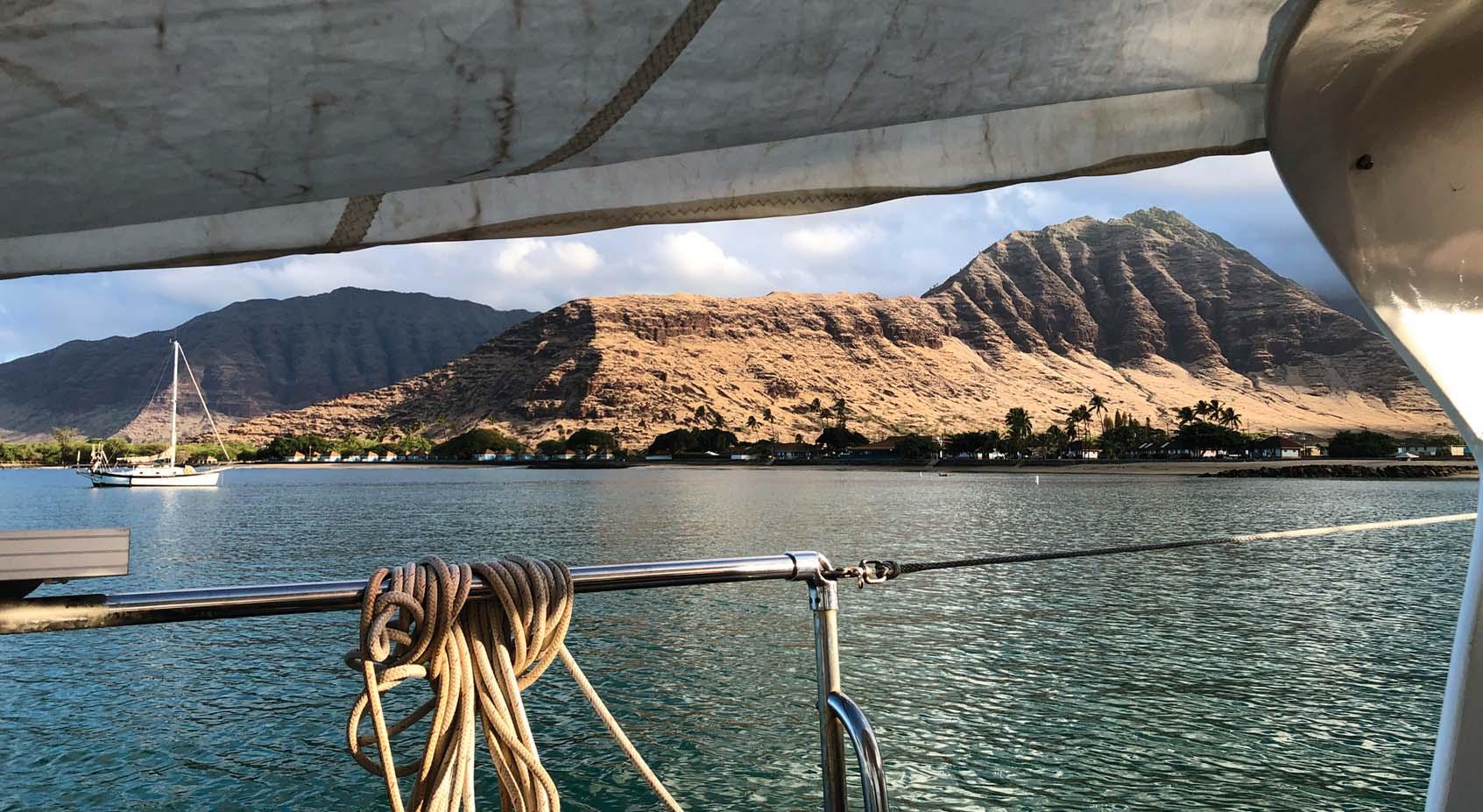
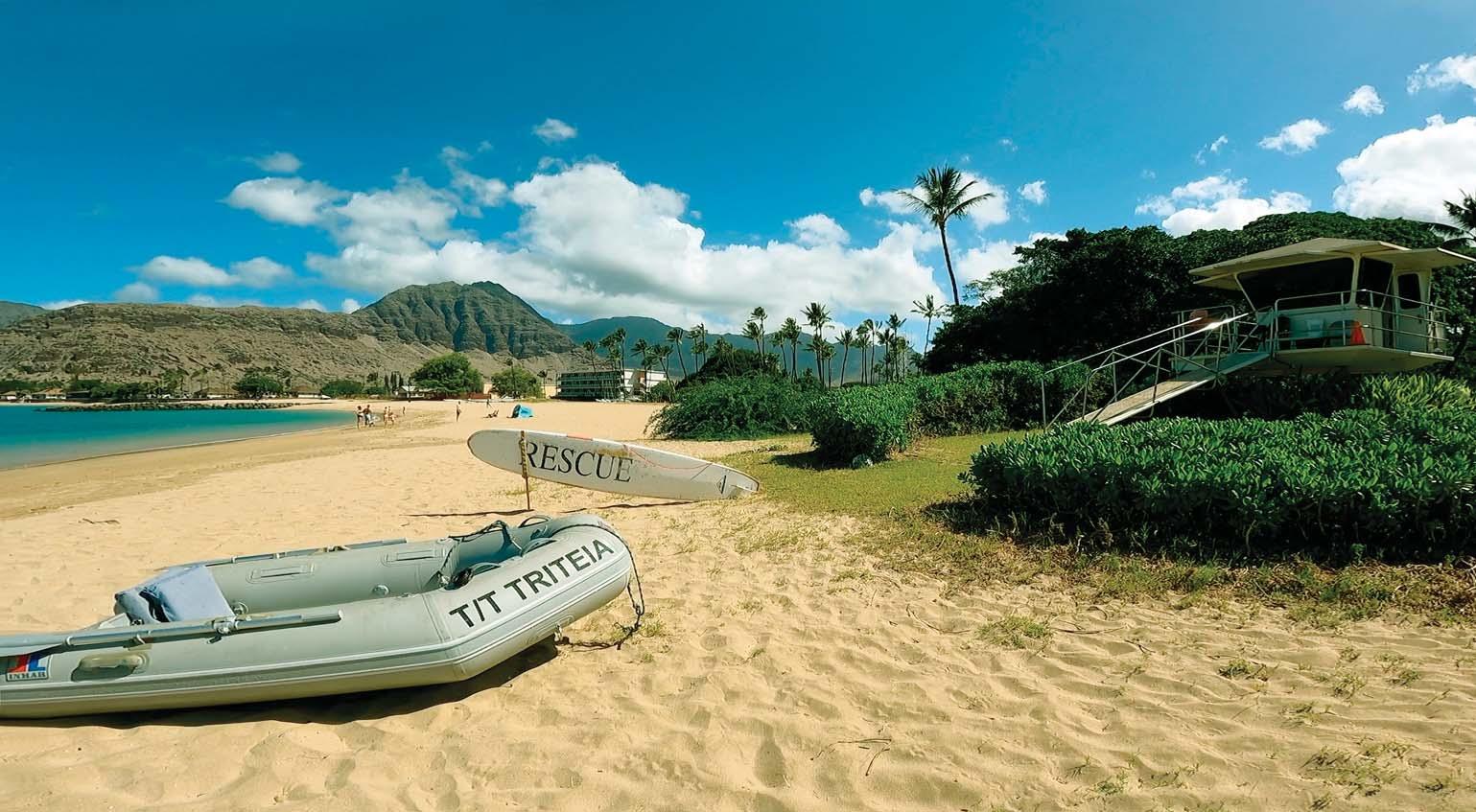 The dramatic Waianae Range
I left my dinghy below the lifeguard tower
The dramatic Waianae Range
I left my dinghy below the lifeguard tower
lifeguard on duty if they would watch it for me. I left my outboard locked to the stern pulpit of Triteia and had my first experience of rowing an inflatable in 15 knots of breeze. Dragging my dinghy ashore I inquired at the lifeguard tower if it would be okay to leave my


dinghy near them and they said it would be fine.
I walked through the park and made my way up a side street towards the main road where I was met by a gang of chickens, a very common sight in the Hawaiian islands, engaged in chicken business and quenching their thirst at various pans of water that looked to have been left out for them. Once at Farrington Highway I could see several eateries, both fast-food and local dives. I walked north towards the Waianae Store, a large, well-stocked grocery store where I picked up some more provisions. Waianae is a
The Beach House by 604 Pokai’s stunning beachsmall, quiet town where you find mostly local families and almost no tourists. There is a coin-op laundromat close to the anchorage, a tackle shop and more fast-food joints.
I had lunch at a wonderful brewery called ‘The Beach House by 604’ that has a large open veranda where you can dine while enjoying an amazing view of the turquoise waters of Pokia Bay. This was the first time I’ve ever had the pleasure of eating at a restaurant while looking at my beautiful boat resting on her hook. After lunch I made my way back towards the beach and visited the Kū’īlioloa Heiau, a site sacred to the Hawaiian people (heiau means temple in Hawaiian) just south of Pokai Bay on Kane’ilio Point. Kū’īlioloa Heiau is the ancient heiau for navigation and sea voyages. It was the place where Polynesian star navigation and wayfinding techniques were taught and is the only heiau that is surrounded by the sea on three sides.
Once back at my dinghy I found a note from the harbour master of Waianae Harbor, the next harbour over, telling me I had overstayed the 72-hour time limit (this was morning of my fourth day there). After speaking with him on the phone and voicing my concerns about the high winds that were still blowing he allowed me to stay until the front passed. (In Hawaii you are only allowed to stay for the aforementioned three days in any one anchorage. It is intended to prevent people living on derelict boats and polluting the beautiful bays for weeks or months at a time.) I was surprised at the note, as everyone had told me that the time limit is never enforced at Pokia Bay because there’s no marina or harbour master at that location. I spent the next few days riding out the winds, which stayed strong and increased to near gale force at night. I passed the time by writing and editing video, breaking up the computer work by going for a swim or reading in the cockpit. Rain clouds would march across the island bringing light showers as they passed and accenting the landscape to make it look more like a painting than real life.
By the morning of my fifth day the wind had decreased enough for me to feel okay about moving on. Once my coffee was consumed I hauled up and was bound for my next adventure, the most remote anchorage on O‘ahu – Mākua Bay. It was a short and easy motor-sail some 6 miles north before the large, open, roadstead anchorage was
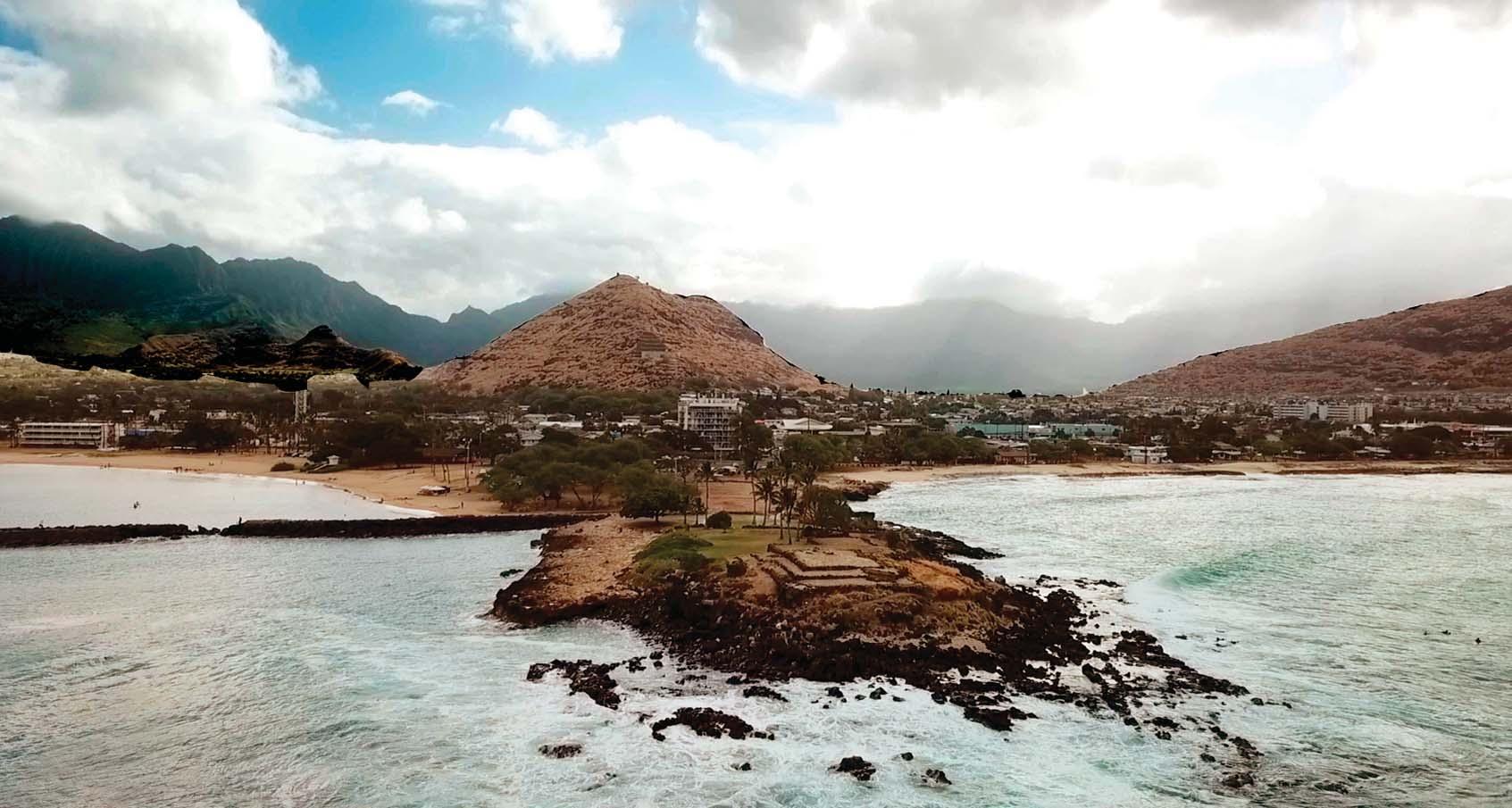
on our beam. Mākua anchorage covers an area over half a mile wide, with an all-sand bottom and good holding in as little as 9m several hundred metres offshore. It is framed by the Waianae Mountain Range and Mākua Valley. It was as though I’d sailed into one of the Lord of the Rings movies. The landscape was simply unreal.
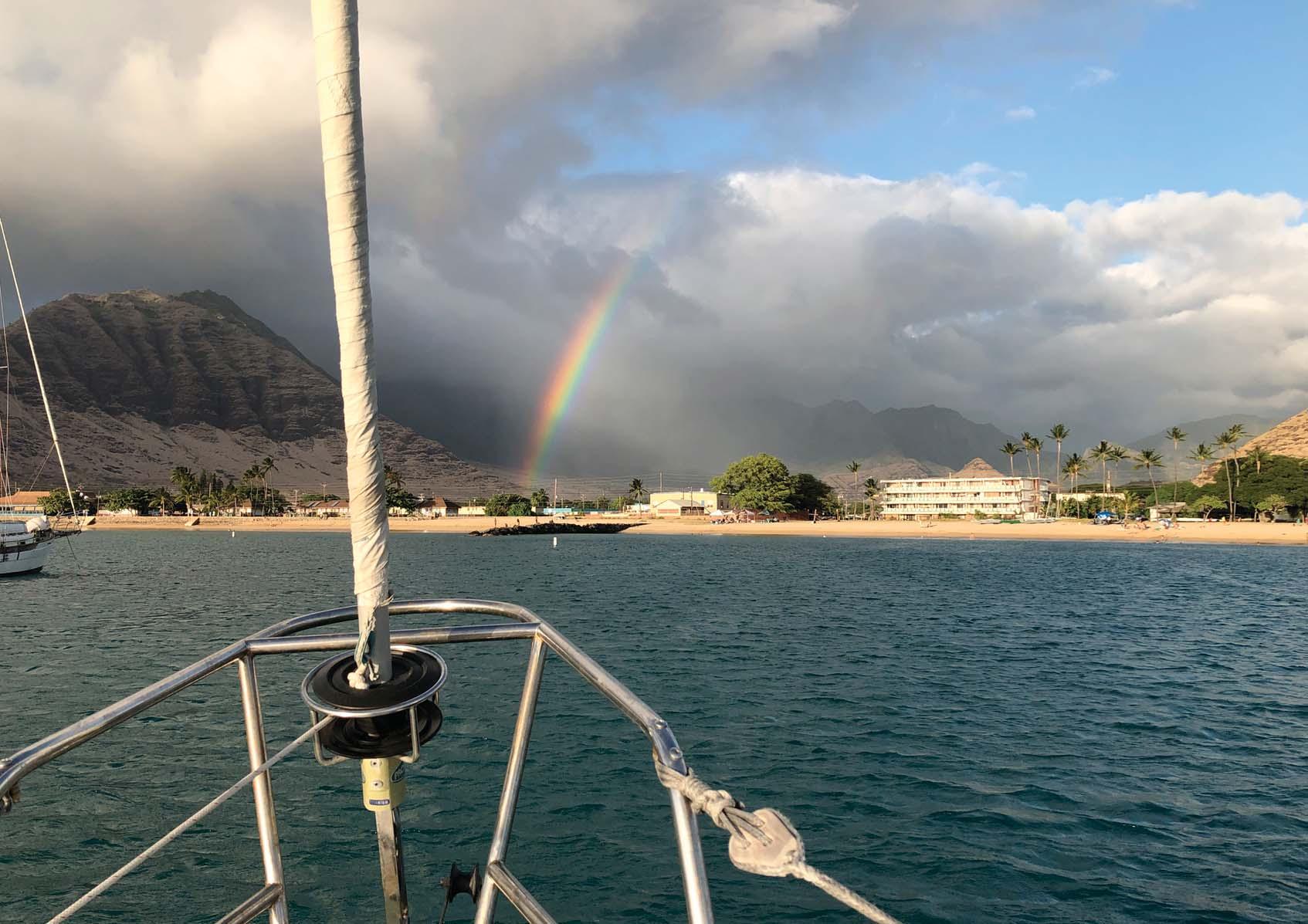
Once I could see the anchorage clearly I looked at the hill face and guessed that the winds would scream down into the anchorage, even though at under 0∙75 miles away I was in 6 knots of wind. I had kept the mainsail reefed down for the short passage and slacked the mainsheet just in case. Within a few minutes I could see the texture on the water in the anchorage and soon we were in 20 knots constant on the nose. One cruiser I’d met had told me that the best spot was to starboard, my cruising guide said the best spot was to port and a friend had told me the best spot was in the middle. I went slightly to starboard and slightly in the middle (I couldn’t figure out how to go slightly to port as well to cover all my bases ... you win some, you lose some). I knew the entire area was sand and, with the strong winds on the nose, didn’t even bother looking around the anchorage as I was the only boat here. When I reached 9m depths some 200m from the shore I dropped the hook and set it. I then paid out x5 scope and set it again. I could have anchored closer in, but from my experience if you are too close in with shallow water you not only get the swell but get additional swell from it bouncing back off the shore.
The winds continued to howl. After an hour on anchor watch I put on my fins and swam out into the strong winds. The water was so clear that I could see incredible detail in the sand 9m below. I found the anchor easily and dived on it and was happy to see that it was buried so deeply that only a bit of roll bar showed.
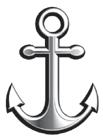
I spent the rest of the day doing boat chores when a nap refused to set in. The tradewinds made a show of it and soon typical light island rain clouds washed over Triteia from the Mākua Valley. At intervals the sun would break through and a brilliant rainbow would frame the valley and stand each of its feet in the sea. The disturbed seas blowing away from the shore reflected the colours of the rainbow.
By the evening the intense winds had mostly subsided and fallen into occasional extended gusts and Triteia sat gently rocking on a small south swell, the sort of rocking that a patient and loving grandmother would provide for the cradle of a small child. The hatches were open and the air smelled of fresh desert rain and wet soil. I may have taken fifty photos of the same two mountains that flank the anchorage – their textures and colours were simply unmatched by anything I had seen before, and the brilliant Hawaiian light added to their beauty.

Soon night arrived. I turned in to my bunk and enjoyed a peaceful night on the hook at this far end of the island of O‘ahu.
 Anchored in O‘ahu’s beautiful Mākua Bay
Anchored in O‘ahu’s beautiful Mākua Bay
CONTENT: anything which is likely to be of interest to other members – cruise and liveaboard accounts (including humour), technical articles, letters and recipes. Most articles need a short intro – who you are, who you were sailing with, the type and length of boat, etc – and all need a title. Please tell me if you’re sending the same piece elsewhere, inside or outside the OCC. Finally, please double check that all place, personal and boat names are spelt correctly, including in the captions.
LENGTH: no more than 3500 words and preferably fewer than 3000, except in very special cases – and normally only one article per member per issue.
FORMAT: MS Word (any version) or PDF, with or without embedded photos (though see below), sent by e-mail to flying.fish@oceancruisingclub.org.
ILLUSTRATIONS: up to 20 captioned photos, professional-standard drawings or cartoons. PLEASE don’t send more than this – while you have a single piece to illustrate, I receive up to 20 articles for each issue, so may have 400+ images to juggle! Nearly all digital formats are fine, but please contact me before sending prints. Photos should measure at least 16cm wide at 300 dpi or 67cm wide at 72 dpi (the default setting for most cameras). If this means nothing to you, please send your photos
EXACTLY as they were downloaded from the camera or phone – merely opening and saving under another name degrades the quality. If sending photos by e-mail, manually attach no more than three per e-mail (do NOT use the ‘attach to e-mail’ facility available in many image programs, which compresses the file data), rounding off with a separate message telling me what you’ve sent. Alternatively use WeTransfer [www.wetransfer.com], a great little free (!) internet program.
Please include a list of captions, including credits, in the order the photos relate to the text, and place the numbers (in red) in the text where applicable. Captions along the lines of: ‘01 (DCM 3285) Preparing the boat for sea; 02 (DCM 3321) Leaving Horta, John at the helm; 03 (DSP 00045) The whale! Photo Sue Black;’ are ideal.
CHARTLETS & POSITIONS : please send a rough chartlet if relevant, for professional re-drawing. If your article includes cruising information useful to others, please include a separate list of latitudes and longitudes.
COVER PHOTOS: I’m always on the lookout for eye-catching, upright photos of high resolution and quality, with fairly plain areas top and bottom to take the logo and wording.
COPYRIGHT: please ensure you either own the copyright of photos or have the photographer’s permission for them to be reproduced on the OCC website as well as in Flying Fish. A credit can be included, but Flying Fish does not pay reproduction fees.
DEADLINES: 1st FEBRUARY for June publication and 1st OCTOBER for December publication, though an issue may be closed earlier if it becomes full. If you can’t meet the deadline, do get in touch as I can often give an extension.
For more information, either e-mail me or refer to the GUIDELINES
CONTRIBUTORS to be found on the website. Thank you.
FOR Anne Hammick, Editor flying.fish@oceancruisingclub.org

Peter grew up in Sheffield, the only child of Haydon, a pioneering radio engineer, and Katie. He passed his radio amateur examination at an early age and was a compulsive communicator, fascinated by geography, who loved talking to people in different countries. Before joining the Royal Navy for his National Service in 1954 he had no experience of the sea beyond the nearby coastal resorts, but then was lucky enough to find himself in a frigate bound for the Caribbean.
In 1957 he moved to London and started working in the Lloyds insurance market. As the protégé of a successful Lloyds insurance broker he discovered the joys of weekend sailing on a classic Fife yawl and met his wife Caryl. Shortly after their marriage Peter and Caryl acquired a converted ship’s boat which they kept on a homemade mooring on the Walton Backwaters, where Caryl had learned to sail as a child. When their first child was born in 1964 Peter made a miniature naval hammock for the boat, and he and Caryl recalled pushing their gear and baby over the mud to the landing in their pram dinghy when they missed the tide. As the family increased Peter took a break from sailing, but 1971 saw the whole family – by then three children – back on the water in the 12-ton Hillyard Ashenai and taking extended summer cruises in Brittany.
In 1973 Peter sold his business, purchased the 44ft Laurent Giles cutter Lucina and took a six-month sabbatical to sail to the Caribbean with family. He was hugely fortunate in the purchase of Lucina. She was three years old, built from rolled Corten steel at one of the finest yards in the Netherlands, but had never been used.
After a season of fitting out and shaking down, the family left Portsmouth in November 1974. The passage to Gibraltar was rough and later, on the way to Lucina creaming down Brittany’s Treguier River
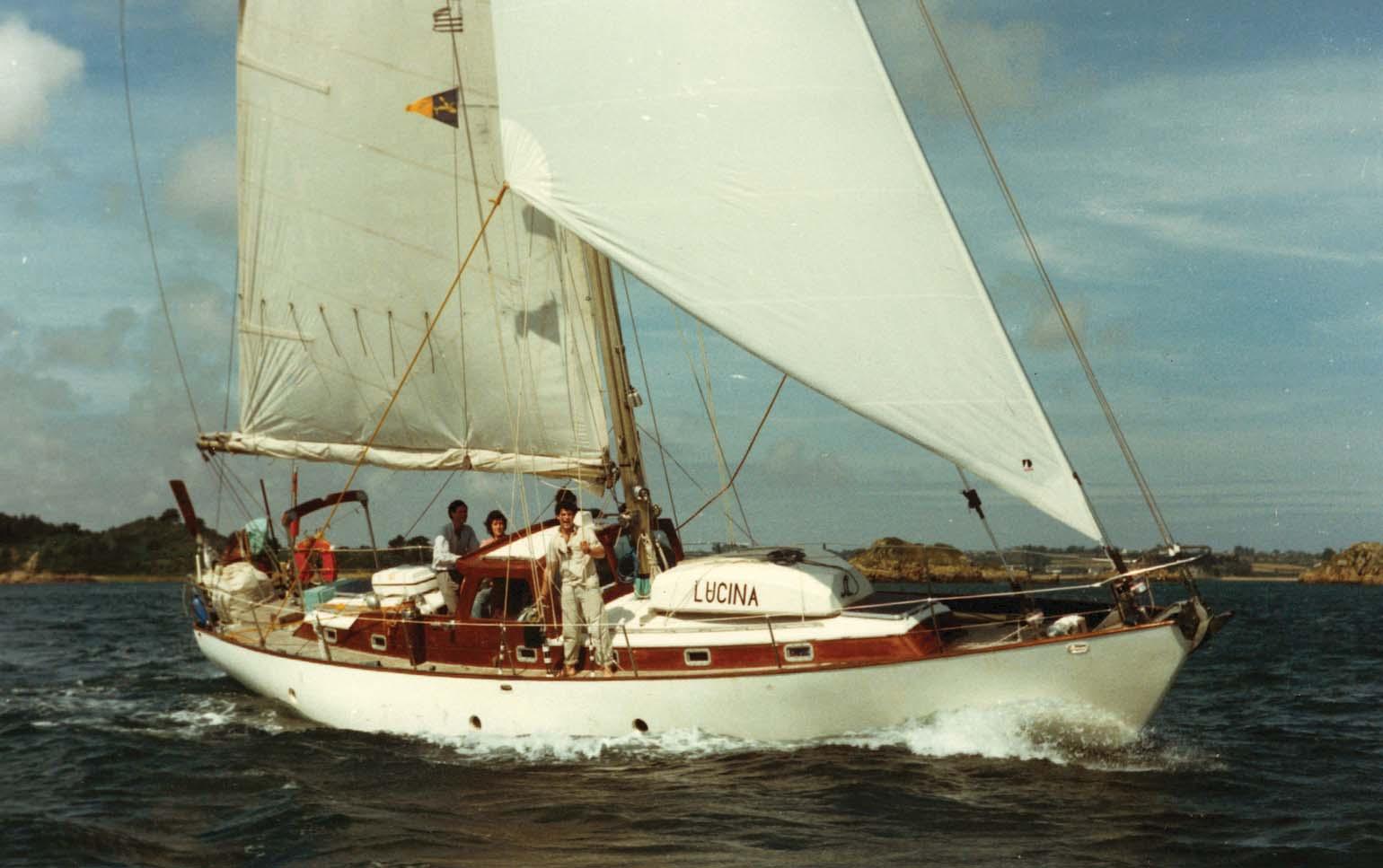
Peter in the unmistakable Azorean landscape in 1988

Tenerife, Christmas Day was postponed due to bad weather! Caryl’s summary of the situation as recorded in the log was, ‘everything wet, just like Biscay’. The SSB radio was a memorable feature of life on board. Peter’s scheduled conversations with radio amateurs around the world woke the crew each morning. When the power pack on the transmitter blew up mid-Atlantic, leaving us listening to our concerned followers, Peter spent a whole night cannibalising various electronics from around the boat to rebuild the unit, which hung like a giant spider’s web around the chart table until a replacement could be bought in Barbados. Another distinctive feature of this passage was the absence of overnight watch-keeping in mid-ocean. The risk of collision away from a shipping lane was considered small enough to be acceptable, balanced against the reward of a good night’s sleep all round. It was this 2640-mile passage that Peter cited when joining the OCC.
During this adventure Peter discovered the extraordinary comradeship of other sailors, and how meeting again after a passage of a few thousand miles could transform new acquaintances into long-lost friends. Most memorably, Jim and Jan Vogt of Gypsy Dancer , whom we’d left behind in Tenerife but who reached Barbados ahead of us and were there to welcome us in, trying to row over for a chat while we were still in quarantine and being shooed away by the customs launch. They too became OCC members as well as lifelong friends of Peter and Caryl.
Drinks aboard Lucina in the Azores in 1988, with Peter in blue-and-white stripes and Mary Barton, then Commodore, in red

Caryl and Peter aboard Lucina with other OCC members in the Azores in the late 1990s, shortly before she was sold

After returning to England Peter cruised Lucina extensively for the next 25 years. His involvement with the OCC deepened after 1988 when his children had left home, and he enjoyed organising rallies and relished the lively OCC social scene. Despite a demanding professional life he made sure to clear five or six weeks every summer for sailing, his favourite cruising grounds being Galicia and the Azores. He often said that Lucina gave him more pleasure and satisfaction than anything else he ever owned and that, as a confirmed risk-taker, he needed a ‘tin boat’ to keep him safe. Lucina certainly inspired huge confidence and took care of the family through many adventures, most notably when she struck a reef in a remote Icelandic fjord in 1985.
Peter sold Lucina in 2001, after which most of his sailing took place in New Zealand, initially in a 40ft modern cruiser called Boundless and later in Minnie, a small motor cruiser based on a classic Logan design. He also briefly owned the Laurent Giles Salar 40 Lochisle, which he sailed with her previous owner from South Island to Auckland in very rough conditions.
One of Peter’s favourite pastimes in his later years was reading through Lucina’s logs and browsing his sailing photographs, many of OCC events and friends. He was especially proud to have served as Vice Commodore from 1994 to 1998 and remained an enthusiastic member to the end. In fact, the OCC shirt in which he died was the last thing he ever wore.
Robin Aitchison
Michael was born in Sydney, Australia on 1st June 1940 and was raised on the Sydney Harbour waterfront at Birchgrove where, along with his late brother Peter, his love of sailing began. He died on 30th July 2022, also in Sydney, after several years of ill health, and is survived by his wife Sharon, three children and five grandchildren. A lawyer by profession, Michael enjoyed a distinguished career spanning 58 years and was an exceptional litigator and a family law lawyer of renown. As fellow lawyer Stephen Toomey said at his memorial service, ‘Michael was blessed with significant ability which he supplemented with hard work, rigour, acute perception and an unrelenting pursuit of excellence. They were attributes he brought to all his endeavours’.
Michael relaxing aboard Irish, his beloved Young 41 with, below, his faithful companion, Australian terrier, Rory
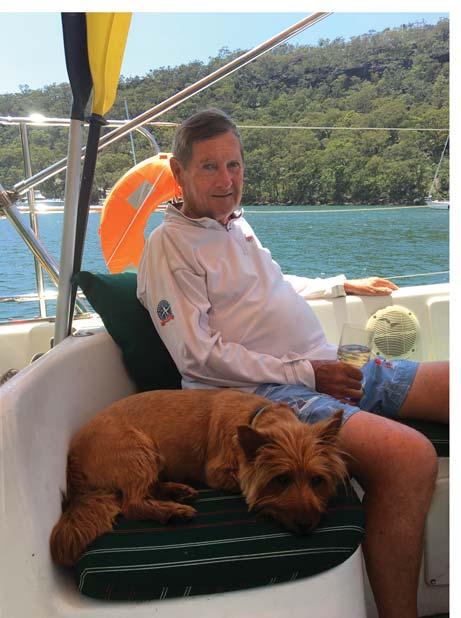
These included sailing. He was more than an able seaman – he was an excellent sailor. Before graduation he raced 12ft skiffs at the Balmain 12ft Flying Squadron, but his first serious competition was at the age of 17 when he and Peter ‘Poddy’ O’Donnell, a classmate at Sydney’s St Aloysius College, were chosen to represent Australia in an 18-footer sailing event in New Zealand. Peter went on to win a Gold Medal in sailing for Australia at the Rome Olympic Games in 1960.
Michael joined the OCC in 1969 following a near-disastrous voyage from Wackatane, New Zealand to Suva, Fiji aboard Sid Yaffe’s yacht Sidaliz the previous year, during which he and his two companions endured

many hours sailing through a cyclone. Clearly their skill and determination, possibly aided by a few silent prayers, saved them. Michael became Rear Commodore Australia in 1989, serving until 1993, and promoted the Club vigorously in Australia.

His first yacht, bought more than 30 years ago, was Nyora, a 40ft timber sloop of the Ranger style. He and his family enjoyed many years sailing her in the waterways around Sydney, including the Hawkesbury River and its tributaries to the north. Today Nyora is enjoying a quiet life with new owners in the Derwent River, in Hobart, Tasmania.
Despite the demands of his professional life Michael was passionate about his sailing both locally and internationally. In 1971 he was the Sailing Master on Stormy Petrel, winner of that year’s World One Ton Championship. At the other end of the scale he sailed Mirror dinghies in both the World and Australian Mirror Dinghy Championships.
Michael crewed or skippered yachts in nine Sydney Hobart Races, considered one of the toughest yachting events in the world. In 1994, the 50th race, he sailed aboard Ruthless, a 20-year-old boat competing in the Veterans’ class. They came 8th, and Michael told John Maddox (himself a Rear Commodore Australia) that he was getting too old to put up with the cold conditions of the Hobart Races!
Later he joined Australian crews in warmer waters for two annual Raja Muda races in Malaysia, beginning in Port Klang and sailing through the Straits of Malacca to Langkawi in the north of the country. In 2006 he was part of a crew of Australian sailors who competed in the New York Yacht Club’s 100th Anniversary Race from Newport, Rhode Island to Bermuda and also took part in the UK-run Admiral’s Cup. Then in 2007 and 2008 he competed in two Antigua Sailing Weeks, again with Australian friends.
In later years Michael and his wife Sharon joined friends to sail in rallies in Turkey, Tonga, Corsica, Sardinia, Greece and the Caribbean. They joined Scot Wheelhouse (current Rear Commodore South East Australia) and his wife Rose aboard their 54ft ketch Cloud Shadow in the United States and again in the Bahamas. Sailing rallies organised by Mariner Boating in Australia
Michael with Scot Wheelhouse, Rear Commodore South East Australia, aboard Scot’s Cloud Shadow
were a mixture of serious yacht racing and wonderful adventures on land – indeed Michael’s years of sailing in international competitions, as well as simply for pleasure with family and friends, gave him fabulous opportunities to see a myriad of places, immerse himself in new cultures and make lifelong friends around the world.
From the 1990s onwards Michael owned and sailed Irish, a Young 41 Pilot House, initially out of the Royal Sydney Yacht Squadron at Kirribilli on Sydney Harbour and more recently from the Ku-ring-gai Motor Yacht Club at Cottage Point in the Cowan Creek, part of the mighty and beautiful Hawkesbury River. As was said about Michael at his recent memorial service, ‘He was passionate about sailing on rivers, bays, harbours and oceans ... and delighted in the majesty of the wind’.
Anthea was born in London in January 1939 and lived there all her life, other than when sailing or travelling by other means. She went to school in Islington and later to Westfield College, part of London University. Her early career included working for Marplan, the leading market research company at that time, and then at Shell, where she rose to become Planning Manager and Head of Secretariat to the Chief Executive’s Committee. This took her all over the world, including sailing in the Bahamas in the 1980s. There she met Peter Stock who, many years later, was to become her husband.
Anthea caught the sailing bug as a teenager in the 1950s while visiting cousins Susan and Elisabeth (Liz) in Cornwall, and went on to race Firefly dinghies on London’s Welsh


Anthea (standing by the mast) while sailing with her cousins in the mid 1950s

Harp reservoir during her time at Westfield College. She was a founder member of their Ocean Sailing Club and, in the mid1960s, owned a share in a 45ft schooner. Sailing was not her only sport, however. Always fit and active, she excelled at tennis and swimming and was a regular at her local swimming baths until shortly before her death.
In 1992 Anthea spent her leave from Shell sailing from Halifax, NS to Falmouth, UK aboard the 45ft Freelance of Itchenor, her qualifying voyage for our Club. The next year she took early retirement to spend most of the following four years sailing. Voyages included an east-to-west Atlantic passage, passages from Turkey to Karachi and return, a Pacific crossing from Vancouver, BC to Auckland, NZ and a leg of the Trade Winds Rally from Sri Lanka to Crete via the Suez Canal. Never one to miss an opportunity, she also took side-trips by land to places very hard to visit these days – the Khyber Pass, the Swat Valley, South Yemen, Eritrea and Sudan.
In 1998 Anthea applied for the post of OCC Club Secretary and was the Committee’s unanimous choice. At that time the roles of Club Secretary and Membership Secretary were separate, but as the latter Anthea produced the quarterly Newsletter, using her considerable IT skills to raise it from a few pages of duplicated text to something very similar to what we receive today. (Unlike today, overseeing the enveloping and mailing out some 1700 copies were also among her duties!). She frequently attended Club rallies and sailed longer distances whenever the opportunity presented and
 Anthea at the wedding of her cousin Brian in February 2000
Anthea at the wedding of her cousin Brian in February 2000
her workload permitted – see page 33 of this issue for her account of one of her most challenging experiences at sea.
In early 2005 Anthea and Peter met again. By that time his first wife had died and, the spark between them rekindled, it was not long before they were married. In the words of her stepson Nigel: ‘Marriage to Peter brought an extra joi de vivre to Anthea. They proved to be perfect companions and travelled together on sea and land. They enjoyed food, wine and much socialising with Anthea’s friends and family, and even sailed together again’.
Susan, one of the cousins who had introduced her to sailing, married Eric Ruck who then owned the famous ketch Saoirse which they continued to sail from her Cornish base, often joined by Anthea. Elisabeth (Liz), the younger of the two, emigrated to Australia with her husband and baby daughter Lucy. Anthea visited them there on numerous occasions – she had lost both her parents while still in her 20s and was very aware of the importance of ‘family’. Liz recalls that: ‘Gifts unfailingly arrived for all our birthdays and the unwrapping of Anthea’s C hristmas parcel was quite an event’. Visits to England were made in return, and Liz’s daughter Lucy has memories of Anthea introducing her and her sister to London’s famous ‘sights’. Later Anthea passed on her love of sailing to both Lucy and her future husband, inviting them to join her on a cruise from Italy to the south of France. Her Christmas presents to them that year were sailing gloves – gloves which they still wear regularly. In 2012 Peter and Anthea embarked on a world cruise aboard the MS Black Watch, which called in at Brisbane where Liz and her family met her.
 With OCC Admiral Mary Barton at the Maine Millennium Rally
With OCC Admiral Mary Barton at the Maine Millennium Rally
Sadly, after Peter and Anthea had enjoyed seven wonderful years together Peter became ill and housebound. Anthea devoted the next seven years to caring for him, sacrificing her own needs to look after him in every way. She had occasional short breaks, but all too infrequently. It was during this time that she renewed her close association with our Club by responding to a call for more Flying Fish proof-readers. She was an outstanding addition to the team, not only because of her impeccable spelling and grammar but also because her long and accurate memory encompassed so many events and people from the Club’s past, saving the editor from embarrassing faux pas on more than one occasion!
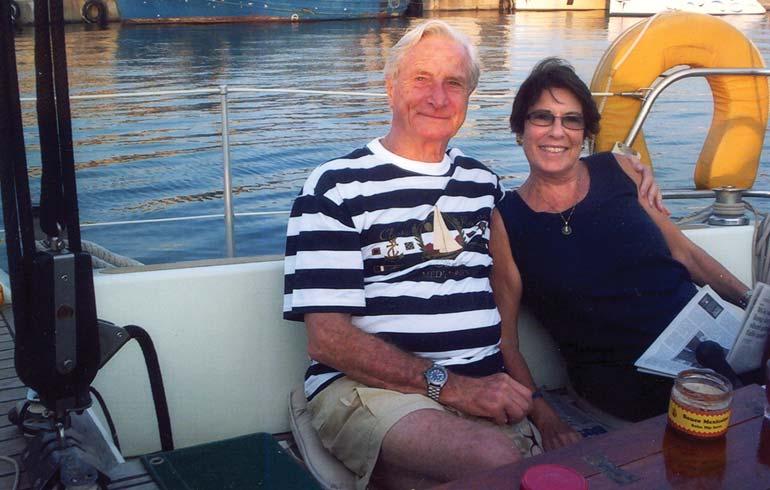
Anthea made no secret of her cancer diagnosis, but always remained cheerful and upbeat. It was typical of her that she downplayed its growing seriousness so that her death in late September took even her family by surprise. In the words of her cousin Liz: ‘Anthea was always a ‘glass half full’ kind of girl. Although, even as I write this, I can hear her amused response, “Yes ... but I’ll have a top-up, thank-you, if there’s one going!”’.
Matthew Arnold


Is it so small a thing To have enjoy'd the sun, To have liv'd the light in the spring, To have lov'd; to have thought, to have done?
We appreciate our advertisers and encourage you to give consideration to their products or services. Please mention the OCC and Flying Fish when replying to advertisements. Note, however, that the printing of an advertisement in Flying Fish does not imply endorsement by the Club. Also that while our membership is global, some companies may only be licensed to operate in certain jurisdictions and/or offer limited products or services. Details of advertising rates and deadlines will be found overleaf.
Advertising is sold on a two consecutive issues basis
Inside pages
Full page colour ...................£280 (for two issues)
Half page colour...................£170 (for two issues)
Cover pages
Inside covers colour ........................£525 (for two issues)
Outside back cover colour..............£840 (for two issues)
A 10% discount is available to OCC members

Copy should be supplied as a high res PDF, JPEG or EPS file, at a resolution of 300 dpi (118 dpcm) at finished size

Full page (portrait): bleed 210 x 143 mm; non-bleed 188 x 120mm
Half page (landscape): bleed 100 x 143 mm; non-bleed 90 x 120mm
Bleed adverts should allow 2mm all round in addition to the dimensions above
Advertisements are accepted for inclusion on a ‘first come, first served’ basis. Space may not permit all advertisements to be accepted, but please try!
Latest dates by which orders must be confirmed are:
14 March 2023 for Flying Fish 2023/1
14 October 2023 for Flying Fish 2023/2
though new artwork may be accepted after these dates
e-mail: advertising@oceancruisingclub.org

